- Attraktionen
- Deutschland
- Urlaubsangebote
- Hotels & Ferienwohnungen
- Weltspeisen
- Reisewetter
- TRAVELBOOK AWARD

Die 20 beeindruckendsten „Dark Tourism“-Orte weltweit

11.04.2023, 06:25 Uhr | Lesezeit: 14 Minuten
Die meisten Urlauber zieht es an malerische Strände, zu grandiosen Landschaften und zu epochalen Bauwerken. Aber es gibt auch Menschen, die sich von Sehenswürdigkeiten mit einer düsteren, oft auch grausamen Vergangenheit angezogen fühlen. Das Besichtigen solcher Orte wird als „Dark Tourism“ bezeichnet – dunkler Tourismus. TRAVELBOOK hat zwei Reisende, die insgesamt mehr als 1000 „Dark Tourism“-Orte in mehr als 100 Länder weltweit besucht haben, nach ihren persönlichen Top-Ten-Listen düsterer Ziele gefragt: Sebastián Cuevas und Dr. Peter Hohenhaus.
„Dark Tourism“ ist zwar längst kein neuer Begriff mehr, aber die Faszination, Lost Places, also verlassene Orte, oder Plätze, an denen sich Tragödien ereignet haben, zu besuchen und zu fotografieren, ist nach wie vor groß, wie anhand Unmengen geteilter Fotos zum Beispiel bei Instagram oder Facebook mit entsprechenden Hashtags zu erkennen ist. Bei vielen Orten kommt dann noch eine düstere oder gar grausame Geschichte dazu. Zwei Experten verraten hier, welche „Dark Tourism“-Orte sie auf vergangenen Reisen am meisten fasziniert haben.
Auch interessant: Die Puppeninsel in Mexiko – einer der gruseligsten Orte der Welt
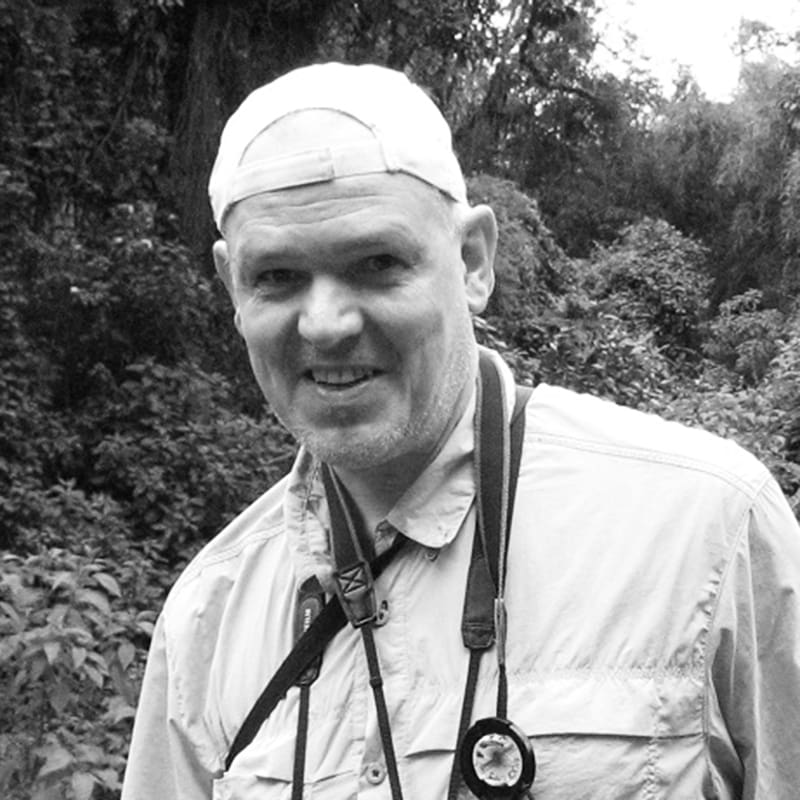
Dr. Peter Hohenhaus
1. tschernobyl, ukraine.
Für mich das faszinierendste Reiseziel schlechthin, eine simultane Zeitreise sowohl in die sowjetische Vergangenheit als auch in eine post-apokalyptische Zukunft, wenn es die menschliche Zivilisation nicht mehr geben wird und sich die Natur unsere Betonwelten zurückholt. Meine dritte Reise in die Sperrzone im November 2018 war speziell, weil wir früh morgens von Slawutytsch per Bahn angereist waren und es schneite, sodass wir in Prypjat die ersten Fußspuren im Neuschnee hinterließen, was den Geisterstadt-Charakter des Ortes nochmals kräftig verstärkte. Die Stadt Pripjat wurde für die AKW-Belegschaft errichtet und ist seit der Reaktorkatastrophe von 1986 verlassen.

Auch interessant: Wie gefährlich ist die Region rund um Fukushima 11 Jahre nach der Katastrophe?
2. Murambi, Ruanda
Von allen Gedenkstätten des Völkermords in Ruanda ist diese die heftigste. Hier sind Leichen der Opfer der brutalen Massaker aus ihren Massengräbern exhumiert worden und, weiß gekalkt, auf Tischen ausgestellt. Das ist aus westlicher Sicht schockierend, hat aber innenpolitische Gründe (man will einem etwaigen Aufkommen der Leugnung des Völkermords einen Riegel vorschieben). Raum um Raum voll mit Hunderten schaurig verdrehter Gestalten, manche mit offenen Mündern, als ob sie stumm schreien, manche mit fehlenden Gliedmaßen (mit Macheten abgeschlagen), sogar Babyleichen … Das bereitet schon mehr als einen Kloß im Hals. Keine Gedenkstätte hat länger und intensiver in mir nachgewirkt.
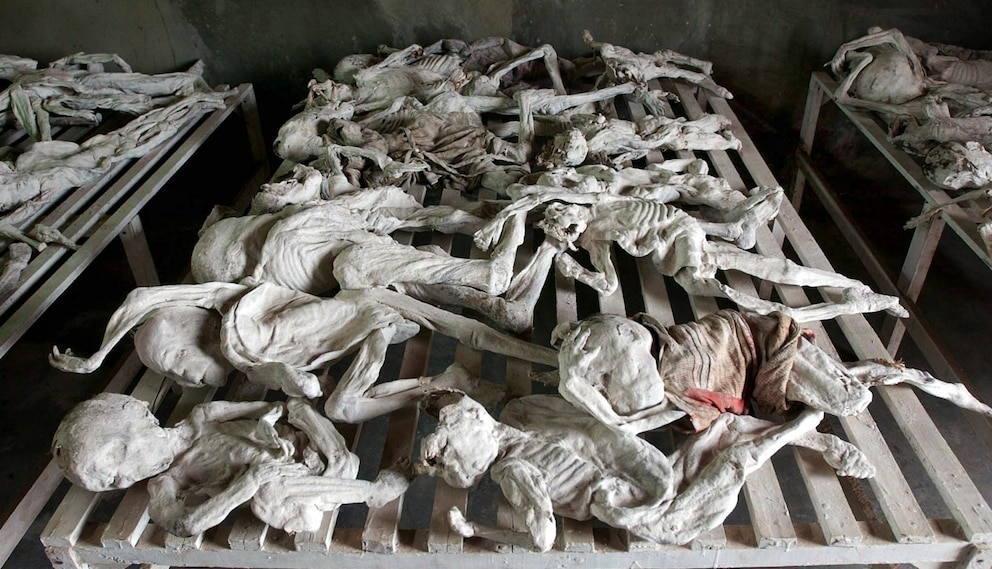
3. Arirang Mass Games, Nordkorea
Vor allem ein unerwartetes Ereignis war hier herausragend: Unsere Gruppe besuchte im August 2005 die berühmten „Arirang Mass Games”, die größte Massen-Choreografie der Welt. Das Stadion war voll, Kameras verboten, beste Kleidung verlangt. Bald erfuhren wir den Grund dafür: Der „Liebe Führer” Kim Jong Il höchstselbst erschien, sein erster öffentlicher Auftritt seit Jahren. Als er auf die Ehrenloge schritt, brach ein ohrenbetäubender Jubelsturm der etwa 100.000 Besucher los, während der Diktator milde ins weite Rund winkte. Wir blieben stumm. Mir rannten kalte Schauer den Rücken runter.
Auch interessant: Die bizarre Geschichte des schwimmenden Hotels, das in Nordkorea verrottet

4. Ijen, Indonesien
Der nächtliche Abstieg in diesen indonesischen Vulkankrater im Sommer 2014 war schwierig, aber lohnend. Am Ufer des Kratersees wird unter Inferno-artigen Bedingungen Schwefel abgebaut. Dazu gehören unwirklich aussehende blaue Flammen und beißende Qualmwolken – ohne Atemmaske nicht auszuhalten. Es ist, als stünde man auf einem fremden Planeten.

Auch interessant: Der Mauna Kea – der höchste Vulkan der Erde
5. Majdanek, Polen
Diese KZ-Gedenkstätte nahe Lublin in Polen, die ich im März 2008 besuchte, hat bei mir fast noch tiefere Eindrücke hinterlassen als Auschwitz. Das lag auch daran, dass sonst keine anderen Besucher dort waren und ein plötzlicher Wintereinbruch für Schneefall gesorgt hatte, so dass der weiße Boden, der graue Himmel und die dunkel dastehenden Reihen von Holzbaracken und Wachtürmen wie schwarz-weiß wirkten, also wie auf historischen Fotos. Zudem sind hier, anders als in Auschwitz, auch Krematorium und Gaskammer erhalten geblieben, letztere sind bis heute an den Innenwänden vom Zyklon-B grünlich-blau verfärbt. Relikte des industrialisierten Massenmordes.

Auch interessant: Die schreckliche Geschichte des ehemaligen Konzentrationslagers Theresienstadt
6. Semipalatinsk, Kasachstan
Hier, in der ost-kasachischen Steppe, war früher das Gelände des sowjetischen Atombomben-Test-Programms. Im August 2011 fuhren wir zu viert bis zum „Ground Zero“ der ersten sowjetischen Atombombe (und vieler darauffolgender) sowie zu den Überresten der Betontürme, die einst Messgeräte beherbergten und dessen Außenseiten zum Teil von der Hitze der Explosionen schwarz versengt und angeschmolzen sind. Die Radioaktivität war meist gar nicht so hoch, dennoch trugen wir sicherheitshalber Überschuhe und Atemmasken. Hardcore „Dark Tourism“, zweifellos!

7. Wolgograd, Russland
Das ehemalige Stalingrad war der Schauplatz der wohl entscheidenden Schlacht des Zweiten Weltkriegs. Niemand hat je so eindrucksvolle Kriegsdenkmäler errichtet wie die ehemalige UdSSR, und die in Wolgograd sind die Krönung, allen voran die gigantische Statue „Mutter Heimat ruft”, welche 85 Meter hoch ist. Am gewaltigen grauen Fuße dieser größten weiblichen Statue der Welt fühlte ich mich im August 2017 als Besucher wahrlich klein. Dennoch ist es auch erhebend, dort einmal zu stehen.
Auch interessant: Dargavs – das Dorf der Toten in Russland

8. Titan Missile Museum, Arizona, USA
Im April 2012 ging ich auf eine private „top-to-bottom“-Tour. Der Kurator des Museums selbst führte mich durch dieses einzige erhaltene Silo, in dem immer noch eine Titan-II-Interkontinentalrakete steht, wenn auch heute mit leerem Atomsprengkopf. Es ging bis in die unterste Ebene des Silos, wo wir direkt unter der Rakete standen. Im Kommandozentrum führten wir zu zweit einen simulierten Raketenstart durch, an dessen Ende der Kurator schwarz-humorig sagte: „Welcome to World War 3”! Für jeden, der den Kalten Krieg noch erlebt hat, ist dieser Ort der wohl beeindruckendste weltweit.
Auch interessant: Nach wenigen Monaten geschlossen! Diese Pyramide sollte Atomraketen abwehren
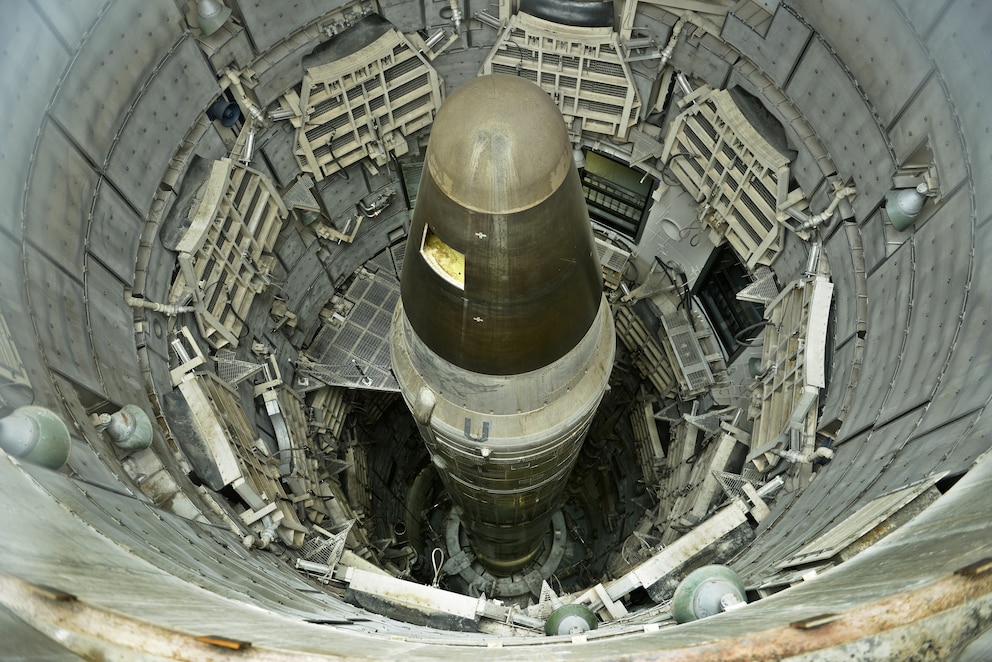
9. Montserrat, Karibik (Britisches Überseegebiet)
Auf dieser britischen Insel in der Karibik ist seit 1995 ein Vulkan aktiv. Viele sind weggezogen, doch die verbliebene Inselbevölkerung gehört zu den freundlichsten Menschen, denen ich je begegnet bin. Vielleicht liegt das zum Teil auch am Leben mit dem Vulkan. Als ich zum Jahreswechsel 2009/2010 dort war, gab es eine sehr aktive Phase. Der Krater stieß gewaltige Aschewolken aus, dazu pyroklastische Ströme, und bei Nacht war der rot-glühende Schein der Lava am Gipfel zu beobachten. Die verlassene Hauptstadt Plymouth, das „Pompeji der Karibik”, durfte wegen der Vulkanaktivität nicht betreten werden, aber eine Bootsfahrt führte bis dicht heran an die Geisterstadt, von der nur noch die oberen Stockwerke aus der grauen Aschewüste herauskucken.
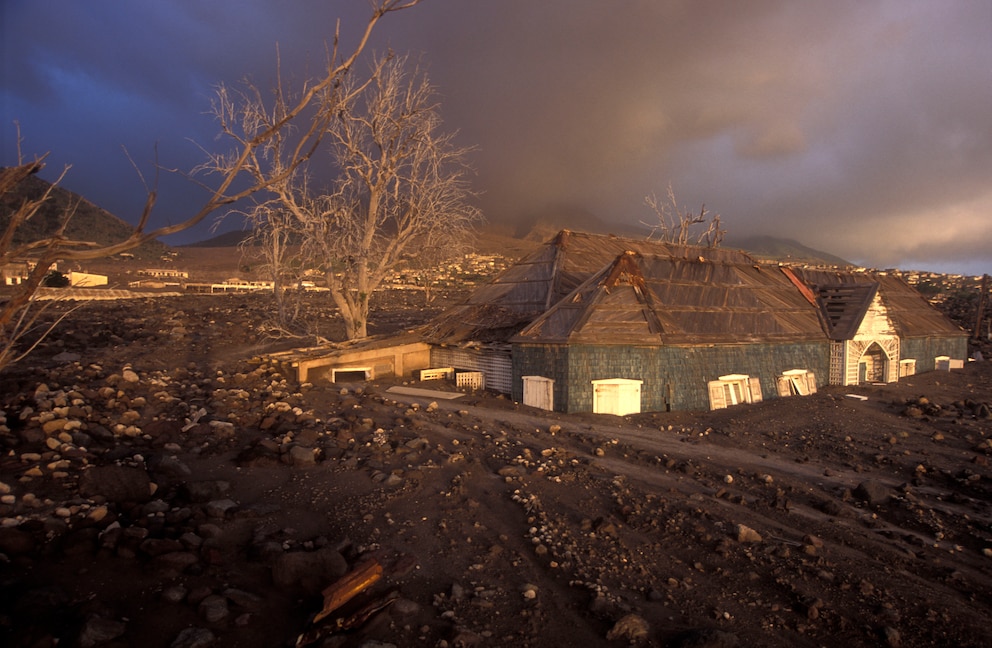
Auch interessant: Plymouth – die verlassene Hauptstadt der Karibik-Insel Montserrat
10. Hohenschönhausen in Berlin, Deutschland
Dieses bedrückende frühere Stasi-Untersuchungsgefängnis in Berlin besuchte ich erstmals im März 2008. Die Führung wurde von einem ehemaligen Häftling geleitet, dessen Geschichte nicht nur spannend und ergreifend war, sondern mitunter auch tragikomisch die Absurdität zeigte, welche die Spitzel-Maschinerie der Stasi mitunter hatte.
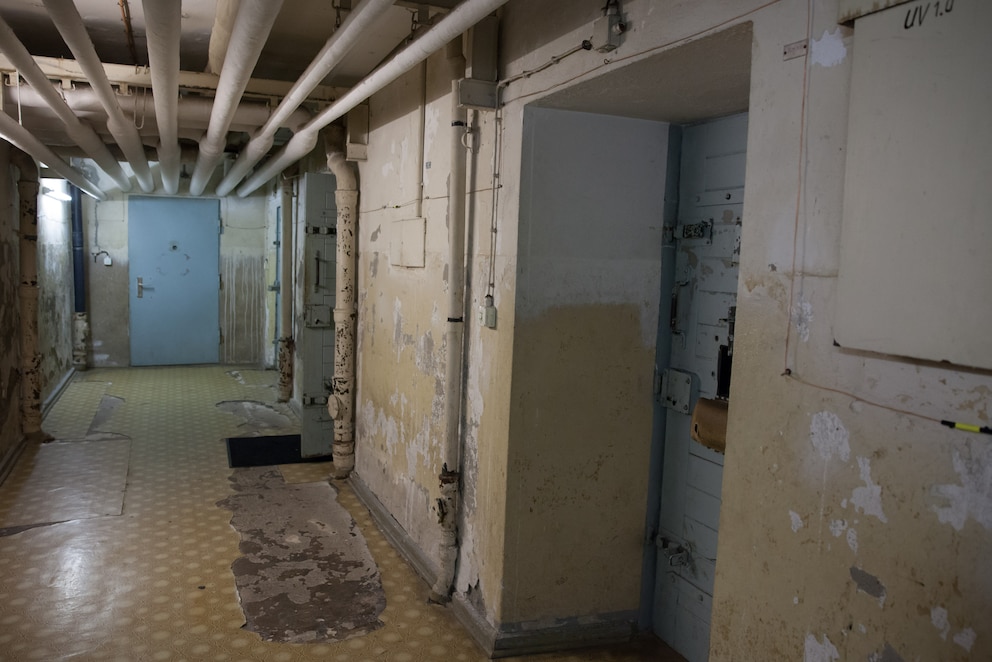
Hier geht es zur Webseite von Dr. Peter Hohenhaus mit weiteren spannenden Dark-Tourism-Zielen

Sebastián Cuevas
11. belfast, nordirland.
Die Hauptstadt Nordirlands besuchte ich über Weihnachten im Jahr 2016. Damals habe ich in Berlin gelebt und bin von einer Stadt, die mal durch Mauern geteilt war, in eine Stadt gereist, die gerade durch Mauern geteilt ist. In Nordirland herrscht seit 1998 offiziell Frieden, aber dennoch ist die Realität des politischen Konflikts zwischen pro irischen Republikanern und pro britischen Loyalisten überall zu sehen. Ich bin öfter auf Denkmäler gestoßen, wo Leute durch Gewalt gestorben sind. Die Erinnerung an den Konflikt ist überall in der Stadt zu spüren.
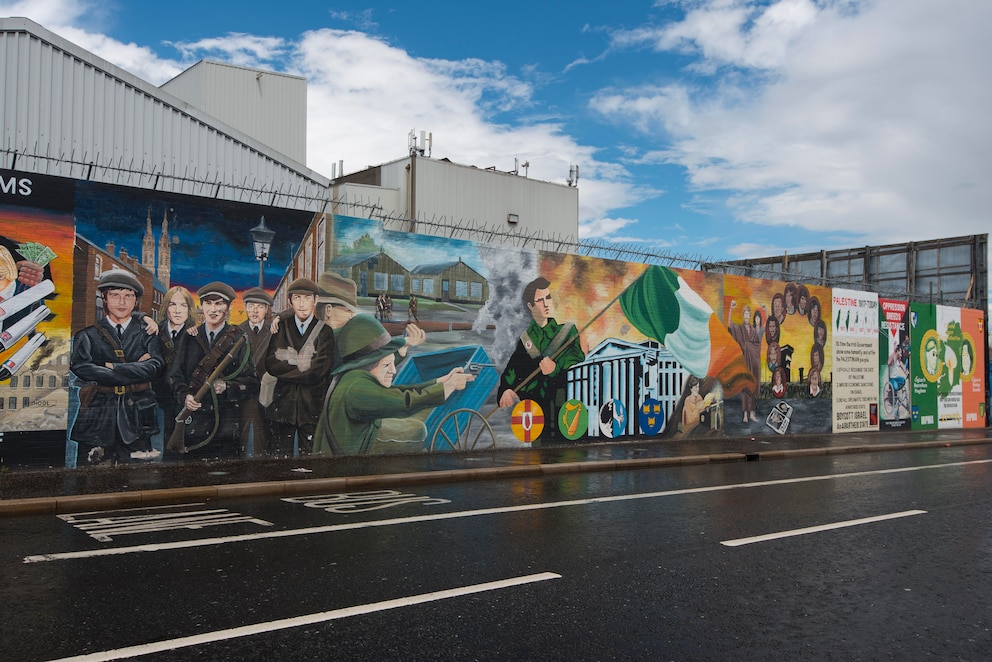
Auch interessant: Wanderung über Nordirlands Klippenpfad „The Gobbins“
12. Thingstätte in Heidelberg, Deutschland
Zu meiner Studienzeit in Heidelberg gab es immer zur Walpurgisnacht eine Wanderung hoch auf den Heiligenberg. Dort befinden sich die Ruinen einer Freilichtbühne. Die Thingstätte wurde 1935 im Dritten Reich erbaut, um „völkische“ Festspiele zu feiern. Als ich zum ersten Mal dort hochgelaufen bin, war ich von dem Anblick beeindruckt, und auch von der Stille, die dort herrschte. Was den Ort so atmosphärisch macht, ist die Kombination von Ruinen und Natur, da der Heiligenberg sich schon am Rande des Odenwalds befindet.

Auch interessant: Die besten Sehenswürdigkeiten in Heidelberg
13. Hof der verlorenen Spielzeuge in Lemberg, Ukraine
Der Hof der verlorenen Spielzeuge befindet sich hinter einem Gebäude in der Altstadt von Lwiw. Dort werden seit Jahren alte Spielzeuge deponiert. Mittlerweile ist die Sammlung ziemlich groß und kann auf verschiedene Weisen interpretiert werden. Ich verstand es als Zeichen des Vergessens, und während die Stimmung sehr melancholisch war, vor allem im Regen, hatte der Hof was Besonderes, wie ein verlassenes Gebäude und ein Heiligengrab der Nostalgie.
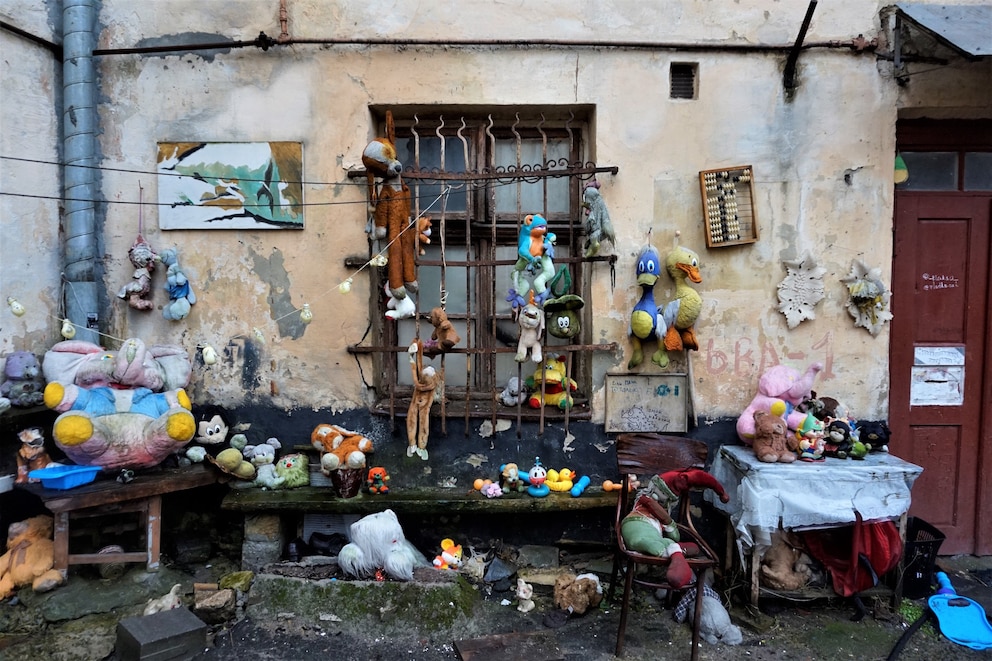
14. Panteón de Orizaba, Mexiko
Ich besuche öfter Friedhöfe, aber den in der mexikanischen Kleinstadt Orizaba fand ich so beeindruckend, dass er in meine Top-Ten-Liste gehört. Nicht nur wegen der Berge im Hintergrund, sondern auch wegen der vielen Legenden, die mit dem Friedhof in Verbindung gebracht werden. Im Herzen des Friedhofs steht ein riesiger Stein, auf dessen Oberfläche ein fünf Meter großer Mann eingraviert ist. Am Tag meines Besuchs waren die Berge zur Hälfte von einer dicken Schicht Nebel bedeckt, was eine Atmosphäre wie aus einem Roman von H.P. Lovecraft erzeugt hat.
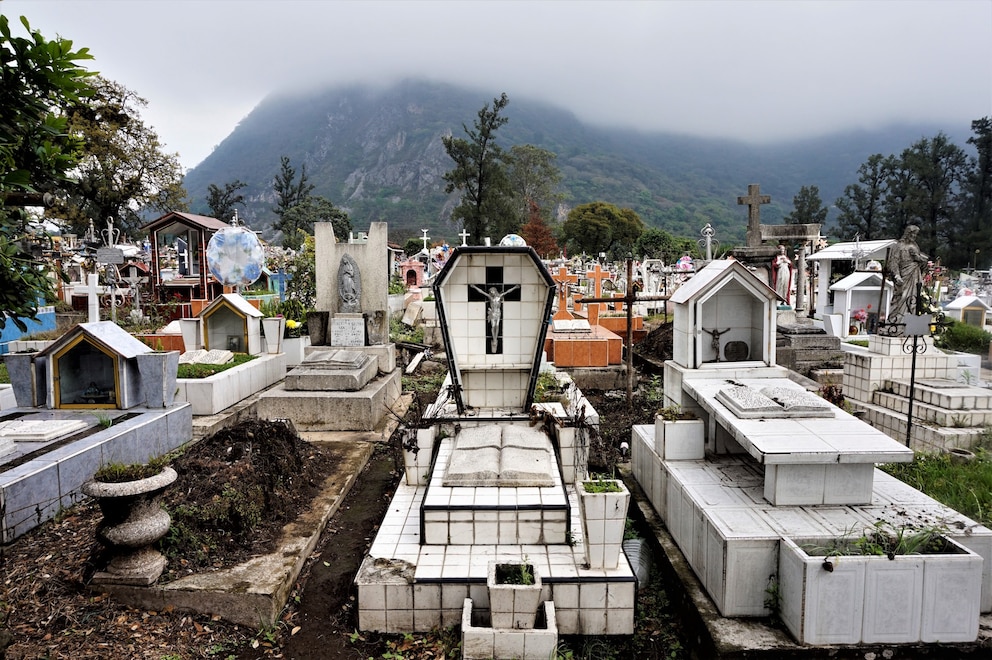
Auch interessant: Chichén Itzá – Mexikos beeindruckende antike Maya-Stadt
15. Maginot-Linie, Frankreich
Militärgeschichte ist eine Leidenschaft von mir – und zwar so sehr, dass ich ihr sogar mein Studium gewidmet habe. Eines Tages habe ich mein Fahrrad genommen und bin mit einem Freund über die deutsche Grenze ins Elsass gefahren, um möglichst viel von der Maginot-Linie zu sehen. Dieses, aus einer Linie von Bunkern bestehende Verteidigungssystem entlang der französischen Grenze, war ein militärisches Wunder. Jedoch war es am Ende vollkommen irrelevant. Ab 1935 einsatzfähig und im Jahr 1969 außer Betrieb genommen, stehen die stark befestigten Anlagen wie Geister in den elsässischen Wäldern, und ich war jedes Mal von Neuem davon beeindruckt.
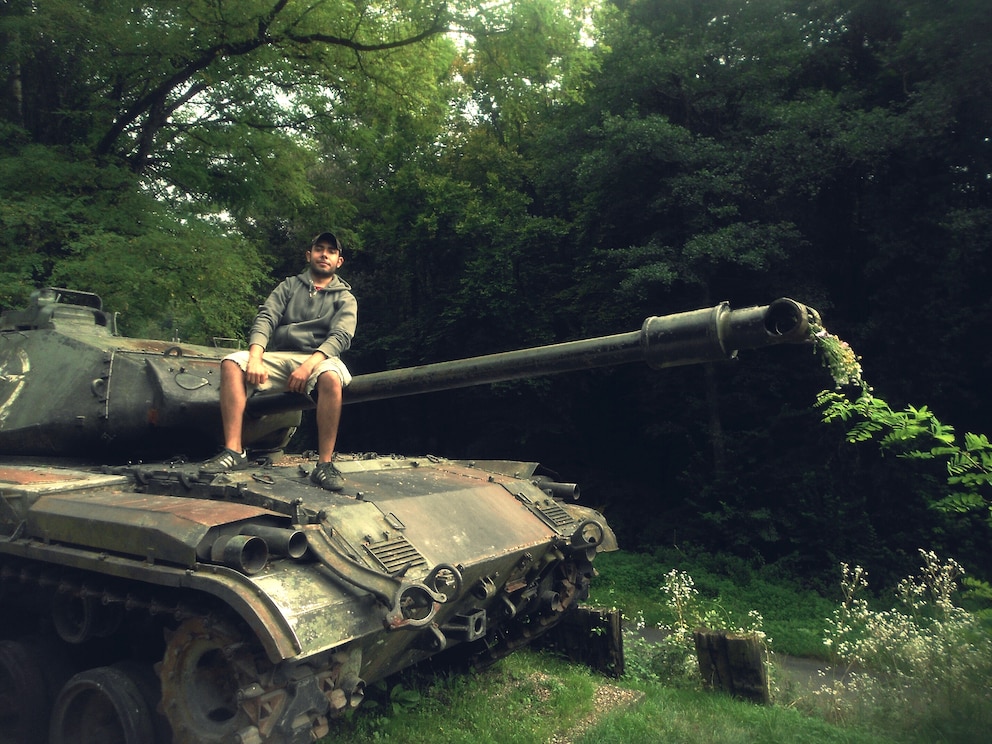
16. Friedhof Lychakiv, Lemberg, Ukraine
Bis 1918 war Lemberg Teil Österreichs. Danach, bis 1939, gehörte die Stadt zu Polen. Seit 1939 ist sie Teil der Ukraine. Die multikulturelle Vergangenheit der Stadt kann man anhand der Namen auf den Grabsteinen erkennen. Ich bin entlang vieler alten Gräber mit polnischen oder deutschen Namen gelaufen, dann kamen noch die Grabsteine aus der Sowjetzeit. Die Wanderung habe ich am polnischen Ehrenfriedhof beendet und hatte am Ende ein tieferes Verständnis von der komplizierten Geschichte der Westukraine.
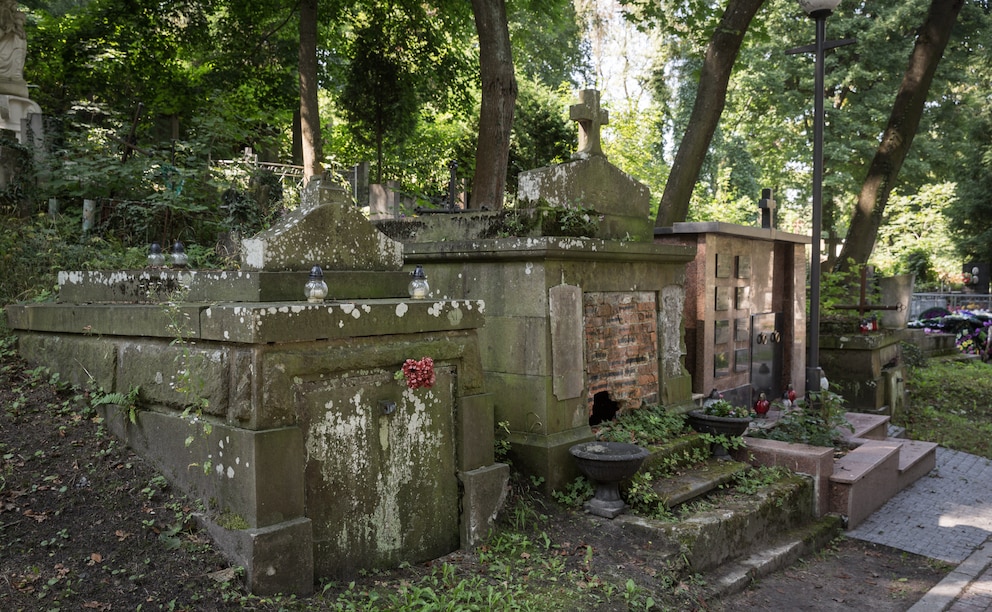
Auch interessant: Memorial Necrópole Ecumênica – Brasiliens bizarrer Hochhaus-Friedhof
17. Sarajevo, Bosnien und Herzegowina
Sarajevo ist eine Stadt, die gleichzeitig für Harmonie und Konflikt steht. Hier stehen Moscheen, orthodoxe und katholische Kirchen unweit voneinander entfernt. Jedoch wurde die Stadt in den 1990er-Jahren fast vier Jahre lang belagert. Ich bin mit einer Freundin, die damals aus der Stadt geflüchtet war, durch Sarajevo gelaufen. Sie hat ständig auf Gebäude hingewiesen, wo einst Scharfschützen positioniert waren. Am Boden zeigen noch die „Rosen von Sarajevo“, wo Granaten einschlugen. Einzelne Gräber stehen noch in Gärten und grünen Flächen. Ich empfand den Anblick als traurig, aber die Lebensfreude der Menschen, denen ich dort begegnet bin, hat mir gezeigt, dass Liebe und Glück Tragödien überstehen können.
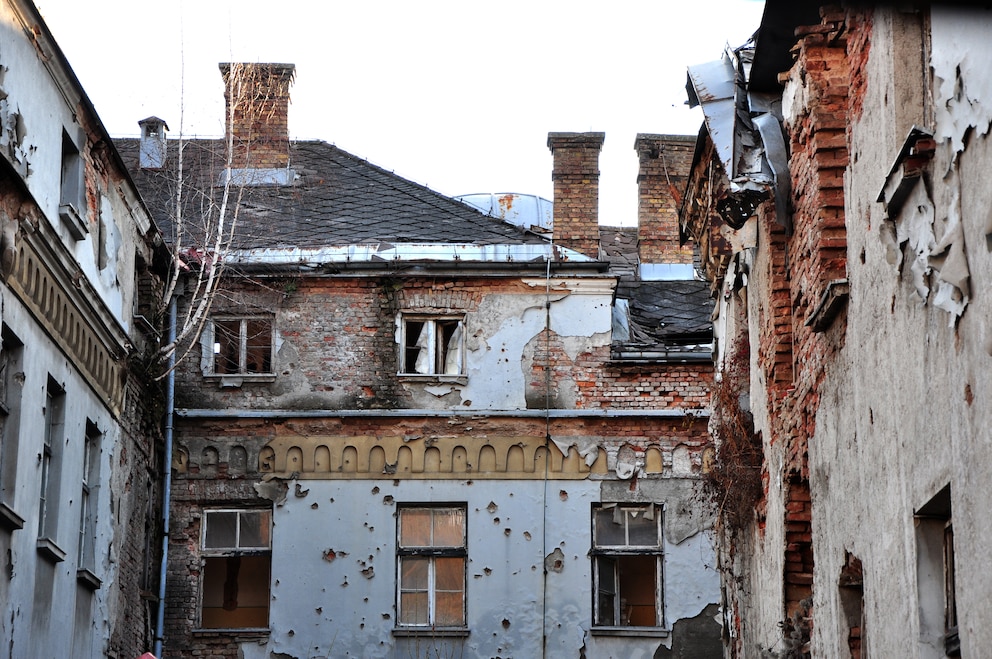
18. Sowjetisches Ehrenmal in Berlin, Deutschland
Das 1949 errichtete sowjetische Ehrenmal im Treptower Park ist nicht nur das größte solcher Denkmale außerhalb der ehemaligen Sowjetunion, sondern auch ein mächtiges Zeichen des Sieges im „Großen Vaterländischen Krieg“ und der Macht der Sowjetunion. Das Gelände ist riesengroß, und ich habe mich sehr klein gefühlt, als ich den langen Weg zu der Soldatenstatue gelaufen bin. Als ich vor der Statue stand, fand ich aber vor allem die Tatsache beeindruckend, dass das Monument an den Sieg von der Sowjetunion über Nazi- Deutschland erinnern soll und dabei in der damaligen DDR steht. Alle drei Staaten sind inzwischen Geschichte.
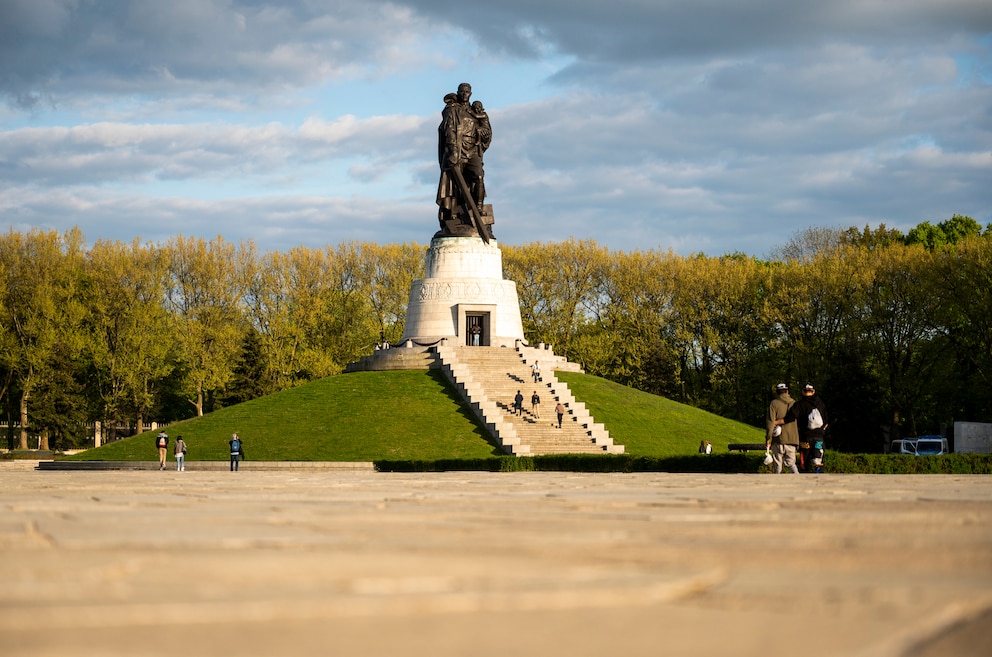
Auch interessant: Auf der Welt verteilt – hier überall steht die Berliner Mauer
19. Wünsdorf, Brandenburg
Ich bin mit dem Zug in die Stadt Wünsdorf ganz in der Nähe von Berlin gefahren. Vor dem Zerfall der Sowjetunion wäre eine solche Reise ohne eine Sondergenehmigung nicht möglich gewesen, denn die Stadt war nach dem Zweiten Weltkrieg zum Sitz der Sowjetischen Streitkräfte in der damaligen DDR geworden. In diesem „kleinen Moskau“ habe ich Spuren dieser Zeit in den Ruinen wiedergefunden. Überall stehen verlassene Gebäude, und in den Wäldern sind noch sowjetische Statuen zu finden. Im „Haus der Offiziere“ stand ich vor einer der letzten Statuen Lenins in Deutschland.
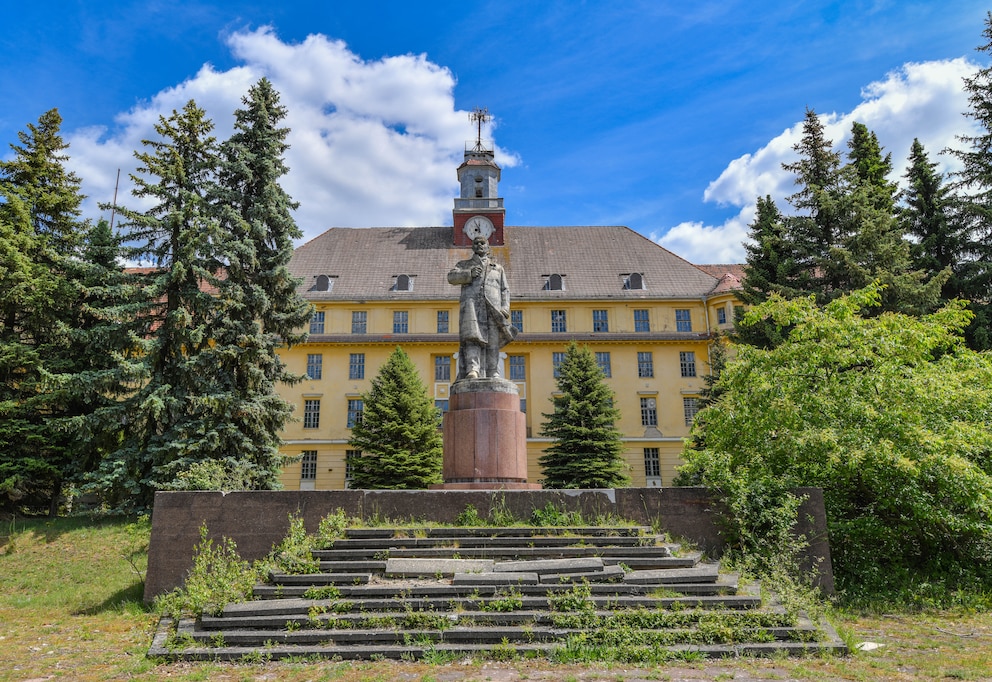
Auch interessant: Die Knochenkirche von Sedletz – eine beliebte Touristenattraktion in Tschechien

Urlaub an morbiden Orten Was sich hinter dem neuen Trend „Dark Tourism“ verbirgt

Stille Zeitzeugen Die schreckliche Geschichte der Olympia-Ruinen von Sarajevo

Heute ein Lost Place und Museum „Objekt 825“ in Balaklawa – zu Sowjet-Zeiten ein geheimer U-Boot-Hafen
20. sedletz-ossarium in kutná hora, tschechien.
Diese Kapelle in der Nähe von Prag birgt ein dunkles Geheimnis: Sie ist komplett mit Knochen dekoriert. 1870 hat ein Künstler namens Frantisek Rint die Knochen der dort begrabenen Menschen zu Ornamenten zusammengefügt. Als ich in die Kapelle hereinkam, schlug mir Feuchtigkeit entgegen. Dann stand ich unter einem riesigen Kronleuchter aus Knochen und habe für einen Moment vergessen, dass ich in einer Kapelle war. Das Beinhaus von Kutná Hora wird jedes Jahr von mehr als 200.000 Menschen besucht.
Hier geht es zur Webseite von Sebastián Cuevas mit weiteren spannenden Dark-Tourism-Zielen
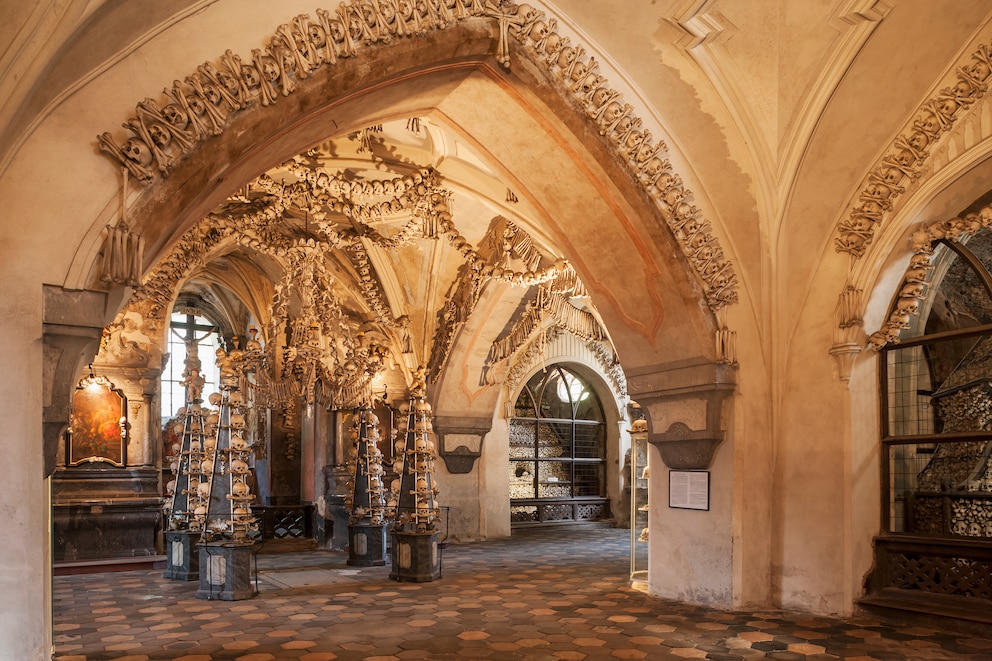
How 'dark tourism' can pass on the lessons of past tragedies

Solar panels in Namie, Fukushima prefecture, which was severely affected by the 2011 nuclear power plant accident. Image: Unsplash/Rei Yamazaki
.chakra .wef-1c7l3mo{-webkit-transition:all 0.15s ease-out;transition:all 0.15s ease-out;cursor:pointer;-webkit-text-decoration:none;text-decoration:none;outline:none;color:inherit;}.chakra .wef-1c7l3mo:hover,.chakra .wef-1c7l3mo[data-hover]{-webkit-text-decoration:underline;text-decoration:underline;}.chakra .wef-1c7l3mo:focus,.chakra .wef-1c7l3mo[data-focus]{box-shadow:0 0 0 3px rgba(168,203,251,0.5);} Naoko Kutty
Naoko tochibayashi.

.chakra .wef-9dduvl{margin-top:16px;margin-bottom:16px;line-height:1.388;font-size:1.25rem;}@media screen and (min-width:56.5rem){.chakra .wef-9dduvl{font-size:1.125rem;}} Explore and monitor how .chakra .wef-15eoq1r{margin-top:16px;margin-bottom:16px;line-height:1.388;font-size:1.25rem;color:#F7DB5E;}@media screen and (min-width:56.5rem){.chakra .wef-15eoq1r{font-size:1.125rem;}} Travel and Tourism is affecting economies, industries and global issues

.chakra .wef-1nk5u5d{margin-top:16px;margin-bottom:16px;line-height:1.388;color:#2846F8;font-size:1.25rem;}@media screen and (min-width:56.5rem){.chakra .wef-1nk5u5d{font-size:1.125rem;}} Get involved with our crowdsourced digital platform to deliver impact at scale
Stay up to date:, travel and tourism.
Listen to the article
- 'Dark tourism' is a new kind of travel experience seeking to impart lessons from past tragedies.
- Tours in Japan's Tohoku region reflect on the devastation and recovery from the 2011 earthquake.
- Creating unique social and cultural value for the affected region, dark tourism has economic benefits too.
Twelve years have passed since the Great East Japan earthquake and tsunami struck on 11 March 2011, causing devastation, mainly in the Tohoku region. In the areas that suffered tremendous damage, tourism promotion is seeking to pass on the memories of the disaster and to use them as lessons in the process of reconstruction.
Dark tourism , journeys through people's memories of wars, natural disasters and other catastrophes, is attracting attention around the world as a new type of travel experience. It was first proposed in the UK in the 1990s and rapidly spread throughout Europe.
Have you read?
4 ways nature tourism can help drive a green covid-19 recovery, how global tourism can become more sustainable, inclusive and resilient, japan has eased travel restrictions - but will the tourism sector bounce back.
The Auschwitz-Birkenau concentration camp in Poland is the most famous dark tourism spot; the concept has been justified by the idea that the horrors of Nazism in World War Two must never be repeated. Dark tourism has spread rapidly in the United States since the 2001 terrorist attacks.
The value of dark tourism
Associate Professor Akira Ide of Kanazawa University, who has pioneered the study of the phenomenon in Japan and introduced the concept domestically, emphasizes that dark tourism has many possibilities, such as passing on lessons learned, reconsidering ways of life, and reflecting on the modern era. He elaborates that the preservation of historical remains and the existence of storytellers help to connect to memories of past tragedies, and that it is important to support them economically through tourism and to connect the lessons of the past to the future. The dark tourism methodology can be a means of creating value that is unique to a particular region, in doing so developing a completely different kind of tourism.
Touring Japan's disaster zones
There are 25 UNESCO World Heritage sites in Japan, including the Atomic Bomb Dome in Hiroshima, one of the most famous dark tourism destinations. However, it is distinguished from the others in that it is "negative world heritage" that conveys the tragic consequences of war and has been constructed to prevent such tragedies from happening again. In 2019, before the spread of COVID-19, a record 1.76 million tourists visited Hiroshima Peace Memorial Museum, located on the same site as the Atomic Bomb Dome.
Following the example of Hiroshima, dark tourism is flourishing in the Tohoku region. In 2022, a record 1.15 million visitors have visited the earthquake and tsunami memorial museums and other facilities in Iwate, Miyagi and Fukushima prefectures affected by the 2011 disaster. The number of visitors, which had been declining due to the spread of COVID-19, has recovered significantly, driven by the growing trend to incorporate learning about the earthquake disaster into tourism and the increase in the number of disaster memorial sites.
In Sendai City, Miyagi prefecture, 25 taxi companies in the city provide a storyteller taxi tour in which the drivers double as a guide to disaster-stricken areas. Certified drivers trained by the non-profit Recovery Assistance Center of Miyagi, they also advise visitors on disaster mitigation, saying: “We want people to be aware of the threat of tsunami so be well-prepared in case of an emergency.”
'Hope tourism' in Fukushima
Fukushima Prefecture, where the earthquake and tsunami caused a nuclear power plant accident, prefers to emphasize " hope tourism ", instead of dark tourism, focusing not only on recollecting the disaster but also on people who have risen again and are making strides in recovery. It is putting efforts into activities that pass on the lessons of the disaster and promote tourism.
Hope Tourism is a group tour that Fukushima Prefecture launched seven years ago, with a record 15,000 participants in 2022. The tour package includes visits to facilities such as the Great East Japan Earthquake and Nuclear Disaster Memorial Museum in Futaba; an elementary school in Namie, the prefecture's only earthquake memorial ruin; and the Fukushima Robot Test Field in Minamisoma, as well as dialogue and interaction with local residents, workshops, and more.
Lessons of the past
This year marks the 100th anniversary of the Great Kanto earthquake , and with a 70% probability of a major quake occurring along the Nankai Trough within the next 30 years, people in Japan are becoming more and more concerned about disaster prevention.
In 2005, the World Economic Forum helped to establish the Logistics Emergency Teams (LET) , a network of representatives from four of the world’s largest logistics and transport companies (Agility, DP World, Maersk and UPS) who work together in partnership with the World Food Programme-led Global Logistics Cluster to deliver free humanitarian assistance.
To date, the LET has responded to more than 20 large-scale natural disasters and humanitarian crises, providing critical logistical support for hurricane victims in Haiti, Rohingya refugees in Bangladesh, tsunami victims in Indonesia, civilians in war-ravaged Yemen and many more.
In 2018, 1,943 employees of LET member companies were trained in humanitarian logistics, contingency operations and disaster response to ensure that they were better prepared for future crises.
Read more about how the LET initiative continues to be an exemplary model for public-private partnerships.
Contact us if you're interested in getting involved in impactful initiatives as a member or partner of the World Economic Forum.
Inheriting the memory of past tragedies via dark tourism helps prepare for the future and can bring economic benefits too. With the Japanese government now significantly easing COVID-19 guidelines on mask-wearing, the resulting increase in tourism should help boost this new type of travel experience that has the potential to turn human misery into positive life lessons.
Don't miss any update on this topic
Create a free account and access your personalized content collection with our latest publications and analyses.
License and Republishing
World Economic Forum articles may be republished in accordance with the Creative Commons Attribution-NonCommercial-NoDerivatives 4.0 International Public License, and in accordance with our Terms of Use.
The views expressed in this article are those of the author alone and not the World Economic Forum.
The Agenda .chakra .wef-n7bacu{margin-top:16px;margin-bottom:16px;line-height:1.388;font-weight:400;} Weekly
A weekly update of the most important issues driving the global agenda
.chakra .wef-1dtnjt5{display:-webkit-box;display:-webkit-flex;display:-ms-flexbox;display:flex;-webkit-align-items:center;-webkit-box-align:center;-ms-flex-align:center;align-items:center;-webkit-flex-wrap:wrap;-ms-flex-wrap:wrap;flex-wrap:wrap;} More on Travel and Tourism .chakra .wef-nr1rr4{display:-webkit-inline-box;display:-webkit-inline-flex;display:-ms-inline-flexbox;display:inline-flex;white-space:normal;vertical-align:middle;text-transform:uppercase;font-size:0.75rem;border-radius:0.25rem;font-weight:700;-webkit-align-items:center;-webkit-box-align:center;-ms-flex-align:center;align-items:center;line-height:1.2;-webkit-letter-spacing:1.25px;-moz-letter-spacing:1.25px;-ms-letter-spacing:1.25px;letter-spacing:1.25px;background:none;padding:0px;color:#B3B3B3;-webkit-box-decoration-break:clone;box-decoration-break:clone;-webkit-box-decoration-break:clone;}@media screen and (min-width:37.5rem){.chakra .wef-nr1rr4{font-size:0.875rem;}}@media screen and (min-width:56.5rem){.chakra .wef-nr1rr4{font-size:1rem;}} See all

How Japan is attracting digital nomads to shape local economies and innovation
Naoko Tochibayashi and Naoko Kutty
March 28, 2024

Turning tourism into development: Mitigating risks and leveraging heritage assets
Abeer Al Akel and Maimunah Mohd Sharif
February 15, 2024

Buses are key to fuelling Indian women's economic success. Here's why
Priya Singh
February 8, 2024

These are the world’s most powerful passports to have in 2024
Thea de Gallier
January 31, 2024

These are the world’s 9 most powerful passports in 2024

South Korea is launching a special visa for K-pop lovers
- Share full article
Advertisement
Supported by
Beaches? Cruises? ‘Dark’ Tourists Prefer the Gloomy and Macabre
Travelers who use their off time to visit places like the Chernobyl nuclear plant or current conflict zones say they no longer want a sanitized version of a troubled world.

By Maria Cramer
North Korea. East Timor. Nagorno-Karabakh, a mountainous enclave that for decades has been a tinderbox for ethnic conflict between Armenians and Azerbaijanis.
They’re not your typical top tourist destinations.
But don’t tell that to Erik Faarlund, the editor of a photography website from Norway, who has visited all three. His next “dream” trip is to tour San Fernando in the Philippines around Easter , when people volunteer to be nailed to a cross to commemorate the suffering of Jesus Christ, a practice discouraged by the Catholic Church.
Mr. Faarlund, whose wife prefers sunning on Mediterranean beaches, said he often travels alone.
“She wonders why on earth I want to go to these places, and I wonder why on earth she goes to the places she goes to,” he said.
Mr. Faarlund, 52, has visited places that fall under a category of travel known as dark tourism , an all-encompassing term that boils down to visiting places associated with death, tragedy and the macabre.
As travel opens up, most people are using their vacation time for the typical goals: to escape reality, relax and recharge. Not so dark tourists, who use their vacation time to plunge deeper into the bleak, even violent corners of the world.
They say going to abandoned nuclear plants or countries where genocides took place is a way to understand the harsh realities of current political turmoil, climate calamities, war and the growing threat of authoritarianism.
“When the whole world is on fire and flooded and no one can afford their energy bills, lying on a beach at a five-star resort feels embarrassing,” said Jodie Joyce, who handles contracts for a genome sequencing company in England and has visited Chernobyl and North Korea .
Mr. Faarlund, who does not see his travels as dark tourism, said he wants to visit places “that function totally differently from the way things are run at home.”
Whatever their motivations, Mr. Faarlund and Ms. Joyce are hardly alone.
Eighty-two percent of American travelers said they have visited at least one dark tourism destination in their lifetime, according to a study published in September by Passport-photo.online, which surveyed more than 900 people. More than half of those surveyed said they preferred visiting “active” or former war zones. About 30 percent said that once the war in Ukraine ends, they wanted to visit the Azovstal steel plant, where Ukrainian soldiers resisted Russian forces for months .
The growing popularity of dark tourism suggests more and more people are resisting vacations that promise escapism, choosing instead to witness firsthand the sites of suffering they have only read about, said Gareth Johnson, a founder of Young Pioneer Tours , which organized trips for Ms. Joyce and Mr. Faarlund.
Tourists, he said, are tired of “getting a sanitized version of the world.”
A pastime that goes back to Gladiator Days
The term “dark tourism” was coined in 1996, by two academics from Scotland, J. John Lennon and Malcolm Foley, who wrote “Dark Tourism: The Attraction to Death and Disaster.”
But people have used their leisure time to witness horror for hundreds of years, said Craig Wight, associate professor of tourism management at Edinburgh Napier University.
“It goes back to the gladiator battles” of ancient Rome, he said. “People coming to watch public hangings. You had tourists sitting comfortably in carriages watching the Battle of Waterloo.”
Professor Wight said the modern dark tourist usually goes to a site defined by tragedy to make a connection to the place, a feeling that is difficult to achieve by just reading about it.
By that definition, anyone can be a dark tourist. A tourist who takes a weekend trip to New York City may visit Ground Zero. Visitors to Boston may drive north to Salem to learn more about the persecution of people accused of witchcraft in the 17th century. Travelers to Germany or Poland might visit a concentration camp. They might have any number of motivations, from honoring victims of genocide to getting a better understanding of history. But in general, a dark tourist is someone who makes a habit of seeking out places that are either tragic, morbid or even dangerous, whether the destinations are local or as far away as Chernobyl.
In recent years, as tour operators have sprung up worldwide promising deep dives into places known for recent tragedy, media attention has followed and so have questions about the intentions of visitors, said Dorina-Maria Buda, a professor of tourism studies at Nottingham Trent University .
Stories of people gawking at neighborhoods in New Orleans destroyed by Hurricane Katrina or posing for selfies at Dachau led to disgust and outrage .
Were people driven to visit these sites out of a “sense of voyeurism or is it a sense of sharing in the pain and showing support?” Professor Buda said.
Most dark tourists are not voyeurs who pose for photos at Auschwitz, said Sian Staudinger, who runs the Austria-based Dark Tourist Trips , which organizes itineraries in the United Kingdom and other parts of Europe and instructs travelers to follow rules like “NO SELFIES!”
“Dark tourists in general ask meaningful questions,” Ms. Staudinger said. “They don’t talk too loud. They don’t laugh. They’re not taking photos at a concentration camp.”
‘Ethically murky territory’
David Farrier , a journalist from New Zealand, spent a year documenting travels to places like Aokigahara , the so-called suicide forest in Japan, the luxury prison Pablo Escobar built for himself in Colombia and McKamey Manor in Tennessee, a notorious haunted house tour where people sign up to be buried alive, submerged in cold water until they feel like they will drown and beaten.
The journey was turned into a show, “Dark Tourist,” that streamed on Netflix in 2018 and was derided by some critics as ghoulish and “sordid.”
Mr. Farrier, 39, said he often questioned the moral implications of his trips.
“It’s very ethically murky territory,” Mr. Farrier said.
But it felt worthwhile to “roll the cameras” on places and rituals that most people want to know about but will never experience, he said.
Visiting places where terrible events unfolded was humbling and helped him confront his fear of death.
He said he felt privileged to have visited most of the places he saw, except McKamey Manor.
“That was deranged,” Mr. Farrier said.
Professor Buda said dark tourists she has interviewed have described feelings of shock and fear at seeing armed soldiers on streets of countries where there is ongoing conflict or that are run by dictatorships.
“When you’re part of a society that is by and large stable and you’ve gotten into an established routine, travel to these places leads you to sort of feel alive,” she said.
But that travel can present real danger.
In 2015, Otto Warmbier , a 21-year-old student from Ohio who traveled with Young Pioneer Tours, was arrested in North Korea after he was accused of stealing a poster off a hotel wall. He was detained for 17 months and was comatose when he was released. He died in 2017, six days after he was brought back to the United States.
The North Korean government said Mr. Warmbier died of botulism but his family said his brain was damaged after he was tortured.
Americans can no longer travel to North Korea unless their passports are validated by the State Department.
A chance to reflect
Even ghost tours — the lighter side of dark tourism — can present dilemmas for tour operators, said Andrea Janes, the owner and founder of Boroughs of the Dead: Macabre New York City Walking Tours.
In 2021, she and her staff questioned whether to restart tours so soon after the pandemic in a city where refrigerated trucks serving as makeshift morgues sat in a marine terminal for months.
They reopened and were surprised when tours booked up fast. People were particularly eager to hear the ghost stories of Roosevelt Island, the site of a shuttered 19th-century hospital where smallpox patients were treated .
“We should have seen as historians that people would want to talk about death in a time of plague,” Ms. Janes said.
Kathy Biehl, who lives in Jefferson Township, N.J., and has gone on a dozen ghost tours with Ms. Janes’s company, recalled taking the tour “Ghosts of the Titanic” along the Hudson River. It was around 2017, when headlines were dominated by President Trump’s tough stance on refugees and immigrants coming into the United States.
Those stories seemed to dovetail with the 100-year-old tales of immigrants trying to make it to New York on a doomed ship, Ms. Biehl said.
It led to “a catharsis” for many on the tour, she said. “People were on the verge of tears over immigration.”
Part of the appeal of dark tourism is its ability to help people process what is happening “as the world gets darker and gloomier,” said Jeffrey S. Podoshen , a professor of marketing at Franklin and Marshall College, who specializes in dark tourism.
“People are trying to understand dark things, trying to understand things like the realities of death, dying and violence,” he said. “They look at this type of tourism as a way to prepare themselves.”
Mr. Faarlund, the photo editor, recalled one trip with his wife and twin sons: a private tour of Cambodia that included a visit to the Killing Fields , where between 1975 and 1979 more than 2 million Cambodians were killed or died of starvation and disease under the Khmer Rouge regime.
His boys, then 14, listened intently to unsparing and brutal stories of the torture center run by the Khmer Rouge. At one point, the boys had to go outside, where they sat quietly for a long time.
“They needed a break,” Mr. Faarlund said. “It was quite mature of them.”
Afterward, they met two of the survivors of the Khmer Rouge, fragile men in their 80s and 90s. The teenagers asked if they could hug them and the men obliged, Mr. Faarlund said.
It was a moving trip that also included visits to temples, among them Angkor Wat in Siem Reap, and meals of frog, oysters and squid at a roadside restaurant.
“They loved it,” Mr. Faarlund said of his family.
Still, he can’t see them coming with him to see people re-enact the crucifixion in the Philippines.
“I don’t think they want to go with me on that one,” Mr. Faarlund said.

52 Places for a Changed World
The 2022 list highlights places around the globe where travelers can be part of the solution.
Follow New York Times Travel on Instagram , Twitter and Facebook . And sign up for our weekly Travel Dispatch newsletter to receive expert tips on traveling smarter and inspiration for your next vacation. Dreaming up a future getaway or just armchair traveling? Check out our 52 Places for a Changed World for 2022.
Maria Cramer is a reporter on the Travel desk. Please send her tips, questions and complaints about traveling, especially on cruises. More about Maria Cramer
Open Up Your World
Considering a trip, or just some armchair traveling here are some ideas..
52 Places: Why do we travel? For food, culture, adventure, natural beauty? Our 2024 list has all those elements, and more .
Mumbai: Spend 36 hours in this fast-changing Indian city by exploring ancient caves, catching a concert in a former textile mill and feasting on mangoes.
Kyoto: The Japanese city’s dry gardens offer spots for quiet contemplation in an increasingly overtouristed destination.
Iceland: The country markets itself as a destination to see the northern lights. But they can be elusive, as one writer recently found .
Texas: Canoeing the Rio Grande near Big Bend National Park can be magical. But as the river dries, it’s getting harder to find where a boat will actually float .

Dark Tourism
Urlaub an orten mit dunkler geschichte.
Durch das ehemalige KZ Auschwitz gehen, die Sperrzone von Tschernobyl entdecken und die erste Nervenheilanstalt der Welt besuchen – Dark Tourism ist eine außergewöhnliche Art des Reisens, die mit Tragödie verbunden wird. Wir verraten euch, was es mit diesem Phänomen auf sich hat.
Warum tauschen immer mehr Urlauber Dark Tourism gegen einen entspannten Strandurlaub ein? Wie kommt es, dass Touristen ihren Urlaub in verlassenen Städten, an Orten des Schreckens und Schauplätzen von Krieg, Tod und Folter verbringen wollen? Wir erklären euch, was Dark Tourism, also Katastrophentourismus, genau ist und zeigen euch die grauenhaftesten Orte der Welt .
Alles über Dark Tourism
- Erklärung
- 10 Dark Tourism Destinationen
- No Go’s
Was ist Dark Tourism?
Dark Tourism wird auch Katastrophentourismus oder Thanatourism genannt und beschreibt das Reisen an Orte, die von Leiden, Schmerz, Verbrechen, Naturkatastrophen oder Tod geprägt sind. Teilweise vermitteln manche Gedenkstätten lehrreiche und geschichtliche Hintergründe, während andere auch die reine Sensationsgeilheit neugieriger Touristen anziehen. Auch lokale Tourismusagenturen wittern immer häufiger die Chance, lukrative Geschäfte mit Horror oder dem Leiden anderer Leute zu machen und Touren durch die schlimmsten Gegenden anzubieten.
Dark Tourist auf Netflix
Besonders durch die auf Netflix laufende Dokumentationsreihe Dark Tourist wird das Thema immer bekannter. Dort reist ein Reporter an die gefährlichsten Orte der Welt, begibt sich auf die Spuren des Killers Pablo Escobar, geht in das verlassene Gebiet der Nuklear-Katastrophe in Fukushima und auf die Geisterinsel Hashima, streift durch den Selbstmordwald Aokigahara und beobachtet Dämonenaustreibungen in Mexiko.
Gründe für das Phänomen Dark Tourism
Doch warum bezahlen Touristen freiwillig teils hohe Preise, um in Kriegsgebiete oder an Tatorte brutalster Verbrechen zu reisen? Vielen Besuchern hilft es, diese Orte mit eigenen Augen zu sehen und die beklemmende Atmosphäre zu spüren, um sich in die Rolle der Opfer hineinzuversetzen, Geschichten zu verstehen und ihr Mitgefühl zu stärken. Andere suchen nur den besonderen Nervenkitzel zwischen dem gewöhnlichen Sightseeing-Programm. Auch um sich selbst in eine bessere Position zu bringen, konfrontieren sich Menschen mit dem Leid anderer, um dann festzustellen, wie gut sie es selbst haben.
10 Dark Tourism Ziele weltweit
Jedes Land hat seine dunkle Geschichte, weshalb es auch auf der ganzen Welt verteilt düstere Orte gibt, die Schauplätze des Krieges und des Schreckens wurden. Wir zeigen euch ein paar Beispiele – die zehn krassesten Dark Tourism Orte .
1. Killing Fields in Kambodscha
Bis vor gerade einmal etwas mehr als 40 Jahren herrschte in Kambodscha ein skrupelloses Regime – die Roten Khmer – das alles städtische Leben beenden wollte. Dafür wurde die gesamte städtische Bevölkerung aus ihrer Heimat auf brutalen Gewaltmärschen aufs Land zu sogenannten Killing Fields getrieben.
Dort wurden alle Gebildeten, Lehrer, Ärzte und Studenten erbarmungslos ermordet . Insgesamt starb ein Drittel der Bevölkerung. Auch Babys und Kinder wurden an einem Baum zu Tode geschlagen, an dem ihr heute noch unzählige Armbänder seht, die an das unglaubliche Verbrechen erinnern sollen. Der Horror an dem Gedenkort ist heute noch überwältigend: Zahlreiche Massengräber befördern bei Regen immer wieder Knochen ans Licht. Ein Gang aus wandhohen Glasvitrinen, gefüllt mit Schädeln der Verstorbenen, kann in dem Museum besichtigt werden.
2. Konzentrationslager in Deutschland
Auch unsere Nachbarn haben eine schreckliche Vergangenheit, wie ihr alle wisst. In Deutschland wird besonders darauf geachtet, dass die Geschichte nicht in Vergessenheit gerät, weshalb der Nationalsozialismus in jedem Geschichtskurs und in Dokumentationen immer wieder thematisiert wird.
- Ort/Lage: nahe München
- Öffnungszeiten: tägl. 9-17 Uhr
- Geführte Tour: tägl. 12 Uhr, 2,5 Std.
Eine KZ-Besichtigung gehört zum Pflichtprogramm und wird euch nachdenklich machen. Die Erinnerung an meinen ersten Besuch des beeindruckenden Geländes Buchenwald bei Weimar macht mich heute noch traurig. Dort ist der Eintritt übrigens sogar kostenlos. Auch in Dachau gab es ein KZ, dessen Besuch euch tiefgehend berühren und euch die erschreckende Realität vermitteln wird.
3. Auschwitz in Polen
Das größte und bekannteste Konzentrationslager der Nazis ist Auschwitz Birkenau in Polen, in dem über eine Millionen Menschen, hauptsächlich Juden, ermordet wurden oder an den Folgen von Hunger und Krankheiten starben. Auch grauenhafte, medizinische Experimente wurden hier an lebenden Menschen durchgeführt. Die Gedenkstätte gehört zu den meistbesuchtesten Dark Tourism Destinationen der Welt.
4. Geisterdorf in Frankreich
Ein weiteres SS-Massaker ereignete sich 1944 in dem französischen Oradour sur Glane . Rund 150 Soldaten umstellten das Dorf, dessen bewohnende Frauen und Kinder in eine Kirche gesperrt und in Brand gesetzt wurden, wohingegen die Männer des Dorfes erschossen und ebenfalls verbrannt wurden. Nur sechs Personen überlebten, während das restliche Dorf komplett ausgerottet und verwüstet wurde. Die Ruinen scheinen heute noch wie gerade verlassen, rostige Fahrräder und Autos stehen herum, in den Häusern findet ihr Nähmaschinen und Fotos, die an die Verstorbenen erinnern sollen.
5. Verdun – Frankreichs größtes Schlachtfeld
Auch Verdun liegt in Frankreich, wo vor vielen Jahren 300 Tage lang Soldaten verbissen gegeneinander kämpften und ca. 300.000 von ihnen ihr Leben ließen. Ein Meer aus weißen Kreuzen erinnert an jeden einzelnen von ihnen. Für viele Besucher ist die Besichtigung des stillen, bedrückenden Ortes wichtig, um zu verstehen wie wertvoll und alles andere als selbstverständlich der heutige europäische Zusammenhalt und Frieden ist, im Gegensatz zu den blutigen und sinnlosen Kriegen .
6. Ground Zero in New York
Viele von uns haben noch die Bilder von den brennenden, eingestürzten Türmen des World Trade Centers in New York aus den Nachrichten im Kopf, in deren Trümmern fast 3.000 Menschen ums Leben kamen. Der Anschlag gilt als einer der größten der Geschichte, weswegen der Ort des Schreckens zu einer großen Gedenkstätte, dem Ground Zero , ausgebaut wurde, den viele bei ihrem Sightseeing in New York besuchen. Als Dark Tourists bekommt ihr hier bei Workshops die Möglichkeit, mit Angehörigen und überlebenden Opfern zu sprechen und Fotos der Bergungsarbeiten sowie Überbleibsel aus den Büros anzuschauen. Das unfassbare Unglück soll euch so greifbarer gemacht werden.
7. Pompeji bei Neapel
Nicht nur Menschen können brutal sein, auch Naturkatastrophen fordern immer wieder Menschenleben.
So brachte der gigantische Vulkanausbruch im Jahr 79 n. Chr. 16.000 der 20.000 Einwohner Pompejis ums Leben. Diese starben in den heißen Glutwolken qualvoll und wurden mitsamt der Stadt zwölf bis 20 Meter hoch von Vulkanasche und Gestein begraben. Durch die Gesteinsschicht ist Pompeji heute eine der besterhaltensten Städte der Antike , die mittlerweile durch Ausgrabungen freigelegt wurde und zu den meistbesuchten Sehenswürdigkeiten Italiens gehört. Von dem jahrhundertealten Schutz befreit, leiden die Ruinen jetzt unter den zahlreichen Besuchern. Besonders fasziniert sind diese von den Leichenfiguren , die beim Ausgraben aus Gips entstanden, der in Hohlräume des Lavagesteins gekippt wurde.
8. Tschernobyl in der Ukraine
Hinweis: Aufgrund der aktuellen Kriegssituation und des Notstandes ist keine Einreise in die Ukraine möglich ! Mehr Infos findet ihr auf der Seite des BMEIA .
Die Katastrophe in Tschernobyl war der erste nukleare Unfall diesen Ausmaßes, die schwere gesundheitliche, teils tödliche Folgen für viele Menschen mit sich brachte. Kaum vorstellbar, dass heutzutage Touristen freiwillig in das immer noch verstrahlte, verlassene Gebiet reisen. In geführten Touren werdet ihr durch die evakuierten Wohnhäuser der Geisterstadt Prypjat geführt, könnt mit ehemaligen Bewohnern sprechen und bekommt sogar Zutritt in die Sperrzone und das Kernkraftwerk .
Die junge Organisation chernobylwel.com bietet verschiedenste Touren an. Ein Teil des Geldes wird direkt an krebskranke Kinder und die Babuschkas (Omas) von Tschernobyl gespendet.
Kritik an Tschernobyl Touristen
Der durch die Serie „Chernobyl“ ausgelöste Hype um Reisen in die Sperrzone löste jüngst eine Diskussion aus: Ist ein solcher Katastrophentourismus moralisch vertretbar oder aber ein Hohn für die Opfer? Besonders das Verhalten einiger Instagrammer, die sich in fraglichen Posen in Prypjat fotografieren lassen, sorgten dabei für Unmut. Verständlich – der Besuch eines Unglücksortes wie Tschernobyl sollte in den Augen der meisten Menschen zum Nachdenken anregen und nicht zur Selbstdarstellung genutzt werden.
9. Hiroshima in Japan
Auch in Japan kam es zu einer Nuklearkatastrophe, hier allerdings durch Menschen ausgelöst, die im Zweiten Weltkrieg 1945 die erste Atombombe abwarfen. 200.000 Einwohner kamen durch die Explosion oder spätere Folgen ums Leben. Verstrahlt ist das Gebiet heute nicht mehr sonderlich, hier floriert heute wieder eine lebendige Großstadt. Allein die Ruine, die sogenannte Atombombenkuppel, erinnert heute als Friedensdenkmal Hiroshima an die einstige Zerstörung. Ein bedrückender und gleichzeitig lehrreicher Ort.
10. Aokigahara Wald in Japan
Ein weiterer Ort in Japan, der immer häufiger Dark Tourists anzieht, ist der gespenstische Wald Aokigahara am Fuß des Fuji Vulkans, einer der gruseligsten Orte der Welt . In dem dichten, dunklen Wald kann man schnell die Orientierung verlieren und im Dickicht auf einige kalte Höhlen stoßen.
Nach einer japanischen Legende ist der Wald verflucht und angeblich von Yürei-Geistern bewohnt, die Besucher zum Suizid drängen und somit in den Tod locken wollen. Durch solche Geschichten ist der Wald tatsächlich zu einem anziehenden Ort für Lebensmüde geworden. Immer wieder werden Leichen im Wald gefunden, weshalb er auch als „ Selbstmordwald“ oder Suicide Forest bekannt ist.
Lehrreicher Tourismus oder Sensationslust?
Hat es auch euch in den Bann gezogen und ihr seid fasziniert von den geschichtsträchtigen, grauenhaften Orten? Oder schreckt euch die Vorstellung ab, freiwillig Tatorte von unbeschreiblichen Gräueltaten zu besuchen? Dark Tourism ist eine heikle Gratwanderung : Viele Menschen finden es unmöglich, dass mit Horror und dem Leiden Verstorbener heute noch Geld gemacht wird und neugierige, sensationslüsterne Touristen zum Gaffen dorthin strömen. Besonders Katastrophentourismus, bei dem Menschen nur zum Gucken an Unglücksorte wie das gekenterte Schiff Costa Concordia oder Kriegsgebiete in Afghanistan und Iran reisen, ist für die meisten unverständlich und erinnert an Schaulustige bei Verkehrsunfällen. Andere halten an der Notwendigkeit lehrreicher Gedenkstätten fest. Wenn ihr euch dazu entscheiden solltet, mal einen solchen Ort zu besuchen, solltet ihr euch vorher darüber klar werden, dass vor allem an Tatorten besonders vorsichtiges Verhalten angemessen ist.
No-Go’s und richtiges Verhalten
Haltet unbedingt von Touren Abstand, bei denen das Leiden keinerlei geschichtliche Bedeutung hat. Dazu gehören etwa Slum-Touren , bei denen Touristen in Scharen durch die schlimmsten Armenviertel gekarrt werden und die im Dreck lebenden Kinder wie Tiere im Zoo angeguckt und fotografiert werden. Fairerweise muss man sagen, dass es auch sehr gute Touren gibt, bei denen die Bewohner selbst ihr Leben im Slum vorstellen und von dem Erlös profitieren.
Was leider auch vorkommt, ist unangemessenes Verhalten der Touristen wie etwa fröhliche Selfies an Orten zu schießen, an denen Menschen ums Leben kamen. Zeigt Respekt gegenüber der Opfer und macht unbedingt andere Touristen darauf aufmerksam, falls ihr so ein Verhalten beobachtet. Informiert euch schon im Voraus über die grobe Geschichte, kleidet euch angemessen und verhaltet euch vor Ort ruhig und zurückhaltend. Lasst Handys und Kameras in der Tasche – diese Erlebnisse werdet ihr sowieso nie vergessen.
Wie steht ihr zum Thema Dark Tourism?
Wie ihr merkt, gibt es zahlreiche spannende und abscheuliche Orte, die an furchtbare Geschehnisse erinnern. Über den Dark Tourism scheiden sich die Geister: Jedem ist selbst überlassen, ob diese Art der Rundreise vertretbar ist oder nicht. Was denkt ihr darüber? Lasst es uns in den Kommentaren wissen und nehmt an unserer Umfrage teil!
Das könnte euch auch interessieren
Die gruseligsten orte der welt.
Diese verlassenen Orte machen garantiert Gänsehaut
Gruseliges Transsilvanien
Unterwegs in der Heimat Draculas
Gruselhotels für Halloween
Diese Unterkünfte machen Angst und faszinieren zugleich
Was ist Halloween?
Die Herkunft der Tradition und wie sie weltweit gefeiert wird

Was sagst du dazu? Antwort verwerfen
Meinen Namen, E-Mail und Website in diesem Browser speichern, bis ich wieder kommentiere.

17 Must-Visit Dark Tourism Destinations Around the World
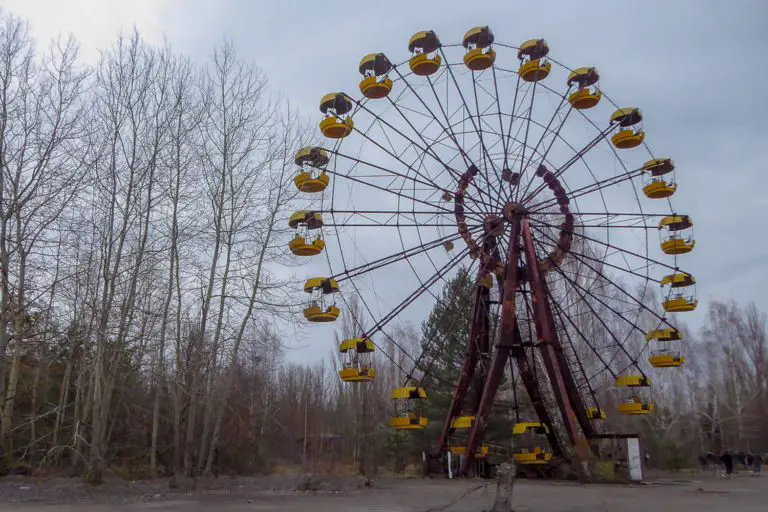
Dark Tourism destinations were once the remit of a select group of travellers. However, after the launch of popular Netflix show Dark Tourist, these attractions have hit the mainstream.
If you’re interested in the morbid and the macabre, look no further. After making several visits to dark history sites myself, I’ve teamed up with other travellers to bring you this list of dark tourism destinations all around the world.
Read more: (opens in new tab)
- What is Dark Tourism?
- Are Bolivia’s Mine Tours Ethical?
- Chernobyl Exclusion Zone Photographic Guide
17 Must-Visit Dark Tourism Destinations
1. chernobyl exclusion zone – kyiv, ukraine.
The abandoned amusement park in Pripyat is one of dark tourism’s crowning images. The haunting stills of the fairground that never heard the laughs of children hang in modern consciousness, a symbol of tragic loss and a warning of the mistakes men can make.
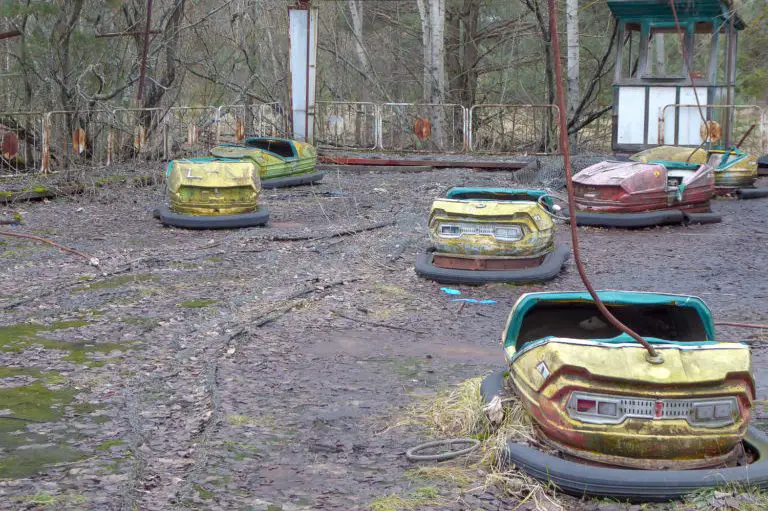
In 1986, the nuclear reactor at the Chernobyl power plant exploded, causing the worst nuclear accident in the world’s history. The effects were huge; people were forced to evacuate their homes and the surrounding areas became a hotbed of radiation. It was predicted that never again in our lifetime, would Chernobyl be inhabited by anything living.
Surprisingly, the Chernobyl exclusion zone has recovered quicker than was ever predicted. Although there are still risks with spending long periods in the exclusion zone, wild animals have returned and are thriving. Despite its recovery, Chernobyl acts as a very sobering reminder of the damage humanity can do without intention.
2. Sucre Cemetery – Sucre, Bolivia
Sucre Cemetery is an unlikely attraction in Bolivia’s capital. Regularly appearing on tourist maps, it is a peaceful place which attracts visitors who come to see how the Bolivians handle death and all that comes after.
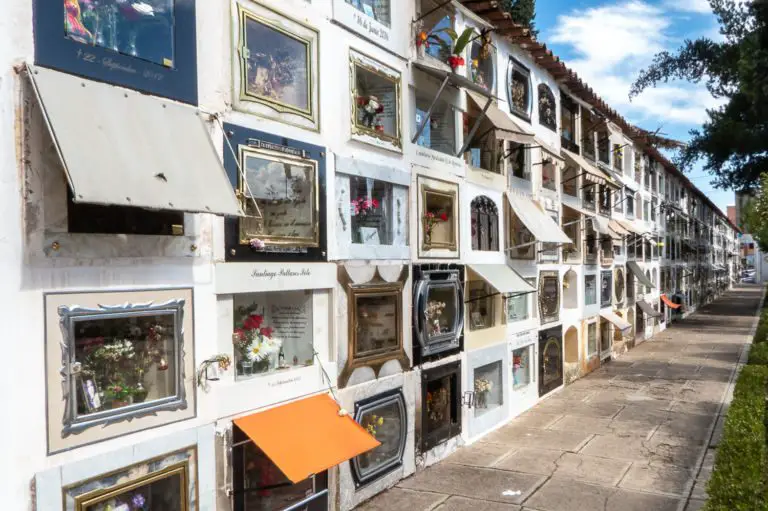
Also frequently visited by locals, this cemetery is a surprisingly popular spot for catching up with friends, studying and paying homage to the dearly departed.
Unlike other cemeteries I’d visited, these graves were arranged in a block system above ground. The vast majority of these were carefully maintained and were regularly stocked with gifts for departed loved ones. Small bottles of spirits were a common appearance, alongside slices of cake!
In Bolivia, death is accepted as an inevitability of life. While graveyards ultimately provide a space for burial, they hold a far more important symbolic role in Bolivian culture. Although death is traditionally seen as a dividing force, Sucre Cemetery demonstrates that death can continue to unite us all, long after somebody is gone.
3. The Poison Garden – Alnwick, England
Home to around 100 toxic and narcotic plants, the Poison Garden is undoubtedly one of the best things to do in Alnwick . This small but deadly garden is home to some of the world’s most dangerous plants and visitors are only allowed to enter on a guided tour.
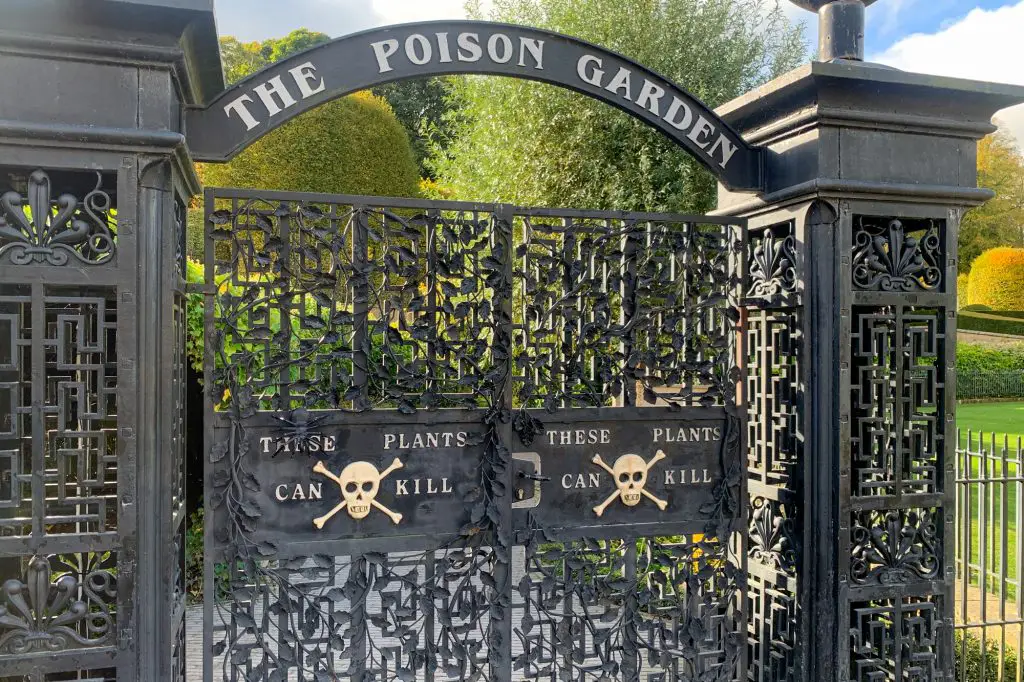
Deadly nightshade, cannabis and coca (the plant from which cocaine is derived) are a few examples of the plants housed in the Poison Garden. Visitors are prohibited from touching any of the greenery and there have even been cases of people passing out after smelling the plants!
The tour guides at the Poison Garden are great at explaining the real-life application of the plants using case studies such as Harold Shipman (Doctor Death) and Graham Young (The Teacup Poisoner). The garden also runs tours for local school children, educating them about drug use.
4. Paneriai Massacre Site – Vilnius, Lithuania
Paneriai is one of Vilnius’ many neighbourhoods. However, it will be forever remembered as the Ponary massacre site. The Einsatzgruppen (Nazi death squads) rounded up groups of Jews from the Vilna Ghetto, took them to Paneriai, executed them and forced other Jewish prisoners to dig mass graves and bury them.
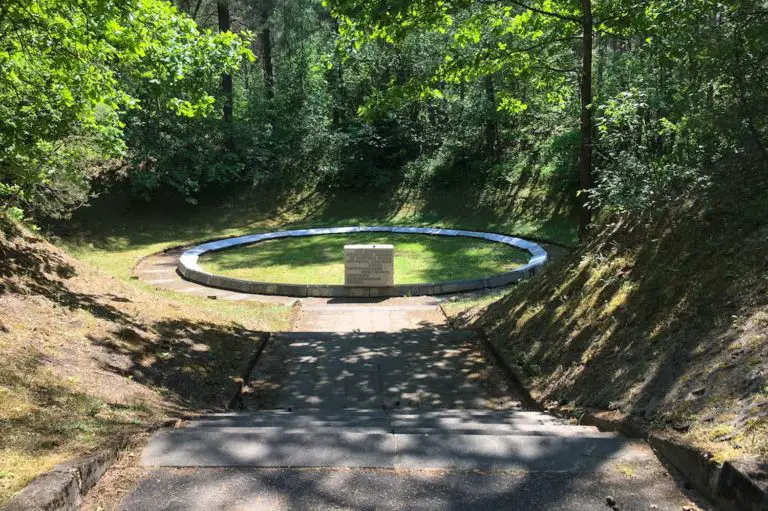
There are six burial sites within the complex, each the site of multiple mass executions. Because so many sets of bodies are stacked on each other, it is impossible to know the exact number of deaths. It is estimated to be around 100,000.
Those brought to Paneriai were burned to death in an attempt to destroy evidence. They were then shovelled into the pits, which today are marked by memorials. Like many of the massacre sites in the Baltics, Paneriai is a forested area. This makes walking around a surreal experience as it is quiet, peaceful and beautiful, a stark contrast to the memorials reminding you that thousands of people were slaughtered there.
Contributed by Cultura Obscura . Follow them on Facebook !
5. St. Nicholas’ Church – Hamburg, Germany
In July 1943, Hamburg was the target of an allied aerial World War Two bombing. The tall spire of St. Nicholas’ Church was used as an orientation marker and the building was almost completely destroyed. All that remained were some external walls, the crypt and most of the tower.
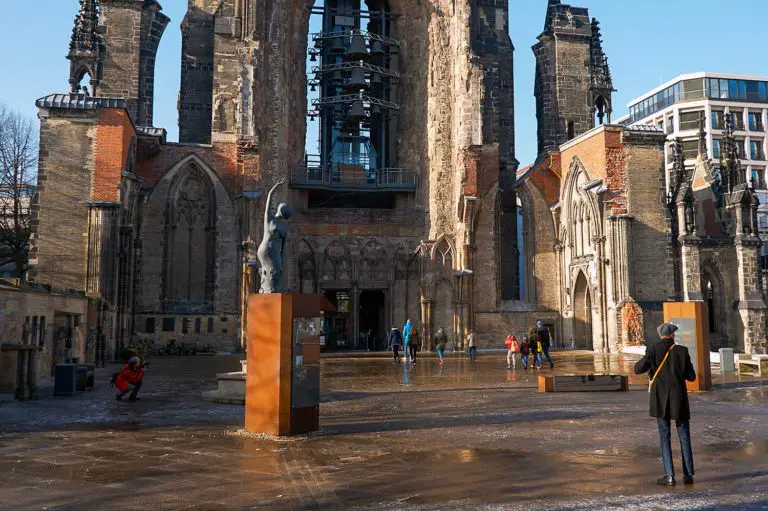
Today, St. Nicholas’ Church stands as a memorial to the victims of WWII. The memorial exhibits in the crypt provide many details of the events leading up to Operation Gomorrah , the air war over Europe. Beautiful sculptures sit inside, illustrating the futility of war and its disastrous consequences. A 51-bell carillon has been installed in the tower and sounds every Thursday at noon.
We visited the church on a walking tour of Hamburg and the experience still haunts me. The vast majority of people in Hamburg during Operation Gomorrah would have been perfectly ordinary citizens going about their daily lives – people just like me.
Contributed by Lesley of Freedom 56 Travel . Follow her on Twitter !
6. Comuna 13 – Medellin, Colombia
Medellin was once the most dangerous city in the world. When infamous drug lord Pablo Escobar controlled the city, crime was extremely high and the locals lived in fear. The neighbourhood of Comuna 13 had direct access to the main highway, making the exportation of drugs, weapons and other illegal goods extremely easy.
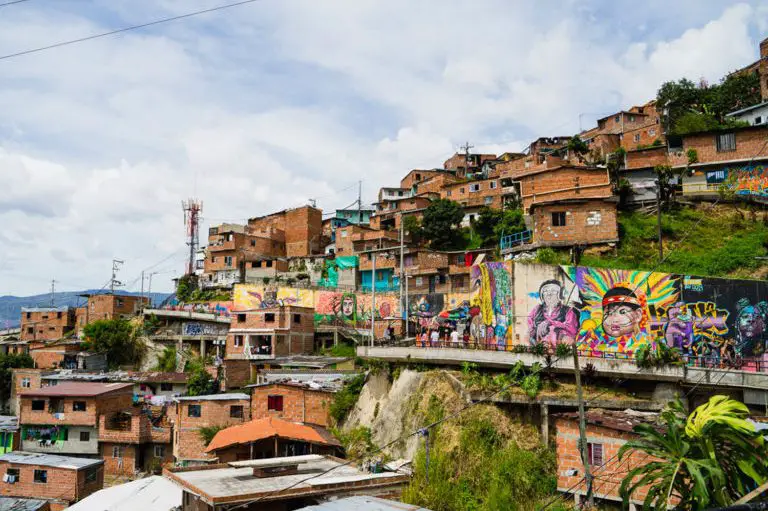
Drug cartels fought over control of the area and as a result, Comuna 13 was a very dangerous place. It was not uncommon to hear gunshots throughout the day and even to see dead bodies piled on the street. With that in mind, it might come as a surprise that Comuna 13 is now one of the most visited neighbourhoods in Medellin.
Over recent years, a tremendous amount of money has been invested in Comuna 13. A cable car system was installed to link it to the city centre. The resulting increase in tourism has sparked real change for the locals and the neighbourhood has become one of the country’s leading creative hubs.
Contributed by LivingOutLau . Follow him on Instagram !
7. Gulag Labour Camps – Karaganda, Kazakhstan
My trip to Kazakhstan left a deep impression on me. While I had heard about the so-called gulags, I did not know that most of them were in Kazakhstan. Stalin deported whole ethnic groups to the remotest corners of the country. This is how during WWII, the Volga Germans ended up in Karaganda .
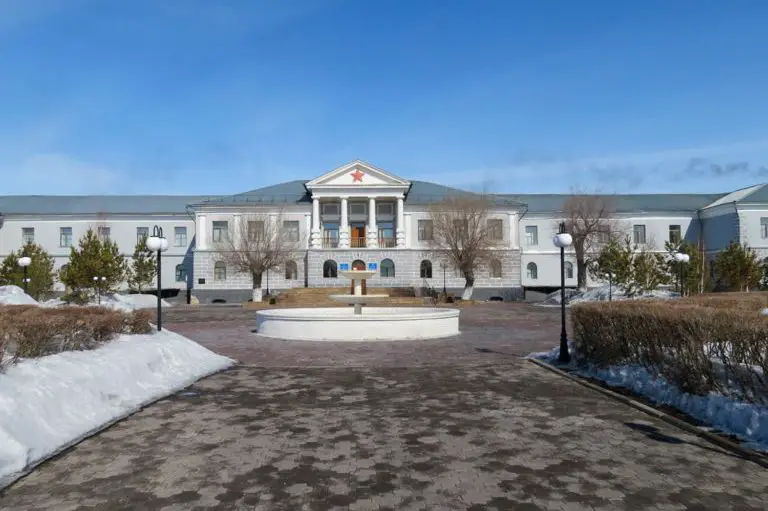
Stalin wanted to develop the farms and coal mines in Karaganda and set up a network of labour camps to support these projects. Political prisoners and deportees provided the free labour that was necessary.
Even though not much of the labour camps remain, Karaganda is the perfect example of a dark tourist site. There is an excellent Gulag Museum in the former headquarters of the labour camp in Dolinka.
Also nearby, the Ecological Museum covers other dark parts of Soviet history. The museum has an exhibition on the nuclear tests done in Kazakhstan and the debris that falls from the sky from the space program in Baikonur.
Contributed by Ellis of Backpack Adventures. Follow her on Instagram !
8. The Eruption of Mount Vesuvius – Pompeii, Italy
Pompeii was a thriving coastal city in Italy that was completely destroyed in 79AD when the neighbouring Mount Vesuvius erupted and covered the city in ash. It is a prime example of what is termed disaster tourism, where tourists visit a location where an environmental disaster has occurred.
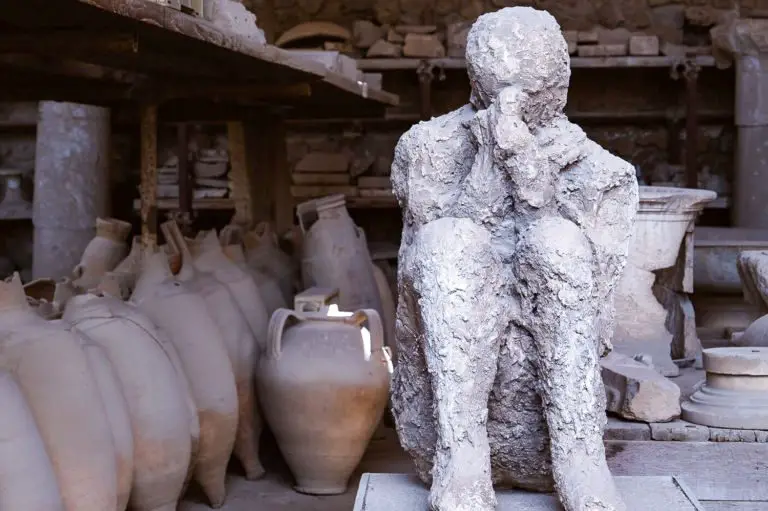
What makes the eruption of Mount Vesuvius more tragic was that the majority of people who died were slaves, who either had no means of escaping or were trapped. When archaeologists began excavating the site, they found several bodies. The ash preserved these bodies which allowed historians to create the human casts we see on site today.
Seeing these casts in crouching positions while covering their faces, gave me shivers. To get a greater understanding of the site and everything inside of it, I highly suggest finding a good tour guide. This photographic travel guide to Pompeii gives lots more tips for planning a visit.
Contributed by Natasha of And Then I Met Yoko. Follow Natasha on Instagram !
9. Mary King’s Close – Edinburgh, United Kingdom
Below the Royal Mile in Edinburgh hides an underground street paved with dark history. Mary King’s Close was alive with residents when the bubonic plague seized the country in 1645. The grievous epidemic turned the once-thriving close into a dreadful place, where its inhabitants suffered a slow and torturous death.
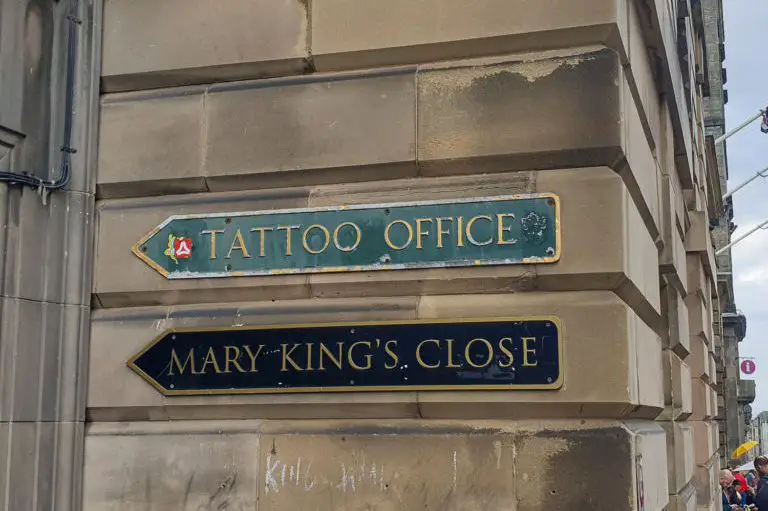
Mary King’s Close was sealed off and used as a foundation for the Royal Exchange in the late 1700s. Years passed and its terrible secrets were left trapped within its dark walls. In the 1990s, the close was rediscovered and opened to the public, allowing people to explore the subterranean streets that once festered with disease.
The mental image of the street once bustling with life left a lump in my throat – the locals had no idea how many would lose their lives to the Great Plague. Like Mary King’s Close, the entire city of Edinburgh is filled with dark and spooky places so be sure to check out Scotland’s capital if you’re a fan of the macabre.
Contributed by Wandering Crystal. Follow her on Instagram !
10. The Killing Fields and S-21 – Phnom Penh, Cambodia
During the Khmer Rouge genocide in Cambodia, execution, starvation and disease were allowed to flourish, killing an estimated three million people. Led by Pol Pot, the regime attempted to enforce brutal and inhumane policies to push Cambodia into being a classless society.
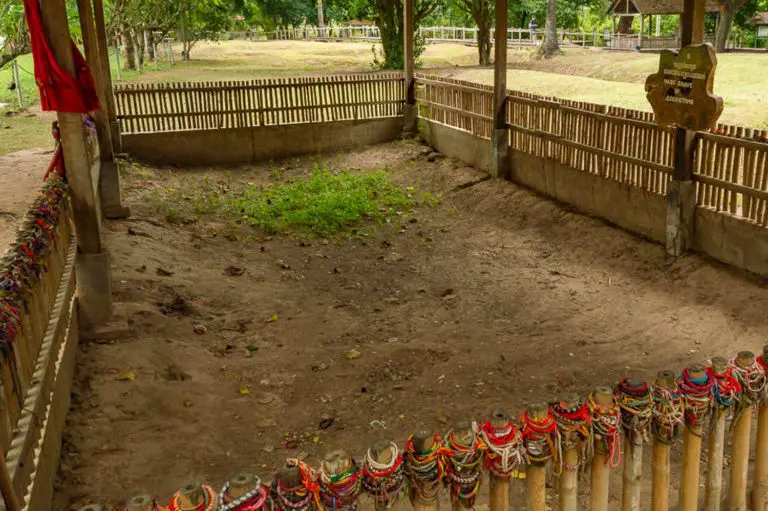
Phnom Penh and the surrounding area are home to S-21, a political prison used by the regime, and Choeung Ek, the largest of the Killing Fields. Over 12,000 prisoners were held at S-21 during the regime and with only seven known survivors, it’s a place known for unthinkable torture and suffering. The S-21 site now houses the Tuol Sleng Genocide Museum where you can learn more about the Cambodian massacre.
Much like S-21, a tour of the Cambodian Killing Fields can be hard to digest. There is a memorial stupa filled with the skulls of victims and you can still see bone fragments and strips of clothing along the paths. It’s a horrifying place but important to visit to ensure history doesn’t repeat itself.
Contributed by Ben at Horizon Unknown . Follow him on Facebook !
11. Abandoned Ghost Palace – Bali, Indonesia
Located near the village of Bedugul lies an abandoned hotel. Legend has it that in the early 1990s, the hotel began to be constructed by Tommy Suharto, the youngest son of the former Indonesian President. Tommy was later convicted of ordering the assassination of a judge who previously found him guilty of corruption and he subsequently went to prison. The hotel was never completed.
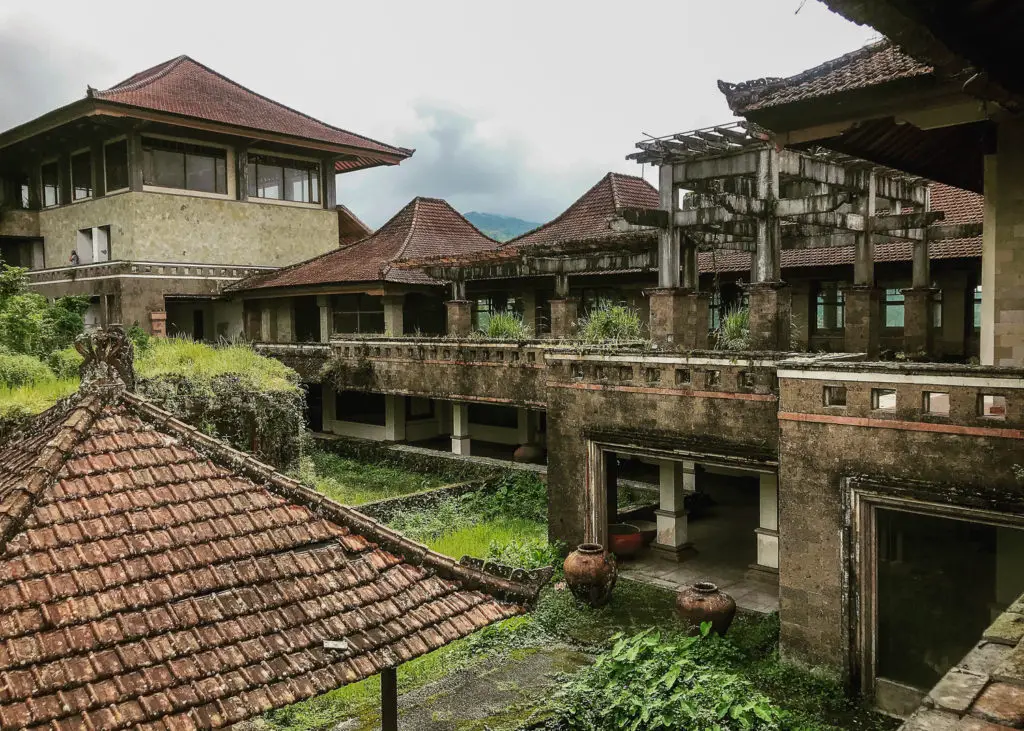
Another theory is that the hotel is haunted by the landlocked souls of labourers who were worked to death during its construction. The hotel, originally named Hotel Pondok Indah Bedugul, isn’t open for visitors but if you hand the guard 10,000 IDR, he’ll let you in to explore. I recommend seeing it as soon as possible because rumours indicate that visitors will no longer be permitted entrance (even with a bribe) because of how dangerous it is.
Contributed by Nat Wanderlust.
12. Auschwitz-Birkenau – Oświęcim, Poland
The “Final Solution to the Jewish Question” was the official code name for the murder of Jews during World War II. At least 1.3 million people were sent to Auschwitz by the Nazis and a shocking 1.1 million people were murdered by the SS, mainly in gas chambers.
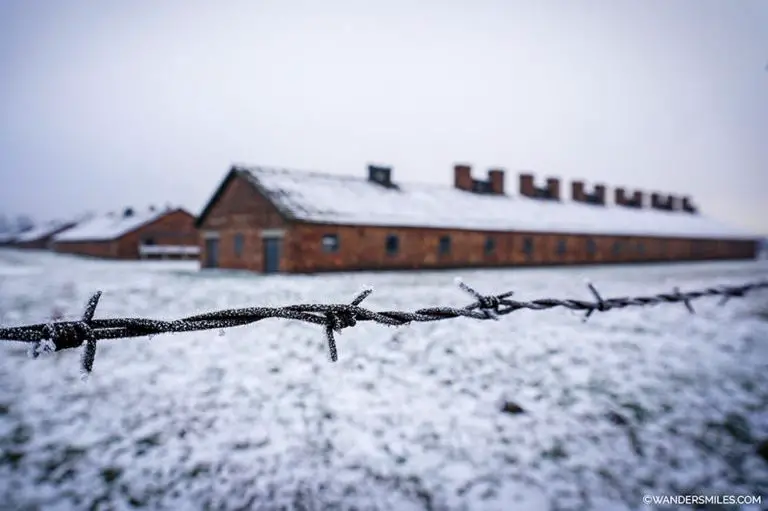
Auschwitz-Birkenau is located on two different sites. Auschwitz I comprises brick buildings and the Death Block where people were gassed. Auschwitz II, known as Birkenau, was opened as they could not cope with the scale of death at Auschwitz I.
On arrival, you’ll see the famous train tracks where people were transported in and either sent to the gas chambers or given labour duty. Once the latter were emaciated, they were gassed and replaced with new prisoners.
I cried in horror seeing the piles of shoes, suitcases and false legs that once belonged to people. Human hair was used to make felt for socks given to the forces in submarines – 293 sacks of hair were found on liberation. Words cannot describe the emotions you’ll have upon seeing this symbol of this horrific dark chapter in our history.
Contributed by Vanessa from Wanders Miles, follow her on Instagram !
13. Day of the Dead – Oaxaca, Mexico
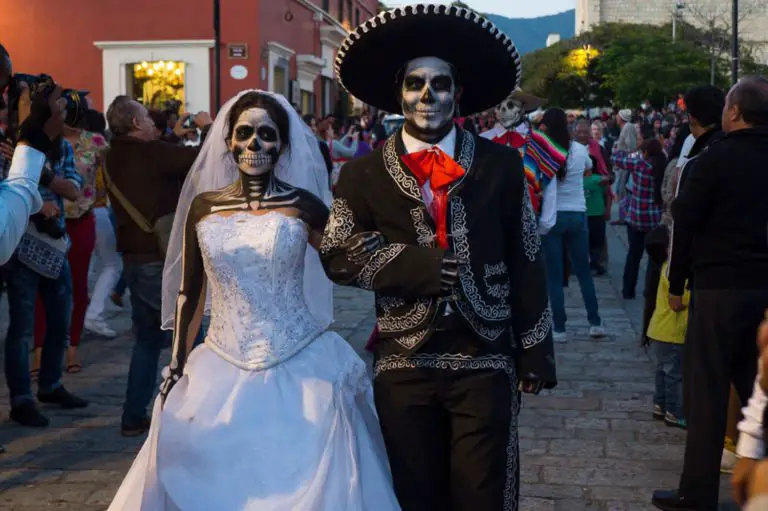
The Mexican Day of the Dead festival is a darkly uplifting event that occurs each year between October 31st and November 2nd. On these days, family and friends celebrate the lives of loved ones passed. It is widely believed that for three days each year, the veil between this world and the next is especially thin.
During the Day of the Dead festival, the spirits of the departed return to provide counsel to their living family members and friends. Much of the reunion is celebrated within the cemetery, where graves are cleaned and decorated for the occasion. On certain dates, families spend the whole night in the cemetery eating sugar skull sweets, drinking alcohol and playing music.
UNESCO recognises ‘Dia de Los Muertos’ as being ‘ Intangible Cultural Heritage of Humanity ’. Experiencing the Day of the Dead is a once-in-a-lifetime opportunity; especially in Oaxaca where visiting graves is commonplace. Prepare for everything you have ever thought about death to be challenged.
Contributed by Castaway With Crystal. Follow her on Instagram!
14. Red Terror Martyrs’ Museum – Addis Ababa, Ethiopia
The military junta who took power after Ethiopia’s Emperor Haile Selassie was ousted were known as the Derg. After prolonged internal wranglings, Mengistu, a soldier from the ranks, emerged as their leader and the dictator of Ethiopia.
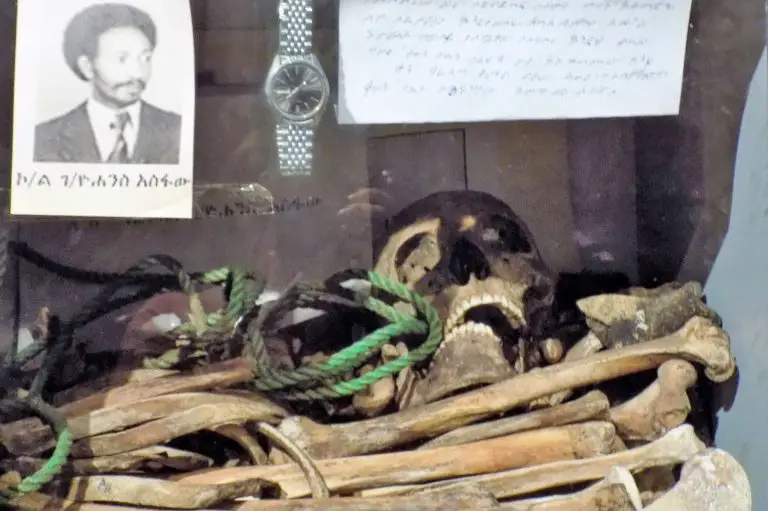
Within a couple of years, the Derg had created terror among ordinary Ethiopians, tens of thousands of whom had been imprisoned without trial and tortured, or worse, executed. The term ‘Red Terror’ comes from Mengistu’s famous speech when he smashed a bottle of blood to illustrate the killings to come. His regime is estimated to be responsible for the deaths of between 1.2 and 2 million Ethiopians.
Today, the horrors of Mengistu’s regime are remembered in the Red Terror Martyrs’ Museum in Addis Ababa . Opened in 2010, this small museum teaches about the atrocities of the regime. Photos of victims cover the walls alongside displays of human remains recovered from mass graves. We came away from the Martyrs’ Museum appalled by man’s inhumanity to man.
Contributed by Andrea of Happy Days Travel Blog. Follow her on Facebook !
15. Constitution Hill – Johannesburg, South Africa
Constitution Hill is now a living museum which tells the story of South Africa’s journey to democracy. It’s hard to comprehend that people like Nelson Mandela and Mahatma Gandhi served time here in the 1960s and that the prison was still operational until 1982.
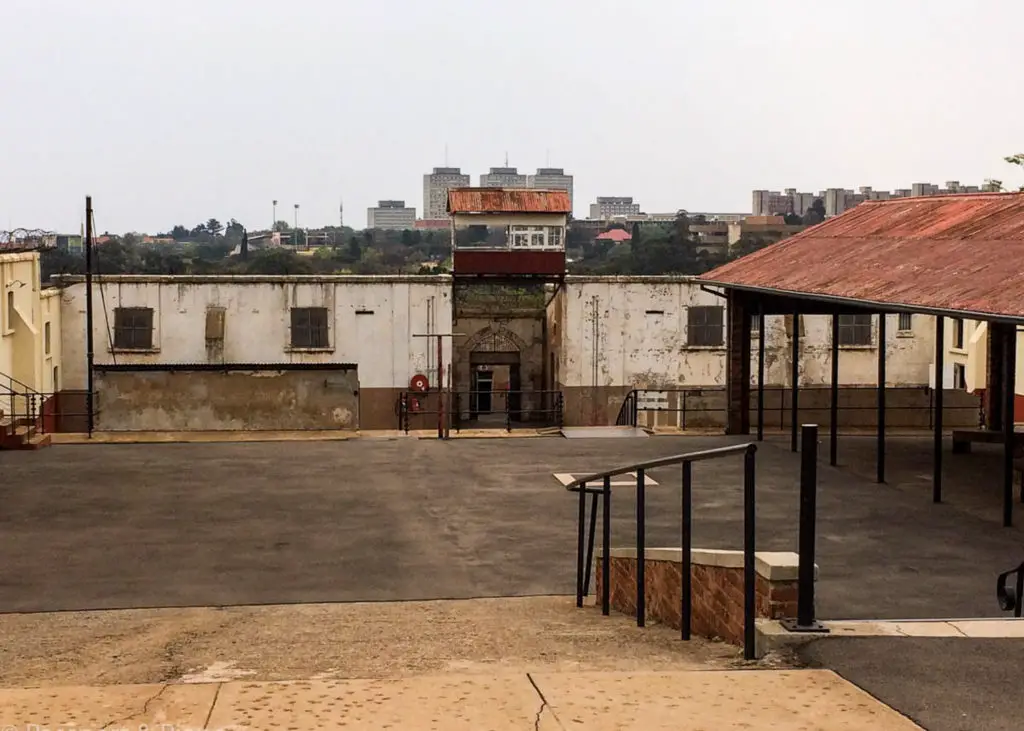
There are several sites that you can visit at Constitution Hill. The Old Fort is where white male prisoners were housed. Although the cells were overcrowded and unhygienic, the rooms are larger than those of the black prisoners. They were held in Block number 4. There was very little daylight and as I stepped inside, I was terrified that someone would shut the cell door behind me.
There’s also the Awaiting Trial Block. The block was demolished and the bricks were used to build South Africa’s new Constitutional Court. Thankfully this court serves to uphold the rights of all South Africans, regardless of colour, but the bricks are a poignant reminder of its troubled past.
Contributed by Fiona of Passport and Piano . Follow her on Facebook !
16. Shanghai Tunnels – Portland, USA
In a city known for the slogan ‘ Keep Portland Weird ,’ the Shanghai Tunnels fit right in. It’s believed that from 1850 until 1941, men in Portland, Oregon, were regularly kidnapped and sold to ship captains as labourers. During this period, there was a shortage of labour available for the city’s booming shipping industry and this created a black market.
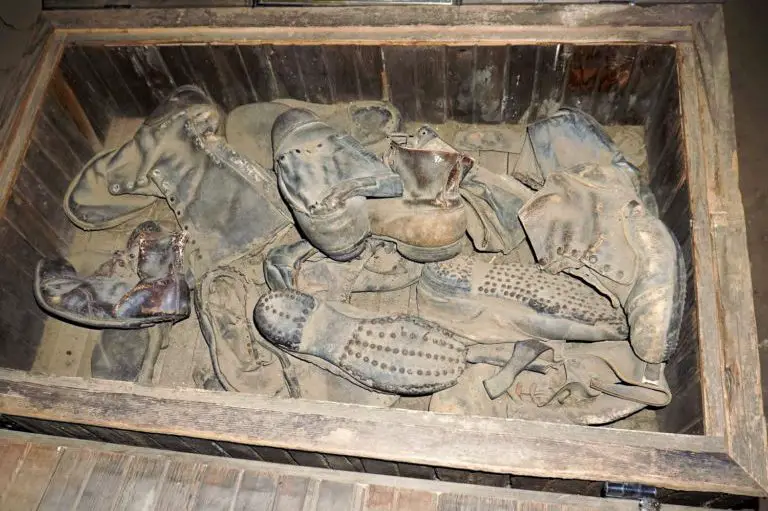
To capture these men, underground tunnels originally built to move inventory between businesses were repurposed for illicit use. Trapdoors were even installed in some of the local bars so that drunk men would drop into the tunnel below.
Today, tours of these tunnels are offered daily by a non-profit organisation, Shanghai Tunnels/Portland Underground. All tour participants are advised to be prepared for spending an hour in a confined space. While the nature of the tour is sad and tragic, it’s an important part of Portland’s history.
Contributed by Wendy of Empty Nesters Hit the Road. Follow her on Facebook !
17. Brno Ossuary – Brno, Czech Republic
Of the attractions in Brno , several of them could be classed as dark tourism attractions. The one that moved me the most, though, was the ossuary underneath the St. James Church.
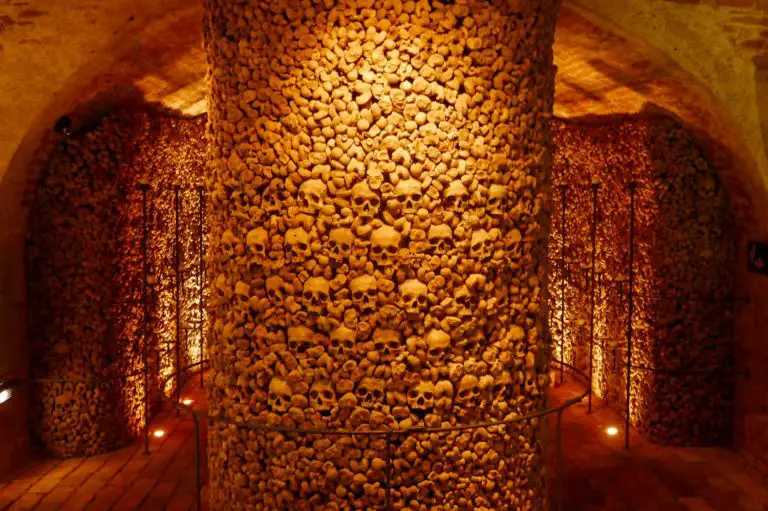
Surrounding this church, which is known as the ‘Kostnice u sv. Jakuba’ in Czech, was one of the main churchyard cemeteries in Brno. Eventually, as the city grew, there was no room left for new burials so a grave rotation system was adopted.
When a burial took place, the body was left in the grave for between 10 to 12 years. After that, the bones were taken out to make room for the next burial. The displaced remains were then relocated to the ossuary, where bones from thousands of graves were piled up.
It’s estimated that Brno Ossuary holds the bones of more than 50,000 people, which makes it the second-largest ossuary in Europe; only second to the Paris catacombs. The mortal remains laid to rest here include victims of the Swedish siege of Brno and the Thirty Years’ War, as well as many victims of plague and cholera epidemics.
Contributed by Wendy of The Nomadic Vegan. Follow her on Instagram !
Do you have any dark tourism examples to share? Let us know in the comments!
9 thoughts on “17 Must-Visit Dark Tourism Destinations Around the World”
Comuna 13 is spellt with only 1 -m-.
I wonder why choose the cemetery in Sucre, when so many others are more characteristic (eg. Père Lachaise in Paris) or even ‘livelier’ (eg. in Santiago de Chile).
Interesting & important topic though. I’m in the process of rewriting an article about the mines of Potosi. That is one dark tourism destination I strongly oppose, for one simple reason; people are still dying in there.
Thanks for the heads up Anthony! 🙂
I chose the cemetery in Sucre because it was a little bit off the beaten track – I like visiting the lesser known places as well as the more famous ones.
I can understand your point about the mines of Potosí and can see why you disagree with it. I must say though, from my own personal experience, I found my visit to be hugely enlightening. I was initially very torn about the idea of visiting an active mine but in the end, we chose a company run by an ex-miner who took us into the mine personally. In my opinion, our visit never felt voyeuristic at all and the miners seemed very grateful for the tourists visiting. A percentage of the tour cost went directly into the funding the healthcare of the miners when needed and also towards maintenance of the mine.
Such a great and informative post, Sheree! There were so many sites here that I was not even aware of – that is why sharing posts about dark tourist sites is so important! It really helps educate the world and helps us honour the past and the lives that were lost at some of these sites.
Like you, I am a huge fan of cemeteries. It is so wonderful that some countries treat death as a natural normal part of life (unlike some of our countries!). It really helps people remember happy memories of their loved ones they recently lost.
Thanks so much for being a part of it Crystal! I also learnt about loads of new dark tourism sites – it has definitely been an eduction as there was plenty of these I had never even heard of. It is definitely important to make sure the stories behind these places get told.
Thank you for including us in this fantastic collab!
I love how varied these sites are, and that you’ve included a lot of lesser know dark tourism destinations mixed in with some of the big ones. Even as professional dark tourists (that’s a thing, right?), we hadn’t heard of all of these places. The Shanghai Tunnels were completely new to me, but definitely want to head to Portland now.
I’m also a little embarrassed to admit that despite being to Hamburg MANY times, I was not aware of the St. Nicholas’ Church. I blame that on the fact that I was visiting a friend and not really touristing…
Awesome post everyone! I think it is really important for people to visit at least one of these in their lifetime. I think we are jaded from the major events that happened to our world and it’s people when we are told the stories. To see the places in real life, it puts life into perspective and how crazy life can be if we don’t fight for what is right.
I couldn’t agree more. Even though visiting these kinds of places is hard, I still think it is really important to help us realise the human effect of what we see on the television. As you said, it is only once you truly understand the devastation that you realise the importance of fighting for the right things.
Great article . I’ve been to a lot of places around the world and haven’t even heard of some of these .
Thanks Jennifer! I’ve certainly added a lot of places to my future visit list!
Leave a comment Cancel reply
National Geographic content straight to your inbox—sign up for our popular newsletters here

Dark tourism: when tragedy meets tourism
The likes of Auschwitz, Ground Zero and Chernobyl are seeing increasing numbers of visitors, sparking the term 'dark tourism'. But is it voyeuristic or educational?
Days after 71 people died in a London tower block fire last June, something strange started to happen in the streets around it. Posters, hastily drawn by members of the grieving community of Grenfell Tower, appeared on fences and lamp posts in view of the building's blackened husk.
'Grenfell: A Tragedy Not A Tourist Attraction,' one read, adding — sarcastically — a hashtag and the word 'selfies'. As families still searched for missing inhabitants of the 24-storey block, and the political shock waves were being felt through the capital, people had started to arrive in North Kensington to take photos. Some were posing in selfie mode.
"It's not the Eiffel Tower," one resident told the BBC after the posters attracted the attention of the press. "You don't take a picture." Weeks later, local people were dismayed when a coachload of Chinese tourists pulled up nearby so that its occupants could get out and take photos.
Grenfell Tower, which still dominates the surrounding skyline (it's due to be demolished in late 2018), had become a site for 'dark tourism', a loose label for any sort of tourism that involves visiting places that owe their notoriety to death, disaster, an atrocity or what can also loosely be termed 'difficult heritage'.
It's a phenomenon that's on the rise as established sites such as Auschwitz and the September 11 museum in Manhattan enjoy record visitor numbers. Meanwhile, demand is rising among those more intrepid dark tourists who want to venture to the fallout zones of Chernobyl and Fukushima, as well as North Korea and Rwanda. In Sulawesi, Indonesia, Western tourists wielding GoPros pay to watch elaborate funeral ceremonies in the Toraja region, swapping notes afterwards on TripAdvisor.
Along the increasingly crowded dark-tourist trail, academics, tour operators and the residents of many destinations are asking searching questions about the ethics of modern tourism in an age of the selfie and the Instagram hashtag. When Pompeii, a dark tourist site long before the phrase existed, found itself on the Grand Tour of young European nobility in the 18th century, dozens of visitors scratched their names into its excavated walls. Now we leave our mark in different ways, but where should we draw the boundaries?
Questions like these have become the life's work of Dr Philip Stone , perhaps the world's leading academic expert on dark tourism. He has a background in business and marketing, and once managed a holiday camp in Scotland. But a fascination with societal attitudes to mortality led to a PhD in thanatology, the study of death, and a focus on tourism.
"I'm not even a person who enjoys going to these places," Stone says from the University of Central Lancashire, where he runs the Institute for Dark Tourism Research. "But what I am interested in is the way people face their own mortality by looking at other deaths of significance. Because we've become quite divorced from death yet we have this kind of packaging up of mortality in the visit economy which combines business, sociology, psychology under the banner of dark tourism. It's really fascinating to shine a light on that."
Historical roots
The term 'dark tourism' is far newer than the practice, which long predates Pompeii's emergence as a morbid attraction. Stone considers the Roman Colosseum to be one of the first dark tourist sites, where people travelled long distances to watch death as sport. Later, until the late 18th century, the appeal was starker still in central London, where people paid money to sit in grandstands to watch mass executions. Hawkers would sell pies at the site, which was roughly where Marble Arch stands today.
It was only in 1996 that 'dark tourism' entered the scholarly lexicon when two academics in Glasgow applied it while looking at sites associated with the assassination of JFK. Those who study dark tourism identify plenty of reasons for the growing phenomenon, including raised awareness of it as an identifiable thing. Access to sites has also improved with the advent of cheap air travel. It's hard to imagine that the Auschwitz-Birkenau memorial and museum would now welcome more than two million visitors a year (an average of almost 5,500 a day, more than two-thirds of whom travel to the Polish site from other countries in Europe) were it not for its proximity to Krakow's international airport.
Peter Hohenhaus, a widely travelled dark tourist based in Vienna, also points to the broader rise in off-the-beaten track tourism, beyond the territory of popular guidebooks and TripAdvisor rankings. "A lot of people don't want mainstream tourism and that often means engaging with places that have a more recent history than, say, a Roman ruin," he says. "You go to Sarajevo and most people remember the war being in the news so it feels closer to one's own biography."
Hohenhaus is also a fan of 'beauty in decay', the contemporary cultural movement in which urban ruins have become subject matter for expensive coffee-table books and a thousand Instagram accounts. The crossover with death is clear. "I've always been drawn to derelict things," the 54-year-old says. As a child in Hamburg, he would wonder at the destruction of war still visible around the city's harbour.
That childhood interest has developed into an obsession; Hohenhaus has visited 650 dark tourist sites in 90 countries, logging them all and more besides on his website . He has plans to put together the first dark tourism guidebook. His favourite holiday destination today is Chernobyl and its 'photogenic' ghost town. "You get to time travel back into the Soviet era but also into an apocalyptic future," he says. He also enjoys being emotionally challenged by these places. "I went to Treblinka in 2008 and heard the story of a teacher at an orphanage in Warsaw who was offered a chance to escape but refused and went with his children to the gas chambers. Stories like that are not everyday, you mull over them. Would you have done that?"
But while, like any tourism, dark tourism at its best is thought-provoking and educational, the example of Grenfell Tower hints at the unease felt at some sites about what can look like macabre voyeurism. "I remember the Lonely Planet Bluelist book had a chapter about dark tourism a while ago and one of the rules was 'don't go back too early'," Hohenhaus says. "But that's easier said than calculated. You have to be very aware of reactions and be discreet when you're not in a place with an entrance fee and a booklet." Hohenhaus said he had already thought about Grenfell Tower and admits he would be interested to see it up close. "It's big, it's dramatic, it's black and it's a story you've followed in the news," he says. "I can see the attraction. But I would not stand in the street taking a selfie."
A mirror to mortality
An urge to see and feel a place that has been reduced to disaster shorthand by months of media coverage is perhaps understandable, but Stone is most interested in the draw — conscious or otherwise — of destinations that hold up a mirror to our own mortality. "When we touch the memory of people who've gone what we're looking at is ourselves," he says. "That could have been us in that bombing or atrocity. We make relevant our own mortality." That process looks different across cultures — and generations — and Stone says we should take this into account before despairing of selfie takers at Grenfell Tower or Auschwitz.
"I've heard residents at Grenfell welcoming visitors because it keeps the disaster in the public realm, but they didn't like people taking photos because it's a visual reminder that you're a tourist and therefore somehow defunct of morality," he explains. "We're starting to look at selfies now. Are they selfish?" Stone argues that the language of social media means we no longer say "I was here", but "I am here — see me". He adds: "We live in a secular society where morality guidelines are increasingly blurred. It's easy for us to say that's right or wrong, but for many people it's not as simple as that."
"Travel itself is innately voyeuristic," argues Simon Cockerel, the general manager of Koryo Tours , a North Korea specialist based in Beijing. Cockerel, who has lived in China for 17 years and joined Koryo in 2002, says demand has grown dramatically for trips to Pyongyang and beyond, from 200 people a year in the mid 1990s, when the company started, to more than 5,000 more recently. He has visited the country more than 165 times and says some clients join his tours simply to bag another country, and some for bragging rights. But the majority have a genuine interest in discovering a country — and a people — beyond the headlines.
"I've found everyone who goes there to be sensitive and aware of the issues," he says. "The restrictions do create a framework for it to be a bit like a theme park visit but we work hard to blur those boundaries. More than 25 million people live in North Korea, and 24.99 million of them have nothing to do with what we read in the news and deserve to be seen as people not as zoo animals or lazy caricatures."
More challenging recently has been the US ban on its citizens going to North Korea, imposed last summer after the mysterious death of Otto Warmbier. The American student had been arrested in Pyongyang after being accused of trying to steal a propaganda poster. Americans made up about 20% of Koryo's business, but Cockerel argues the greater loss is to mutual perception in the countries. "The North Korean government represent Americans as literal wolves with sharpened nails," he says. "At least a few hundred Americans going there was a kind of bridgehead against that. Now that's gone."
At Grenfell Tower, responsible tourism may yet serve to keep alive the memory of the disaster, just as it does, after a dignified moratorium, at Auschwitz and the former Ground Zero. Hohenhaus says he will resist the urge to go until some sort of memorial is placed at the site of the tower. At around the time of a commemorative service at St Paul's Cathedral six months after the fire, there were calls for the site eventually to be turned into a memorial garden. The extent to which Hohenhaus and other dark tourists are welcomed will be decided by the people still living there.
Five of the world's dark tourism sites
1. North Korea Opened to visitors in the late 1980s, North Korea now attracts thousands of tourists each year for a peek behind the headlines.
2. Auschwitz-Birkenau The former Nazi death camp became a memorial in 1947 and a museum in 1955. It's grown since and in 2016 attracted a record two million visitors.
3. 9/11 Memorial and Museum Built in the crater left by the twin towers of the World Trade Center, the museum, opened in 2014, has won plaudits for its portrayal of a disaster and its impact.
4. Rwanda Visitor numbers to genocide memorials have grown in Cambodia and Bosnia as well as in Rwanda, where there are several sites dedicated to the 1994 massacre of up to a million people. The skulls of victims are displayed.
5. Chernobyl & Pripyat, Ukraine Several tour companies exist to send visitors to the exclusion zone and ghost town left otherwise empty after the nuclear accident in 1986. All are scanned for radiation as they leave.
Published in the March 2018 issue of National Geographic Traveller (UK)
Find us on social media
Facebook | Instagram | Twitter
Related Topics
- EDUCATIONAL TRAVEL
- CULTURAL TOURISM
- HISTORY AND CIVILIZATION
You May Also Like

They inspire us and teach us about the world: Meet our 2024 Travelers of the Year

An insider's guide to Denver, Colorado's wildly creative capital
Free bonus issue.

10 reasons to visit the East Coast in 2024

An architectural tour of the Georgian capital, Tbilisi

7 of the UK's best gallery cafes

A long weekend in Orkney

How to plan a walking tour of Glasgow in the footsteps of Charles Rennie Mackintosh
- History & Culture
- Photography
- Environment
- Paid Content
History & Culture
- History Magazine
- Mind, Body, Wonder
- Terms of Use
- Privacy Policy
- Your US State Privacy Rights
- Children's Online Privacy Policy
- Interest-Based Ads
- About Nielsen Measurement
- Do Not Sell or Share My Personal Information
- Nat Geo Home
- Attend a Live Event
- Book a Trip
- Inspire Your Kids
- Shop Nat Geo
- Visit the D.C. Museum
- Learn About Our Impact
- Support Our Mission
- Advertise With Us
- Customer Service
- Renew Subscription
- Manage Your Subscription
- Work at Nat Geo
- Sign Up for Our Newsletters
- Contribute to Protect the Planet
Copyright © 1996-2015 National Geographic Society Copyright © 2015-2024 National Geographic Partners, LLC. All rights reserved
Dark tourism: when tragedy meets tourism
The likes of auschwitz, ground zero and chernobyl are seeing increasing numbers of visitors, sparking the term 'dark tourism'. but is it voyeuristic or educational.

Several tour companies exist to send visitors to the Chernobyl exclusion zone and ghost town left otherwise empty after the nuclear accident in 1986.
Days after 71 people died in a London tower block fire last June, something strange started to happen in the streets around it. Posters, hastily drawn by members of the grieving community of Grenfell Tower, appeared on fences and lamp posts in view of the building's blackened husk.
'Grenfell: A Tragedy Not A Tourist Attraction,' one read, adding — sarcastically — a hashtag and the word 'selfies'. As families still searched for missing inhabitants of the 24-storey block, and the political shock waves were being felt through the capital, people had started to arrive in North Kensington to take photos. Some were posing in selfie mode.
"It's not the Eiffel Tower," one resident told the BBC after the posters attracted the attention of the press. "You don't take a picture." Weeks later, local people were dismayed when a coachload of Chinese tourists pulled up nearby so that its occupants could get out and take photos.
Grenfell Tower, which still dominates the surrounding skyline (it's due to be demolished in late 2018), had become a site for 'dark tourism', a loose label for any sort of tourism that involves visiting places that owe their notoriety to death, disaster, an atrocity or what can also loosely be termed 'difficult heritage'.
It's a phenomenon that's on the rise as established sites such as Auschwitz and the September 11 museum in Manhattan enjoy record visitor numbers. Meanwhile, demand is rising among those more intrepid dark tourists who want to venture to the fallout zones of Chernobyl and Fukushima, as well as North Korea and Rwanda. In Sulawesi, Indonesia, Western tourists wielding GoPros pay to watch elaborate funeral ceremonies in the Toraja region, swapping notes afterwards on TripAdvisor.
Along the increasingly crowded dark-tourist trail, academics, tour operators and the residents of many destinations are asking searching questions about the ethics of modern tourism in an age of the selfie and the Instagram hashtag. When Pompeii, a dark tourist site long before the phrase existed, found itself on the Grand Tour of young European nobility in the 18th century, dozens of visitors scratched their names into its excavated walls. Now we leave our mark in different ways, but where should we draw the boundaries?
Questions like these have become the life's work of Dr Philip Stone , perhaps the world's leading academic expert on dark tourism. He has a background in business and marketing, and once managed a holiday camp in Scotland. But a fascination with societal attitudes to mortality led to a PhD in thanatology, the study of death, and a focus on tourism.
"I'm not even a person who enjoys going to these places," Stone says from the University of Central Lancashire, where he runs the Institute for Dark Tourism Research. "But what I am interested in is the way people face their own mortality by looking at other deaths of significance. Because we've become quite divorced from death yet we have this kind of packaging up of mortality in the visit economy which combines business, sociology, psychology under the banner of dark tourism. It's really fascinating to shine a light on that."
Historical roots
The term 'dark tourism' is far newer than the practice, which long predates Pompeii's emergence as a morbid attraction. Stone considers the Roman Colosseum to be one of the first dark tourist sites, where people travelled long distances to watch death as sport. Later, until the late 18th century, the appeal was starker still in central London, where people paid money to sit in grandstands to watch mass executions. Hawkers would sell pies at the site, which was roughly where Marble Arch stands today.
It was only in 1996 that 'dark tourism' entered the scholarly lexicon when two academics in Glasgow applied it while looking at sites associated with the assassination of JFK. Those who study dark tourism identify plenty of reasons for the growing phenomenon, including raised awareness of it as an identifiable thing. Access to sites has also improved with the advent of cheap air travel. It's hard to imagine that the Auschwitz-Birkenau memorial and museum would now welcome more than two million visitors a year (an average of almost 5,500 a day, more than two-thirds of whom travel to the Polish site from other countries in Europe) were it not for its proximity to Krakow's international airport.
Peter Hohenhaus, a widely travelled dark tourist based in Vienna, also points to the broader rise in off-the-beaten track tourism, beyond the territory of popular guidebooks and TripAdvisor rankings. "A lot of people don't want mainstream tourism and that often means engaging with places that have a more recent history than, say, a Roman ruin," he says. "You go to Sarajevo and most people remember the war being in the news so it feels closer to one's own biography."
Hohenhaus is also a fan of 'beauty in decay', the contemporary cultural movement in which urban ruins have become subject matter for expensive coffee-table books and a thousand Instagram accounts. The crossover with death is clear. "I've always been drawn to derelict things," the 54-year-old says. As a child in Hamburg, he would wonder at the destruction of war still visible around the city's harbour.
That childhood interest has developed into an obsession; Hohenhaus has visited 650 dark tourist sites in 90 countries, logging them all and more besides on his website . He has plans to put together the first dark tourism guidebook. His favourite holiday destination today is Chernobyl and its 'photogenic' ghost town. "You get to time travel back into the Soviet era but also into an apocalyptic future," he says. He also enjoys being emotionally challenged by these places. "I went to Treblinka in 2008 and heard the story of a teacher at an orphanage in Warsaw who was offered a chance to escape but refused and went with his children to the gas chambers. Stories like that are not everyday, you mull over them. Would you have done that?"
But while, like any tourism, dark tourism at its best is thought-provoking and educational, the example of Grenfell Tower hints at the unease felt at some sites about what can look like macabre voyeurism. "I remember the Lonely Planet Bluelist book had a chapter about dark tourism a while ago and one of the rules was 'don't go back too early'," Hohenhaus says. "But that's easier said than calculated. You have to be very aware of reactions and be discreet when you're not in a place with an entrance fee and a booklet." Hohenhaus said he had already thought about Grenfell Tower and admits he would be interested to see it up close. "It's big, it's dramatic, it's black and it's a story you've followed in the news," he says. "I can see the attraction. But I would not stand in the street taking a selfie."
A mirror to mortality
An urge to see and feel a place that has been reduced to disaster shorthand by months of media coverage is perhaps understandable, but Stone is most interested in the draw — conscious or otherwise — of destinations that hold up a mirror to our own mortality. "When we touch the memory of people who've gone what we're looking at is ourselves," he says. "That could have been us in that bombing or atrocity. We make relevant our own mortality." That process looks different across cultures — and generations — and Stone says we should take this into account before despairing of selfie takers at Grenfell Tower or Auschwitz.
"I've heard residents at Grenfell welcoming visitors because it keeps the disaster in the public realm, but they didn't like people taking photos because it's a visual reminder that you're a tourist and therefore somehow defunct of morality," he explains. "We're starting to look at selfies now. Are they selfish?" Stone argues that the language of social media means we no longer say "I was here", but "I am here — see me". He adds: "We live in a secular society where morality guidelines are increasingly blurred. It's easy for us to say that's right or wrong, but for many people it's not as simple as that."
"Travel itself is innately voyeuristic," argues Simon Cockerel, the general manager of Koryo Tours , a North Korea specialist based in Beijing. Cockerel, who has lived in China for 17 years and joined Koryo in 2002, says demand has grown dramatically for trips to Pyongyang and beyond, from 200 people a year in the mid 1990s, when the company started, to more than 5,000 more recently. He has visited the country more than 165 times and says some clients join his tours simply to bag another country, and some for bragging rights. But the majority have a genuine interest in discovering a country — and a people — beyond the headlines.
"I've found everyone who goes there to be sensitive and aware of the issues," he says. "The restrictions do create a framework for it to be a bit like a theme park visit but we work hard to blur those boundaries. More than 25 million people live in North Korea, and 24.99 million of them have nothing to do with what we read in the news and deserve to be seen as people not as zoo animals or lazy caricatures."
More challenging recently has been the US ban on its citizens going to North Korea, imposed last summer after the mysterious death of Otto Warmbier. The American student had been arrested in Pyongyang after being accused of trying to steal a propaganda poster. Americans made up about 20% of Koryo's business, but Cockerel argues the greater loss is to mutual perception in the countries. "The North Korean government represent Americans as literal wolves with sharpened nails," he says. "At least a few hundred Americans going there was a kind of bridgehead against that. Now that's gone."
At Grenfell Tower, responsible tourism may yet serve to keep alive the memory of the disaster, just as it does, after a dignified moratorium, at Auschwitz and the former Ground Zero. Hohenhaus says he will resist the urge to go until some sort of memorial is placed at the site of the tower. At around the time of a commemorative service at St Paul's Cathedral six months after the fire, there were calls for the site eventually to be turned into a memorial garden. The extent to which Hohenhaus and other dark tourists are welcomed will be decided by the people still living there.
Five of the world's dark tourism sites
1. North Korea Opened to visitors in the late 1980s, North Korea now attracts thousands of tourists each year for a peek behind the headlines.
2. Auschwitz-Birkenau The former Nazi death camp became a memorial in 1947 and a museum in 1955. It's grown since and in 2016 attracted a record two million visitors.
3. 9/11 Memorial and Museum Built in the crater left by the twin towers of the World Trade Center, the museum, opened in 2014, has won plaudits for its portrayal of a disaster and its impact.
4. Rwanda Visitor numbers to genocide memorials have grown in Cambodia and Bosnia as well as in Rwanda, where there are several sites dedicated to the 1994 massacre of up to a million people. The skulls of victims are displayed.
5. Chernobyl & Pripyat, Ukraine Several tour companies exist to send visitors to the exclusion zone and ghost town left otherwise empty after the nuclear accident in 1986. All are scanned for radiation as they leave.
Published in the March 2018 issue of National Geographic Traveller (UK)
Find us on social media
Facebook | Instagram | Twitter
- Living History
- Modern History
- Cultural Tourism
- Environment and Conservation
- Travel and Adventure
- Account and Profile
- Newsletters & Alerts
- Gift Subscriptions
- Home Page U.S. & World | Regional
- White House
- Courts and Law
- Monkey Cage
- Fact Checker
- Post Politics Blog
- The Post's View
- Toles Cartoons
- Telnaes Animations
- Local Opinions
- Global Opinions
- Letters to the Editor
- All Opinions Are Local
- Erik Wemple
- The Plum Line
- PostPartisan
- DemocracyPost
- The WorldPost
- High School Sports
- College Sports
- College Basketball
- College Football
- D.C. Sports Bog
- Fancy Stats
- Fantasy Sports
- Public Safety
- Transportation
- Acts of Faith
- Health and Science
- National Security
- Investigations
- Morning Mix
- Post Nation
- The Americas
- Asia and Pacific
- Middle East
- On Leadership
- Personal Finance
- Energy and Environment
- On Small Business
- Capital Business
- Innovations
- Arts and Entertainment
- Carolyn Hax
- Voraciously
- Home and Garden
- Inspired Life
- On Parenting
- Reliable Source
- The Intersect
- Comic Riffs
- Going Out Guide
- Puzzles and Games
- Theater and Dance
- Restaurants
- Bars & Clubs
- Made by History
- PostEverything
- Entertainment
- Popular Video
- Can He Do That?
- Capital Weather Gang
- Constitutional
- The Daily 202's Big Idea
- Letters From War
- Presidential
- Washington Post Live
- Where We Live
- Recently Sold Homes
- Classifieds
- WP BrandStudio
- washingtonpost.com
- 1996-2018 The Washington Post
- Policies and Standards
- Terms of Service
- Privacy Policy
- Submissions and Discussion Policy
- RSS Terms of Service

Dark tourism, explained
Why visitors flock to sites of tragedy.

Every year, millions of tourists around the world venture to some of the unhappiest places on Earth: sites of atrocities, accidents, natural disasters or infamous death. From Auschwitz to Chernobyl, Gettysburg, the site of the Kennedy assassination and the 9/11 Memorial in New York, visitors are making the worst parts of history a piece of their vacation, if not the entire point.
Experts call the phenomenon dark tourism, and they say it has a long tradition. Dark tourism refers to visiting places where some of the darkest events of human history have unfolded. That can include genocide, assassination, incarceration, ethnic cleansing, war or disaster — either natural or accidental. Some might associate the idea with ghost stories and scares, but those who study the practice say it’s unrelated to fear or supernatural elements.
“It’s not a new phenomenon,” says J. John Lennon, a professor of tourism at Glasgow Caledonian University, in Scotland, who coined the term with a colleague in 1996. “There’s evidence that dark tourism goes back to the Battle of Waterloo where people watched from their carriages the battle taking place.”

The hit US drama "Chernobyl" brought a new generation of tourists to the nuclear disaster zone. (Genya Savilov/AFP via Getty Images)
That was in 1815, but he cites an even longer-ago example: crowds gathering to watch public hangings in London in the 16th century. Those are relatively modern compared with the bloody spectacles that unfolded in the Colosseum in Rome.
There aren’t official statistics on how many people participate in dark tourism every year or whether that number is on the rise. An online travel guide run by an enthusiast, Dark-Tourism.com , includes almost 900 places in 112 countries.
But there’s no question the phenomenon is becoming more visible, in part thanks to the Netflix series “Dark Tourist” that was released last year. And popular culture is fueling more visitation to some well-known sites: After the HBO miniseries “Chernobyl,” about the 1986 power plant explosion, came out this spring, travel companies that bring people to the area said they saw a visitor increase of 30 to 40 percent. Ukraine’s government has since declared its intention to make the Chernobyl Exclusion Zone an official tourist spot, despite lingering radiation.
[How to navigate the etiquette of dark tourism]
Philip Stone, executive director of the Institute for Dark Tourism Research at the University of Central Lancashire, in England, says anecdotally that he sees the appetite for such destinations growing.
“I think, for political reasons or cultural reasons, we are turning to the visitor economy to remember aspects of death and dying, disaster,” he says. “There is a kind of memorial mania going on. You could call that growth in dark tourism.”

(Illustrations by Laura Perez for The Washington Post)
Why are tourists so enamored with places that are, as Lennon puts it, “synonymous with the darkest periods of human history?” Academics who study the practice say it’s human nature.
[Ukraine wants Chernobyl to be a tourist trap. But scientists warn: Don’t kick up dust.]
“We’ve just got this cultural fascination with the darker side of history; most history is dark,” Stone says. “I think when we go to these places, we see not strangers, but often we see ourselves and perhaps what we might do in those circumstances.”
“When we go to these places, we see not strangers, but often we see ourselves and perhaps what we might do in those circumstances.”
Philip Stone, executive director, Institute for Dark Tourism Research at the University of Central Lancashire
There is no one type of traveler who engages in dark tourism: It could be a history buff who takes the family on a road trip to Civil War battlefields, a backpacker who treks to the Colosseum in Rome, or a tourist who seeks out the near-abandoned areas near the Fukushima Daiichi Nuclear Power Plant disaster, in 2011, in Japan.

Visitors walk between barbed wire fences at the Auschwitz I memorial concentration camp site in Oswiecim, Poland. (Sean Gallup/Getty Images)
Those who are most familiar with the phenomenon do not condemn it. In fact, they argue that the most meaningful dark-tourism sites can help visitors understand the present and be more thoughtful about the future.
“These are important sites that tell us a lot about what it is to be human,” says Lennon, the tourism professor. “I think they’re important places for us to reflect on and try to better understand the evil that we’re capable of.”
There are even efforts underway to research the way children experience dark tourism, a joint project between the Institute for Dark Tourism Research and the University of Pittsburgh.
Mary Margaret Kerr, a professor of education and psychiatry at the University of Pittsburgh, says the idea came about when the National Park Service asked her to help create a team to design children’s materials for families who visit the memorial to United Airlines Flight 93, which was hijacked on Sept. 11, 2001, and crashed in a field in Pennsylvania.
Her research team now includes middle-school students who have studied how their peers interact with the National 9/11 Pentagon Memorial, in Washington, or the site of the Johnstown flood, in Pennsylvania, which killed more than 2,200 in 1889.

(Illustration by Laura Perez for The Washington Post)
“We wouldn’t want families to stop traveling, and adults want to see these places for very good reasons,” Kerr says. “It’s not so much making the decision for parents whether you take the children or not, but what are the appropriate safeguards."
She said the goal is to provide appropriate safeguards and ways to experience a site, even for children too young to grasp the history, “so the family can be there together, but each member of the family can take meaning that works out for them at their age and stage.”
As more sites with dark histories become popular spots — even part of organized tour packages — experts say there is a risk that they could become exploited, used to sell tchotchkes or placed as backdrops for unseemly photos.
“It does kind of invite that passive behavior — let’s call it that touristy behavior — that might be out of place,” Stone says.

Visitors look at the bodies of eruption victims exposed in the ruins of ancient Pompeii. (Mario Laporta/AFP via Getty Images)
Bad conduct by tourists at sensitive sites — smiling selfies at concentration camps, for example — has been widely shunned on social media. The online Dark-Tourism.com travel guide cautions against such behavior, as well as the ethically questionable “voyeurism” of visiting an ongoing or very recent tragedy to gape.
“These are important sites that tell us a lot about what it is to be human. I think they’re important places for us to reflect on and try to better understand the evil that we’re capable of.”
J. John Lennon, tourism professor at Glasgow Caledonian University
“What IS endorsed here is respectful and enlightened touristic engagement with contemporary history, and its dark sites/sides, in a sober, educational and non-sensationalist manner,” the site says .
Lennon says he’s sometimes “dumbfounded” by some of the behavior that gets publicized, but he declines to say what the right or wrong way is for tourists to behave. Overall, he says, he still hopes that by visiting places with dark histories, people are becoming better informed about atrocities like racial and ethnic cleansing.
“I’m heartened by the fact that they choose to try to understand this difficult past,” Lennon says.
Berlin’s Holocaust memorial is ‘not a place for fun selfies’
Will gun violence lead to a growing ‘dark tourism’ industry?
A selfie ban in the Czech Republic is the latest effort to combat bad tourist behavior
Hannah Sampson
Hannah Sampson is a staff writer at The Washington Post for By The Way, where she reports on travel news.
More stories
Airline helpfully tweets advice on where on a plane you are least likely to die in a crash
Fatality rates are usually not what customers want to hear about, but one carrier's regional Twitter account went there anyway.

Can tourism ‘pledges’ help keep visitors on their best behavior?
Destinations across the world are turning to a new tool: a morality-based honor code, largely without concrete punishments.

How to visit dark tourism destinations in an ethical way

Jan 28, 2021 • 6 min read
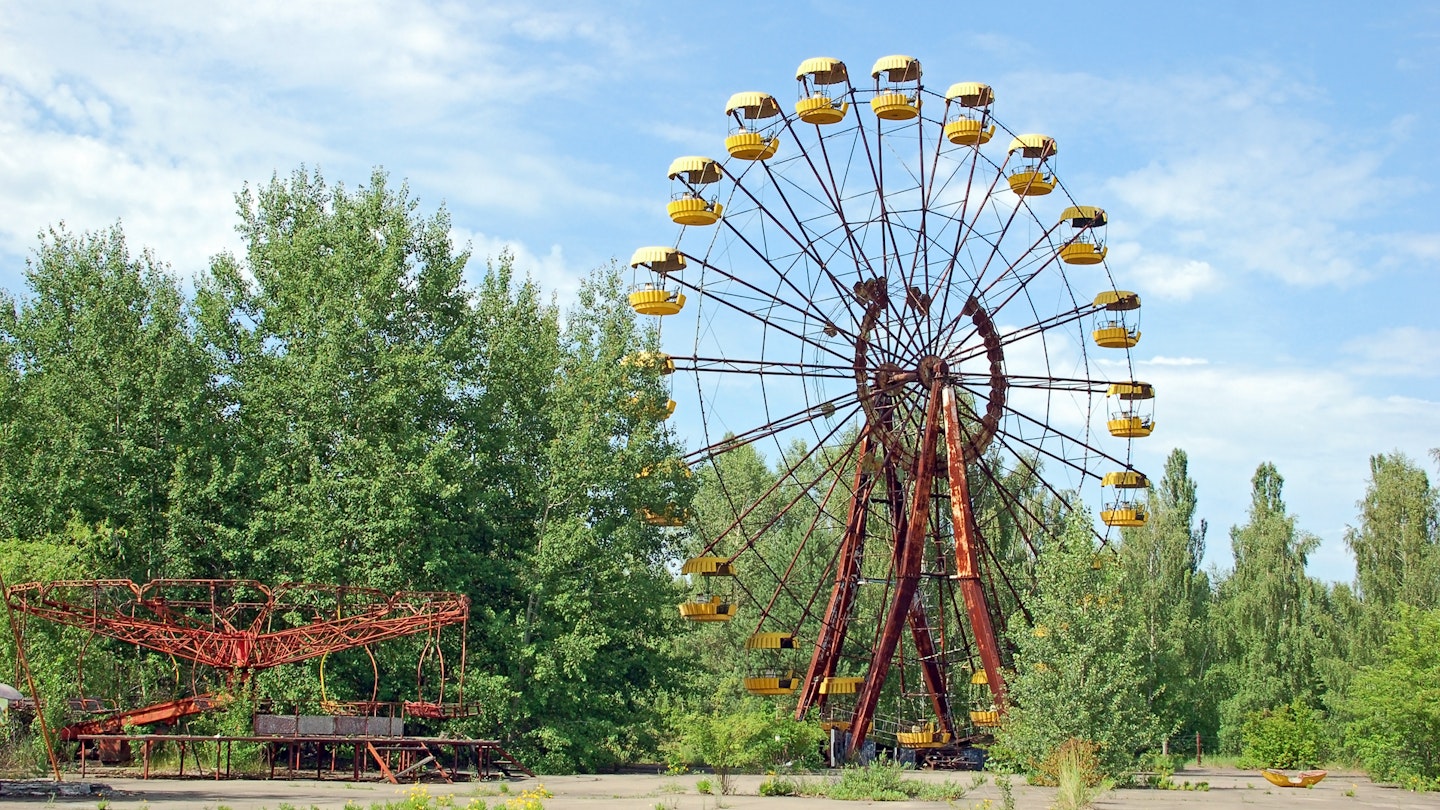
Abandoned ferris wheel in amusement park in Pripyat, Chernobyl area © Hellen Sergeyeva / Shutterstock
Even if you don’t consider yourself a dark tourist, it’s natural to be intrigued by sites associated with death and tragedy. Concentration camps, disaster memorials and other dark tourism sites preserve the evidence of humankind’s worst cruelty. They also offer stories of hope and solidarity from the bleakest chapters of world history.
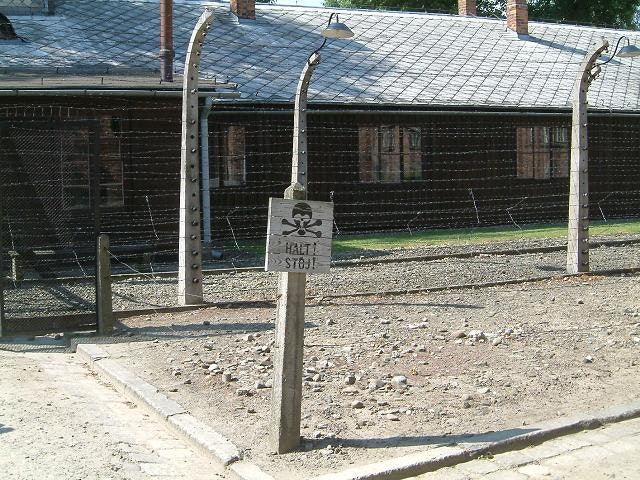
Although dark tourism is often motivated by a desire to learn or pay respects, it can still be controversial. Some visitors can cause offense by taking ill-conceived photos, or by treating a site of tragedy like a theme park. After all, dark tourism sites don’t exist in a vacuum: lives unfold nearby, and local people tread a tightrope between honoring the memory of past horrors and stepping out from their shadow.
These five dark tourism destinations memorialize terrible events, and each one requires a thoughtful approach from visitors. Touring these sites can be perspective-altering, even life-changing, provided you go with kindness and care – here’s our guide to being an ethical dark tourist.

Auschwitz-Birkenau Memorial & Museum, Poland
During WWII, more than 1.1 million people were murdered by the Nazis at Auschwitz-Birkenau . Now preserved as a memorial, these notorious concentration camps bring in enormous numbers of tourists (more than 2.32 million people in 2019).
Many tourists arrive at Auschwitz-Birkenau on day trips from charming Kraków , 65km east. There’s a similar day-trip effect at other sites of former concentration camps, such as Terezín (north of Prague ) and Dachau (outside Munich ). The challenge is transitioning between holiday mode – selfie stick aloft, picnic packed, sunhat and novelty T-shirt – to a mindset appropriate to seeing the place where Jewish and Roma people, as well as prisoners of war and LGBTIQ+ people, were tortured, starved and murdered.
Respectful photography sounds obvious, but officials at the site need to repeatedly remind visitors . Don’t strike an enigmatic pose on the railway lines that brought hundreds of thousands of people to their deaths. Reconsider whether selfies are appropriate: by their nature they center on you rather than those who suffered here.

Killing Fields and S-21, Cambodia
More than 1.7 million people were murdered in the Cambodian genocide of 1975–79. The S-21 prison and interrogation cells in Phnom Penh are where the Khmer Rouge tortured thousands. If they weren’t murdered on-site, victims would be taken to Choeung Ek’s Killing Fields , 15km south. The Killing Fields are now a memorial site and S-21 is conserved as the Tuol Sleng Genocide Museum .
Up to 800 people visit the Killing Fields each day, most also paying a visit to S-21 where guides – some survivors of the genocide – lead visitors between rusty bedframes and bare-walled cells. Though there are concerns that the site cannot handle the increasing volume of tourists, locals are generally pleased to see visitors. Tourism represents more than 15% of Cambodia’s GDP. As well as boosting the economy, visitation of Khmer Rouge–era sites ensures their preservation and encourages confrontation of the country’s history.
Although most are respectful, it’s not unusual to see tourists ignoring signs prohibiting photography or walking directly across mass graves. Bone fragments have been stolen, while graffiti has been left in Tuol Sleng. Visit with environmental and emotional sensitivity: observe signs, watch where you’re treading, refrain from photography at sensitive locations and hire a local guide to ensure your tourists dollars go straight into Cambodians’ pockets.

A-Bomb Dome and Peace Memorial Museum, Hiroshima, Japan
After US Army Air Forces bombed Hiroshima on 6 August 1945, the Japanese city became forever associated with death on an apocalyptic scale. Hiroshima was flattened by the atomic blast. More than 70,000 people were killed instantly, and a similar number died later from terrible burns and radiation-related illnesses.
The A-bomb dome , the only major structure to have survived, stands as a witness to that day. Nearby, the Hiroshima Peace Memorial Museum displays harrowing reconstructions of what the victims endured, as well as thoughtful messages of optimism for world peace.
This history is a heavy burden for Hiroshima. While it’s important to devote time to Hiroshima’s dark tourism sites, it’s equally worthwhile to learn about the city beyond the bombing. Understand hundreds of years of history at Hiroshima-jō , the faithful rebuild of a 16th-century castle. Take a ferry to Miyajima Island to admire temples and spot miniature deer. Talk to local people about their town, if you can. Above all, leave with memories of Hiroshima as a living town, rather than a by-word for wartime horror.
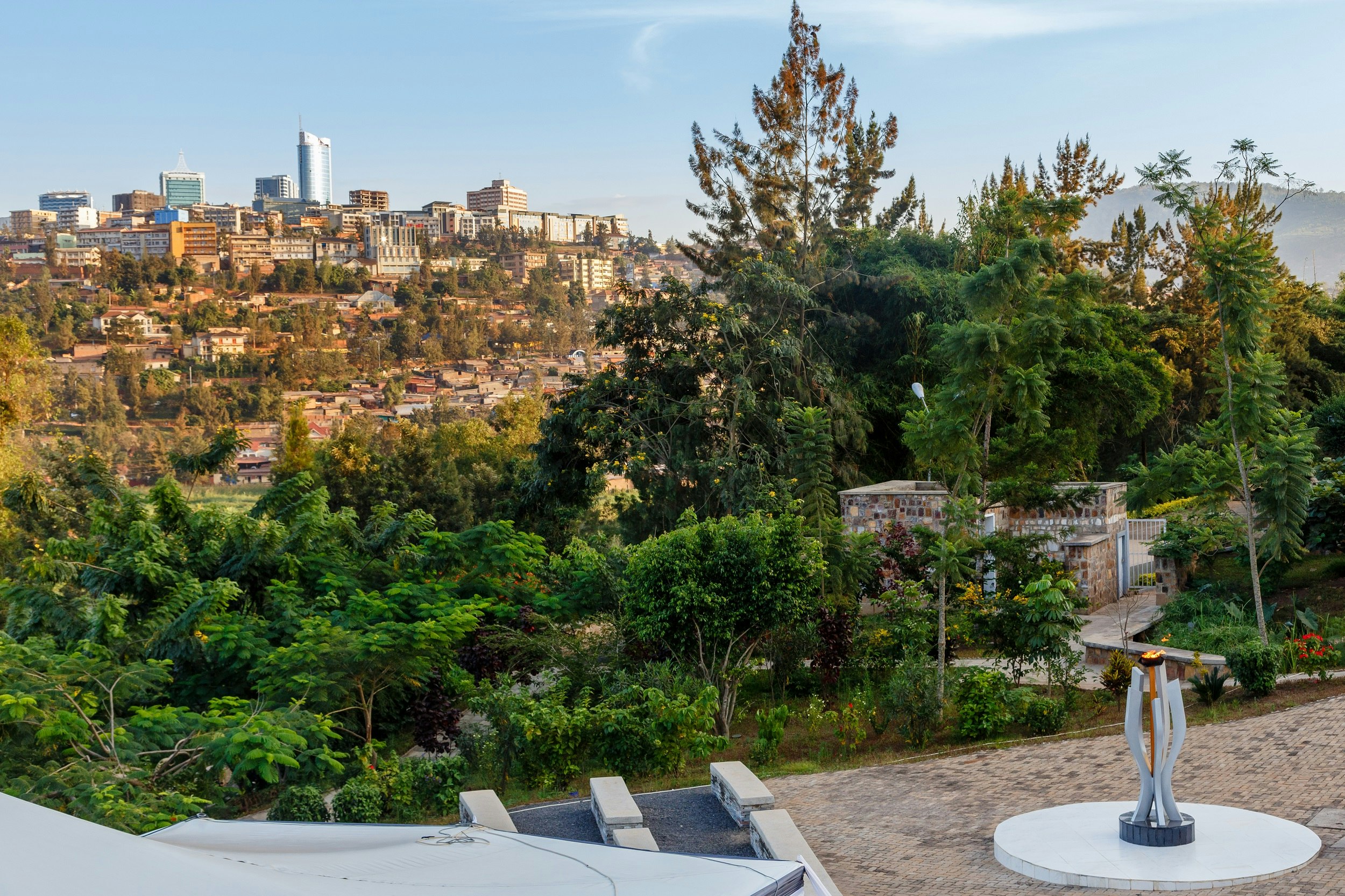
Kigali Genocide Memorial, Rwanda
Tourists need to be especially considerate when visiting a place associated with a very recent tragedy. The Kigali Genocide Memorial remembers the victims of 1994’s 100-day genocide of the Tutsi people. One-quarter of a million people are buried in mass graves, killed by the Hutu extremists and their supporters. Video testimony by survivors of Rwanda ’s genocide, accompanied by heart-rending descriptions of children who were murdered, make this a confronting place to visit.
Thoughtful conduct is paramount, and this extends to giving your full attention to displays that you read. Ideally, do some research before arriving and be attentive to what you see and read. People who lost their loved ones in the genocide come to the memorial to remember those who were killed. The least that visitors can do is give their undivided attention.
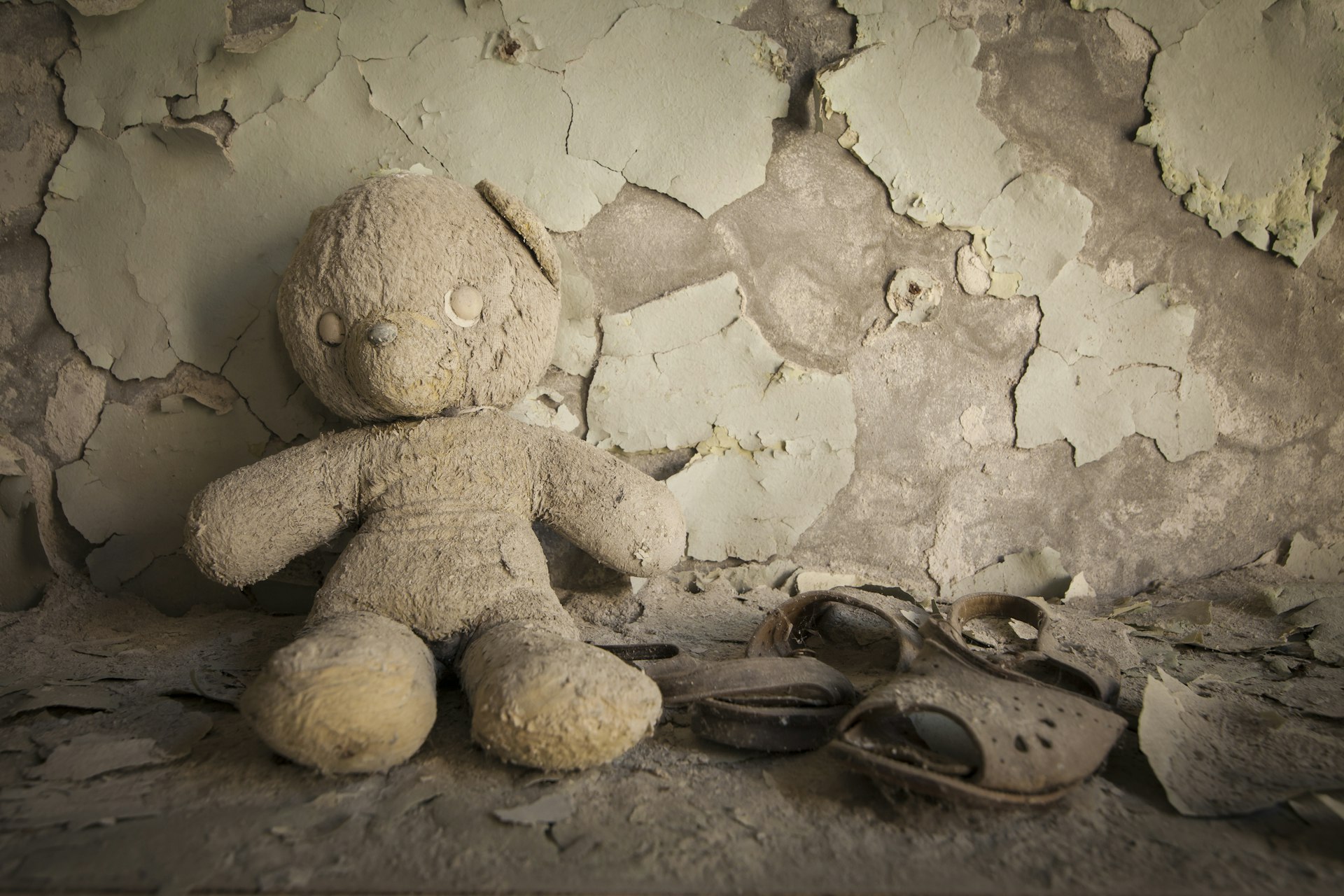
Chernobyl, Ukraine
The 1986 explosion at Chernobyl’s nuclear power plant has gone down in infamy. The accident caused dozens of deaths, innumerable radiation-related illnesses, thousands of evacuations and a toll on wildlife that is still being debated and calculated.
In 2019, HBO’s miniseries Chernobyl beamed a blow-by-blow account of the disaster onto screens across the world. Local tour guides received heightened interest in trips around the "exclusion zone," the badly contaminated 2600-sq-km area that was evacuated after the blast.
A TV series can have a dangerous distancing effect, but despite the occasional influencer using the site as staging for photoshoots, the exclusion zone is no movie set. Tour guides urge visitors to protect themselves by wearing long-sleeved clothing and refraining from touching anything. Custodians of the carefully guarded area scan visitors after their visit, to make sure radioactive dust isn’t clinging to their clothing.
It’s painful for a country when land is poisoned and people displaced; it’s even more unsettling when a place becomes a macabre curiosity around the world. But be prepared to challenge your preconceptions about Soviet-era wreckage and wildlife-free wastelands. Against advice, as many as 200 people still live in the exclusion zone. Younger Ukrainians eager to build something positive from Chernobyl’s grim legacy offer photography and educational tours, and have even hosted a music festival in the zone. As with so many other dark tourism sites, an ethical visit to Chernobyl requires an open mind.
You might also like:
Is there an appropriate age to bring children to visit Auschwitz? Cemetery tourism: an ethical traveler's guide to graveyards Why Japan’s Michinoku Coastal Trail is the best hike I’ve ever done
Explore related stories
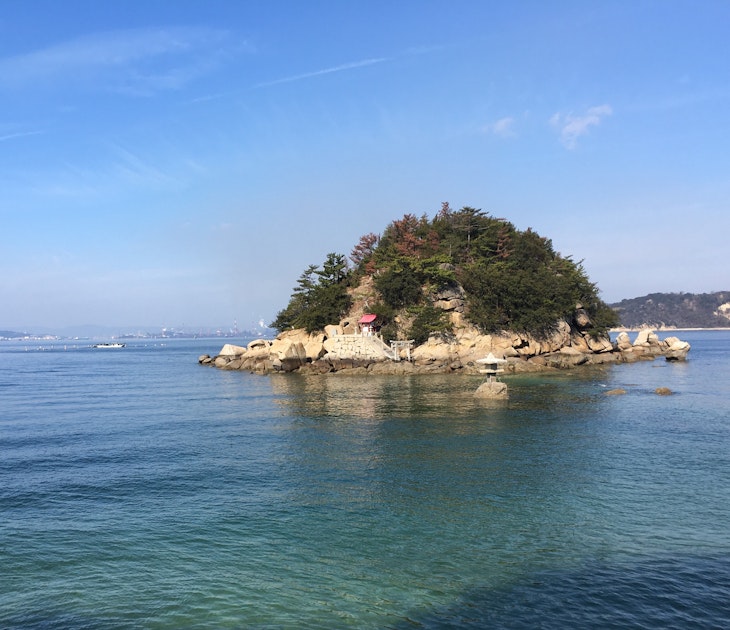
Mar 4, 2020 • 5 min read
Step away from Japan's big cities and sample some slow travel in and around the Seto Inland Sea.

Mar 13, 2024 • 6 min read

Mar 5, 2024 • 6 min read
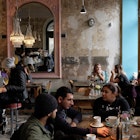
Feb 29, 2024 • 6 min read

Feb 11, 2024 • 11 min read

Jan 16, 2024 • 8 min read
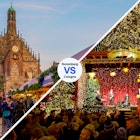
Nov 17, 2023 • 6 min read
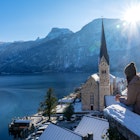
Nov 6, 2023 • 5 min read

Oct 19, 2023 • 8 min read

Aug 3, 2023 • 6 min read

- Location guides
- Travel tips
- Things to do
- Food and drinks
- The Rise of Dark Tourism In Japan – Top 12 Scariest Destinations
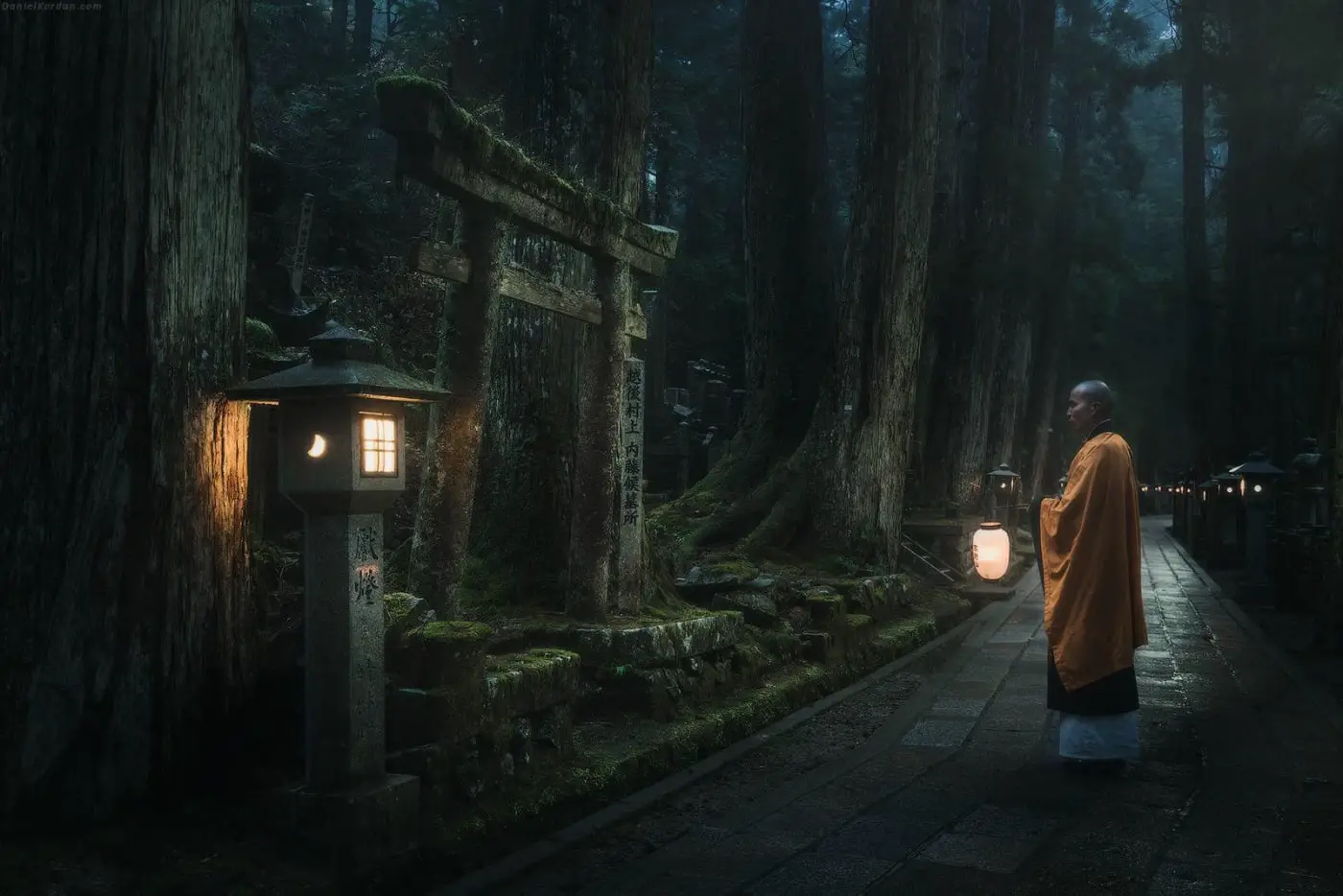
If you watch the recently released Netflix series “Dark Tourist”, you will find a radioactive tour in Fukushima, Japan in episode two, one of the most terrifying experiences on earth. But aside from Fukushima, Japan has much more to offer curious and adventurous dark tourists. In fact, promoting dark tourism is a tragedy from Japan’s Reconstruction Agency to help the post-disaster towns recover or develop the economy in remote local places. So, Japan is definitely a friendly country for international dark tourists. Let’s find out more about dark tourism in Japan and the top 12 scariest must-visit destinations in this article.
What is Dark Tourism?
In the book “Dark Tourism” by Foley and Lennon in 1996, this term refers to the act of traveling to places of post-disaster, death, war atrocity, or any type of tragedy.
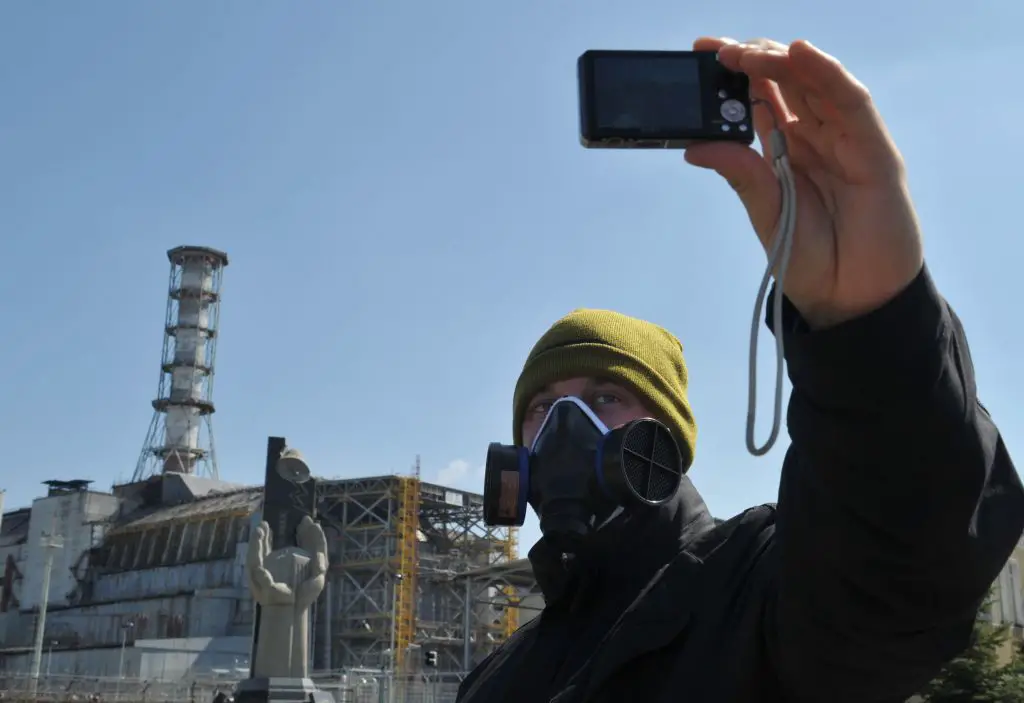
Dark tourism refers to the act of traveling to places of post-disaster, death, war atrocity, or any type of tragedy. (Source: Internet)
- Planning A Trip To Japan Like A Travel Master
- 10 Japanese Cultural Facts Travellers Should Know
Indeed, this type of tourism has caused endless controversy from its very first day of existence. Many people criticizing dark tourism state that it is not appropriate to make money from the past trauma. However, when looking on the bright side, we can see dark tourism can serve as a historical class. It reminds humanity of our past mistakes so that we can avoid or at least be prepared if similar disasters happen again. Sometimes, for instance, tragedy in Hiroshima teaches us about the value of peace, resilience, and love shared among people. Besides, it is about time the site itself along with its residents heal from all the trauma and that site may find a chance to be back on the map someday.
The rise of Dark Tourism in Japan
Throughout its rich history, Japan has had its ups and downs many times. It used to suffer from natural disasters such as tsunami or earthquakes to the darkest time associated with World War II including the atomic bombing in Hiroshima and Nagasaki. These events in the past leave us not only important lessons but also dark tourism sites. Furthermore, Japan has its unique culture of many mythologies or dark folklore which provide some spooky forests, tunnels, or other creepy places.

David Farrier traveled to Japan in Netflix series “Dark Tourist”. (Source: Internet)
In the past 20 years, tourism in Japan explodes and the country becomes worldwide famous for its bizarre experience such as anime, robots, festivals. But only in the past few years, due to the digital revolution, as people share their experience on social media, the mass is aware of the dark tourism in Japan. More and more choose to follow this phenomenon rather than other mainstream forms of tourism.
TOP 12 Dark Tourism Destinations in Japan
If you are visiting Japan and also get bored with ordinary activity, you may want to get into the game of dark tourism and discover the 12 most creepy destinations in Japan listed below.
1. Fukushima Exclusion Zone
When it comes to dark tourism in Japan, the first come to anybody mind is a place which has been through it all: earthquakes, tsunami and as a result, nuclear disaster. In fact, earthquakes are not something strange in the country since Japan lies on the crossing zones of many continental and oceanic plates. This is also the reason why Japan has so many active volcanoes and hot springs. Moreover, tsunami or tidal waves are usually caused if earthquakes arise below or near the sea.
At 14:46 on 11 March 2011, the magnitude 9.0–9.1 (Mw) undersea earthquake along with the tsunami struck the north-east coast of Honshu (main island) and is recorded as the worst earthquake in Japan history since the record started in 1900. But none could ever imagine the double natural disaster earthquakes and tsunami is capable of leading to a much worse catastrophe. Fukushima Daiichi Nuclear Power Plant is the first nuclear accident at level 7 ever since Chernobyl. There were approximately 20,000 deaths and massive structural damage.
Fukushima Exclusion Zone Now
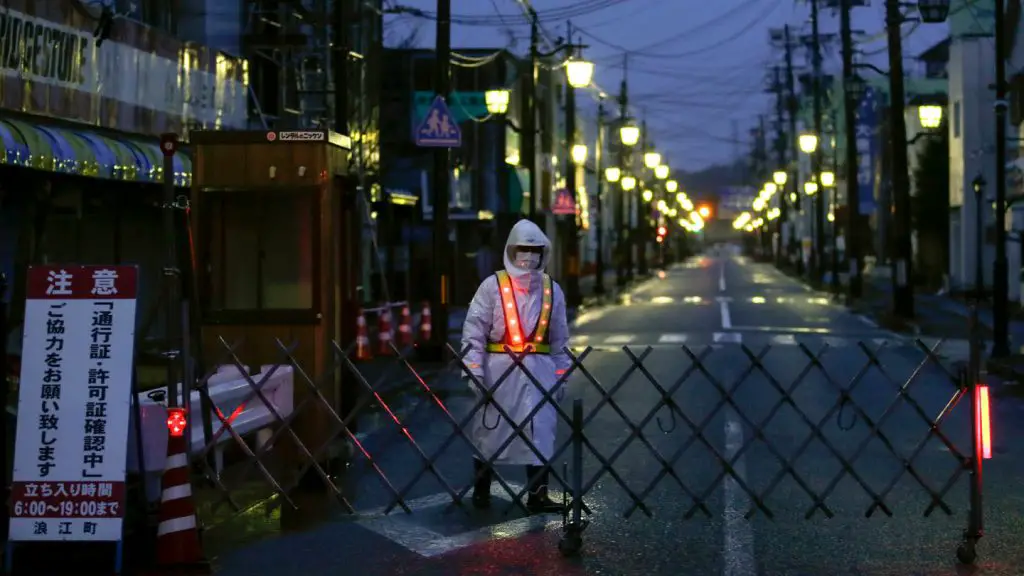
Most of Fukushima is restricted to only journalists and photographers.
Due to the problematic radioactive iodine in the air, soil, and water, residents were evacuated and the area around the power plant has later been forbidden exclusion zone. Only permitted journalists and photographers could enter the ghost towns. As a daring dark tourist, you can still visit one reopened town called Odaka. Odaka is quite close to the station so it is possible to join a 1-day tour from Tokyo to Odaka. Is it dangerous? Not as the Netflix series “Dark Tourist” depicts, it even narrates some wrong information and exaggerates the situation. Keep in mind that Odaka is reopened after successful clean-up efforts. So, come to Fukushima yourself to really know what was and is happening in this place without worrying about any damage to your longevity.
- Location: Odaka, Fukushima, around160 miles (250 km) to the north of Tokyo.
- Access: nearly impossible to travel independently, so pre-arranged tours are recommended
- Costs: ¥ 5000/person for a standard guided tour, higher prices for smaller groups, and custom tours. near impossible independently, but made possible through pre-arranged guided tours; not cheap.
See more about this area in the video below:
2. Hiroshima
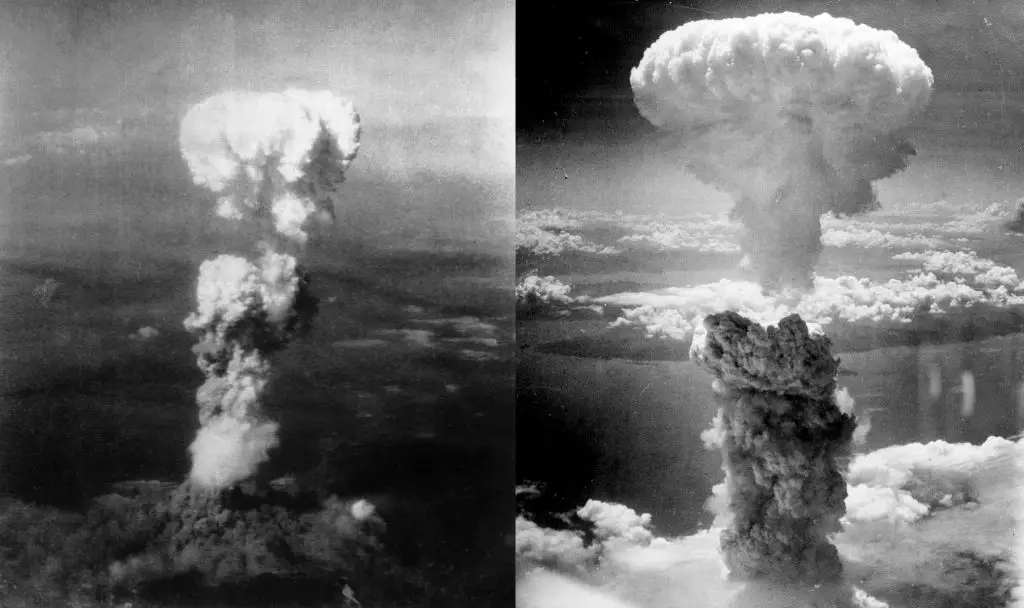
The atomic bomb dropped in Hiroshiman during World War II
Hiroshima and Nagasaki are both victims of the atomic bomb during World War II. However, concerning the atomic bomb, people usually think of the devastating war atrocity in Hiroshima on the 6th of August partly because Hiroshima suffered from much more damages related to loss of lives (almost 140,000 people).
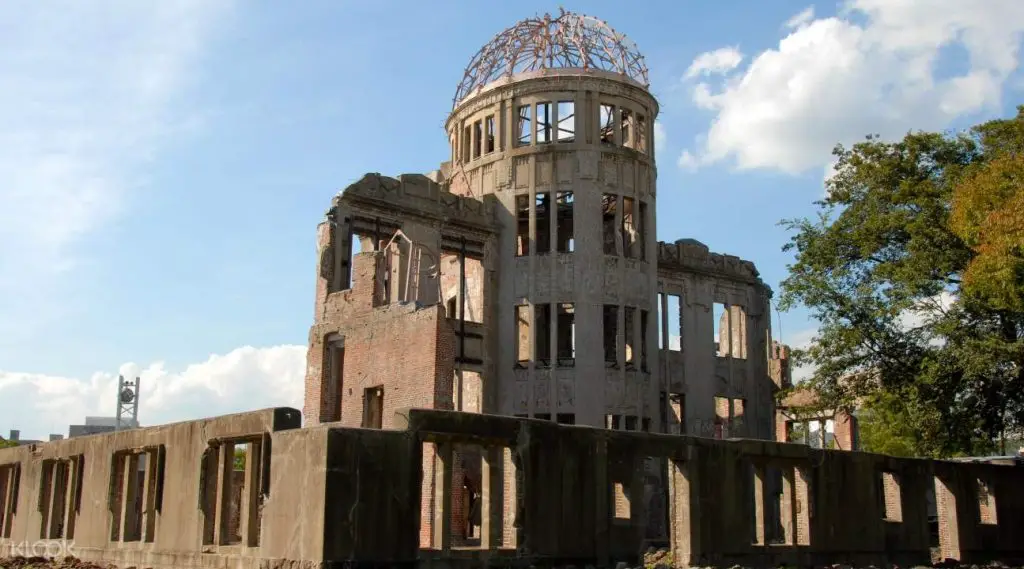
Many consider Hiroshima Atomic Bomb Dome the Eiffel Tower of dark tourism.
There are various sites in Hiroshima that show you the impact of the bomb on this city, but a typical choice for dark tourists is the Peace Memorial or the Atomic Bomb Dome. In fact, it is just the remnant of a Prefectural Industrial Promotion Hall next to hypocenter but fortunately, preserves most of its structure. Many consider Hiroshima Atomic Bomb Dome the Eiffel Tower of dark tourism, so it is definitely a must-visit during your trip to Hiroshima. Another well-known landmark is the Memorial Cathedral for World Peace which is a church constructed to celebrate and spread hope for peace. If you are a new dark tourist, these destinations are a good start since they are not dark or scary, but more like an iconic historical attraction that survived the tragic war along with the first atomic bomb to be dropped.
- Location: in Central Hiroshima, in the north of the Peace Memorial Park
- Access : easy to find
- Costs: free
3. Aokigahara Suicide Forest

There is still actual suicide committed in Aokigahara along with expanding numbers of visitors.
Just like its name, Aokigahara, which means Sea of Trees in Japanese, is known as a place many people have committed suicides. This makes Aokigahara full of dark aura and maybe some remains or dead bodies. The terrifying matter is that there is still actual suicide committed here along with expanding numbers of visitors. Unless you have a strong stomach and a good sense of direction, you should not risk going into this paranormal forest. Even some daring and experienced dark tourist may refuse to come here since witnessing real deaths may be too unethical.
- Location: Minamitsuru District, Yamanashi Prefecture, in the northern foothills of Mt. Fuji
- Access: independent travel or private tour
- Cost: expensive private tour of ¥000/ person
4. Hashima Island – Ghost Town

Hashima or Battleship Island is among the most astounding ghost towns in the world.
This little island is among the most astounding ghost towns in the world. Hashima was home to miners and their families until its underwater coal mine closed in 1974. Ever since, once crowded place like Hashima with all hospitals, schools, houses have been deserted. Only after 40 years, in 2009, visitors can join the boat excursions to Hashima and go sightseeing in this abandoned city.
What makes Hashima attractive to the dark tourists is not the fact that it is out of service but its darkness. During World War II, Harshima was the prison for thousands of Korean and Chinese unwilling laborers who were forced to work and treated inhumanely. Due to this part of Hashima history, it has another Japanese name “Gunkanjima”, which means ‘battleship island.
- Location: 12 miles (19 km) to the south-west of Nagasaki
- Access: restricted tour
- Cost: expensive
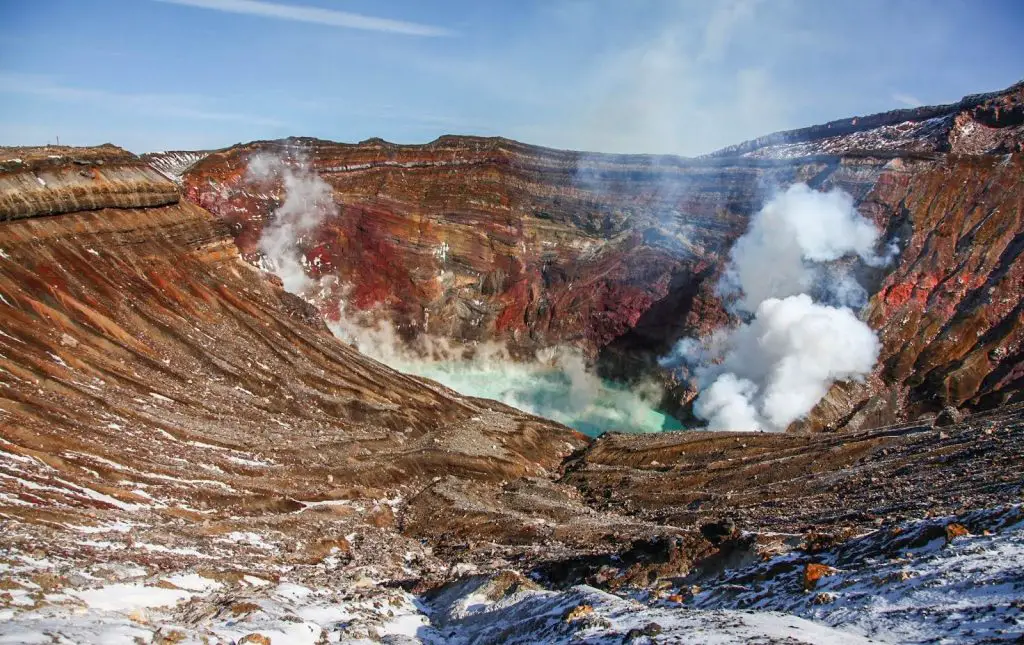
Mountain Aso is among the most active volcanoes in Japan.
Mountain Aso is among the most active volcanoes in Japan and one of the most sizable calderas on earth. So it offers basically quite a magnificent view. Besides, tourists coming to Aso can stay at nearby campsites, go horse-riding and enjoy the view of the crater rim from above in the helicopter. You can only access all these activities as long as the weather, the level of poisonous gar, and the volcanic activity are right.
- Location: 25 miles to the east of Kumamoto, Kyushu
- Access: possible independent travel. There are a car park, shuttles, and walking trails near the mountain. Otherwise, you can take part in a bus tour from Kumamoto or a round-trip packages of Kyushu.
- Costs: A visit to the crater is free but you have to pay ¥ 840 to enter The Volcano Museum (opening from 9 a.m. to 5 p.m., every day. Taking a ropeway or car from the base to crater costs another ¥600 one way, ¥1000 return ticket.
6. Okunoin Cemetery
Situated deep in the forest of Mount Koyasan, Okunoin Cemetery is a perfect destination for someone who likes the eerie silence and religious beauty. In fact, this place is highly sacred as it was where Shingon Buddhism in Japan originated, dating back to more than 1,200 years ago. The cemetery has over 200,000 gravestones along with memorials, including those of Buddhist monks, especially Kobo Dashi, the founder of Shingon Buddhism. Some of the monuments covered with red clothes mean they belong to passed-away children. The parents placing their babies’ tombstones there with the hope to protect them on the way to the afterlife.
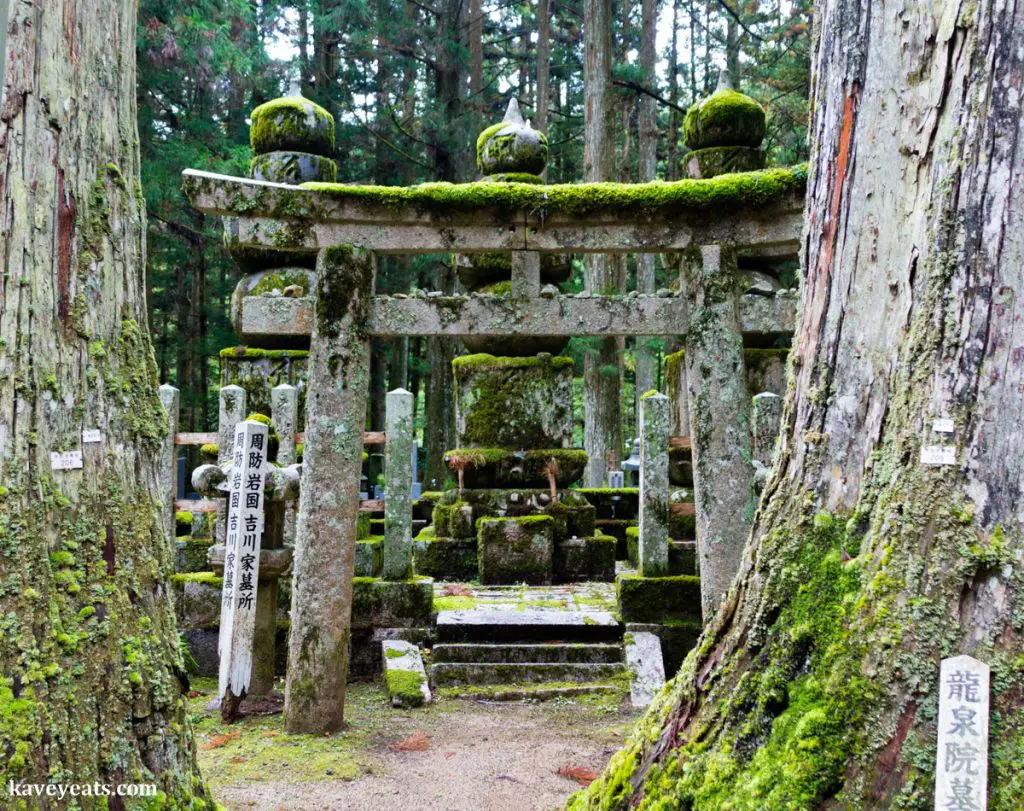
The cemetery has over 200,000 gravestones along with memorials.
For tourists, walking through Okunoin Cemetary during the daytime and visiting The Hall of Lamps at night are impressive and intimate experiences. You can stay close by in a traditional Buddhist Temple such as Yochi-in or Kumagaiji, try some vegetarian dishes and join the prayer service at dawn.
- Location: Koyasan
- Access: mainly independent travel. There is a bus line from the town center Senjuinbashi to Okunoin-mae (final stop) which is within a-minute walk to the Cemetery.
7. Old Chusetsu Tunnel – Fukuoka
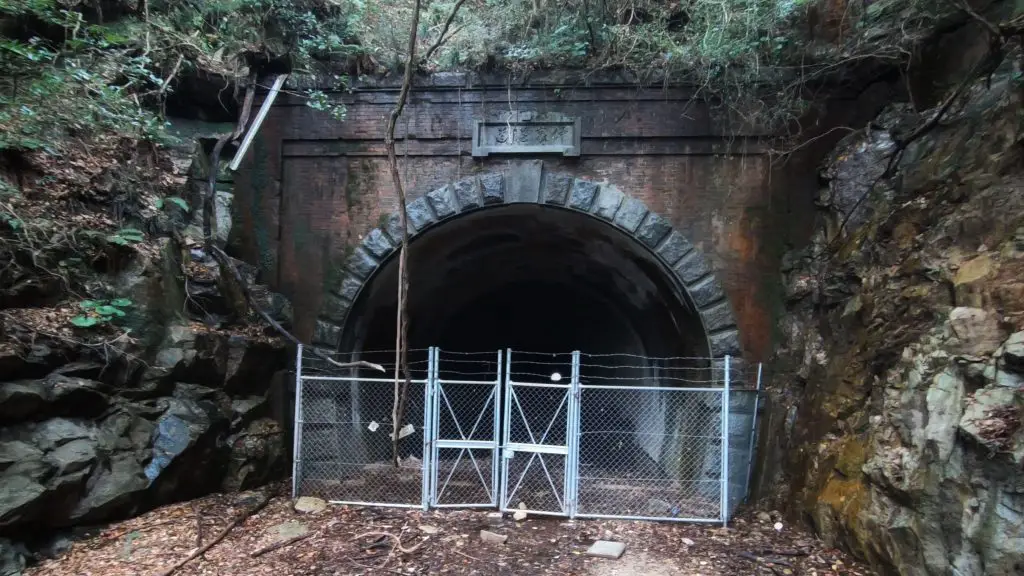
In the creepy Chusetsu Tunnel, actual frightening murders took place.
Out-of-service tunnels are dangerous not only in Japan but anywhere in the world. In this creepy Chusetsu Tunnel, actual frightening murders took place. It is horrifying to just walk past the entrance let alone wandering through it. Some daring travelers have reported about their strange experience inside the tunnels, for example, there are wailing voices warning “stop”. That strange phenomenon attracts the attention of Japanese TV programs so every year there are adventure shows there.
- Location: Hachioji, Tokyo, Fukuoka
- Access: only independent travel
8. Nara Dreamland
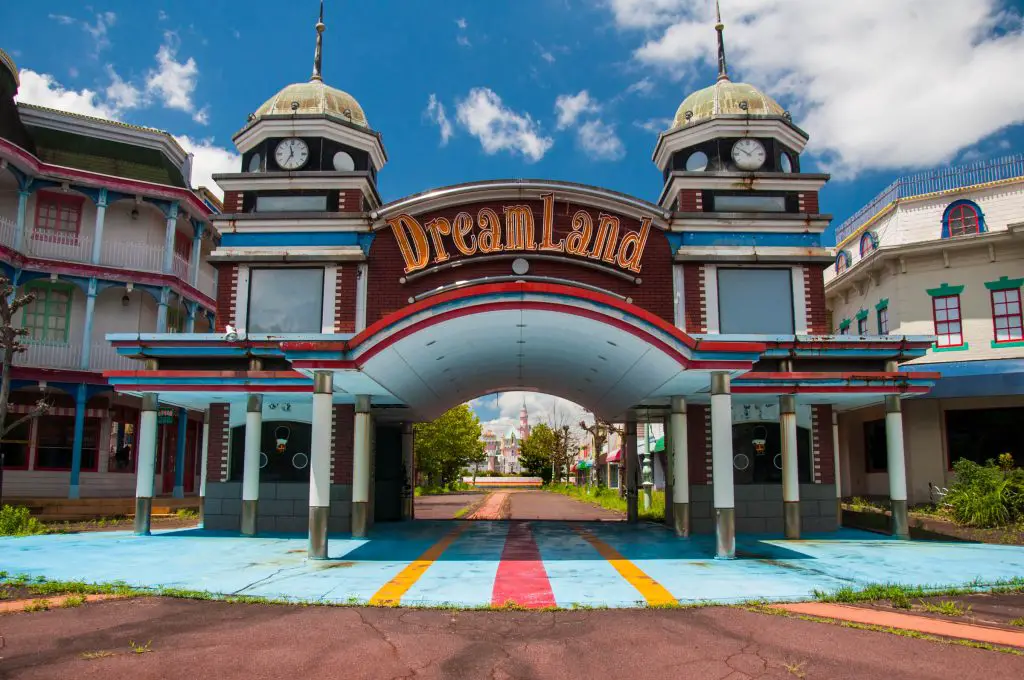
Haikyoists, or urban explorers claim to witness strange happenings in Nara Dreamland.
Constructed in 1961, it used to be the substitute Disneyland theme park in Nara, Japan until the real Tokyo Disneyland opened. Nara Dreamland was quickly out of business in 2006 and soon becomes quite decayed after 15 years. There are overgrown plants, demolished roller coasters, and torn-down animation statues, which are pretty spooky images. Now, it is no place for families and kids, but more like a popular site for haikyoists, or urban explorers who claim to see strange happenings here.
- Location: Nara, Japan
9. Okunoshima Rabbit Island
Okunoshima may be more popular for its cute tourism as most of 100,000 visitors to this island every year, come to feed and interact with the rabbits. But the dark secret behind Okunoshima and its huge number of feral rabbits also makes it stand out in the dark tourism in Japan.
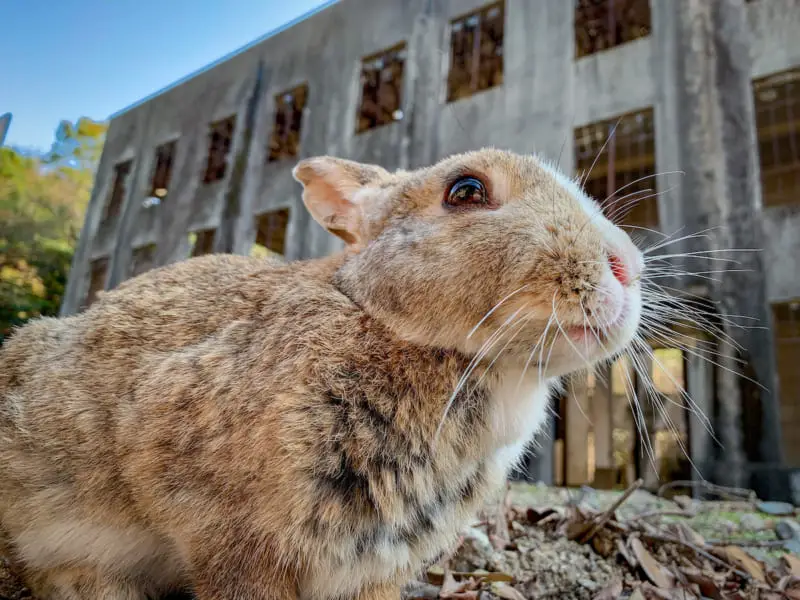
The descendants of the lab rabbits (approximately 10,000 rabbits) are the main residents on this island
From 1929 toward the end of World War II, Okunoshima island hosted many chemical weapons production including mustard gas or cyanic acid. There are rumors that the use of these toxic substances is not only WWII but also the Japanese war against China in which thousands of people died. This cruel production has been only brought to the light since the 1980s when more and more victims started speaking up. Then, the local authority built a Poison Gas Museum and allow a guided tour here. The descendants of the lab rabbits (approximately 10,000 rabbits) are the main residents on this island now. For more information, please visit: http://rabbit-island.info/en/
- Location: 2 miles (3.2 km) off the coast at Tadanoumi in Hiroshima Prefecture
- Access: independent travel or tour, the best way is to catch a 15-minute ferry from Tadanoumi
- Cost: affordable (except hotel price)
10. Meguro Parasitological Museum
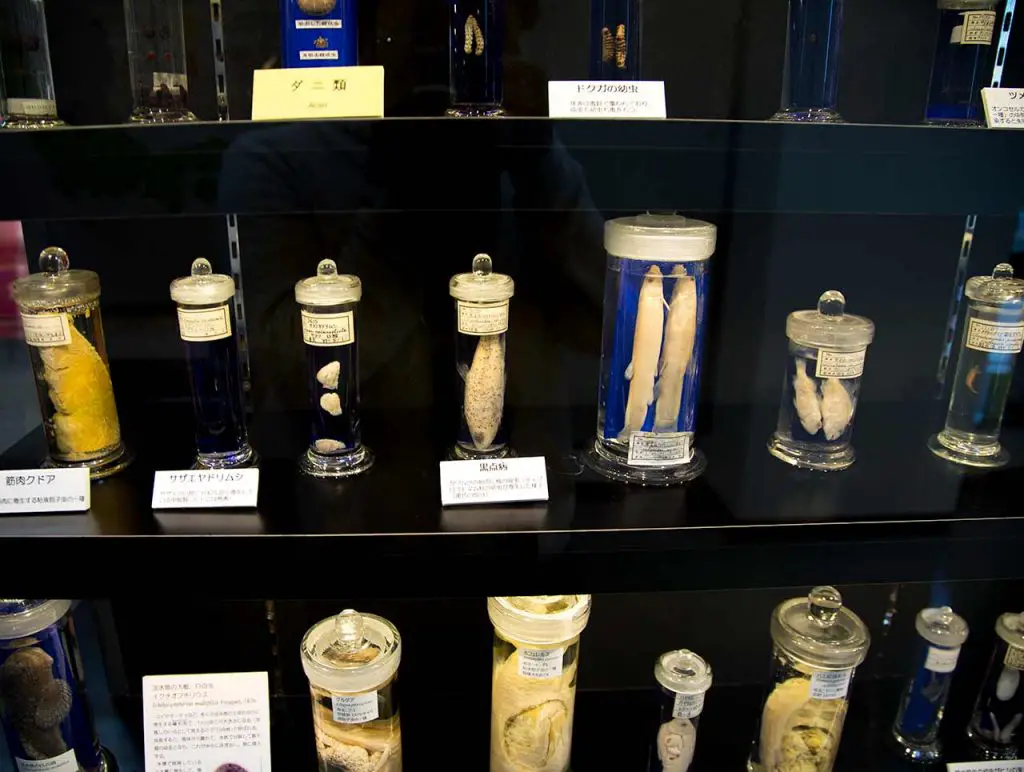
There is a 300-preserved-specimen display in Meguro Museum.
Even if you have a short trip to Tokyo, you can still experience dark tourism in Japan by visiting Meguro Parasitological Museum. It is a medical museum from almost 70 years ago with a devotion to parasitology. In particular, there is a 300-preserved-specimen display and a library that has 5,000 books, as well as 50,000 papers on parasites. Therefore, the museum exhibition proves to be of good educational purpose and a quite itchy visual challenge to some. On the second floor, you can buy some souvenirs such as T-shirts, a guidebook or even a mobile-phone straps with actual parasites embedded. For more information, please visit the official website at https://www.kiseichu.org/e-top
- Location: Meguro Ward, Tokyo, Japan.
- Access: 10:00 a.m. to 5:00 p.m from Wednesday to Sunday.
- Cost: Free (Donations are welcome)
11. Ishinomaki
Another place affected tremendously by the 3 rd March 2011 earthquake and tsunami (up to 8 meters!), is the seafront district of Ishinomaki. At that time, the flooding hit the city center which caused the destruction of functioning infrastructure. Moreover, broken gas pipes resulted in fires and burning houses. The number of fatalities was 3300 people and that of evacuees was 50,000 people. Regarding money, the damage in Ishinomaki costs over 250 billion yen or 30 billion EUR.
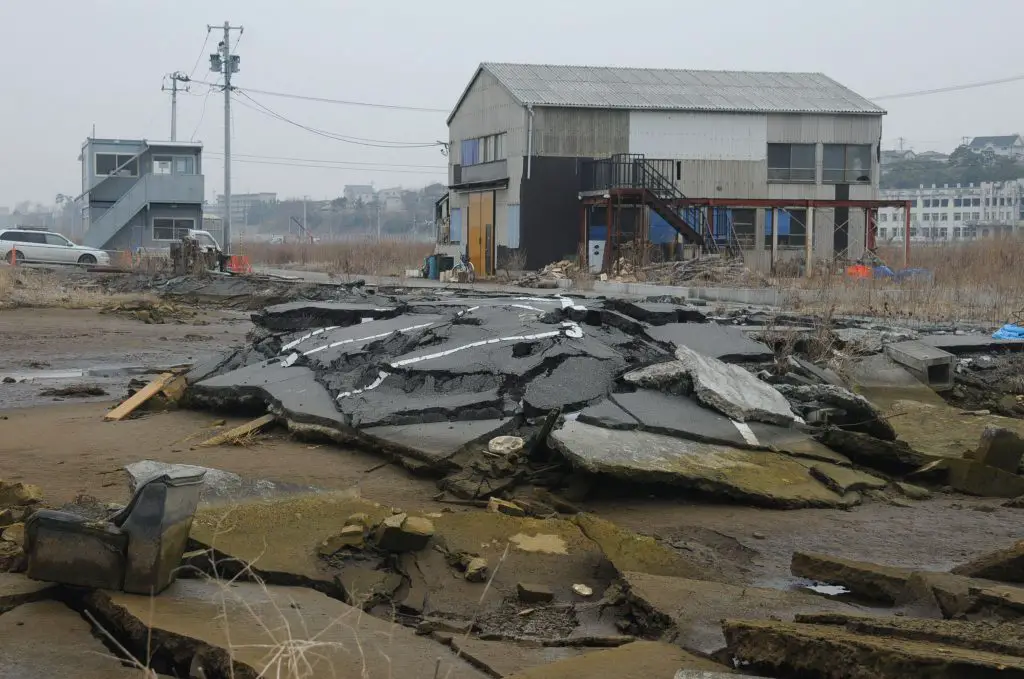
As a foreign visitor, you can access English information and narrative at Ishinomaki.
Compared to other places destroyed by the tsunami in Japan, Ishinomaki may not be the most severe case. However, the documentation along with the tribute to the past here is well organized by the Ishinomaki Community & Info Center (ICIC) which the director is British Therefore, as a foreign visitor, you can be sure that you can access English information and narrative at the place.
- Location: in the north-east of Miyagi Prefecture in northern Honshu, Japan
- Access: easy to find and visit
12. Kenji Monument and Cave, Okinawa
The last destination of dark tourism in Japan is the Kenji monument. It serves as a memorial to nearly 400 high school-age boys. These boys had to join the war unwillingly and mostly lost their lives. Kenji cave was where they were trapped by US troops and many suicided instead of being captured according to the urge of the Japanese propaganda. Others couldn’t survive through enemy fire or bombardment.

The cave was where the boys spent their last few days.
Arriving at this place, you can see numerous monuments but the most famous is Kenji-no-To which is the statue of three boys. There is also a tiny memorial usually full of flowers under a huge block of rock. Right nearby is the cave where the boys spent their last few days.
- Location: to the south coast of Okinawa Prefecture, west of Okinawa Peace Memorial Park Access: quite difficult to find.
In a few year’s time, dark tourism in Japan witnesses an incredible rise in popularity. Aside from anime, robots, or festivals, you can visit the rising sun country to enjoy a whole new creepy experience in some spooky locations. In fact, these places (some with English-speaking guided tours) are getting more and more accessible for foreign tourists. One thing to keep in mind is that this list doesn’t aim to draw attention to the bad but would rather focus on the positive effect of dark tourism in terms of educational and economic purposes. All in all, should you have any questions or any story to tell involved with dark tourism in Japan, please feel free to share with us in the comment section.
YOU MIGHT ALSO LIKE
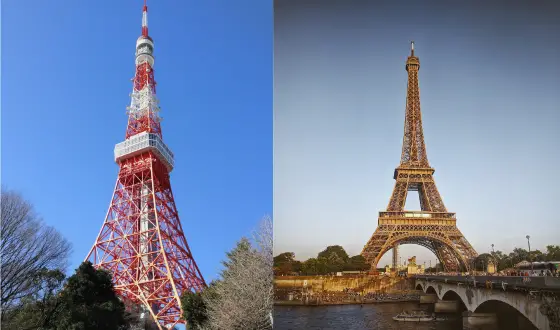
Tokyo Tower Vs Eiffel Tower: What are the main differences between them?
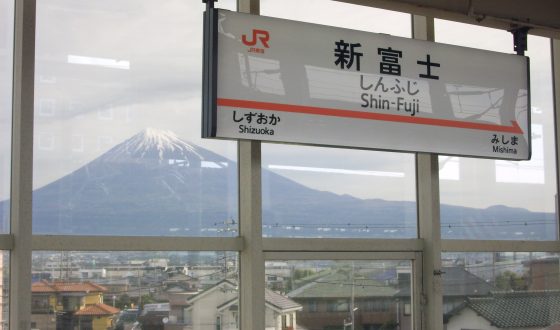
Shin-Fuji Station: Travel Tips And Transportation Guide
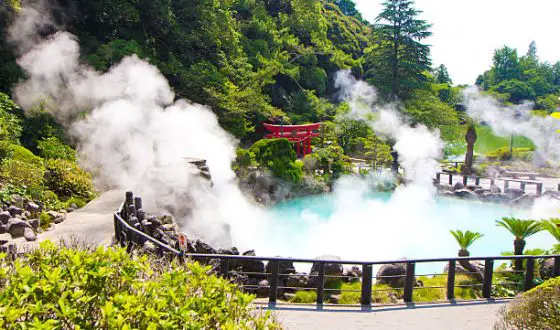

Discover The Relaxation: Best Onsen Towns in Japan
Leave a reply.
You can use these tags:
Popular posts

The Best Japanese Rice Cookers for 2023 That You Must Have in Your Kitchen

Knight vs Samurai: Are They Similar Or Different?

8 Highest Paying Jobs In Japan For Foreigners [2022 Update]

Types Of Japanese Swords – A Way To Japanese Art Culture

Among The Most Popular Sushi Rolls, Best Taste Goes To …
© Question Japan's 2019

It may be macabre, but dark tourism helps us learn from the worst of human history
Lecturer in Business, University of Salford
Disclosure statement
Dr Neil Robinson does not work for, consult, own shares in or receive funding from any company or organisation that would benefit from this article, and has disclosed no relevant affiliations beyond their academic appointment.
University of Salford provides funding as a founding partner of The Conversation UK.
View all partners
Dark tourism has become a much more well-covered pasttime in recent years, in which a macabre fascination lead tourists to travel to various places not served by Thomas Cook: the sites of battles and genocides, war cemeteries, prisons, and even current warzones such as Syria .
The 20th century alone has provided such a long list of places at which catastrophes or great loss of life and suffering has occurred. Sites visited range from the spot from which JFK was assassinated, to prisons such as Alcatraz in San Francisco, through to battlefields of the World Wars, or the vestiges of genocides such at Auschwitz in Poland or Tuol Sleng in Phnom Penh, Cambodia. It’s not everybody’s cup of tea, but we shouldn’t condemn those for whom this is an interest.
Dark tourism appears to be a manifestation of our media-rich society through which information found online may persuade us to see historical sites in person. But its origins can be traced back much further than the fascination with death and disasters of the 19th and 20th century. In the 11th century, people and pilgrims often visited places with religious significance such as Jerusalem, where the location of Christ’s crucifixion is a popular attraction; tourists visited Gettysburg, the site of the bloodiest battle of the American Civil War in 1863; and in more recent centuries, the Grand Tour offered an opportunity for the wealthy to experience Europe, with sites such as the classical ruins of the Colosseum in Rome – which in the name of entertainment saw execution, torture and death – one of the must-see attractions.
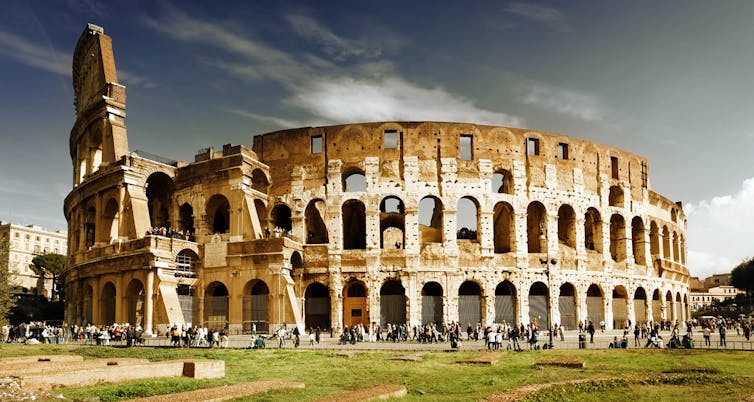
Today, in parallel with the growth in popularity of dark tourism is the enormous growth of social media and the 24-hour news economy. The ease of access to such blanket coverage through the web, Facebook and Twitter has increased people’s awareness of, and fascination for, these historical sites of war, conflict and catastrophe. For example, the last decade has brought a surge in visitor numbers to Chernobyl , where guides take visitors around the abandoned city of Pripyat (radiation levels permitting) which has been deserted since the nuclear power plant explosion on April 26, 1986. The 30th anniversary this year has in itself added to interest in visiting the overgrown and crumbling city.
As with tourism of any kind, this greater footfall brings benefits. In this case, not just the economic boost but also as a tool of education and even conflict resolution. For example, the taxi tours of Belfast’s murals , which document Northern Ireland’s Troubles, offer visitors a way to understand the history and provide the communities involved a means to reflect and move on from the conflict. This model is viewed with interest and hope by moderates on both sides of the Arab-Israeli divide searching for a peaceful solution for the long term.
The tours of Robin Island prison in South Africa, where Nelson Mandela spent 18 years incarcerated among many others, starkly present how those imprisoned by a corrupt and discriminatory political regime can later engage in peace and reconciliation. The Soweto township tours in Johannesburg have acted in part as a means through which generations of South Africans can better understand their country’s dark past and help to establish truth and reconciliation for the future.
Dark tourism should not in my opinion by viewed as unethical, repugnant or even a self-indulgent activity. Certainly some dark tourists may engage in their pursuits for all the wrong reasons, seeing death and destruction as a commodity to be consumed with little thought for those who caught up in its wake. But others visit such sites to pay their respects, to better understand the magnitude of death and destruction, and to inform the outside world of the details of terrible events – even in some case offering to help. These are positive effects that may come from so much pain and suffering.
We should strive to better understand the origins of the terrible events of human history to be more able to prevent us repeating them. In this regard, that more people visit sites associated with dark tourism and learn about them should be seen as a positive.
- Death and Dying series
- Dark tourism

Audience Development Coordinator (fixed-term maternity cover)

Data and Reporting Analyst

Lecturer (Hindi-Urdu)

Director, Defence and Security

Opportunities with the new CIEHF

Japanese History & Culture Travel
Dark Tourism in Japan | List of 7
From Hiroshima to Aokigahara, we look at some of the country’s most well-known dark tourist destinations
June 6, 2023 Updated On January 21, 2024
Related Posts
Jal and ana to shift international flights to haneda airport, amane sakaguchi talks traditions and hopes for female shamisen players in japan, uncover nagasaki’s hidden history, introducing kyushu weekender vol. 6, the history of sukajan jackets and where to get your own.
The term dark tourism was coined in 1996 by Glasgow Caledonian University researchers John Lennon and Malcolm Foley, though the phenomenon itself is said to date back to Gallo-Roman times. It refers to places associated with death, suffering and misfortune. This kind of tourism can be controversial, however, with critics arguing that it exploits human misery. Posing for selfies at sites like Auschwitz-Birkenau certainly raises questions about ethics. Dark tourism, though, doesn’t have to be voyeuristic. For many travelers, it’s a chance to gain a better understanding of dark events in history, of which there have been many in this country. Here’s a list of seven dark tourist destinations in Japan.
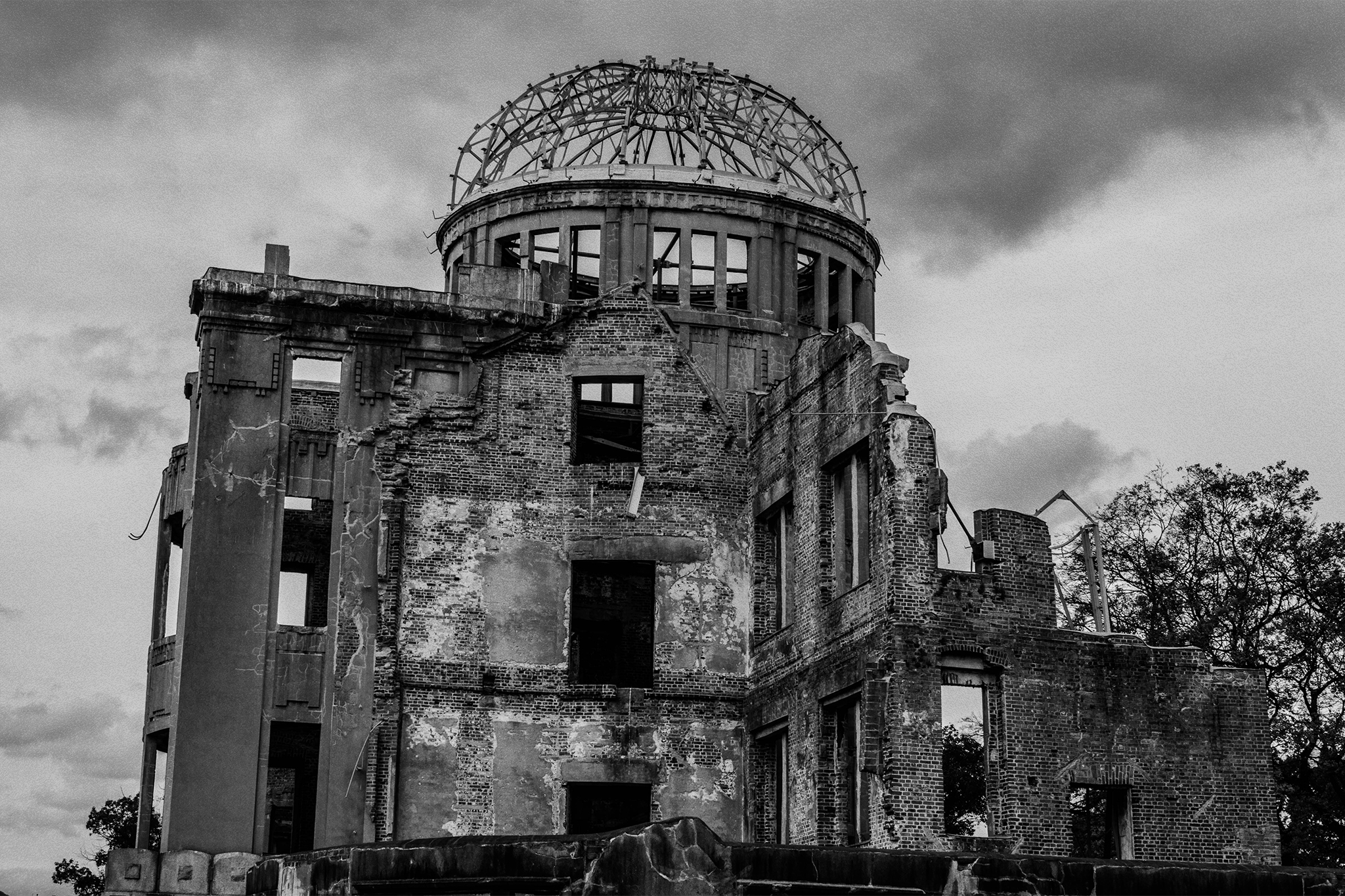
Hiroshima Peace Memorial | Image by Zaru Rosario via Shutterstock
When it comes to dark tourism in Japan, two cities stand out above all others. The first is, of course, Hiroshima, which was hit by the atomic bomb “Little Boy” on August 6, 1945. Seconds after the detonation, the temperature at ground zero was estimated to be between 3,000 and 4,000 degrees Celsius. An hour later, “black rain” started falling on the city, causing additional radiation exposure. Between 90,000 and 166,000 are estimated to have died in the four-month period following the explosion. Most of the buildings in the vicinity of the hypocenter were destroyed. The only structure left standing in the area was the Hiroshima Prefectural Industrial Promotion Hall.
Some locals called for it to be torn down. Others felt it needed to be preserved as a memorial of that fateful day. Over three quarters of a century on and the sturdy building, now known as the Genbaku Dome, is one of Japan’s most famous tourist attractions. It’s part of Hiroshima Peace Memorial Park , which also features a cenotaph for the A-Bomb victims, a peace bell, the Children’s Peace Monument commemorating Sadako Sasaki and the thousands of other kids who died as a result of the bombing and the Flame of Peace, which will continue burning until there are no nuclear weapons left on earth.
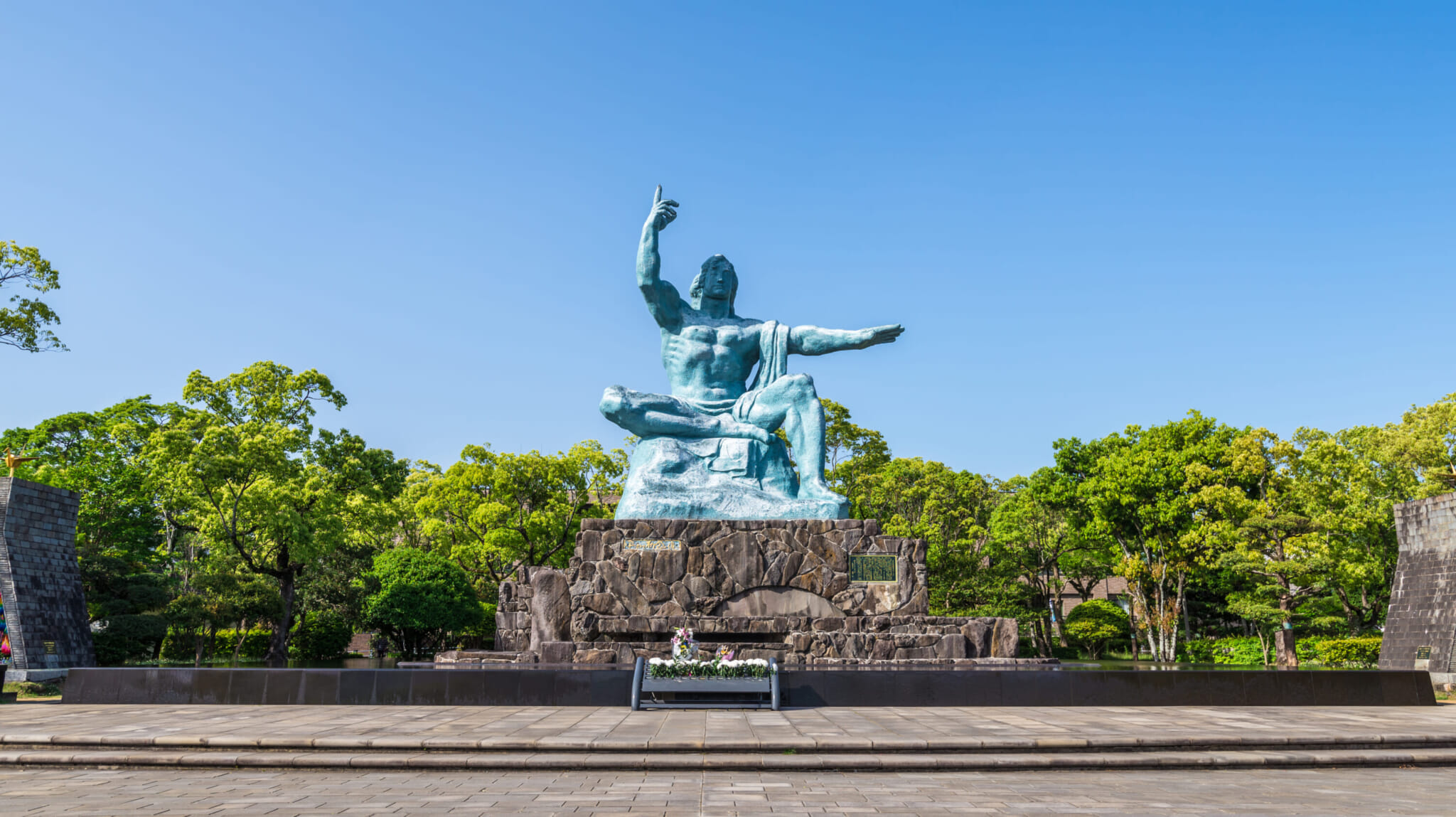
Nagasaki Peace Park | Image by EQRoy via Shutterstock
Japan’s most famous dark tourism destination after Hiroshima is, of course, Nagasaki. It was the second, and so far, last city in the world to have experienced a nuclear attack. The explosive device, nicknamed “Fat Man,” was originally intended for Kokura in Fukuoka Prefecture . However, cloud cover and smoke from nearby bombings obscured visibility of the aiming point. With fuel running low, the B-29 bomber switched to its secondary target of Nagasaki . The bomb was dropped at 11:02am on August 9, 1945. It’s estimated that between 40,000 and 75,000 people were killed immediately by the explosion. Six days later, Emperor Hirohito announced Japan’s surrender via radio.
Visitors to Nagasaki often visit the Atomic Bomb Museum , which is only a few steps away from the hypocenter. Other standout sites related to the A-bomb attack include the ruins of the Urakami Cathedral wall, Sanno Shrine’s one-legged Torii gate and the giant camphor trees behind it, which were scorched and burned in the attack yet miraculously survived and have since been enveloped by new growth. Another dark event in Nagasaki’s history was the execution of the 26 Martyrs of Japan in 1597. The country’s ruler Toyotomi Hideyoshi staged the killings as a warning against Christians. Oura Church is dedicated to their memory. There’s also a monument in their honor.
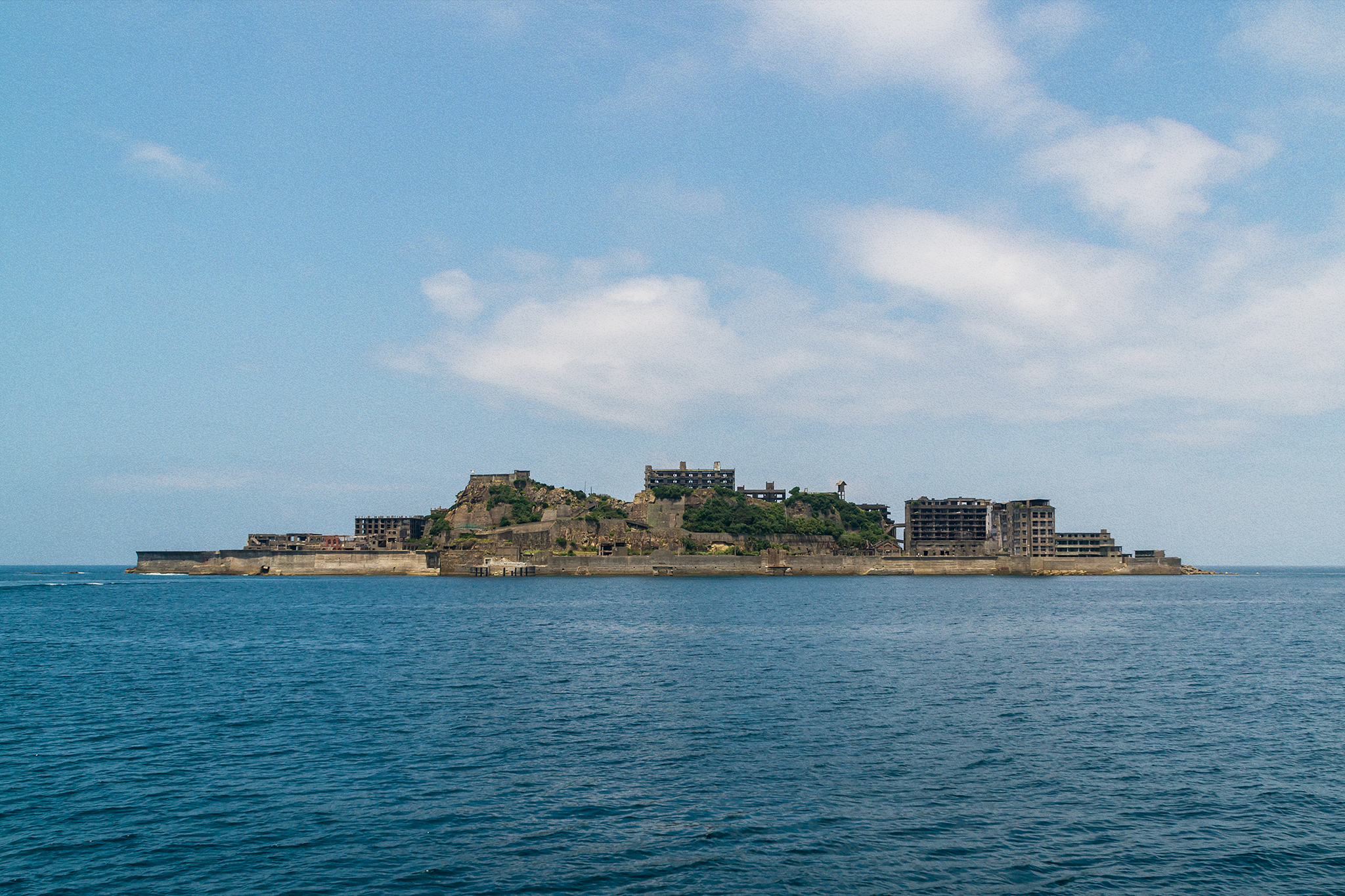
Hashima Island | Image by Michael Runkel / Westend61 on Offset via Shutterstock
Hashima Island
Staying in Nagasaki, Hashima Island is one of Japan’s most photogenic tourist destinations and was the inspiration for villain Raoul Silva’s deserted hideout in the James Bond movie Skyfall . Commonly called Gunkanjima due to its battleship-like shape, the coal mining island was purchased by Mitsubishi in 1890. From the 1930s to the end of World War II, thousands of Koreans and others were forced to work there against their will. Many conscripted laborers died due to the harsh conditions. The mine eventually closed in 1974 as petroleum replaced coal in Japan. It left the tiny island, which was once the most densely populated city in the world, completely deserted.
The ‘Ghost’ island was then closed to the public for decades. However, in 2009, the city of Nagasaki issued permits for ferry operators to take tourists there. They were given limited access to a section of the ruins. Visitors can’t get too close to the buildings, though, in case they collapse. Hashima Island is part of the “ Sites of the Meiji Industrial Revolution ,” which in 2015 was designated a UNESCO World Heritage site. Another haunting island worth visiting in Nagasaki is Ikeshima. Once a thriving coal-mining town with more than 10,000 inhabitants, there are now a little over 100 people living there. There are also many cats and abandoned buildings.
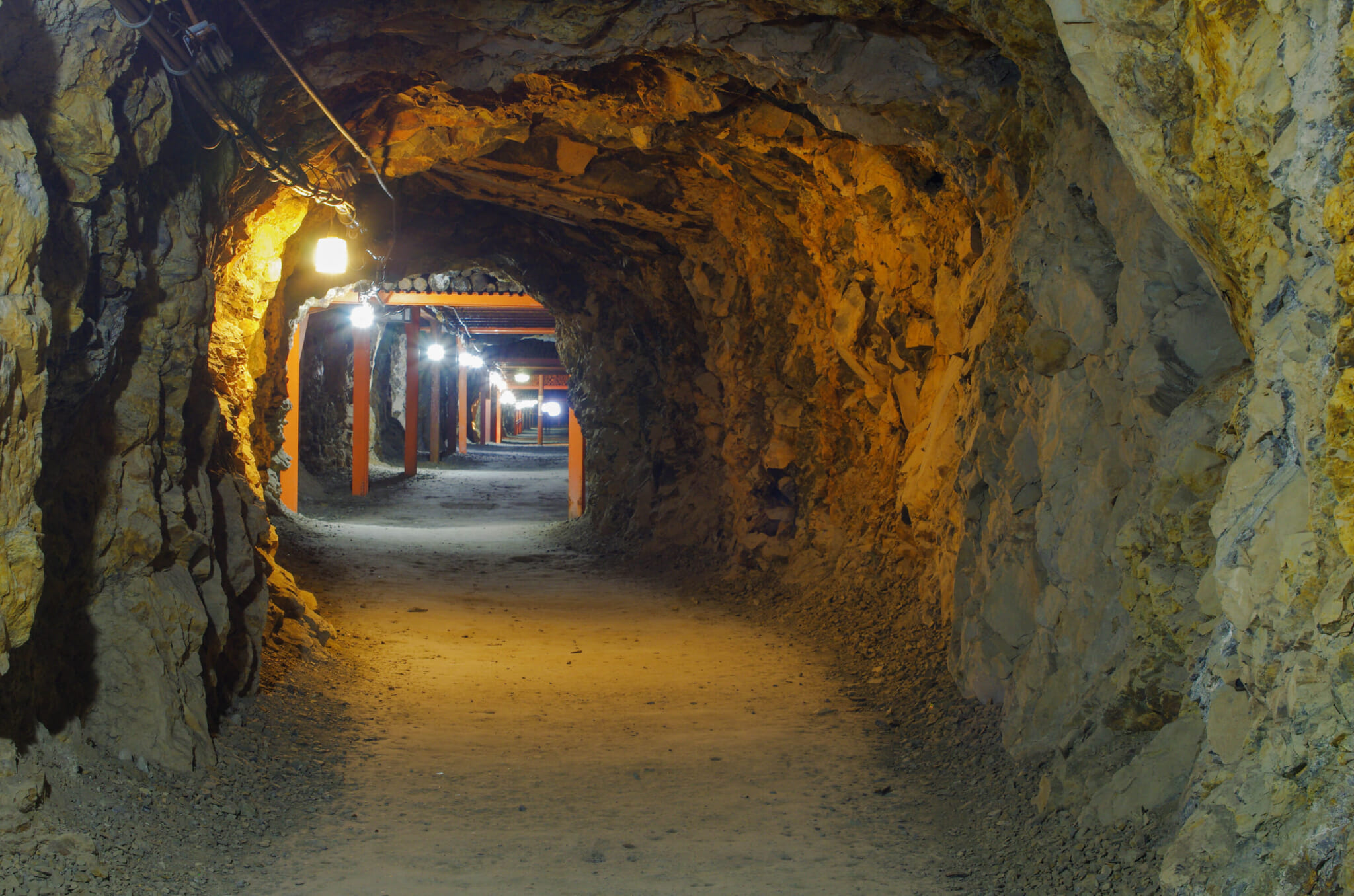
Matsushiro Underground Imperial Headquarters | Image by rokumon via Shutterstock
Matsushiro Underground Imperial Headquarters
For WWII buffs, there are plenty of sites away from Hiroshima and Nagasaki worth visiting. One of the eeriest is the Matsushiro Underground Imperial Headquarters in Nagano Prefecture. A large underground bunker constructed by thousands of Korean and some Japanese laborers during the war, it was built to house Emperor Hirohito and his family as well as military officials in the event of an allied invasion. Though it wasn’t completed, by the time Japan surrendered on August 15, 1945, around 5,900 square meters of floor space had been excavated. It’s estimated that roughly 1,500 workers died during construction due to malnutrition, exhaustion and execution.
From 1989 onwards, 500 meters of the facility became open to the public. While the tunnels are mostly bare, a small museum outside provides information regarding the conditions the laborers had to endure. Details are limited, however, as most of the documentation relating to the complex was destroyed. Moving closer to Tokyo, other tunnels related to WWII can be found in Yokohama, 30 meters below Keio University’s Hiyoshi Campus, and in Saitama, beneath the Hundred Caves of Yoshimi . In the former, the Imperial Japanese Navy commanded some of their most destructive battles, while the latter was used as an underground munitions factory.
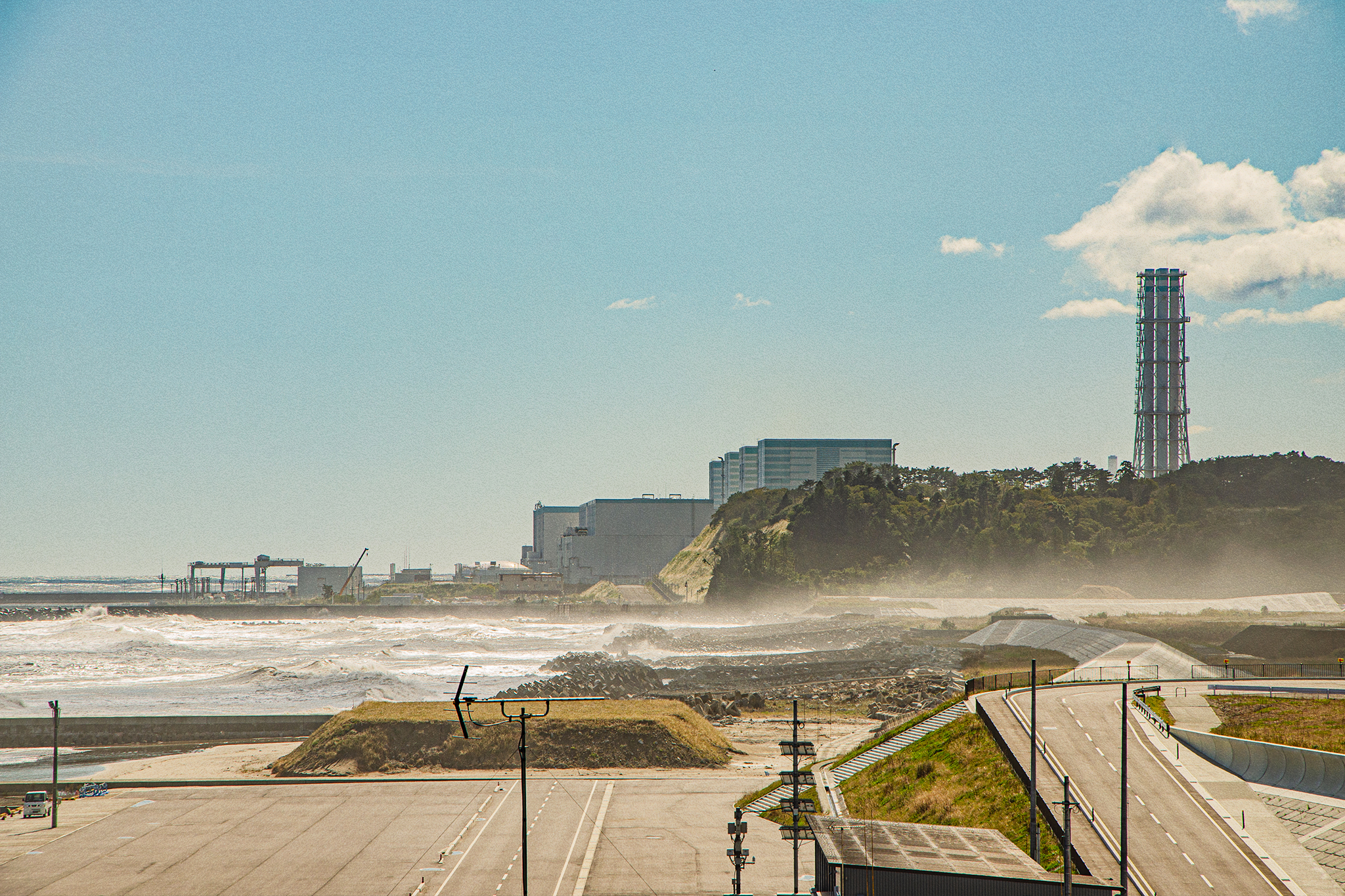
Fukushima Nuclear Plant chimneys | Image by Santiherllor via Shutterstock
Fukushima Exclusion Zone
Caused by a 9.0 magnitude earthquake and a tsunami with waves of up to 40.5 meters, the nuclear disaster at the Fukushima Daiichi Nuclear Plant in 2011 was the second worst in history behind the Chernobyl accident in 1986. It led to a 20-kilometer exclusion zone being declared around the crippled plant. A standard tour arranged by Real Fukushima includes visits to former shut-down areas as well as the current exclusion zone. For those interested in going in even deeper, there’s a monthly Fukushima Daiichi Nuclear Power Station Study Tour to learn about the site of the disaster and the decommissioning process.
According to Real Fukushima’s website , visitors’ accumulated radiation dose should be around 10-20 micro-sieverts, the equivalent of two dental X-rays. The company arranges official tours, unlike the one in the Netflix documentary Dark Tourist where narrator David Farrier was allowed off the bus to look around a destroyed amusement arcade in a “no returning” area. We then hear him speculating about the possibility of his food being contaminated despite the threshold for radioactive substances in ingredients from the region being lower than in the U.S. and the European Union. With the group’s Geiger counters constantly beeping, the program focused purely on shock-value rather than educating viewers about the recovery effort.
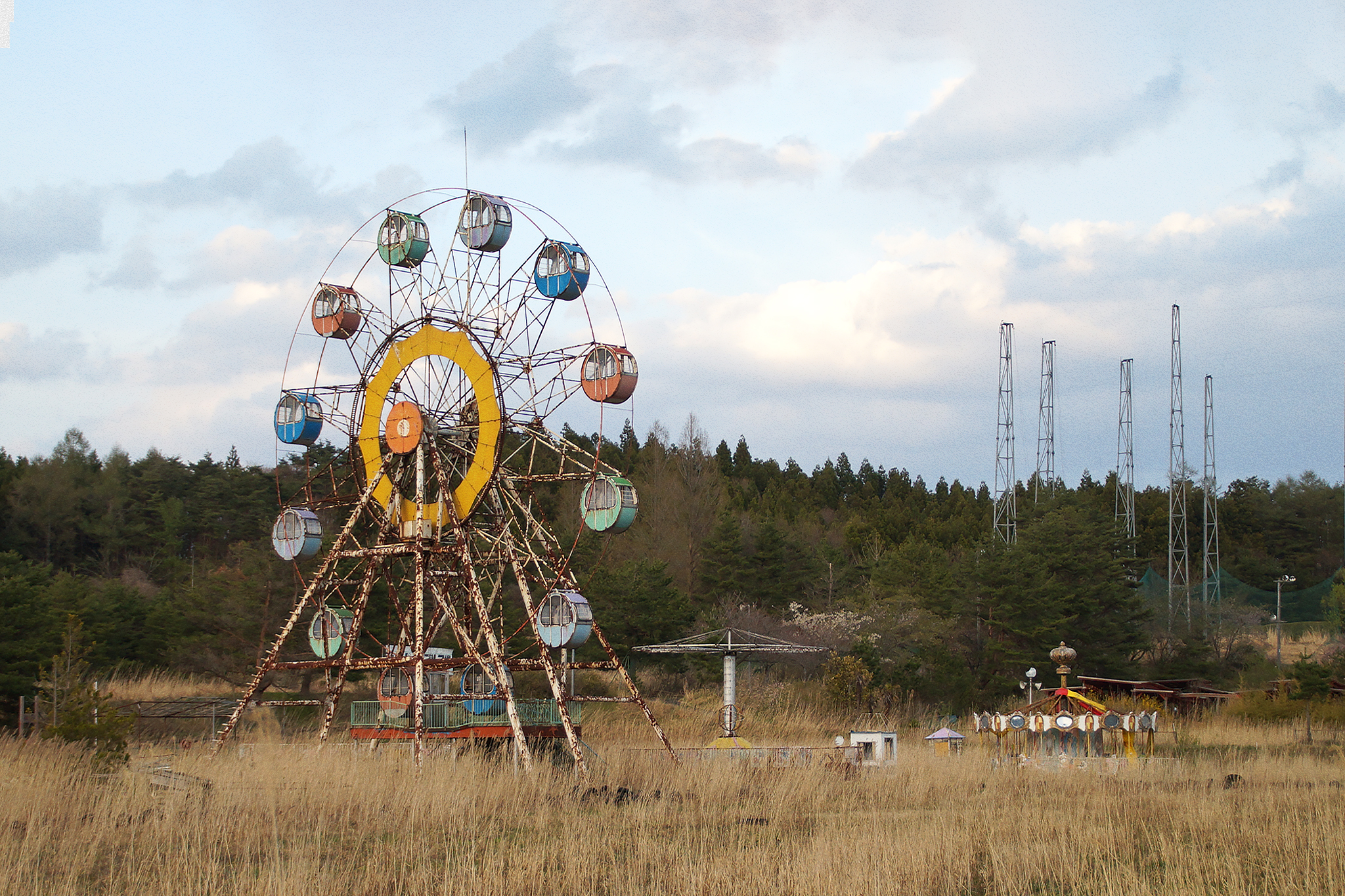
Kejonuma Leisure Land | Image by travelershigh via Shutterstock
Kejonuma Leisure Land
Heading north of Fukushima to its neighboring prefecture of Miyagi is where you’ll find Kejonuma Leisure Land. Once a thriving amusement park that attracted over 200,000 visitors annually, it’s now one of the country’s most famous obsolete ruins, known in Japanese as haikyo . Opened in 1979, the place was forced to close two decades later due to a significant drop in the number of customers. Superstitious people believe the park was always destined to fail. This was due to the supposed curse placed on the land by a beautiful damsel who gave birth to a snake and ended up killing herself.
Interest in Kejonuma, which means “pond of the ghost woman,” grew after it featured in a 2010 film. Many of the attractions stayed upright despite the earthquake and tsunami that occurred a year later and are still standing today, including the rusted Ferris wheel and carousel. There are several other abandoned theme parks in Japan. However, the most famous, Nara Dreamland, was recently demolished. As was the supposedly haunted Nakagusuku Hotel in Okinawa. For haikyoists, though, there are still so many famous abandoned sites and areas throughout the country to visit, including, among others, Hachijo Royal Resort , the ghost town of Nichitsu and the Shime Coal Mine .
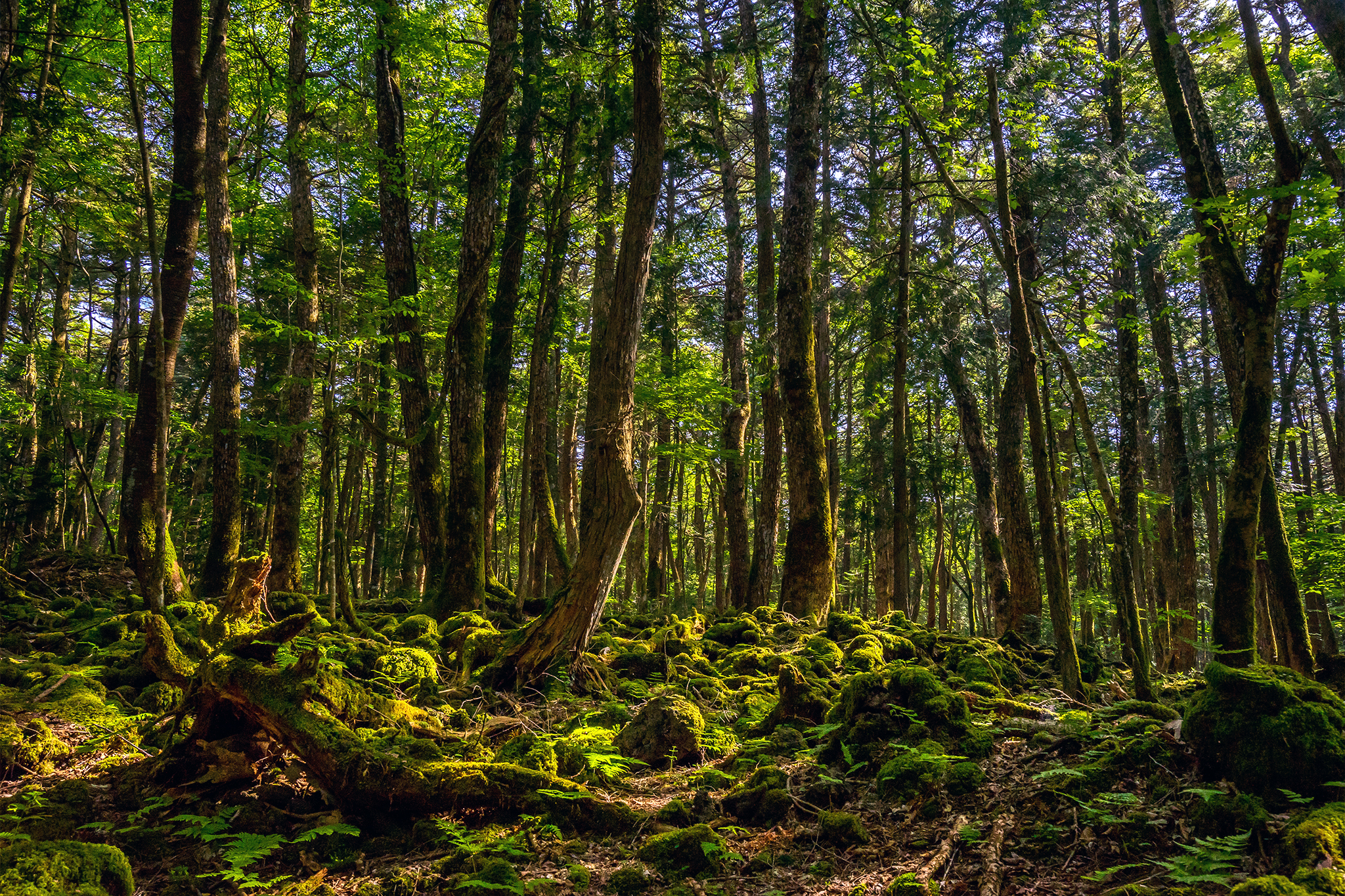
Aokigahara | Image by Marvin Minder via Shutterstock
Aokigahara
Another destination in Dark Tourist was Aokigahara, a hauntingly beautiful forest that’s sadly most well-known as Japan’s leading suicide spot. It featured in Hollywood movies such as The Sea of Trees with Matthew McConaughey and The Forest starring Natalie Dormer and then made global headlines at the beginning of 2018 when Logan Paul showed the body of a suicide victim on his YouTube channel. Following a barrage of criticism, he apologized for the video, but the damage had been done. At the very least, the episode showed potential visitors to the area the importance of being respectful and not trivializing or sensationalizing such a sensitive topic. 
The forest formed from hardened lava after Mount Fuji erupted in 864. According to folklore, it was a place where people once practiced ubasute — a form of senicide which involved dumping an elderly person in a remote place. It, therefore, became associated with death and evil spirits, known as yurei . The number of people taking their own lives there increased significantly in the 1960s after the release of Seicho Matsumoto’s novel Tower of Waves. It’s more than just a suicide spot, though. Commonly known as Jukai, meaning a “sea of trees,” it’s an ethereal forest with lush greenery and deep lava caves.
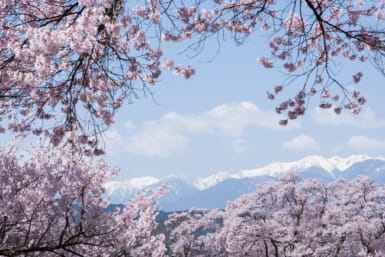
The Most Popular Sakura Spots in Japan to Tour
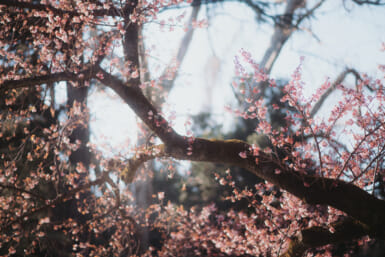
The History of Hanami: Sakura's Beauty in Impermanence
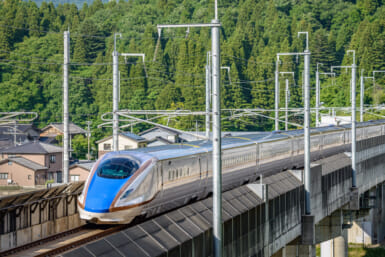
Hokuriku Shinkansen Line Expands to Fukui Prefecture
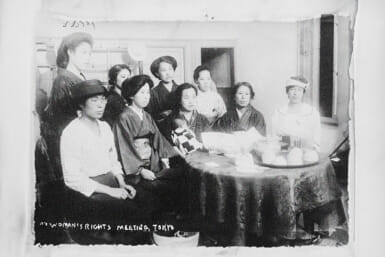
5 Noteworthy Japanese Feminist Icons Throughout History
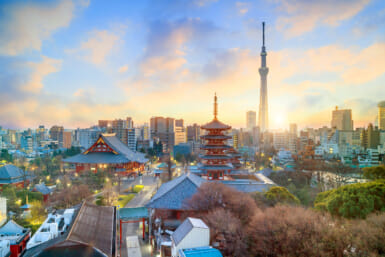
Introducing Eternal Tokyo, Your Key to Japan’s Capital

The Best Spots to Sip on Sake in Tokyo

Monozukuri: Understanding the Art of Craftsmanship in Japan

A Beginner’s Guide to Japanese Cuisine
An official website of the United States government
The .gov means it’s official. Federal government websites often end in .gov or .mil. Before sharing sensitive information, make sure you’re on a federal government site.
The site is secure. The https:// ensures that you are connecting to the official website and that any information you provide is encrypted and transmitted securely.
- Publications
- Account settings
Preview improvements coming to the PMC website in October 2024. Learn More or Try it out now .
- Advanced Search
- Journal List
- Int J Environ Res Public Health

Dark Tourists: Profile, Practices, Motivations and Wellbeing
José magano.
1 Research Center in Business and Economics (CICEE), Universidade Autónoma de Lisboa, Rua Sta. Marta 47, 5.º Andar, 1150-293 Lisboa, Portugal
2 ISCET-Higher Institute of Business Sciences and Tourism, Rua de Cedofeita, 285, 4050-180 Porto, Portugal
José A. Fraiz-Brea
3 Department of Business Organization, Business Administration and Tourism Faculty, University of Vigo, 32004 Ourense, Spain
Ângela Leite
4 Center for Philosophical and Humanistic Studies, Faculty of Philosophy and Social Sciences, Portuguese Catholic University, Rua de Camões 60, 4710-362 Braga, Portugal
Associated Data
Datasets are available upon request to the authors.
This work aims to address whether knowing what dark tourism is (or not) impacts rumination on sadness, self-hatred, hostility, psychological vulnerability, and tourist wellbeing, as well as practices and motivations for dark tourism. A quantitative approach, based on a survey of 993 respondents, reveals that women and more educated participants know more about dark tourism; people who know what dark tourism is have visited more Holocaust museums, sites of human tragedy and natural disasters, concentration camps, and prisons; show more curiosity, need to learn and understand, and need to see morbid things. A model was found showing that gender, age, know/do not know dark tourism, and motivations (curiosity, the need to learn, the need to understand, and pleasure) explained 38.1% of a dark tourism practice index. Most findings also indicate that rumination on sadness, self-hatred, hostility, and psychological vulnerability are associated with darker practices. Greater wellbeing was not found in participants who knew in advance what dark tourism was. Interestingly, participants who visit tragic human sites present higher values in hostility and tourist wellbeing than those who do not. In summary, people who visit more dark places and score higher on negative personality characteristics have higher values of tourist wellbeing.
1. Introduction
Many people are increasingly looking for new and unique touristic experiences to satisfy a wide range of motivations. That has driven the segmentation and the emergence of increasingly specific typologies, such as dark tourism, that, in contrast with mass tourism, are characterized by a high degree of diversification and individualization. Dark tourism comprises visiting real or recreated places related with death, suffering, disgrace, or the macabre [ 1 , 2 ]. From the perspective of dark tourism places, it is important to understand what drives people to visit them to design satisfying experiences. We may think of death as an obvious motivation, often part of the site’s history, but it is not always the primary or explicitly recognized motivation for a visit. Sharpley and Stone [ 3 ] admitted that the field of motivation to visit dark tourism destinations remains an understudied area, although recent literature has provided an increasing number of empirical studies about the reasons for visiting those sites [ 4 , 5 ].
This research intends to contribute to the dark tourism literature by seeking to understand whether people know what dark tourism is and identify a differentiated sociodemographic, motivational, and tourist practice profile between people who know and do not know what dark tourism is. In addition, it aims to understand if dark tourists’ motivations for visiting dark tourism destinations explain their practices. The research approach relies on empirically exploring the motivations, practices, and sociodemographic characteristics of a sample of 933 people that participated in a survey held in Portugal.
The remainder of the text is organized as follows: firstly, a brief theoretical background is put forward, focused on the dark tourism concept and dark tourists’ motivations and practices; then, the quantitative study’s applied methods and obtained results are described; finally, the results are discussed, and conclusions and implications are drawn.
2. Theoretical Background
Despite the fact that some authors consider it one of the older forms of tourism, it has gained great popularity amongst academics from the 1990s onwards [ 3 ], confirmed by the significant volume of literature published ever since [ 4 , 5 , 6 ]. However, understanding the demand for this type of tourism persists as poorly defined and theoretically fragile [ 3 , 4 , 7 , 8 ]. For a long time, places that have been the scene of wars, disasters, deaths, and atrocities have always fascinated people, motivating them to travel [ 3 , 9 ]. Sharpley and Stone [ 3 ] often use the term dark tourism as the type of tourism that encompasses traveling to sites related to death, suffering, and macabre—a globally accepted definition. However, Tarlow [ 10 ] implies the phenomenon is complex by describing it as “visits to places where noteworthy historical tragedies or deaths have occurred that continue to impact our lives”, which raises the question about the inherent motives to consume dark tourism.
2.1. Dark Tourists and Their Motivation to Dark Tourism Consumption
Stone’s (2006) idea of dark tourism goes far beyond related attractions. From this standpoint, diverse well-visited tourist sites may become places of dark tourism due to their history linked with death—e.g., suicides in the Eiffel Tower, tombs in the pyramids of Egypt, the Valley of the Kings, and the Taj Mahal, funeral art at the Cairo Museum, and terrorist attacks in Ground Zero [ 11 ]. Ashworth and Isaac [ 12 ] also suggest that all tourist places have a greater or lesser potential of being perceived as “dark.” Accordingly, the same dark tourism place can evoke different experiences in different visitors (i.e., a site one visitor sees as “dark” may not be for another); thus, the authors argue that no site is intrinsically, automatically, and universally “dark,” as, even they may be labeled as dark, they are not always perceived as such by all visitors.
Walter [ 13 ] states that most dark tourism is not specifically motivated, comprising only parallel visits inserted in a trip of a wider reach. Nonetheless, the literature indicates that tourists who visit dark places are not a homogeneous group, and neither the factors inherent to the visitation are the same. Moreover, the “darker” motivation can undertake distinctive levels of intensity. Consequently, in addition to the fascination and interest in death [ 12 , 14 , 15 ], the visit to this type of place is also motivated by personal, cultural, and psychological reasons [ 4 ] or driven by entertainment purposes [ 7 , 16 ].
The literature indicates numerous reasons to visit dark tourism sites: educational experience, desire to learn and understand past events, and historical interest [ 7 , 17 , 18 , 19 , 20 ], as self-discovery purposes [ 17 ], identity [ 7 ], memory, remembrance, celebration, nostalgia, empathy, contemplation, and homage [ 10 , 17 , 20 ], curiosity [ 17 , 19 , 20 , 21 ], the search for novelty, authenticity, and adventure [ 2 , 20 ], convenience when visiting other places [ 19 ], and also status, prestige, affirmation, and recognition that these visits provide [ 22 ]. To a lesser extent, the literature also mentions religious and pilgrimage reasons, feelings of guilt, a search for social responsibility, or heritage experience.
The desire to learn and understand stands out as a motive associated with sites of death and/or heritage. Whereas some visitors exhibit a considerable need for emotional experience and connection to their heritage, engaging, as Slade puts it [ 23 ], in a “profound heritage experience”, and emotionally to the “dark” space influence [ 24 ], other visitors may be knowledge-seekers, who are more interested in a knowledge-enriching experience [ 25 ] than an emotional one and look for gaining a deeper understanding. Isaac et al. [ 20 ] found that memory, gaining knowledge and awareness, and exclusivity were important motivations for dark tourists; also, “(…), consuming dark tourism may allow the individual a sense of meaning and understanding of past disaster and macabre events that have perturbed life projects” [ 2 ]. Tourists’ interest in places associated with death and tragedy may also be related to educational goals [ 9 ].
Curiosity and the need to learn and understand are entwined. Dark tourism develops curiosity and satisfies the desire for knowledge of past suffering and pain [ 26 ]. Ashworth (2004) and Ashworth and Hartmann [ 27 ] suggested three main reasons for visiting dark sites: curiosity about the unusual, attraction to horror, and a desire for empathy or identification with the victims of atrocity. Yan, Zhang, Zhang, Lu and Guo [ 24 ] refer to the curious type of dark tourist who engages cognitively by learning about the issue. From another perspective, dark tourists may feel motivated by morbid tourism [ 28 ] and show interest in specific macabre exhibitions and museums [ 29 ] and fascination with evil [ 30 ], given the morbid nature of dark tourism [ 31 ]. Other authors present yet other motives: secular pilgrimage; a desire for inner purification; schadenfreude or malicious joy; “ghoulish titillation”; a search for the otherness of death; an interest in personal genealogy and family history; a search for “authentic” places in a commodified world; and a desire to encounter the pure/impure sacred [ 18 ]. Iliev [ 4 ] concludes that although tourists visit places related to death, they may not necessarily be considered dark tourists; as already acknowledged, those sites may not be experienced as “dark” by each visitor. It is, therefore, imperative that the so-called dark tourists are considered as such based on their experience.
2.2. Dark Tourist Personality
Some authors who study dark tourism have tried to relate dark tourist practice with personality characteristics, namely with the dark triad—psychoticism, narcissism, and Machiavellianism [ 16 , 32 , 33 , 34 ]. However, the nature of dark tourism, especially that related to the Holocaust, can be so complex that the personality characteristics that motivate it may be less central, so we decided to study the following characteristics: rumination in sadness, self-hatred, hostility, and psychological vulnerability.
Rumination about sadness includes “repetitive thoughts concerning one’s present distress and the circumstances surrounding the sadness” [ 35 ]. These thoughts are related to the nature of one’s negative affect, are not goal-directed nor lead to plans for solutional action [ 36 ], and are not socially shared while the rumination occurs. Thus, rumination on sadness presents a negative content, “does not facilitate problem resolution, is a solitary activity, and is intrusive if the person is pursuing either self-or situationally imposed task-oriented goals” [ 35 ].
Nolen-Hoeksema and Morrow’s [ 36 ] measure of rumination focuses on ideation, contrary to expression or disclosure, but it also includes disclosing feelings to others and emotional expressiveness as components of rumination. According to Nolen-Hoeksema and Morrow [ 36 ], ruminative responses are different from structured problem-solving because people only think or talk about how “unmotivated, sad, and lethargic they feel” (p. 569). Despite that, Nolen-Hoeksema and Morrow’s [ 36 ] stated that ruminative responses include telling others how badly one feels. Although rumination has negative consequences, disclosure may have positive effects [ 37 ]; also, some forms of emotional expressiveness, a component of disclosure, seem beneficial [ 38 ].
Self-hatred is an “enduring dysfunctional and destructive self-evaluation, characterized by attributions of undesirable and defective qualities, and failure to meet perceived standards and values leading to feelings of inadequacy, incompetency, and worthlessness” [ 39 ]. High self-hatred is related to low self-esteem, shame, self-blame or guilt, and a mental state of agitation, raising an experience of psychological and emotional turmoil [ 39 ].
According to Derogatis and Melisaratos [ 40 ], hostility captures thoughts, feelings, and actions associated with hostile behavior. Although the hostility scale measures perceived levels of expressed hostility rather than actual levels of outwardly expressed hostility, the hostility scale is significantly associated with anger [ 41 ], and high anger is related to outward, uncontrolled, and negative expressions of anger [ 42 ].
Psychological vulnerability is the “individual’s capacity to deal with mechanisms of maintaining emotional strength, in case of a pessimistic point of view, due to the lack of social support” [ 43 ]. Psychological vulnerability is a pattern of cognitive beliefs translating to “a dependence on achievement or external sources of affirmation for one’s sense of self-worth” [ 44 ]. Psychological vulnerability is negatively associated with positive affect, self-efficacy, and social support and positively associated with negative affect, perceived powerlessness, and maladaptive coping behavior [ 43 , 44 ]. Dark tourists are subjects situated in emotionally sensitive spaces [ 45 ] that can trigger their psychological vulnerability.
2.3. Research Questions
Although research on dark tourism has increased in recent years, there are not enough studies exploring if people’s knowledge of this phenomenon and their personality traits lead to distinctive dark tourists’ motivations and behaviors. Taking into account the aforementioned motivations to visit dark tourism places, the present study intends to empirically explore if dark tourists’ personality characteristics and sociodemographic variables impact such motivations and dark tourists’ practices and wellbeing (the latter, measured as a dark tourism practice index, given the diversity of known dark tourism practices). Specifically, our research questions are: Do rumination on sadness, self-hatred, hostility, and psychological vulnerability explain the practices and motivations for dark tourism and thus explain tourist wellbeing? Does knowing what dark tourism is (or not) impact rumination on sadness, self-hatred, hostility, and psychological vulnerability, as well as practices and motivations for dark tourism and tourist wellbeing?
3. Materials and Methods
Given the research questions, the aims of the present study are as follows: (1) to find the sociodemographic differences in touristic practices and motivations for dark tourism according to two groups (those who knew what dark tourism is and those who did not know); (2) to assess the fit of the rumination on the sadness scale, self-hatred scale, hostility scale, psychological vulnerability scale, and tourism wellbeing scale; (3) to determine the differences in rumination on sadness, self-hatred, hostility, psychological vulnerability, and tourism wellbeing according to two groups (those who knew what dark tourism is and those who didn’t know); (4) to find the differences in rumination on sadness, self-hatred, hostility, psychological vulnerability, and tourism wellbeing according to practices and motivations for dark tourism; and (5) to determine variables that contribute to the dark tourism practice index. Accordingly, we hypothesize:
Participants who know what dark tourism is are younger and have more education than those who do not.
Participants who know what dark tourism is are more motivated and visit more places associated with dark tourism than those who do not.
All measures show a good fit for the sample.
Differences in rumination on sadness, self-hatred, hostility, psychological vulnerability, and tourism wellbeing according to two groups (those who knew what dark tourism is and those who did not know) will be found.
Differences in rumination on sadness, self-hatred, hostility, psychological vulnerability, and tourism wellbeing according to practices and motivations for dark tourism will be found.
Gender, age, to know/know not dark tourism, and the motivations of curiosity, need to learn, need to understand, and pleasure will contribute to explaining dark tourism practice.
3.1. Procedures
All procedures followed the Declaration of Helsinki and later amendments or comparable ethical standards. The investigation protocol included informed consent, and confidentiality and anonymity of the data were guaranteed. The research protocol was applied in person to a random sample of participants between 18 October and 17 December 2021. The participants were informed about the study’s purpose and were ensured confidentiality and anonymity of the data; they also signed informed consent. The inclusion criteria consisted of being over 18 years old, Portuguese, and having touristic experiences. The respondents were approached by two researchers and five MSc students on the University’s campuses and within their informal networks, with the questionnaire being self-administered.
3.2. Instruments
The instruments that were not validated for the Portuguese population—the Rumination on Sadness Scale (RSS) and the Self-Hatred Scale (SHS)—were first translated from English to Portuguese by two bilingual translators, one from and another not from the field of psychology. Then, a third bilingual translator from the field of psychology provided a reconciliation of the two translations. Next, a native English speaker not from the psychology field independently performed the reconciled version’s back-translation. Finally, the first translator reviewed the back-translated version of the scale and compared it with the original English version to ensure linguistic and cultural equivalence consistency.
- Sociodemographic questionnaire
The sociodemographic questionnaire included questions related to gender (feminine—0; masculine—1), age, education (no education–0; primary education—1; secondary education—2; higher education—3), marital status (no relationship-single, divorced, separated, widowed–0; in a relationship-boyfriends, married, de facto union—1), and employment status (inactive—unemployed, retired, on sick leave–0; active-student, employee, housewife, caregivers—1).
- Questionnaire about dark tourism’s practices
The questionnaire on dark tourism practices includes a question about knowledge of dark tourism (or not). In addition, it also asked participants about their tourist practices related to dark tourism (Have you ever visited…? cemeteries; holocaust museums; sites of human tragedy; concentration camps; prisons; sites of war; sites of natural disasters; stop to see accidents). All these questions are answered dichotomously (no—0; yes—1).
- Questionnaire about dark tourism´s motivations
This questionnaire includes the presentation of several reasons to visit a dark place: curiosity, the need to learn, the need to see, the need to understand, pleasure, and the need to see morbid things. All these questions are answered dichotomously (no—0; yes—1).
- Rumination on Sadness Scale (RSS)
The Rumination on Sadness Scale, an individual-difference measure of rumination on sadness, was developed by Conway et al. [ 35 ] as an alternative to the Ruminative Responses Scale of the Response Styles Questionnaire (RRRSQ; [ 36 ]). It is a unifactorial scale with 13 items. Higher ratings indicate higher levels of rumination on sadness. Cronbach’s alpha, the internal reliability coefficient, was 0.91 in the original version. Since there is no Portuguese version of this scale, it will be validated in this study.
- Self-Hatred Scale (SHS)
The Self-Hatred Scale was developed by Turnell et al. [ 39 ] to assess individuals’ levels of self-hatred. Since self-hatred is a significant predictor of suicidal ideation, this scale has the potential to be helpful in suicide risk assessment. Higher ratings indicate higher levels of self-hatred. Cronbach’s alpha was 0.95 in the original version. There is no Portuguese version of this scale, so it will also be validated in this study.
- BSI Hostility Scale (HSS)
BSI Hostility Scale (HS) is a subscale of the Brief Symptoms Inventory [BSI; [ 40 ]], whose Portuguese version is from Canavarro [ 46 ]. BSI is a 53-item measure to identify self-reported clinically relevant psychological symptoms in adolescents and adults. The BSI covers nine symptom dimensions: Somatization, Obsession-Compulsion, Interpersonal Sensitivity, Depression, Anxiety, Hostility, Phobic Anxiety, Paranoid Ideation, and Psychoticism; and three global indices of distress: Global Severity Index, Positive Symptom Distress Index, and Positive Symptom Total. The Hostility subscale includes five items, and higher ratings indicate higher levels of hostility. In the original version, the alpha coefficients for the nine dimensions of the scale ranged from 0.64 in the Psychoticism dimension to 0.81 in the Somatization dimension. In the Portuguese version, the alpha coefficients ranged from 0.71 in the Psychoticism dimension to 0.85 in the Depression dimension.
- Psychological Vulnerability Scale (PVS)
The Psychological Vulnerability Scale (PVS) was designed to obtain information about maladaptive cognitive patterns, such as dependence, perfectionism, need for external sources of approval, and generalized negative attributions. The PVS is a six-item scale with higher scores indicating greater psychological vulnerability. In the original version [ 44 ], Cronbach’s α coefficient ranged from 0.71 to 0.87 for different samples; in the Portuguese version [ 47 ], Cronbach’s α coefficient was 0.73.
- Tourism Wellbeing Scale (TWS)
The Tourism Wellbeing Scale (TWS) was developed by [ 48 ] Garcês et al. (2018 [ 49 ]); it aims to evaluate tourism wellbeing in each destination, having been built from positive psychology variables, namely, wellbeing, creativity, optimism, and spirituality. It is a unifactorial scale with eight items. Higher ratings indicate higher levels of tourism wellbeing. Cronbach’s alpha was 0.97 in the original version.
3.3. Data Analysis
Prior to analysis, the normality of items was examined by skewness (SI) and kurtosis (KI) indexes; absolute values of SI less than 3 and KI less than 10 indicate a normal distribution of the data. [ 50 ]. All the instruments were subject to a confirmatory factor analysis (CFA) procedure with maximum likelihood estimation (MLE). The model fit evaluation was based on test statistics and approximate fit indexes, following the thresholds presented in Kline [ 50 ]. Thus, a non-significant model chi-square statistic, χ 2 , states that the model fits the data acceptably in the population; the higher the probability related to χ 2 , the closer the fit to the perfect fit. A value of the parsimony-corrected index Steiger–Lind root mean square error of approximation (RMSEA) close to 0 represents a good fit; RMSEA ≤ 0.05 may indicate a good fit, but the upper bound of the 90% confidence interval exceeding 0.10 may indicate poor fit; also, this test should be non-significant at the 0.05 level. Values of incremental fit index (IFI), Tucker–Lewis index (TLI), and the Bentler incremental comparative fit index (CFI), close to 1 (0.95 or better), are indicators of best fit; also, the standardized root mean square residual (SRMR), a statistic related to the correlation residuals (SRMR over 0.10 suggests fit problems) was used; the smallest the values, the most parsimonious is the model.
Besides goodness-of-fit index evaluation, model re-specification involved analyzing path estimates, standardized residuals of items, and modification indices for all non-estimated parameters. The modifications indices (MI) provide information about potential cross-loadings and error term correlations not specified in the model and the expected change in the chi-square value for each fixed parameter if it were to be freed. Only modifications theoretically meaningful and MI > 11 were considered. Finally, Cronbach’s alpha coefficients were calculated to ascertain the model’s reliability.
Group differences were analyzed. The independent t-test was applied to compare the means of the two groups. In addition, chi-squared was used to compare distributions’ differences and Mann–Whitney test to compare ordinal data. Three measures of the effect size, Cohen’s d, the eta squared, phi, and rank biserial correlation were used according to the variables’ measurement level; interpretation followed Cohen’s [ 51 ] guidelines; the statistical significance level was set at 0.05. Statistical analysis was performed using SPSS version 28 and AMOS version 28.
The sample includes 993 participants, mainly female, in a romantic relationship, with secondary or university education, and active; the mean age is around 31 years. Statistically significant differences were found concerning age and education between the sample that had already heard about dark tourism and knew what it was and the sample that had not yet heard about it. Participants who had heard about dark tourism were significantly younger and more educated than those who had not ( Table 1 ).
Sample sociodemographic characteristics.
Notes: N = frequencies; % = percentage; M = mean; SD = standard deviation; χ 2 = qui-squared test; Φ = Phi size effect; t = t -test; Cohen’s d = size effect; p = p -value. In bold: statistically significant values.
Concerning the total sample and dark tourism practices, most people have visited cemeteries, and about a third of the sample stopped to see accidents. On the other hand, about a quarter of the sample already had other practices, except for a visit to concentration camps, which was only carried out by about 14% of the total sample. The same trend remains in the sample that has not yet heard about dark tourism and the sample that has. However, there are statistically significant differences between these two samples regarding practices related to dark tourism, being that the sample that has already heard about dark tourism visits many more Holocaust museums, sites of human tragedy, concentration camps, prisons, and sites of natural disasters than the sample that has not yet heard about dark tourism ( Table 2 ).
Dark tourism practices.
Notes: N = frequencies; % = percentage; χ 2 = qui-squared test; Φ = Phi size effect; p = p -value. In bold: statistically significant values.
As for the reasons behind the desire to visit dark places, curiosity stands out in the total sample, with the least chosen reason being the need to see morbid things. The same trend can be seen in the two subsamples. However, there are statistically significant differences between these two samples regarding motives to visit dark places, being that the sample that has already heard about dark tourism presents higher values in the motives related to curiosity, the need to learn and understand, and the need to see morbid things than the sample that has not yet heard about dark tourism ( Table 3 ).
Dark tourism motives.
Table 4 shows the descriptive statistics related to the items of the instruments used in this study: the rumination on sadness, tourism wellbeing, self-hatred, hostility, and psychological vulnerability. The skewness and kurtosis values are all within the normative values, ensuring the normality of the distribution, except for item SHS3 whose values are slightly above the recommended one.
Items’ frequencies.
A confirmatory factorial analysis of the rumination on sadness scale was carried out to confirm the authors’ model [χ 2 (46) = 4.121; CFI = 0.977; TLI = 0.961; IFI = 0.977; RMSEA = 0.056; PCLOSE = 0.107: SMRM = 0.028]; however, to achieve this model fit, some correlations between errors were established ( Figure 1 ).

Model fit of Rumination on Sadness Scale.
Confirmatory factorial analysis of the self-hatred scale [χ 2 (11) = 5.118; CFI = 0.992; TLI = 0.984; IFI = 0.992; RMSEA = 0.064; PCLOSE = 0.069: SMRM = 0.015] ( Figure 2 ), hostility scale [χ 2 (2) = 4.216; CFI = 0.995; TLI = 0.976; IFI = 0.995; RMSEA = 0.057; PCLOSE = 0.317: SMRM = 0.012] ( Figure 3 ), psychological vulnerability scale [χ 2 (7) = 2.886; CFI = 0.992; TLI = 0.983; IFI = 0.992; RMSEA = 0.044; PCLOSE = 0.644; SMRM = 0.018] ( Figure 4 ), and tourism wellbeing scale [χ 2 (16) = 3.787; CFI = 0.979; TLI = 0.964; IFI = 0.980; RMSEA = 0.053; PCLOSE = 0.339: SMRM = 0.029] ( Figure 5 ) were carried out to assess the models’ adjustments. Despite finding good fits for all models, some correlations between errors were established to achieve such fits. Thus, hypothesis H3 is confirmed.

Model fit of Self-hatred Scale.

Model fit of Hostility Scale.

Model fit of Psychological Vulnerability Scale.

Model fit of Tourism Wellbeing Scale.
There are no differences in the values of rumination on sadness, self-hatred, hostility, psychological vulnerability, and tourism wellbeing concerning knowing what dark tourism is or not ( Table 5 ).
Rumination on sadness (RSS), self-hatred (SHS), hostility (HSS), psychological vulnerability (PVS), and tourism wellbeing (TWBS) frequencies and differences between those who know dark tourism and those who do not.
Notes: α = Cronbach’s alpha; M = mean; SD = standard deviation; MR–mean rank; U = Mann–Whitney test; p = p -value; r = rank-biserial correlation.
Differences were assessed regarding the values of rumination on sadness, self-hatred, hostility, psychological vulnerability, and tourism wellbeing according to dark tourism practices. Being that only statistically significant results are presented, it was found that participants who visit cemeteries have significantly lower values of self-hatred and psychological vulnerability than participants who report not visiting cemeteries ( Table 6 ). Furthermore, those who visit tragic human sites present higher values in hostility and tourism wellbeing than those who do not. Those who visit sites of war present higher values in self-hatred than those who did not. Those who visit site of natural tragedies also present higher values in hostility and tourism wellbeing. Lastly, those who stop to see accidents present higher values in rumination on sadness, self-hatred, hostility, psychological vulnerability, and tourism wellbeing than those who do not stop ( Table 6 ).
Rumination on sadness (RSS), self-hatred (SHS), hostility (HSS), psychological vulnerability (PVS) and tourism wellbeing (TWBS) frequencies and differences according to dark tourism practices.
Notes: α = Cronbach’s alpha; M = mean; SD = standard deviation; MR–mean rank; U = Mann–Whitney test; p = p -value; r = rank-biserial correlation. In bold: statistically significant values.
Differences were also assessed concerning the values of rumination on sadness, self-hatred, hostility, psychological vulnerability, and tourism wellbeing according to dark tourism motives. Those participants who identified curiosity, need to see, and need to understand as reasons to visit dark places in the context of tourism presented higher values in rumination on sadness, self-hatred, hostility, psychological vulnerability, and tourism wellbeing than those who did not identify curiosity as a motive ( Table 7 ). Concerning the motive “need to learn”, it was found to be a statistically significant difference in tourism wellbeing, being that those who identified the need to learn as a motive to visit dark places in the context of tourism present higher values in tourism wellbeing and self-hatred than those who did not. Those participants who identified the need to see as a reason to visit dark places in the context of tourism presented higher values in rumination on sadness, self-hatred, hostility, and psychological vulnerability than those who did not identify the need to see as a motive ( Table 7 ). Those participants who recognized the need to understand as a reason to visit dark places in the context of tourism present higher values in rumination on sadness, hostility, psychological vulnerability, and tourism wellbeing than those who did not identify the need to understand as a motive ( Table 7 ). Concerning the motive “pleasure”, it was found a statistically significant difference in tourism wellbeing; those who recognized pleasure as a motive to visit dark places presented higher values in tourism wellbeing than those who did not. Lastly, those participants who identified the need to see morbid things as a reason to visit dark places presented higher values in rumination on sadness, self-hatred, hostility, and psychological vulnerability than those who did not identify the need to see morbid things as a motive ( Table 7 ).
Rumination on sadness (RSS), self-hatred (SHS), hostility (HSS), psychological vulnerability (PVS), and tourism wellbeing (TWBS) frequencies and differences according to dark tourism motives.
After creating a new variable, an index about practices related to dark tourism, based on the individual items, we carried out a multiple linear regression in which the dependent variable is the index, and the independent variables are the motivations, with the intent to find the variables that explain the touristic practice. It was found that gender, age, know/know not dark tourism, and motives (curiosity, need to learn, need to understand, and pleasure) explain 38% of the touristic practice ( Table 8 ).
Variables that contribute to the dark tourism practice index.
Notes: R 2 = R squared; R 2 Adj. = R squared adjusted; B = unstandardized regression coefficients; EP B = unstandardized error of B; β = standardized regression coefficients; ** p < 0.001.
5. Discussion
The aims of the present study were to find the sociodemographic differences in touristic practices and motivations for dark tourism according to two groups (those who knew what dark tourism is and those who did not know); to determine the differences in rumination on sadness, self-hatred, hostility, psychological vulnerability, and tourism wellbeing according to two groups; to find the differences in rumination on sadness, self-hatred, hostility, psychological vulnerability, and tourism wellbeing according to practices and motivations for dark tourism; and, at last, to determine variables that contribute to a dark tourism practice index. To this end, we carried out a cross-sectional study that included questionnaires related to sociodemographic aspects, motivations to visit dark tourism places, practices of dark tourism, the rumination on the sadness scale, the self-hatred scale, the hostility scale, the psychological vulnerability scale, and the tourism wellbeing scale.
Concerning the participants’ profiles, those who had heard about dark tourism were significantly younger and more educated than those who had not. These results confirm hypothesis H1. These results corroborate those of Millán, et al. [ 52 ] who found a profile of dark tourists in Cordoba between 26 and 40 years old and having university studies. Dark tourism is a niche market [ 53 ] and also is itself a trend [ 54 ], and young people are more available and attentive to new trends [ 55 ]. In addition, more educated people seek more information and have superior technological skills [ 56 ]. Significant differences between the two samples regarding practices related to dark tourism were found, being that the sample that has already heard about dark tourism visits much more Holocaust museums, sites of human tragedy, concentration camps, prisons, and sites of natural disasters than the sample that has not yet heard about dark tourism. These results confirm hypothesis H2. According to Iliev [ 4 ], “if tourists do not experience a site as dark, then they cannot be called dark tourists”, so the author proposed a more apparent distinction of the “dark tourists” based on experience. Ashworth and Isaac (2015) also stated that any tourist site has a greater or lesser potential of being perceived as “dark.” Besides, “darkness cannot be viewed as an objective fact because it is subjectively and socially constructed since (different) people in various (cultural or social) contexts understand and experience dark tourism in different ways” [ 57 ]. In fact, we may ask “who makes the association of ‘darkness’ to a place? Is the label ‘dark tourism’ applied by those offering (and commoditizing) the visitor experience? Alternatively, is any “dark” significance to be evaluated and decided upon by the tourists themselves?” [ 58 ]. “Dark tourism consumption can no longer be derived as an ordinary activity where humans might engage in for “fun”, but rather as part of a quest for a deeper experience, especially in our inherent fear of death” [ 4 ].
The subsample that has already heard about dark tourism presents higher values in the curiosity, the need to learn and understand, and the need to see morbid things motives than the sample that has not yet heard about dark tourism. These results also confirm hypothesis H2. In fact, dark tourists are very interested in understanding historical events; they are psychologically moved by the need to be in contact with authentic experiences by looking at the other’s death as if it were their own death [ 59 ]. One of the motivations that drive dark tourists is the possibility of re-creating the same emotions victims experienced, followed by the authenticity issue [ 60 ]. “Many dark tourists are motivated by the desire and interest in cultural heritage, learning, education, understanding about what happened at the dark site” [ 4 ].
There are no differences in the values of rumination on sadness, self-hatred, hostility, psychological vulnerability, and tourism wellbeing concerning knowing what dark tourism is or not. Therefore, hypothesis H4 cannot be confirmed. These results apparently seem to contradict the relationship between the dark triad of the personality (narcissism, Machiavellianism, and psychopathy) and the practice of dark tourism [ 16 , 32 , 33 , 34 ]. That relationship, studied by those authors, reflects the practice of dark tourism and not the knowledge about it (which is the subject of our study), although there is hardly any knowledge without practice. Concerning tourism wellbeing, these results may question Kidron [ 61 ] who said that dark tourism generates wellbeing and thus assume that dark tourists show wellbeing despite dark practices. However, our results do not show greater wellbeing in the participants who knew in advance what dark tourism was in relation to the others.
Participants who visit cemeteries have significantly lower values of self-hatred and psychological vulnerability than participants who report not visiting cemeteries. Visiting a cemetery can fulfill different functions, such as visiting a dark place or the social and cultural function of honoring the dead. Probably, our results reflect this last function to the detriment of the first and this conformity to cultural and social practices is in accordance with lower values of psychopathology [ 62 ], namely rumination on sadness, self-hatred, hostility, and psychological vulnerability. This result partially confirms hypothesis 5.
Those who visit sites of war present higher levels of self-hatred than those who did not. Furthermore, those who visit natural tragedies sites present higher values in hostility and tourism wellbeing than those who do not. This result reflects the relationship of this tourist practice with the above-mentioned dark triad [ 16 , 32 , 33 , 34 ] and is in line with Kidron [ 61 ], who suggested wellbeing in dark tourists. At last, those who stop to see accidents present higher values in rumination on sadness, self-hatred, hostility, psychological vulnerability, and tourism wellbeing than those who do not stop. Again, this result reveals the relationship between psychopathology and tourist wellbeing that needs to be further explained, although some authors suggest that psychopathology leads to less tourism wellbeing [ 63 ]. This result partially confirms hypothesis 5.
Participants who identified curiosity as a reason to visit dark places in the context of tourism presented higher values in rumination on sadness, self-hatred, hostility, psychological vulnerability, and tourism wellbeing than those who did not identify curiosity as a motive. Curiosity has been a central reason pointed out in the literature for tourism in general [ 64 ] and, specifically, for dark tourism [ 15 , 17 , 19 , 20 , 21 , 65 , 66 ]. Curiosity is a complex construct, which can be seen as something positive, but it can also contain darker aspects of the personality, namely morbid curiosity, and this fact explains its relationship with, on the one hand, wellbeing, and, on the other hand, with rumination on sadness, self-hatred, hostility, and psychological vulnerability. This result partially confirms hypothesis 5.
The participants who identified the need to learn, the need to understand as motives to visit dark places in the context of tourism present higher values in tourism wellbeing and self-hatred than those who did not. The need to learn and understand are also central reasons for tourism in general and their relationship with wellbeing does not seem specific to dark tourism [ 67 ]. This result partially confirms hypothesis 5.
The participants who identified the need to see as a reason to visit dark places in the context of tourism presented higher values in rumination on sadness, self-hatred, hostility, psychological vulnerability, and tourism wellbeing. This result partially confirms hypothesis 5. Similarly to the need to learn, the need to see correlates with wellbeing but with psychopathology. Perhaps this need to learn motivation is correlated with the touristic practice of seeing morbid things [ 68 ].
The participants who recognized pleasure as a motive to visit dark places presented higher values in tourism wellbeing than those who did not. This result partially confirms hypothesis 5. Dark tourism conforms with the pleasure of tourism in general (Yanjun et al., 2015); wellbeing derives from the emotional experience of dark tourism as a motor for transforming the self [ 69 ].
The participants who identified the need to see morbid things as a drive to visit dark places presented higher values in rumination on sadness, self-hatred, hostility, and psychological vulnerability. The need to see morbid things may be a specific motivation for dark tourism [ 1 , 70 ] and not tourism in general. To that extent, the relationship between this motivation and rumination on sadness, self-hatred, hostility, and psychological vulnerability is justified. This result partially confirms Hypothesis 5.
The reasons to visit dark places-curiosity, the need to see, the need to understand, and pleasure are positively and significantly correlated with all places associated with dark tourism. Gender, age, know/know not dark tourism, and motives (curiosity, the need to learn, the need to understand, and pleasure) explained 38.1% of the practice index variance, thus confirming H6. These results mean that motivations to visit dark places are associated with the touristic activity itself and may contradict those of Buda [ 71 ], that claims more emotional and psychoanalytical explorations through the concepts of the death drive [ 71 ], desire [ 72 ], and unconsciousness and voyeurism [ 73 ]. In fact, dark tourists are not altruistic persons [ 14 , 60 ]. Moreover, Jovanovic, Mijatov, and Šuligoj [ 32 ] found that Machiavellianism was related to the preference for dark exhibitions, psychopathy to the preference for visiting conflict/battle sites, and sadism was negatively related to the preference for fun factories and dark tourism sites. However, the “darker” motivation may present different levels of intensity; besides the fascination and interest in death [ 15 ], these visits are also motivated by personal, cultural, and psychological reasons [ 4 ] and/or by entertainment purposes such as entertainment-based museums of torture [ 7 , 16 ]. One of the most curious outcomes of this study is the association of motivations to visit dark tourist sites and self-hatred; the fact that the authors have not found any study that could explain such a result suggests this association exists in the context of dark tourism and not of tourism in general. The dark nature of this type of tourism can be attractive to tourists with less positive personality traits such as self-hatred.
6. Conclusions
The results of this study add new knowledge to this area of expertise as it allows us to understand the association between motivations and practices related to dark tourism. This study also identified the main motivations to visit dark places-curiosity, the need to see, the need to understand, and pleasure, being, interestingly, all internal motivations and, thus, contradicting the literature that, in addition to these motivations, also identifies external motivations. Most findings also indicate that the rumination on sadness, self-hatred, hostility, and psychological vulnerability personality dimensions are associated with dark practices (e.g., the need to see morbid things). Lastly, people who visit more dark places and score higher on negative personality characteristics have higher values of tourism wellbeing. These findings are in line with the literature, which suggests that dark tourism generates negative and positive wellbeing (or even ambivalence). As such, dark tourists, even presenting negative personality characteristics, and also because of them, show tourism wellbeing in their practices and motivations.
The fact that this study was held in a specific sample in Portugal may be considered a limitation; future lines of research could extend it to other countries and age segments.
Funding Statement
This research received no external funding.
Author Contributions
Conceptualization, J.M., J.A.F.-B. and Â.L.; methodology, J.M.; formal analysis, J.M. and Â.L.; writing—original draft preparation, J.M.; writing—review and editing, J.M., J.A.F.-B. and Â.L. All authors have read and agreed to the published version of the manuscript.
Institutional Review Board Statement
Ethical review and approval were waived for this study, as no medical research involving human subjects has been carried out, including research on identifiable human material and data, as indicated by the terms of the Declaration of Helsinki.
Informed Consent Statement
Informed consent was obtained from all subjects involved in the study.
Data Availability Statement
Conflicts of interest.
The authors declare no conflict of interest.
Publisher’s Note: MDPI stays neutral with regard to jurisdictional claims in published maps and institutional affiliations.
Dark tourism: motivations and visit intentions of tourists
International Hospitality Review
ISSN : 2516-8142
Article publication date: 8 July 2021
Issue publication date: 14 June 2022
The overall purpose of this study is to utilize the Theory of Planned Behavior (TPB) in combination with four dark tourism constructs (dark experience, engaging entertainment, unique learning experience, and casual interest) to gain a better understanding of behaviors and intentions of tourists who have visited or plan to visit a dark tourism location.
Design/methodology/approach
A total of 1,068 useable questionnaires was collected via Qualtrics Panels for analysis purposes. Confirmatory Factor Analysis (CFA) was used to verify satisfactory reliability and validity regarding the measurement of model fit. With adequate model fit, structural equation modeling was employed to determine positive and negative relationships between TPB and dark tourism constructs. In all, 11 hypotheses statements were tested within this study.
Results of this study indicate that tourists are curious, interested, and intrigued by dark experiences with paranormal activity, resulting in travel choices made for themselves based on personal beliefs and preferences, with minimal outside influence from others. It was determined that dark experience was the most influential of the dark tourism constructs tested in relationship to attitudes and subjective norm.
Research limitations/implications
The data collected for this study were collected using Qualtrics Panels with self-reporting participants. The actual destination visited by survey participants was also not factored into the results of this research study.
Originality/value
This study provides a new theoretical research model that merges TPB and dark tourism constructs and established that there is a relationship between TPB constructs and dark tourism.
Dark tourism
- Thanatourism
- Motivations
- Theory of planned behaviour
Lewis, H. , Schrier, T. and Xu, S. (2022), "Dark tourism: motivations and visit intentions of tourists", International Hospitality Review , Vol. 36 No. 1, pp. 107-123. https://doi.org/10.1108/IHR-01-2021-0004
Emerald Publishing Limited
Copyright © 2021, Heather Lewis, Thomas Schrier and Shuangyu Xu
Published in International Hospitality Review . Published by Emerald Publishing Limited. This article is published under the Creative Commons Attribution (CC BY 4.0) licence. Anyone may reproduce, distribute, translate and create derivative works of this article (for both commercial and non-commercial purposes), subject to full attribution to the original publication and authors. The full terms of this licence may be seen at http://creativecommons.org/licences/by/4.0/legalcode
Introduction
Dark tourism is defined as the act of tourists traveling to sites of death, tragedy, and suffering ( Foley and Lennon, 1996 ). This past decade marks a significant growth of dark tourism with increasing number of dark tourists ( Lennon and Foley, 2000 ; Martini and Buda, 2018 ). More than 2.1 million tourists visited Auschwitz Memorial in 2018 (visitor numbers, 2019), and 3.2 million tourists visited the Ground Zero 9/11 Memorial annually (a year in review, 2017). Despite of the increasing popularity, there is still limited understanding of dark tourism as a multi-faceted phenomenon ( Biran et al. , 2011 ) . Some research has looked into the motivations and experience of dark tourists ( Poria et al. , 2004 ; Poria et al. , 2006 ). However, most were based on conceptual frameworks and arguments with little empirical data, even less have examined tourist visit intentions to dark tourism sites ( Zhang et al. , 2016 ), let alone the association between dark tourists' motivations and visit intentions. Many scholars suggested the pressing needs for empirical research into dark tourism from tourist perspectives to understand their motivations and experiences ( Seaton and Lennon, 2004 ; Sharpley and Stone, 2009 ; Zhang et al. , 2016 ). Of the limited empirical dark tourism studies, most were case studies with historical battlefields and concentration camps being the hot spots ( Le and Pearce, 2011 ; Lennon and Foley, 1999 ; Miles, 2002 ). Still, a comprehensive understanding of dark tourists' motivations and their intentions to visit is lacking.
As such, this study was conducted to understand both the motivations and visit intentions of tourists to dark tourism destinations. Theory of Planned Behavior (TPB) constructs ( attitudes, subjective norm, perceived behavioral control) and the four dark tourism dimensions (i.e. dark experience, engaging entertainment, unique learning experience, and casual interest ) were utilized to address the following objectives: (1) examine the motivations of dark tourists; (2) investigate the intentions of the dark tourists to visit a dark tourism destination in the next 12 months; and (3) explore the association between the motivations and visit intentions of dark tourists. The dark tourism dimensions utilized for this study were adapted supported by previous dark tourism studies ( Biran et al. , 2014 ; Bissell, 2009 ; Lam and Hsu, 2006 ; Molle and Bader, 2014 ). While many studies have utilized TPB in the past, this study will utilize the TPB to focus attention on why travelers are motivated to visit dark tourism locations specifically.
Literature review
Travels associated with death dates back for centuries ( Dale and Robinson, 2011 ). Early examples of dark tourism include Roman gladiator games, guided tours to watch hangings in England, and pilgrimages to medieval executions ( Stone, 2006 ). Even today, many tourists are fascinated with and thus visited sites of death and tragedy such as the John F. Kennedy's death site in Dallas, Texas, and the Ground Zero 9/11 Memorial in New York ( Foley and Lennon, 1996 ; Strange and Kempa, 2003 ). Abandoned prisons and sites of punishment and incarcerations are also popular attractions among dark tourists (e.g., Pentridge in Melbourne, Australia; Foley and Lennon, 1996 ). However, the term dark tourism did not get introduced to the research community until 1996 which ignited many later research efforts on this topic ( Light, 2017 ).
Dark tourism is defined as the act of tourists traveling to sites of death, tragedy, and suffering ( Foley and Lennon, 1996 ). Many scholars also came up with other terms and labels to describe such phenomenon including thanatourism ( Seaton, 1996 ), disaster tourism ( Rojek, 1993 ), black spot tourism ( Rojek, 1993 ), morbid tourism ( Blom, 2000 ) and even phoenix tourism ( Powell et al. , 2018 ). Mowatt and Chancellor (2011) suggested that despite of different names, at the heart of the concept is travel to places of death that are often linked to violence ( Robb, 2009 ). Many researchers use the term dark tourism and thanatourism interchangeably, while more tend to use dark tourism as an umbrella term for any form of tourism that is somehow related to death, suffering, atrocity, tragedy or crime ( Light, 2017 ). Given the standard use of the term dark tourism in the practice and scholarship of tourism, such a term will be used throughout this manuscript.
Dark tourism research in this past two decades mainly covers six themes including the discussion on definition, concepts, and typologies; the associated ethical issues; the political and ideological dimensions; the nature of demand for dark tourism locations; site management; and the methods used for research ( Light, 2017 ). The area of terminology and definitions undoubtedly dominates in the dark tourism literature ( Zhang et al. , 2016 ). While in the area of exploring the nature of demand for dark tourism locations, the relatively limited research concentrated in four aspects – both the motivations and experiences of dark tourists, the relationship between visiting and sense of identity, and new approaches to theorizing the consumption of dark tourism ( Light, 2017 ).
Research addressing dark tourists' motivations were relatively slow. Many early studies simply postulate and propose tourists' motivations to visit dark tourism sites, with a lack of empirical research to support ( Light, 2017 ). As such, many studies in the past decade examined dark tourists' motivations through different case studies, with concentration camps or historical battlefields being the hot spots ( Lennon and Foley, 1999 ; Miles, 2002 ). Research reveals that tourists visit dark tourism destinations for a wide variety of reasons, such as curiosity ( Biran et al. , 2014 ; Isaac and Cakmak, 2014 ), desire for education and learning about what happened at the site ( Kamber et al. , 2016 ; Yan et al. , 2016 ), interest in history or death ( Yankholmes and McKercher, 2015 ; Raine, 2013 ), connecting with one's personal or family heritage ( Mowatt and Chancellor, 2011 ; Le and Pearce, 2011 ). Drawing from literature, four common themes (i.e. dark experience, engaging entertainment, unique learning experience, casual interest) emerged, served as the foundational pillars for this study, and were discussed below.
The motivation construct
Dark experience.
Raine's (2013) dark tourist spectrum study of tourists visiting burial grounds and graveyards concluded that mourners and pilgrims had personal and spiritual connections to the different sites being studied. Mourners visited specific gravesites and usually would perform meditations for the dead. Pilgrims had a personal connection to specific burial sites in some way, whether it is a religious connection to the individual or they served as a personal hero ( Raine, 2013 ). Death rites are often performed as a ritual not necessarily to mark the passing of the deceased but rather to heal the wounds of families, communities, societies, and/or nations by the deceased's passing ( Bowman and Pezzullo, 2009 ).
Additionally, Raine's (2013) study discovered another subset of tourists—the morbidly curious and thrill seekers. Those classified as morbidly curious or thrill seekers were visiting burial sites to confront and experience death. Whether a mourner or pilgrim or the morbidly curious thrill seeker, the tourists had a strong connection to the dead they were there to visit which could categorize them as seeking a dark experience.
To take dark tourism to the extreme, Miller and Gonzalez (2013) completed a study on death tourism. Death tourism occurs when individuals travel to a location to end their lives, often through a means of assisted medical suicide. It was determined that this is still a taboo topic for some countries where it is not legalized, however it is gaining more publicity. It was determined that death tourism is typically the result of one of four reasons; the primary reason death tourism is planned is because of assisted suicide being illegal in the traveler's home country ( Miller and Gonzalez, 2013 ). While death tourism does not directly apply to this particular study, it is an offspring of dark tourism and is a tourist activity that is related to dark experience.
Dark Experience will have a positive relationship with Attitudes
Dark Experience will have a positive relationship with Subjective Norm
Engaging Entertainment
Engaging Entertainment will have a positive relationship with Attitudes
Engaging Entertainment will have a positive relationship with Subjective Norm
Unique learning experience
Unique Learning Experience will have a positive relationship with Attitudes
Unique Learning Experience will have a positive relationship with Subjective Norm
Casual interest
Casual Interest will have a positive relationship with Attitudes
Casual Interest will have a positive relationship with Subjective Norm
The Theory of Planned Behavior (TPB)
Behavioral intention, defined as an individual's anticipated or planned future behavior ( Swan, 1981 ), has been suggested as a central factor that correlates strongly with observed behavior ( Baloglu, 2000 ). Many believed that intentions serve as an immediate antecedent to actual behavior ( Fishbein and Ajzen, 1975 ; Konu and Laukkanen, 2010 ). Fishbein and Ajzen developed the Theory of planned behavior (TPB) base on three constructs: attitude, subjective norm and perceived behavioral control. The Theory of Planned Behavior (TPB) has been widely used in tourism research ( Ajzen and Driver, 1992 ; Han et al. , 2010 ; Han and Kim, 2010 ; Lam and Hsu, 2004 , 2006 ). TPB suggests that individuals are more likely to engage in behaviors that are believed to be achievable ( Armitage and Conner, 2001 ). Ajzen (1991) suggested that attitude, subjective norm, and perceived behavioral control are important to predict intention. Perceived behavioral control is what influences the tourists' intentions and their perception of their ability to perform a specific behavior.
Lam and Hsu (2004) utilized the TPB to examine motivations of travelers from mainland China to Hong Kong and found that attitude, perceived behavioral control, and past behaviors were directly related to travel intentions. In another study examining the visit intentions of Taiwanese travelers to Hong Kong, Lam and Hsu (2006) found that a positive association between visit frequency and re-visit intention.
Cheng et al. (2006) used the TPB to examine the negative word-of-mouth communication on visit intentions of Chinese consumers to high-class Chinese restaurants. It was determined from their study that the TPB constructs were positively impacted by negative word-of-mouth indicating that the TPB effectively measured consumer communication intention. Similarly, Han and Kim (2010) modified the TPB in the investigation of customers' intention to revisit environmentally friendly hotels and found that past behavior was a significant predictor of intention–the more customers stay at a green hotel, the more likely they intend to revisit. It can be concluded from previous research efforts that the TPB can be utilized to effectively measure behavioral intentions of tourists successfully.
Motivation and intentions
Attitudes will have a positive relationship with Intention
Subjective Norm will have a negative relationship with Intention
Perceived Behavioral Control will have a positive relationship with Intention
Methodology
Survey instrument.
A survey questionnaire was developed to collect information on the socio-demographic background, motivation construct, and planned behavior construct from tourists. Socio-demographic data queried were age in years (continuous), gender (3 categories, male, female and prefer not to answer), level of education (9 categories, from less than high school degree to doctoral degree), marital status (5 categories, from single to widow/widower), personal annual income (12 categories, from less than $20,000 to more than $200,000). Tourists' home residence state and country were also collected.
A dark tourism motivation construct was developed based on previous studies ( Biran et al. , 2014 ; Bissell, 2009 ; Lam and Hsu, 2006 ; Molle and Bader, 2014 ), and used to query previous visit and potential visit separately using a five-point Likert scale (“1 = extremely unimportant”; “5 = extremely important”). This motivation construct consists of 33 item statements from four dimensions ( Table 1 ) which include engaging entertainment, dark experience , unique learning experience , and casual interest . Dark experience consisted of nine statements, related to death, fascination with abnormal and/or bizarre events and destinations, and emotional experiences with a connection to death (e.g., “to travel”, “to have some entertainment”). Engaging entertainment was measured using ten statements that inquire about the personal or emotional connection to the destination they have visited or wish to visit in the future (e.g., “to witness the act of death and dying”, “to experience paranormal activity”). Unique learning experience focused on learning about the history of the destination being visited or trying something that is different and out of the ordinary (eight items, e.g., “to try something new”, “to increase knowledge”). Casual interest focuses on individuals who want to visit a dark tourism destination for the entertainment value but want to have a relaxing time while doing so (six items, “special tour promotions”, “natural scenery”).
The planned behavior construct queried on four dimensions (i.e., attitudes , subjective norms , perceived behavioral control , and behavioral intentions ) associated with visiting dark tourism destinations, with a total of 16 item statements ( Table 2 ). Five item statements were used to measure dark tourists' attitudes (e.g., “visiting a dark tourism destination is enjoyable”, “visiting a dark tourism destination is pleasant”) and behavioral intentions (e.g., “I will visit a dark tourism destination in the next 12 months”, “I would revisit the most recent dark tourism destination I visited again in the future”) respectively, using a five-point Likert scale (“1 = Strongly disagree”; “5 = Strongly agree”). Dark tourists' perceived behavioral control was measured by three item statements (e.g., “I am in control of whether or not I visit a dark tourism destination”, “If wanted, I could easily afford to visit a dark tourism destination”), using the same five-point Likert scale (“1 = Strongly disagree”; “5 = Strongly agree”). For subjective norms dimension, each of the three item statements was measured by a different five-point Likert scale. The statement that “most people I know would choose a dark tourism destination for vacation purposes” uses the scale in which “1 = strongly disagree”, “5 = strongly agree”. One item statement asks individuals to rate on whether “people who are important to me think I ____ choose a dark tourism destination to visit” “1 = definitely should not”, “5 = definitely should”). Another statement asks individuals to rate whether “people who are important to me would ___ of my visit to a dark tourism destination” “1 = definitely disapprove”, “5 = definitely approve”).
Sampling and procedure
To increase the reliability and validity of the survey, a pilot study was conducted. A small group of industry professionals from all over the country currently working at dark tourism destinations and other academic researchers were invited to critique the initial draft of the survey. Forty-one individuals took the survey instrument and provided feedback (e.g., some wording issues). After revisions from the pilot study were completed, the survey was launched, and data was collected.
Qualtrics, a web-based survey software company with access to an electronic database of survey candidates, was used to administer this questionnaire to participants. A total of 44,270 invitations were randomly sent to Qualtrics panel participants requesting participation in this study. Qualification of participants was completed by requesting all survey recipients answer the following questions: (1) Have you visited a dark tourism location within the past 24 months? and (2) Do you plan to visit a dark tourism location within the next 12 months? A statement was provided to all participants explaining what consisted of a dark tourism location to ensure participants were not taking the survey based on experiences of activities like haunted houses or haunted hayrides. Only 3,907 individuals were eligible to complete the survey, and a total of 1,068 participants did complete the survey, which yields a response rate of 27.3%. Altogether 651 out of 1,068 individuals had previously visited a dark tourism destination within the last 24 months while the remaining 417 individuals plan to visit a dark tourism destination within the next 12 months.
Data analysis included descriptive statistics, reliability tests, confirmatory factor analysis (CFA), and structural equation modeling (SEM). Descriptive statistics were used to outline respondents' characteristics (e.g., demographic composition). CFA was utilized to evaluate the measurement model, demonstrate adequate model fit, and ensure satisfactory levels of reliability and validity of underlying variables and their respective factors. Factor loadings greater than 0.70 indicated that the constructs are appropriately represented and considered acceptable ( Hair et al. , 2010 ). Cronbach's alphas were computed to test the internal reliability of items comprising each dimension of the dark tourism motivation construct ( dark experience , engaging entertainment , unique learning experience , casual interest ) and the planned behavior construct ( attitudes , subjective norm , perceived behavioral control ), respectively. A cutoff value of 0.7 was utilized to determine “good” reliability ( Peterson, 1994 , p. 381).
To confirm measurement model validity, the chi-squared ( x 2 ) statistic, Root-Mean-Square-Error of Approximation (RMSEA), Comparative Fit Index (CFI), and the Standardized Root Mean Square Residual (SRMR) values were reviewed. Cutoff criteria used to determine “good fit” were RMSEA score < 0.08 ( Byrne, 1998 ), CFI scores > 0.90 ( Kline, 2005 ), SRMR < 0.08 to indicate a good fit ( Hu and Bentler, 1999 ).
Overwhelmingly, many tourists who had either visited a dark tourism location or plan to visit a dark tourism destination were female (65.4%). Additionally, the majority of participants were 25–34 years of age (44.2%) with the next largest age groups being 35–44 years (21%) and 18–24 years (20.9%). Most had either a 4-years Bachelor's degree from college (30.5%) or at least some college education but did not finish their degree (25.3%). 54.5% of the survey participants were married and 37.6% were single. As for income, the largest percentage (19.5%) had an individual annual income ranging from $20,001-$40,000. A full table of demographic characteristics of the participants can be seen in Table 3 .
Partial disaggregation of measurement model
SEM was utilized to investigate the relationships among dark tourism construct, the planned behavior construct and behavioral intentions. Like the CFA testing, the SEM also uses the chi-squared ( x 2 ) , RMSEA, SRMR, and CFI to determine overall model fit and relationships for this study. After further testing for convergent and discriminant validity, it was determined that all constructs met the composite reliability 0.70 or greater standard regarding the 3-parcel hypothesized model ( Table 4 ) ( Hair et al. , 2010 ).
There are several ways to parcel variables into groupings. For purposes of this study, the variables were parceled using the item-to-construct method since the SEM model was large in size and the goal was to have parcels balanced in terms of difficulty and discrimination ( Little et al. , 2002 ). To develop the parcels, standardized regression weights were evaluated, and the three highest scores served as anchors to each of the three parcels with the highest values associated to parcel 1, next highest to parcel 2, and then the next highest to parcel 3. The remainder of variables were placed into the parcels continuing with the 4th highest value placed into the 3rd parcel and repeating the process in inverted order until all variables were assigned into parcels. Once the variables for each construct were placed into appropriate parcel groupings, averages of the questions associated to the new parceled variables were calculated prior to the CFA and SEM analysis. The attitude and behavioral intention constructs had five variable questions, while subjective norm and perceived behavioral control only had three questions. In those situations, one individual variable question served as the parcel item. Table 2 shows the variables and the parcels in which they were grouped.
Additionally, the average variance extracted was calculated and proved to be less than the composite reliability for each construct indicating convergent reliability of the constructs. The average variance extracted was greater than the 0.50 standard for Dark Experience, Engaging Entertainment, Unique Learning Experience, Attitude, and Subjective Norm constructs. Behavioral Intention (0.49) and Casual Interest (0.48) had values that were borderline acceptable regarding convergent validity. The only construct that did not meet the standards of convergent validity testing was Perceived Behavioral Control (0.23). When testing for divergent validity, all square-root of average variance extracted calculations were greater than the inter-construct correlations indicating divergent validity was present in this study. Partial disaggregation of the variables resulted in a much stronger overall model fit. The RMSEA value was 0.08 indicating a strong model fit and the CFI (0.891) value was acceptable indicating a good model fit. The SRMR value (0.06, Table 4 ) also showed a strong model fit.
Hypothesis testing
Overall, most of the relationships between the dark tourism construct and the TPB constructs were significant. Results show that dark experience has a positive significant relationship with both attitudes (0.434) regarding tourists visiting a dark tourism destination and subjective norms (0.242, Table 5 ). Casual interest has a positive significant relationship with both attitudes (0.404) and subjective norm (0.330). Both engaging entertainment (−0.080; −0.217) and unique learning experience (0.152; −0.247) are not significantly associated with neither attitudes nor subjective norms . Results show that both attitudes (0.396) and perceived behavioral control (0.716) have a significant positive relationship with behavioral intention .
SEM testing was completed on the data. In addition to the significant and insignificant relationships indicated by the SEM testing, to answer some of the specific research questions asked by this study one must review the distinct question factor loadings to get those answers. A full set of the factor loadings of survey questions asked regarding dark tourism and TPB constructs are in Table 1 . A visualization of all hypothesis testing results is in Table 5 as well as on Figure 1 .
It can be concluded from the findings of this research that dark experience has a positive relationship with attitudes regarding tourists visiting a dark tourism location, indicating that Hypothesis 1 was fully supported. Tourists seek specific characteristics when choosing to visit a dark tourism destination. Akin to findings from Bissell (2009) , the reasons for visiting: I want to try something new and out of the ordinary as well as I am fascinated with abnormal and bizarre events were strong. Alone these two variables do not constitute wanting to experience dark tourism but suggest a curiosity about dark tourism and a desire for new experiences ( Seaton and Lennon, 2004 ). Individuals answered favorably to all questions related to interest in experiencing paranormal activity. Although Sharpley (2005) suggested “fascination with death” as a potential motive for tourists to visit dark tourism destinations, questions specifically related to death (i.e., to witness the act of death and dying , to satisfy personal curiosity about how the victims died ) , reveal that fascination with death and dying was not a strong motivating factor for the tourists' who participated in this research study. The positive relationships of dark experience with attitudes ( H1 ) and subjective norm ( H2 ) , respectively, implies that tourists are seeking experiences that satisfy curiosity or they are seeking interaction with the paranormal. Tourists seek a fun and enjoyable tourist experience by visiting dark tourism destinations, and do not feel pressured by societal norms of their friends and family, which may prevent them from visiting dark tourism destinations.
The engaging entertainment dimension regarding both attitude ( H3 ) and subjective ( H4 ) was not supported in this study, which is interesting considering the questions in this dimension were developed to determine the importance of the tourists connecting with the information presented at the destination while still having an enjoyable experience.
Like Raine (2013) , this study considered the unique learning experience dimension to include individuals who are hobbyists and are typically visiting these destinations solely for educational purposes and to not engage with the destination as a dark tourism site. To present an alternative consideration to the construct of unique learning experience, Seaton (1996) determined that the more attached a person was to a destination, the less likely they would be fascinated with death, resulting in the tourists not viewing the dark tourism destination as being “dark”. This thought process may be a possibility of explanation for why the relationships were negative between unique learning experience and the TPB constructs, resulting in both Hypothesis 5 and 6 not being supported. Farmaki (2013) strengthens this argument by determining that many tourists visit museums for the purpose of education, but museums will incorporate the concept of death to enhance the tourist experience.
Results from this study also indicate that participants of this study were not traveling to dark tourism destinations for educational purposes. Additionally, results indicate that individuals who were perhaps traveling for the purposes of unique learning experience had negative feelings or experiences with subjective norms, lending to the belief that their family and friends were not supportive of their choice to visit a dark tourism destination.
Raine (2013) discovered a group of tourists she classified as sightseers and passive recreationalists. These tourists can be themed as “incidental” as they were likely not seeking a dark tourism destination related to death and burials, but instead were looking for a destination to escape from everyday life. These statements can easily be supported by this research study as Hypotheses 7 and 8 were both positively supported in relationship to casual interest and attitudes ( H7 ) and subjective norm ( H8 ). The questions asked in this study specifically relate to value of tours, special promotions, and enjoying time with friends and family.
Individuals were seeking attitudinal experiences through their visits to dark tourism destinations, supporting Hypothesis 9 . Unlike the results from Lam and Hsu (2004) , subjective norms do play a role in behavioral intentions. This study found that the influence of societal norms and pressures do influence tourists' intention to visit dark tourism destinations, lending to Hypothesis 10 not being supported as expected. Regarding perceived behavioral control, when tourists feel capable and in control of their tourism choices, it will positively impact their behavioral intention or likelihood of visiting a dark tourism destination, supporting Hypothesis 11 .
Practical implications
Practitioners working in tourism industries and communities of dark tourism destinations can greatly benefit from the results of this study. Managers of dark tourism destinations must realize that visitors are attracted to these locations for many different reasons ( Bissell, 2009 ) and not just for fascination of death or paranormal activity. While this research does not focus specifically on individual motivating factors that influence behavior to visit, overarching attributes were determined to influence behavioral intentions more than others. The significant positive relationships found in this study between dark experience, unique learning experience, and casual interest suggest dark tourism destination managers offer a variety of tours and services to visitors and should be sensitive in how they display or present information so it does not come across as being offensive to tourists in the event they have strong emotional ties to the destination or individual(s) who may have been a victim at the destination.
Due to the broad nature of this study and its data collection efforts, the dark tourism locations visited by participants varied greatly. It can be concluded from the data that the use of television and contemporary media featuring dark tourism locations does positively influence tourists' behavioral intention to visit. Variables related to dark tourism destinations featured on television shows were more strongly favored in relationship to the dark experience construct than engaging entertainment. This indicates that tourists are curious about what they have seen on television or mass media and want to experience similar. Managers of dark tourism destinations featured on television shows should effectively market their locations as such to increase interest and tourism traffic to their destination. If paranormal tours are not currently being offered this would be a recommendation (if applicable) to generate more tourism interest.
Additionally, due to the increased popularity and reliance on websites and social media platforms for information, practitioners should register their location on dark tourism websites and registries so more curious travelers can easily locate them. Utilizing TripAdvisor.com and other similar travel websites is another option for practitioners to generate tourism interest to their destination. Making information readily available and easy to locate for tourists will continue to strengthen the relationship between perceived behavioral control and behavioral intention. Additionally, considering societal norms had a positive relationship with dark tourism constructs within this study, practitioners could market their destination as being taboo to tourists wanting to satisfy their rebellious curiosity.
Limitations and future research
This study has several limitations. Since the data was collected using Qualtrics Panels, potential participants are asked to self-report and assess whether they are eligible dark tourists for this study, based on given definition of dark tourism. Such self-assessment may not always be precise. If adopting this survey method, future research may consider asking participations to provide the specific dark tourism destination type that they have visited in the past 24 months, to help further confirm their eligibility for study participation. It is also recommended that if time and resources permit, future research consider collecting data on-site at dark tourism destinations. Also, this research study did not take into consideration the type of dark tourism destination visited by the respondents. Dark tourism destinations vary in the levels of violence and death that are associated with them ( Seaton, 1996 ; Stone, 2006 ). Future research can investigate additional motivational factors of tourists to visit dark tourism destinations with varying levels of darkness associated to them.
Most of the previous studies are case studies with historical battlefields and concentration camps being the hot spot for tourist activity. It is important and yet lacking to explore the general pattern of the association between motivations and visit intentions to dark tourism sites in general. Ryan and Kohli (2006) suggested there are differences between dark tourism destinations created by natural disasters (e.g., earthquakes in Sichuan, China; Biran et al. , 2014 ) and those that were sites of death at the hand of man (e.g., Auschwitz concentration camp). Moreover, Zhang et al. (2016) were among the few that explored the associated between motivation and association, but only on college students at one specific site. Although this study is inclusive of different dark tourist groups and dark tourism sites, future research may consider factoring in such difference in dark tourism destinations while exploring dark tourist motivations and visit intensions.
Conclusions
This study serves as exploratory research examining the association between tourist motivations and visit intentions and paves the way for future research in dark tourism. This study contributes to the dark tourism literature by proposing a new theoretical framework linking and extending dark tourism motivation construct with the Planned Behavior Construct. Study results can also benefit practitioners in dark tourism sector.
Graphic representation of theoretical framework and hypothesis testing results
Factor loadings for dark tourism variables
Partial disaggregation parcel groupings of TPB variables
Demographic characteristics of survey participants
CFAs of nested models
Full-data set hypothesis testing results
Ajzen , I. ( 1991 ), “ The theory of planned behavior ”, Organizational Behavior and Human Decision Processes , Vol. 50 , pp. 179 - 211 .
Ajzen , I. and Driver , B.L. ( 1992 ), “ Application of the theory of planned behavior to leisure choice ”, Journal of Leisure Research , Vol. 24 No. 3 , pp. 207 - 224 .
Alegre , J. and Cladera , M. ( 2009 ), “ Analysing the effect of satisfaction and previous visits on tourist intentions to return ”, European Journal of Marketing , Vol. 43 Nos 5-6 , pp. 670 - 685 , doi: 10.1108/03090560910946990 .
Armitage , C.J. and Conner , M. ( 2001 ), “ Efficacy of the theory of planned behaviour: a meta-analytic review ”, British Journal of Social Psychology , Vol. 40 , pp. 471 - 499 .
Baloglu , S. ( 2000 ), “ A path analytic model of visitation intention involving information sources, socio-psychological motivations, and destination image ”, Journal of Travel and Tourism Marketing , Vol. 8 No. 3 , pp. 81 - 90 , doi: 10.1300/j073v08n03_05 .
Biran , A. , Poria , Y. and Oren , G. ( 2011 ), “ Sought experiences at dark heritage sites ”, Annals of Tourism Research , Vol. 38 , pp. 820 - 841 , doi: 10.1016/j.annals.2010.12.001 .
Biran , A. , Liu , W. , Li , G. and Eichhorn , V. ( 2014 ), “ Consuming post-disaster destinations: the case of Sichuan, China ”, Annals of Tourism Research , Vol. 47 , pp. 1 - 17 .
Bissell , L.J. ( 2009 ), Understanding Motivation and Perception at Two Dark Tourism Attractions in Winnipeg, MB , Thesis , University of Manitoba , Print .
Blom , T. ( 2000 ), “ Morbid tourism: a postmodern market niche with an example from Althorp ”, Norsk-Geografisk Tidsskrift--Norwegian Journal of Geography , Vol. 54 No. 1 , pp. 29 - 36 .
Bowman , M. and Pezzullo , P. ( 2009 ), “ What's so ‘dark’ about dark tourism?: death, tours, and performance ”, Tourist Studies , Vol. 9 No. 3 , pp. 187 - 202 .
Byrne , B.M. ( 1998 ), Structural Equation Modeling with LISREL, PRELIS, and SIMPLIS: Basic Concepts, Applications, and Programming , Lawrence Erlbaum , Mahwah, NJ .
Cheng , S. , Lam , T. and Hsu , C. ( 2006 ), “ Negative word-of-mouth communication intention: an application of the theory of planned behavior ”, Journal of Hospitality and Tourism Research , Vol. 30 No. 1 , pp. 95 - 116 .
Conner , M. and Abraham , C. ( 2001 ), “ Conscientiousness and the theory of planned behavior: toward a more complete model of the antecedents of intentions and behavior ”, Personality and Social Psychology Bulletin , Vol. 27 No. 11 , pp. 1547 - 1561 , doi: 10.1177/01461672012711014 .
Crompton , J.L. ( 1979 ), “ Motivations for pleasure vacation ”, Annals of Tourism Research , Vol. 6 No. 4 , pp. 408 - 424 .
Dale , C. and Robinson , N. ( 2011 ), “ Research themes for tourism ”, Dark Tourism , CABI , pp. 205 - 2017 .
Farmaki , A. ( 2013 ), “ Dark tourism revisited: a supply/demand conceptualisation ”, International Journal of Culture, Tourism and Hospitality Research , Vol. 7 No. 3 , pp. 281 - 292 .
Fishbein , M. and Ajzen , I. ( 1975 ), Belief, Attitude, Intention, and Behavior: An Introduction to Theory and Research , Addison-Wesley , Reading, MA .
Foley , M. and Lennon , J. ( 1996 ), “ JFK and dark tourism: a fascination with assassination ”, International Journal of Heritage Studies , Vol. 2 No. 4 , pp. 198 - 211 .
Hair , J.F. , Black , W.C. , Babin , B.J. and Anderson , R.E. ( 2010 ), Multivariate Data Analysis , 7th ed. , Prentice Hall , Upper Saddle River, NJ .
Han , H. and Kim , Y. ( 2010 ), “ An investigation of green hotel customers' decision formation: developing an extended model of the theory of planned behavior ”, International Journal of Hospitality Management , Vol. 29 , pp. 659 - 668 .
Han , H. , Hsu , L. and Sheu , C. ( 2010 ), “ Application of the Theory of Planned Behavior to green hotel choice: testing the effect of environmental friendly activities ”, Tourism Management , Vol. 31 , pp. 325 - 334 .
Hu , L. and Bentler , P.M. ( 1999 ), “ Cutoff criteria for fit indexes in covariance structure analysis conventional criteria versus new alternatives ”, Structural Equation Modeling , Vol. 6 , pp. 1 - 55 .
Isaac , R.K. and Çakmak , E. ( 2014 ), “ Understanding visitor's motivation at sites of death and disaster: the case of former transit camp Westerbork, The Netherlands ”, Current Issues in Tourism , Vol. 17 No. 2 , pp. 164 - 179 , doi: 10.1080/13683500.2013.776021 .
Kamber , M. , Karafotias , T. and Tsitoura , T. ( 2016 ), “ Dark heritage tourism and the Sarajevo siege ”, Journal of Tourism and Cultural Change , Vol. 14 No. 3 , pp. 255 - 269 , doi: 10.1080/14766825.2016.1169346 .
Kline , R.B. ( 2005 ), Principles and Practice of Structural Equation Modeling , 2nd ed. , Guilford Publications .
Kim , Y.H. , Kim , M. and Goh , B.K. ( 2011 ), “ An examination of food tourist’s behavior: using the modified theory of reasoned action ”, Tourism Management , Vol. 32 , pp. 1159 - 1165 .
Konu , H. and Laukkanen , T. ( 2010 ), “ Predictors of tourists’ wellbeing holiday intentions in Finland ”, Journal of Hospitality and Tourism Management , Vol. 17 No. 1 , pp. 144 - 149 , doi: 10.1375/JHTM.17.1.144 .
Lam , T. and Hsu , C. ( 2004 ), “ Theory of planned behavior: potential travelers from China ”, Journal of Hospitality and Tourism Research , Vol. 28 No. 4 , pp. 463 - 482 .
Lam , T. and Hsu , C. ( 2006 ), “ Predicting behavioral intention of choosing a travel destination ”, Tourism Management , Vol. 27 , pp. 589 - 599 .
Le , D.T. and Pearce , D.G. ( 2011 ), “ Segmenting visitors to battlefield sites: international visitors to the former demilitarized zone in Vietnam ”, Journal of Travel and Tourism Marketing , Vol. 28 No. 4 , pp. 451 - 463 , doi: 10.1080/10548408.2011.571583 .
Lennon , J. and Foley , M. ( 1999 ), “ Interpretation of the unimaginable: the U.S. Holocaust Memorial Museum, Washington, D.C. and ‘dark tourism’ ”, Journal of Travel Research , Vol. 38 , pp. 46 - 50 .
Lennon , J. and Foley , M. ( 2000 ), Dark Tourism: The Attraction of Death and Disaster , Cengage Learning EMEA , Andover, Hampshire .
Light , D. ( 2017 ), “ Progress in dark tourism and thanatourism research: an uneasy relationship with heritage tourism ”, Tourism Management , Vol. 61 , pp. 275 - 301 , doi: 10.1016/j.tourman.2017.01.011 .
Little , T.D. , Cunningham , W.A. and Shahar , G. ( 2002 ), “ To parcel or not to parcel: exploring the question, weighing the merits ”, Structural Equation Modeling , Vol. 9 No. 2 , pp. 151 - 173 .
Martini , A. and Buda , D.M. ( 2018 ), “ Dark tourism and affect: framing places of death and disaster ”, Current Issues in Tourism , Vol. 23 No. 6 , pp. 679 - 692 , doi: 10.1080/13683500.2018.1518972 .
Miles , W. ( 2002 ), “ Auschwitz: museum interpretation and darker tourism ”, Annals of Tourism Research , Vol. 29 No. 4 , pp. 1175 - 1178 .
Miller , D. and Gonzalez , C. ( 2013 ), “ When death is the destination: the business of death-tourism--despite legal and social implications ”, International Journal of Culture, Tourism and Hospitality Research , Vol. 7 No. 3 , pp. 293 - 306 .
Molle , A. and Bader , C. ( 2014 ), “ Paranormal science from America to Italy: a case of cultural homogenisation ”, The Ashgate Research Companion to Paranormal Cultures , Ashgate , London , pp. 121 - 138 .
Mowatt , R.A. and Chancellor , C.H. ( 2011 ), “ Visiting death and life ”, Annals of Tourism Research , Vol. 38 No. 4 , pp. 1410 - 1434 , doi: 10.1016/j.annals.2011.03.012 .
Peterson , R.A. ( 1994 ), “ A meta-analysis of Cronbach's coefficient alpha ”, Journal of Consumer Research , Vol. 21 No. 2 , pp. 381 - 391 .
Poria , Y. , Butler , R. and Airey , D. ( 2004 ), “ Links between tourists, heritage, and reasons for visiting heritage sites ”, Journal of Travel Research , Vol. 43 , pp. 19 - 28 .
Poria , Y. , Reichel , A. and Biran , A. ( 2006 ), “ Heritage site perceptions and motivations to visit ”, Journal of Travel Research , Vol. 44 , pp. 318 - 326 .
Powell , R. , Kennell , J. and Barton , C. ( 2018 ), “ Dark cities: a dark tourism index for Europe's tourism cities, based on the analysis of DMO websites ”, International Journal of Tourism Cities , Vol. 4 No. 1 , pp. 4 - 21 , doi: 10.1108/ijtc-09-2017-0046 .
Raine , R. ( 2013 ), “ A dark tourist spectrum ”, International Journal of Culture, Tourism and Hospitality Research , Vol. 7 No. 3 , pp. 242 - 256 .
Robb , E.M. ( 2009 ), “ Violence and recreation: vacationing in the realm of dark tourism ”, Anthropology and Humanism , Vol. 34 No. 1 , pp. 51 - 60 .
Rojek , C. ( 1993 ), Ways of Escape: Modern Transformations in Leisure and Travel , Palgrave Macmillan .
Ryan , C. and Kohli , R. ( 2006 ), “ The Buried Village, New Zealand: an example of dark tourism? ”, Asia Pacific Journal of Tourism Research , Vol. 11 No. 3 , pp. 211 - 226 .
Seaton , A. ( 1996 ), “ Guided by the dark: from thanatopsis to thanatourism ”, International Journal of Heritage Studies , Vol. 2 No. 4 , pp. 234 - 244 .
Seaton , A. and Lennon , J.J. ( 2004 ), “ Thanatourism in the early 21st century: moral panics, ulterior motives and ulterior desires ”, in Singh , T. (Ed.), New Horizons in Tourism: Strange Experiences and Stranger Practices , CABI Publishing , Cambridge, MA , pp. 63 - 82 .
Sharpley , R. ( 2005 ), “ Travels to the edge of darkness: towards a typology of ‘dark tourism’ ”, in Aicken , M. , Page , S. and Ryan , C. (Eds), Taking Tourism to the Limits: Issues, Concepts, and Managerial Perspectives , Elsevier , pp. 215 - 226 .
Sharpley , R. and Stone , P. ( 2009 ), The Darker Side of Travel: The Theory and Practice of Dark Tourism , Channel View Publications , Bristol .
Stone , P.R. ( 2006 ), “ A Dark Tourism Spectrum: towards a typology of death and macabre related tourist sites, attractions and exhibitions ”, Tourism: An Interdisciplinary International Journal , Vol. 54 No. 2 , pp. 145 - 160 .
Strange , C. and Kempa , M. ( 2003 ), “ Shades of dark tourism: alcatraz and robben island ”, Annals of Tourism Research , Vol. 30 No. 2 , pp. 386 - 405 .
Swan , J. ( 1981 ), “ Disconfirmation of expectations and satisfaction with a retail service ”, Journal of Retailing , Vol. 57 No. 3 , pp. 49 - 66 .
Vazquez , D. and Xu , X. ( 2009 ), “ Investigating linkages between online purchase behaviour variables ”, International Journal of Retail and Distribution Management , Vol. 37 No. 5 , pp. 408 - 419 , doi: 10.1108/09590550910954900 .
Yan , B. , Zhang , J. , Zhang , H. , Lu , S. and Guo , Y. ( 2016 ), “ Investigating the motivation–experience relationship in a dark tourism space: a case study of the Beichuan earthquake relics, China ”, Tourism Management , Vol. 53 , pp. 108 - 121 , doi: 10.1016/j.tourman.2015.09.014 .
Yankholmes , A. and McKercher , B. ( 2015 ), “ Understanding visitors to slavery heritage sites in Ghana ”, Tourism Management , Vol. 51 , pp. 22 - 32 , doi: 10.1016/j.tourman.2015.04.003 .
Yoon , Y. and Uysal , M. ( 2005 ), “ An examination of the effects of motivation and satisfaction on destination loyalty: a structural model ”, Tourism Management , Vol. 26 No. 1 , pp. 45 - 56 , doi: 10.1016/j.tourman.2003.08.016 .
Zhang , H. , Yang , Y. , Zheng , C. and Zhang , J. ( 2016 ), “ Too dark to revisit? The role of past experiences and intrapersonal constraints ”, Tourism Management , Vol. 54 , pp. 452 - 464 , doi: 10.1016/j.tourman.2016.01.002 .
Further reading
Krisjanous , J. ( 2016 ), “ An exploratory multimodal discourse analysis of dark tourism websites: communicating issues around contested sites ”, Journal of Destination Marketing and Management , Vol. 5 No. 4 , pp. 341 - 350 , doi: 10.1016/j.jdmm.2016.07.005 .
Lennon , J. ( 2005 ), “ Journeys in understanding what is dark tourism? ”, The Sunday Observer , Vol. 23 October , available at: http://www.guardian.co.uk/travel/2005/oct/23/darktourism.observerscapesection .
Corresponding author
Related articles, we’re listening — tell us what you think, something didn’t work….
Report bugs here
All feedback is valuable
Please share your general feedback
Join us on our journey
Platform update page.
Visit emeraldpublishing.com/platformupdate to discover the latest news and updates
Questions & More Information
Answers to the most commonly asked questions here

20 Unique Dark Tourism Sites Around The World
Disclosure: Advertising and affiliate services, including Amazon Associates, help the cost of running my blog. Clicking ads or making purchases through affiliate links may, at no additional cost to you, earn me a small commission. I appreciate your support .

One of the most unique tourism trends in recent years might have to be the fascination with so-called dark tourism sites. There’s always been a curiosity when it comes to places that might have a historic connection with tragic events. But while there are many reasons for people wanting to visit such sites, dark tourism is not a bad thing.
You might argue that visiting these dark tourism sites is a way of preserving the past. Or making sure the same horrific things don’t happen again . And while you might get some mixed reactions from people about your travel plans, they are fascinating places. And I believe they are places that the world should know about.
Disclaimer: The following article has travel suggestions in both Russia and Ukraine, however was written before the current events unfolded. I have chosen to leave them in this article in the spirit of the original topic covered here, however I am in no way recommending visiting either Russia or Ukraine at this time . Please check current travel conditions for any country you plan on visiting and travel safely.
What is Dark Tourism?
Dark tourism sites are places which we can associate with death, destruction or some kind of disaster. While some might see them as morbid, you’d be surprised at how many places you’ve visited with such connotations. For example, have you ever been to the Tower of London? Full of torture chambers and stories of gruesome events. What about the Colosseum in Rome? The deadly gladiator events here were some of the most bloody spectator sports in history.
We think of them as historical sites in a way we don’t think of some of the following places in the same way. Is it because that was so long ago? Does the length of time before we start exploring these sites really make a difference in how our visiting them should be perceived?
How should I behave at dark tourism sites?

Societal rules about museums are ingrained in us from an early age. But a lot of people worry about what to do while visiting somewhere with such a dark past. How do you behave? What if you do the wrong thing?
Respect is key . Remember that these sites, while open for you to enjoy, learn and experience, are the sites of some pretty bad and horrific things . Be aware of those around you as you never know if they might have a connection to where you are.
While it’s unfair to say you shouldn’t talk or show enthusiasm, use common sense and read the room . A concentration camp is nowhere to be giggling with your friends, a memorial park is not somewhere to be shouting…you get the idea.
Unique Dark Tourism Sites To Visit
Whether you’re a big history buff or just curious in anything a little macabre, these are some dark tourism sites around the world you likely don’t want to miss. From recent tragic events to centuries-old historical happenings, you can’t deny how incredibly interesting these places are.
Alcatraz Prison – San Francisco, USA

Possibly one of the most eerie and fascinating dark tourism sites you will ever visit is Alcatraz . A prison so notorious that it still receives millions of visitors a year. Located on an island in San Francisco ‘s bay area, you now get to experience seeing it from the inside like a prisoner. So close to land but so far away.
The only way to reach Alcatraz island is by a pre-booked boat tour . The tour is popular and often sells out months in advance. There are no food or drinks allowed except at the boat dock area, so plan your day accordingly. You also have a steep walk to the prison at the top of the hill, but there are motorized vehicle transfers for those with mobility issues.
Explore the prison and the grounds with an impeccably narrated audio tour by former guards and inmates. You’ll be led through cells, the recreation areas, the kitchen and more. Learn about the riots, the escapes and the deaths that happened here, and the most famous prisoners to ever call Alcatraz home.
Gravensteen Castle – Ghent, Belgium
Contributed by Cecilie from Worldwide Walkers

Gravensteen Castle in Ghent is a classic example of dark tourism sites in Europe. The castle was built back in 1180 and housed the Count of Flanders for many centuries until it became a court, a prison, and even a cotton factory.
It’s the dark horror stories of torture that really attract visitors to Gravensteen castle. While visiting, you’ll walk through torture rooms and see all the different tools used to punish criminals back in the Middle Ages.
Many people have died within the castle walls in the most horrific ways, which creates a dark haunted feeling to the place. It’s this uncomfortable feeling that leaves you both intrigued and distressed after your visit.
While it might sound very disturbing, the free audio guide does a wonderful job carrying out all the stories in an interesting way with respect to history. It’s a great place to learn about the history of Belgium’s city Ghent . You can even get one of the greatest city views from the castle roof.
Silver Mines – Potosi, Bolivia
Contributed by Deb from The Visa Project

While there are many landmarks to see in Potosi , a unique attraction is to visit one of these working mines. A guided tour let’s you witness the working conditions of the miners.
If you live in Bolivia , you would come across many extreme tourist offerings but this one would probably be one of the darkest. The Cerro Rico mountains silver mines made Potosi a major economic center of the Spanish empire back in the colonial times.
Mining is more or less still done in 18th century style – using old tools, hand and dynamite. No modern safety equipment or protocols. Although you would be introduced to El Diablo, the mountain’s devil-god to who the miners offer cigarettes, liquor as well as blood of an animal slaughtered on the spot for their protection. Child labor is pretty common and you can buy dynamite in the local market!
You will be advised to chew on coca leaves to help with breathlessness if taking a tour through the mines . The miners work in really harsh and dangerous conditions and many get lung diseases afterwards. If you visit, definitely leave a generous tip for the miners.
Port Arthur Penal Colony – Tasmania, Australia
Contributed by Mark from Wyld Family Travel

Port Arthur lies at the bottom of the world in southern Tasmania Australia . Port Arthur was a British penal colony set up in Australia, designed to break prisoners both mentally and physically. To be sent here from England was being sent as far away from your home as possible.
The youngest prisoner was 11 years old and around 70,000 prisoners called Port Arthur home. Prisoners at Port Arthur endured harsh working gangs that built much of Tasmania. The Asylum at the site pays testament to the mental torture these convicts were put through with many slowly losing their minds. Prisoners were regularly flogged to break them into submission.
Port Arthur prison was opened 20 years from 1833-1853 and 7,000 convicts died there. In modern times Port Arthur is also the location for the largest mass shooting in Australian history. This was the catalyst for the strict gun rules Australia lives by now.
Port Arthur is today one of the most interesting places to visit when in Tasmania. The prison site has been preserved with original building and tours explaining the history of the location.
Museum of the Occupation of Latvia – Riga, Latvia

As a former Soviet occupied country, Latvia still has many historic sites linked to the KGB. One of the most interesting activities you can do in Riga is visit the Corner House. This was the old headquarters of the Soviet KGB in Latvia.
True KGB style, if you didn’t know this museum existed you might not be able to find it. A inconspicuous doorway leads into a building straight out of the 50s. Here you can find out about the KGB in the city at that time.
The museum is free or you can pay 10 EUR for a guided tour. The tour might be worth it to see parts of the museum you wouldn’t otherwise get to. Walk through the rooms where the KGB worked and to areas of the building where the prisoners would have been taken.
The storyboards depict historical stories of the KGB in Riga, Latvia , and the “criminals” they arrested, tortured and killed here. This is really one of the most unique dark tourism sites in the Baltic states.
Jallianwala Bagh Memorial Park – India
Contributed by Neha from Travelmelodies

Etched in the history of India as a dark moment, is the incident of Jallianwala Bagh. Located in the holy city of Amritsar in Punjab, it remains one of the most popular places to visit in Amritsar . Jallianwala Bagh is a memorial park in the honor the people that were wounded and lost lives on the fateful day of 13 April, 1919.
Back in 1919, India was under the rule of British and the people of India were protesting for Independence. Over a thousand people had gathered in the Jallianwala park on the festive day of Baisakhi to silently protest the arrest of few national leaders. But General Dyer opened fire unannounced on these people killing and injuring many.
The Jallianwala Bagh now houses a museum with pictures and documents related to the event and some memorial structures in honor of the martyrs. There is a ‘Martyrs Well’ in which some people jumped to save themselves from the bullets. There’s even a wall with bullet markings on it.
Every evening there is a light and sound show that throws light on the unfolding of the event. It is a must visit place and is located next to the Golden temple.
Gori, Georgia
Contributed by Emily from Wander-Lush

The small city of Gori,Georgia has a rather dark claim to fame. It’s the birthplace of Ioseb Jughashvili, better known as former Soviet dictator Joseph Stalin.
An easy day trip from Tbilisi , Gori has become one of the most-visited places in Georgia because of its Stalin connection. The main attraction is the Stalin State Museum, a grandiose sandstone building in the center of the city.
In the yard is one of few remaining Stalin statues still standing in Georgia today. Also the small wooden house where Stalin was born in 1878, and the armored railway carriage he used to travel around the USSR.
The museum opened in 1957 and exhibits remain much the same – that is to say, very Soviet-style. It has a very selective curatorial approach with most artefacts relating to Stalin’s early years and some pretty glaring gaps. With limited information in English it’s recommended to take the guided tour for a few extra dollars.
Visiting the museum is a totally bizarre experience, but it gives an interesting insight into how Stalin’s memory is treated in Georgia today. Some people in Gori (and elsewhere in Georgia) still venerate the dictator, but the younger generations less so.
There are plenty of things to do in Gori that have nothing to do with Stalin. The magnificent Gori Castle, the old town, and the hilltop Gori Jvari church. It’s these attractions that most residents would prefer you remember Gori for.
Tham Piew Cave – Laos
Contributed by Marie from A Life Without Borders

Laos holds the unfortunate title of the most heavily bombed country on Earth. It bore the brunt of clandestine bombing campaigns waged by the USA on Laos during the 1960s and 1970s. Phonsavan in the province of Xieng Khouang, was particularly decimated. In fact, unexploded ordnance still affects local communities to this day.
Many visitors to the region enjoy Phonsavan’s major tourist sights such as the UNESCO site Plain of Jars. But few venture off the beaten track to discover the site of one of the worst days in Lao history.
On 24 November 1968, just one single missile fired from a US fighter plane killing 374 innocent villagers taking refuge in Tham Piew Cave. Just 60 kilometers from Phonsavan city, the cave is a somber and emotional place to visit. But it is important in the turbulent history of Laos, even if little known throughout the rest of the world.
The site’s information center holds extremely confronting photographs of the immediate aftermath of that fateful day, together with the history of the Secret War in Laos. A moving statue of a man carrying a lifeless child marks the entrance to the memorial park. Walk through a peaceful forest to the mouth of the charred cave. Here visitors can leave offerings of incense at the small shrine for those who perished within.
Chernobyl Exclusion Zone, Ukraine
Contributed by Kami from My Wanderlust

The Chernobyl Exclusion Zone is a well-known place all over the world. On April 26th, 1986 the biggest nuclear disaster in the world took place here, changing people’s lives forever. As a result of the catastrophe, the whole area around the power plant became a closed zone. Inhabitants of numerous towns and villages had to move away.
Today you can visit the Exclusion Zone but you need to do it with an official Chernobyl tour . There are plenty of them departing from Kyiv daily and you can choose between day trips and multiday tours. Now, all these years after the disaster the area is safe to visit and the radiation is low.

During your trip, you will see numerous places in the zone, including the power plant itself. But the biggest highlight is the abandoned town of Pripyat. When the disaster happened it was one of the most modern cities in the former USSR, but now nature has taken over the place.
Keep in mind that even if the Chernobyl zone is a very touristy and popular place, it is also a place of great tragedy. Make sure to visit the place with respect and follow your guide’s instructions. Still, this is a fascinating place to visit and everyone visiting Ukraine should include a Chernobyl tour in their itinerary .
Catacombs – Paris, France
Contributed by Debbie from World Adventurists

Even the City of Light and Love has a dark history. One of the most fascinating places to visit is the Catacombs of Paris . The Catacombs have a sad history, full of bones of the unknown. In the 17th century, Paris cemeteries were overflowing so badly that there was no longer space to properly bury their dead. Overflowing graves led to the solution of using the underground tunnels to house the bones.
Approximately six million people have been laid to rest underground. Today the bones are neatly stacked, including some designs made from the bones. At some points there are femurs arranged from the floor almost to the ceiling, with rows of skulls in between, or formed into shapes like a cross.
Visiting the Catacombs, it will make you really wonder what their lives were like back then, who they were, and the cause of each death. It is very humbling.
The Catacombs of Paris are extremely popular. It is more expensive, but to skip the line, you will want to buy your ticket in advance . It can also get chilly down there, so bring a light sweater with you. Allow for at least an hour and a half to wander the Catacombs once you are inside.
Lenin Mausoleum – Moscow, Russia
Contributed by De Wet & Jin, Museum of Wander

In the center of the Red Square in Moscow is a somewhat inconspicuous structure which reminds somewhat of a pyramid. But the long line of Russians and tourists is a giveaway that it is one of the most popular things to do in Moscow .
Inside this step pyramid is where the embalmed body of Vladimir Lenin is on display. Everyone is welcome to visit and pay their respects, or simply come and look at the former Soviet leader for bragging rights.
Visitors to Lenin’s Mausoleum visitors are first searched by military personnel, and bags (and cameras) have to be deposited. There are also a few strictly enforced rules while inside the mausoleum: no talking, hands out of your pockets, no hats and the line must keep moving at all times. Disobey, and a Russian soldier will reprimand you.

The atmosphere as well as the temperature inside the mausoleum is chilling. The line moves quite slowly, so you’ll get a good look at Lenin’s body, which has been on display here for almost a hundred years.
The mausoleum is free to enter and open on Tuesdays, Wednesdays, Thursdays, and Saturdays from 10:00–13:00. Behind the mausoleum is the gravesite of former Soviet ruler, Joseph Stalin, another interesting place to see.
Tianenmen Square – Beijing, China

Dark tourism sites don’t come more secretive than that of one of the world’s biggest massacres in recent history. Tianenmen Square, the public square in China’s capital, Beijing . While most visitors to China will have heard of the Tianenmen Square Massacre, the event is so censored within China that many people don’t know the full extent of it.
In 1989 students led a 6 week long protest after the death of a pro-reform official from the Communist Party of China. The fear was that the country would fall into economic decline and that the corruption in place would become worse. As the protests continued the military were brought in and things quickly got out of hand.
There are varying reports of anywhere from 300-3000 deaths of the tens of thousands of people who protested. While the square is peaceful now, there is always a high security presence as well as airport-style check points.
The square is used for many important national celebrations and Chairman Mao Zedong announced the founding of the People’s Republic of China here in 1949. His embalmed body is now on display in a mausoleum there.
Other than that there’s not a lot happening in the square now. However, the Imperial Palace (also known as the Forbidden City) is across from Tianenmen and is an impressive place to visit.
Bodie ghost town, California USA
Contributed by Olivia from Girl With Blue Sails

Bodie State Historic Park, once a booming California gold town, is now a notorious ghost town. It sits in a memorialized state of “arrested decay” with dilapidated buildings preserved in their state of abandonment from the late 1800’s. Walking down the dusty, dirt roads of Bodie invokes a bit of a dark appreciation and wonder about what happened to the people that lived here.
Visitors can walk through the main streets of the town, seeing the various houses, stores, and saloons. Canned goods still on store shelves, original newspapers in the buildings, and old wooden pews still in the church. There are old forgotten cars in the grass, rusting and being overgrown by nature.
Bodie is most popular with history buffs, photographers, and those who love to visit dark tourism sites. Plan your trip to Bodie in the morning to avoid the peak desert heat. While walking through Bodie can be a grim experience, it also provides a unique and realistic glimpse of 1800s California mining life.
Choeung Ek Killing Fields – Phnom Penh, Cambodia
Contributed by Tasha Amy from Backpackers Wanderlust

The Killing Fields, also known as Choeung Ek Geocidal Centre, is located just a short 17 kilometer journey from Phnom Penh city center . This closeness is important considering the horrible events which occurred here between 1975 and 1979.
During this period, Cambodia was run by the Khmer Rouge Regime communist party who arrested and executed anyone they saw as a threat. This included people with education, opposing beliefs, or anyone who stood up for what was right.
Quite a few foreigners even got executed after accidentally stumbling upon Cambodia during this period. Children were trained as soldiers and those who were disobedient were killed. For a greater understanding of life under the direction of the Khmer Rouge and Pol Pot watch the film First They Killed My Father .
The Killing Fields outside of Phnom Penh is just one of many locations across the country. Though this one is the most known due to the fact of the horrible acts performed here.
You can book a tour or visit by tuk tuk. The tuk tuk ride for the day should cost you around $12.00. Once at the Killing Fields make sure you hire the audio guide for the stories of those who lived through these events.
Nazi Rally Grounds – Nuremberg, Germany
Contributed by LeAnna from Wander In Germany

It’s no secret that Germany is riddled with a dark, difficult, and oppressing past. However, decades after WWII, the country does a phenomenal job of walking the fine line between erasing the atrocities and showing respect as well as raising awareness of exactly just what happened.
One such place is the unfinished Nazi Rally Grounds in Nuremberg . These huge grounds were Hitler’s vision for an enormous epi-center and headquarters for the Third Reich.
Walking around the lake at the site, it’s almost easy to not realize exactly what you are standing on. However, on the grounds is the Nazi Dokumentation Zentrum. Here you can see all the blueprints and plans for the grand scheme Hitler envisioned. It makes walking the grounds that much more realistic.
The museum does an exceptional job of showing exactly how a man with such polarizing, disgusting, racist views could enchant not only an entire nation, but take over much of Europe.
While in Germany, doing any sort of Nazi salute or tribute in public is illegal. Therefore, this site is not flocked to by Neo Nazis, but instead is seen as a place of learning from the past.
Guanajuato Mummy Museum – Mexico
Contributed by Shelley from Travel Mexico Solo

The Museo de las Momias (Museum of the Mummies) is one of the most popular places to visit, and best things to do in Guanajuato City, Mexico .
One of the most famous of Mexico’s dark tourism sites has about 100 mummified human bodies on display, in both glass cases and in the open. Most of the bodies are from older adults, but the museum also claims to have the “world’s smallest mummy” of an approximately nine-month-old child.
While not for everyone, it is the most visited place in Guanajuato City . When visiting, you’ll notice Mexican families with children of all ages. In Mexico, death is a much less taboo subject than in other countries — evidenced by annual festivals like Día de Muretos (Day of the Dead).
The story of the mummies is as fascinating (and bizarre) as seeing them in person. Between 1865-1958, Guanajuato’s government decided to start collecting a “grave tax” on buried bodies. If left unpaid by the living relatives for three years, the body was exhumed.
Located in arid Central Mexico, Guanajuato has extremely dry soil and the bodies came out of the ground incredibly well preserved. When the government ended the grave tax in 1958, they had so many mummified bodies that they created this museum.
House of Terror – Budapest, Hungary
Contributed by Marco from Nomadic Fire

Budapest is popular with both tourists and expats for stunning architecture, gorgeous scenery along the Danube river, and affordable cost of living . The city is also home to the infamous museum: the House of Terror.
This museum juxtaposes two of the cruelest regimes of the 20th century: Nazi Germany and Soviet Russia. Fittingly located in a building that was once the headquarters of both the Nazi and Communist secret police, the museum is an important reminder of both the crimes perpetrated by those regimes and their victims’ courage and resistance.
Stepping into the House of Terror transports visitors back to a terrifying time in Europe’s history. The museum’s artifacts include personal items confiscated by the secret police. It also tells stories such as a family’s desperate attempt to hide a young boy and baby girl from the Nazis during the Holocaust. Although now a museum, many rooms remain exactly as they were when the headquarters were operational. This includes prison cells, rooms filled with torture devices, and a guillotine scale model.
You can spend anywhere from 45 minutes to a few hours wandering around this well-curated museum. Through exhibits of movie posters, photos, and re-created scenes.
9/11 Memorial and Museum – New York City, USA

One of the most emotional activities on a trip to New York is visiting the 9/11 museum. Built below the original location of the Twin Towers, the World Trade Center site of the 2001 disaster. Entering the museum from the street level, you descend past the twisted metal remains of the massive steel beams that once held the tower up.
The museum is a somber place which stirs up a lot of raw feelings from anyone who visits. It guides you on a journey from the history of the WTC towers to a timeline of the events of that morning.
With witness testimonials, photographs and messages left by those who didn’t make it, the museum is very hard to experience. But the exhibits also talk about what has happened since, what they have learned and why this site is so important. Outdoors, the footprints of the original towers have now been turned into two giant pools. The name of every single victim is engraved around them.
Did you know that white roses are placed at the name of any victim whose birthday it would have been that day? As dark tourism sites go, this one is especially somber given how recently the event took place. But it’s well worth a visit if you’re in New York .
Imperial Crypt – Vienna, Austria
Contributed by Martina & Jürgen from PlacesofJuma

A really cool spot and interesting dark tourism site not to be missed on any visit to Vienna is the Imperial Crypt. It is a real insider tip among Vienna’s best attractions and a visit is an eerie experience.
The Imperial Crypt is the final resting place of many of the most famous Habsburgs from Europe. Hidden under the Capuchin Church, it can be visited on a guided tour daily from 10:00 to 18:00.
The crypt is the final resting place of 150 members of the Habsburgs. Among the most famous are Emperor Franz Joseph I, Empress Sisi and Crown Prince Rudolf and Maria Theresa. Walking through the ten dark rooms of the imperial crypt, you travel through a 400-year-long stylistic epoch. You’ll see richly decorated coffins are sometimes even adorned with skulls.
The Habsburgs were preoccupied with their death and therefore had the sarcophagus made according to their wishes. Why not take a tour where you will get lots of information about the funeral rituals?
Auschwitz Concentration Camp – Poland
Contributed by Sean from LivingOutLau

Auschwitz is arguably one of the most tragic sites in the entire world. It was the largest of many German Nazi concentration camp and extermination center in World War II. Over 1.1 million men, women, and children, mostly Jews, lost their lives here. The collective genocide of WWII, known as the Holocaust, is one of the most horrific events in human history.
The Auschwitz-Birkenau Memorial and Museum is now a site where visitors can learn more about how the events unfolded, living conditions, defenses that were set up to prevent the captives from escaping and more.

Auschwitz is more than just a popular attraction in Poland; it is a place where visitors can understand human nature. Auschwitz is the standing testimony of the terror that humans can do to each other. It warns out what happens when an ethnic group is dehumanized. A visit to Auschwitz is solemn and eye-opening.
The best way to visit Auschwitz is to take a tour from Krakow , the nearest touristy city from Auschwitz. As part of your Krakow itinerary , don’t forget to book your tour as early as possible. There are multiple languages you can choose to have the tour in and the English-speaking tours are always the first ones to run out!
Visiting popular dark tourism sites
There’s no denying that visiting many of these dark tourism sites around the world is uncomfortable. The atrocities that happened there or the stories they tell are often unfathomable. But dark tourism sites are just as important as any museum or regular attraction.
Whether or not you want to visit any (or all) of the sites on this post, you have to agree that they are truly fascinating. As long as you have good reasons for wanting to visit, and a respectful attitude towards them you will be welcomed.
If you’ve enjoyed reading this post leave a comment or share using the social media buttons below. Which of these dark tourism sites are you most interested in visiting to learn more about?

Share this:
- Share on Tumblr

37 thoughts on “20 Unique Dark Tourism Sites Around The World”
I really appreciate this post and how you emphasized that respect is key. I so agree! I think visiting these places can be very powerful and very educational. I’ve visited four on this list, as well as a few others not mentioned, and am so grateful for those experiences to learn more and witness humanity’s dark history.
Absolutely love the unique concept of this post. I especially appreciated how you included the section on mindfulness and respect. Hope to pay many of these places a visit.
this was a great post… and while these sites aren’t for everyone, i think it’s important to connect with ‘dark’ parts of the past, so we don’t repeat those same mistakes.
It is very rare to come across such posts. I absolutely loved the concept. Keep up the awesome work.
This is such an interesting guide! I have been to a few of these places and I’ve also visited some older prisons around the world that have a dark past to them. I definitely have to visit some of these in the future. Especially the ones in Europe!
This is one of the most unique posts I’ve seen in a while! I honestly haven’t been to most of the places on this list, but I’m bookmarking it for later.
I have visited a number if these sites but never heard of the them, ‘dark tourism’ before. I can understand how the term has come about. I always leave these sites very reflective. There’s no denying they have an enormous impact on me. I have pinned the post because, in my opinion, ‘dark tourisn’ is an important aspect of world travel.
I have been to a few of them and wrote about the profound realizations I went through. Thanks for sharing a thought-provoking post.
I love how you mentioned the importance of respect when visiting these places. These places really make you think! It’s important to not forget the ‘dark’ parts of history so it doesn’t happen again.
I definitely find places that would class as ‘dark tourism’ interesting. Although to be fair, we very rarely remember the ‘good’ and ‘peaceful parts of history so I think most places could be considered ‘dark’ in one way or another! I’ve only visited Alcatraz from the places on this list but it was definitely a fascinating place and I’d love to go back. I’d like to visit the catacombs in Paris too. There’s also a lot on this list that I haven’t heard of before but I’d definitely love to check them out. Thanks for the great guide!
This list is very important given the history of these places! It’s also interesting to note the different feelings at each of them. I haven’t been to every single one, but Auschwitz, Alcatraz, 9/11, the House of Terror, Catacombs, and Gravensteen Castle (wow, I didn’t realize how many I had been to) but all of them were so uniquely dark. I think Auschwitz was my most striking and moving, though.
This is such an interesting post. It’s so heartbreaking to read through some of the dark things that have happened around the world. I believe it’s important that we visit these places to pay our respects and remember the people whose lives were drastically impacted by these places. I appreciated how you emphasized the importance of showing respect at these places. Thank you for sharing this post!
You can learn so much at these dark tourism sites. The 911 memorial has moved me to tears. I’m not sure I could visit the mummy museum.
I’ve been to Alcatraz and the Catacombs, but it was interesting to discover some new ideas from this list. And yes, mindfulness and respect are so important, particularly for several entries on the list.
As a historian I’m interested in visiting these sites, although we’ve skipped them the last years, since we found our son to young for them. I’ve been to 2 of the sites mentioned.
What a great list of dark tourism places to visit! I’ve been to many of these such as Alcatraz, Bodie, Ghent and 9/11 memorial. I’d love to visit Chernobyl and the catacombs in Paris.
What an interesting article and list of places to visit. I’ve visited a few on this list and I agree with you, visiting these places can be very educational, but we need to be respectful.
What a great post. Yes, I have been to a few of these dark tourist sites and am now adding a few more to my bucket list.
What an utterly informative and sobering post. I visited the Killing Fields in Cambodia back in 2013 but today still hold it so close to my heart.
Lenin’s Mausoleum was a surreal experience to say the least. No stopping, no taking photos, only getting a quick glance at Lenin before being ushered out. Auschwitz was another one that was really eye opening for me and a unique although sad experience.
What a fascinating post! I have never visited any of those sites other than the World Trade Center site in NYC. I would be interested in seeing several of them. sites like that are so educational and bring history to the forefront.
Thank you for this important post. I think sites of dark tourism are important for exposing atrocities of the past for many reasons. They allow us to pay tribute to those who have suffered, but more importantly, hopefully they instil in visitors the importance of playing a role in ensuring that history isn’t repeated.
I’m not sure that ‘penal tourism’ (sites such as Alcatraz and Eastern State Penitentiary) need to be included in the category of ‘dark tourism.’ My visits to S-21 and Cheoung Ek in Cambodia can’t be equated to the failings of a penal system. My visits to the Anne Frank House in Amsterdam, Dachau in Germany, or Auschwitz in Poland can’t be compared to Alcatraz.
‘Dark tourism’ and ‘penal tourism’ are important, but… separate.
Thank you for bringing attention to this issue.
that’s a fair point, and I’m in no way comparing one of these places to another, but understand that many people also have different levels of comfort in where they might want to visit so wanted to include a wide range of places. There are certain sites (like the ones you mentioned) that are always going to be the worst of the worst with regards to history. Thanks for reading
Very cool article! Haven’t seen many like this one. I’m actually in Tasmania right now!!
I have not done a lot of tourist type things alone, but one was Alcatraz. Fascinating experience walking that prison by myself and the audio tour.
I love this! I really want to try dark tourism after I saw “Dark Tourist” on Netflix! I totally agree with you, visiting these sites is very educational and an eye opener. And yes, respect is the key. It applies to everywhere we go! I will definitely save this for my future travels! 🙂
This is an interesting list. We’ve visited some already – like the catacombs in Paris. And some – like Tschernobyl are on our bucketlist!
Great compilation! There are so many places to go for dark tourism. And I know I can’t brave to most of them. I guess I can do it with museums. Opss how I missed the Crypt museum in Vienna!
What an interesting and informative article. I’ve been to a few of these sites, as well as a few more that didn’t make your list. I think that travelling is learning- and it’s important to visit places such as these to honour, respect and learn from our past.
In a way, I am really into some aspects of dark tourism, I love things that are creepy or have a ghost story behind it. I did find a few spots on this list that interest me such as the castle in Belgium. Looks beautiful and with an interesting story!
Dark tourism is no doubt not everyone’s cuppa tea. Travel ushers understanding and these sites may serve as monuments that will remind humanity about life itself and not taking the same dark path twice.
Great post Emma, I love visiting places like these (or, in some cases, “love” would definitely not be the appropriate word, but I think they’re important to visit). The hardest place I’ve ever visited is the Killing Fields in Cambodia. Horrendous. The genocide museum in Sarajevo in Bosnia was hard-hitting too. I’d be really interested to visit that KGB museum in Latvia!
Very good topic and original. i agree in most of the places listed, indeed most of them are scenario of some of the darkest moments of humanitty. I have only one thing that I don’t understand by you choose to put Lenin Mausoleum? Independently of the personal believes of rach one, Lenin led the biggest and most sucessul revolution in history . Poeple can like it more or less but I don’t how his resting place is part of dark tourist places….If would be Stalin inside ok, but this one i don’t get it. Great work overall, I am argentinian and I really appreciate that you brought-up the story of Potosi…. Well done! Looking forward for your next post!
Thanks for reading. For this one it’s also more about the fact that you can visit the body of Lenin and that it is on display as dark tourism is focused around often morbid places. There are a few countries that have former leaders on display – Ho Chi Minh in Vietnam, Chairman Mao in China – and I think the idea of visiting one of these places to see an embalmed body on display is a little dark in itself
Got your point! You know that is the same guy who embalmed Lenin and Ho Chi Minh? 😁
Great post! Especially seeing these are all easily accessible, no trespassing required. I have only been to a few, but I really recommend the Nuremberg Ralley Ground and the adjacent museum. Few people visit, and it is quite eerie. Also, the 1936 Olympic Village in Berlin which is similar architecture to Nuremberg rallye grounds, it was really abandoned a few years ago, I think more touristic now.
Have definitely been to a few dark tourist sites but Chernobyl has been on my list for ages now!
One of the most eye opening museums was the Anne Frank in Amsterdam but definitely want to keep visiting some new ones.
Leave a Reply Cancel reply
Your email address will not be published. Required fields are marked *
Notify me of follow-up comments by email.

Dark Tourism in Japan – 10 Spots for an Exhilarating Travel Experience
Thinking about interesting things to see in Japan usually conjures images of anime, robots, neon lights, cute cafes, and well-stocked convenience stores. These are the things tourists are usually most intrigued by when they visit the land of the rising sun. Interestingly enough, some tourists aren’t satisfied with the cutest experiences that most people enjoy while visiting Japan. For those that are more interested in dark, terrifying locations that will stay in your mind long after you’ve returned to your home country, there are quite a few locations to choose from.
Dark tourism in Japan has quite the following, as there are hundreds of places to go to get creepy and spooky vibes. For those just getting into the game, we’ve written this article about 10 spots you can visit in Japan that are dark, scary, and anything but ordinary. If you’re looking to tour the darker side of the country, try out these locations first and see how you fare!
Table of Contents
Hashima Island

Credits: Ajari
Undersea coal mining used to be a big deal around the city of Nagasaki. With the introduction of petroleum and the dwindling deposits of coal, the thousands of people who had moved to Hashima Island decided it was time to leave. Miners and their families cleared off the island within three months of the mines being shut down, leaving behind the apartments, school, and hospital that had been built. Nearly 40 years later in 2009, the island was opened to the public as a popular tourist destination to view the decayed city in all its glory.
Sure, an abandoned island seems pretty cool, but why did it gain such popularity? The answer lies in the fact that there is a dark past associated with the island that draws in tourists like flies to honey. In the 1930s and 1940s, Japan forced thousands of unwilling Korean and Chinese people to work on the island in the mines. Those that were forced to work reported how inhumanely they were treated, which made tourists want to see the site for themselves.
If you are planning to visit Nagasaki, check out our Nagasaki Travel Guide .
Google Maps: Hashima Island
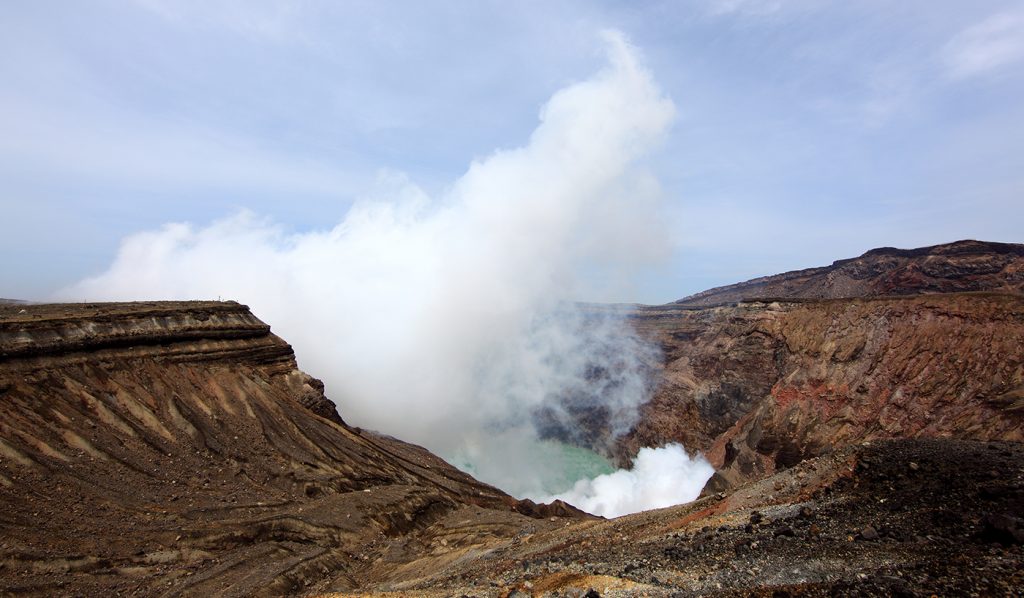
Credits: Tanaka Juuyoh
If you’re lucky enough to visit on a day when poisonous gas levels aren’t too high, you might just be able to see the crater of the largest active volcano in Japan. Located right in the middle of Kyushu, this impressive wonder is a sight many would enjoy seeing at least once in their lives. With a convenient car park only a minute’s walk away from the mountain, shuttles, and walking trails, tourists have an easier time than ever getting to the location.
Along with viewing the sizeable active volcano, tourists can also use the nearby campsites and ride a horse or two if the season is right. There are even helicopter rides available – for a price – if you’re daring enough to view the volcano from above.
Don’t miss the chance to explore Kumamoto when visiting Mt. Aso.
Google Maps: Mt. Aso
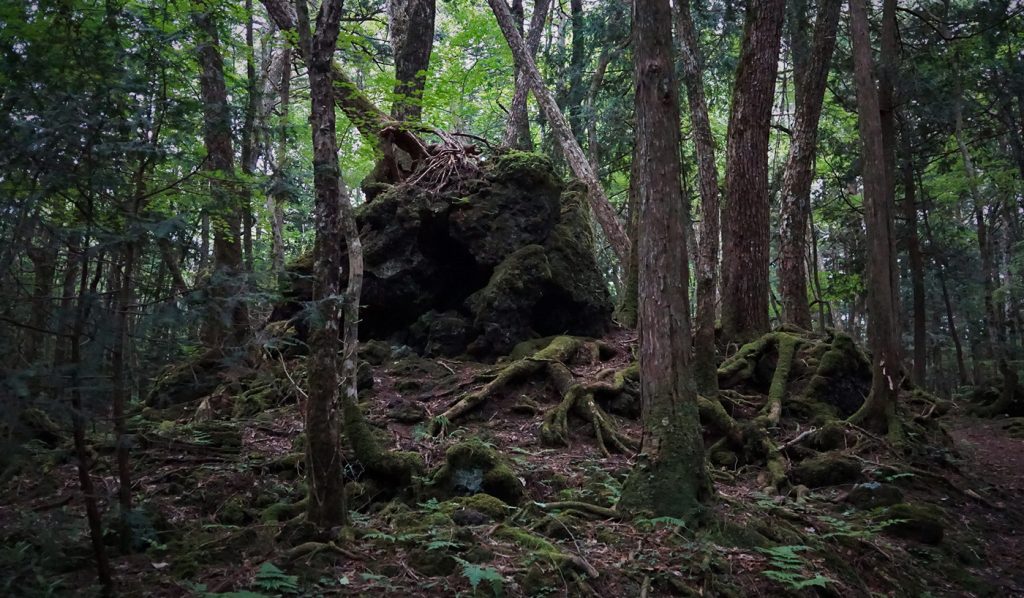
Credits: Liz Mc
Also referred to the Sea of Trees in Japan (or the Suicide Forest throughout the rest of the world), Aokigahara is one of the world’s most popular places to die. Made famous recently by a YouTuber who filmed a victim’s body while exploring inside, those that live near the forest are not happy with its increasing popularity. The rise in suicides carried out in the forest has been said to taint the trees with paranormal energy that permeates throughout the entire forest.
One thing’s for certain – you need a strong stomach and a good sense of direction if you want to visit this dark tourist attraction. Make sure that someone knows where you’re going, and that you’re fully prepared in case you see something you don’t want to while inside the large forest.
Are you willing to take the risk and visit Aokigahara? Find out the secrets of the Suicide Forest.
Google Maps: Aokigahara
Fukushima Forbidden Zone – Tomioka
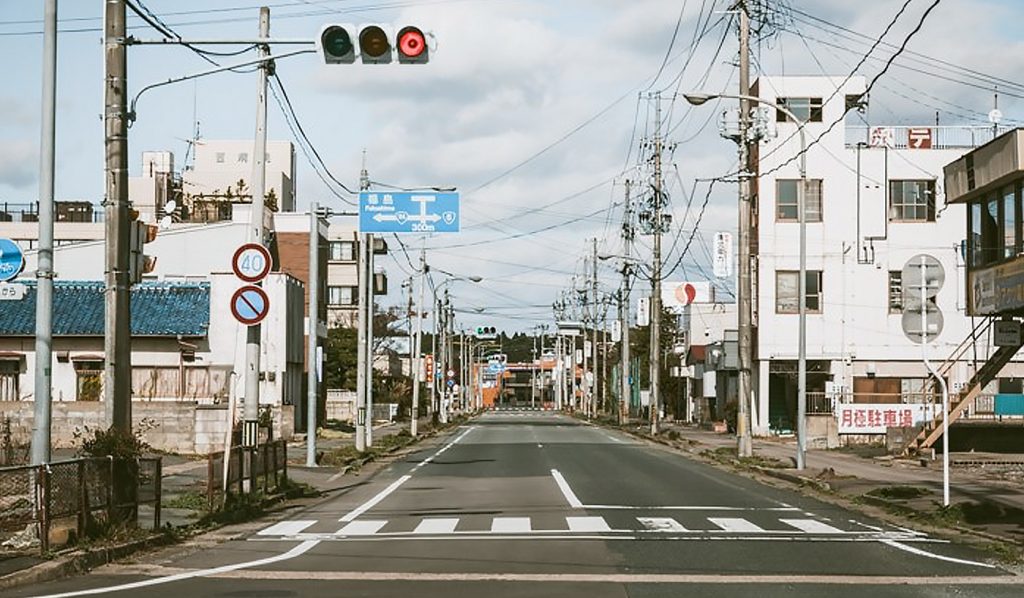
Credits: ゴリラクリニック
If you thought Hashima Island seemed like an interesting place to visit, you’ll likely also be interested in the small town of Tomioka in Fukushima. After a large earthquake and resulting tsunami caused the nuclear power plant to meltdown, almost all of the 15,830 residents living in Tomioka fled the town; few ever returned. The majority of the town may never be reoccupied, and most of the buildings are on a waitlist to be demolished.
If you’re brave enough to risk the lingering radiation, you’ll be treated to a truly disturbing sight. Only the elderly dare return to the town, as they claim that they will likely die of old age before the radiation does any damage to their bodies.
Google Maps: Fukushima Forbidden Zone – Tomioka
Atomic Bomb Dome – Hiroshima

Said to be a symbol of what Hiroshima stands for and a prayer for world peace, the Atomic Bomb Dome in Hiroshima has survived both an atomic bomb and the test of time. The dome serves as a reminder of the tragic war that took the lives of so many Japanese citizens. The fact that it survived the first atomic bomb to ever be used in human history will forever awe those who witnessed the aftermath of the bomb and the war.
As part of the Hiroshima Peace Memorial Park, the Atomic Bomb Dome can be viewed exactly as it was after the fall of the atomic bomb onto Hiroshima, Japan. Though this location isn’t as dark or frightening to view as others on the list, the history behind the dome and the lives that were lost during the war makes it so.
Even though having a sad past, Hiroshima is full of amazing places to see .
Google Maps: Atomic Bomb Dome
Nara Dreamland
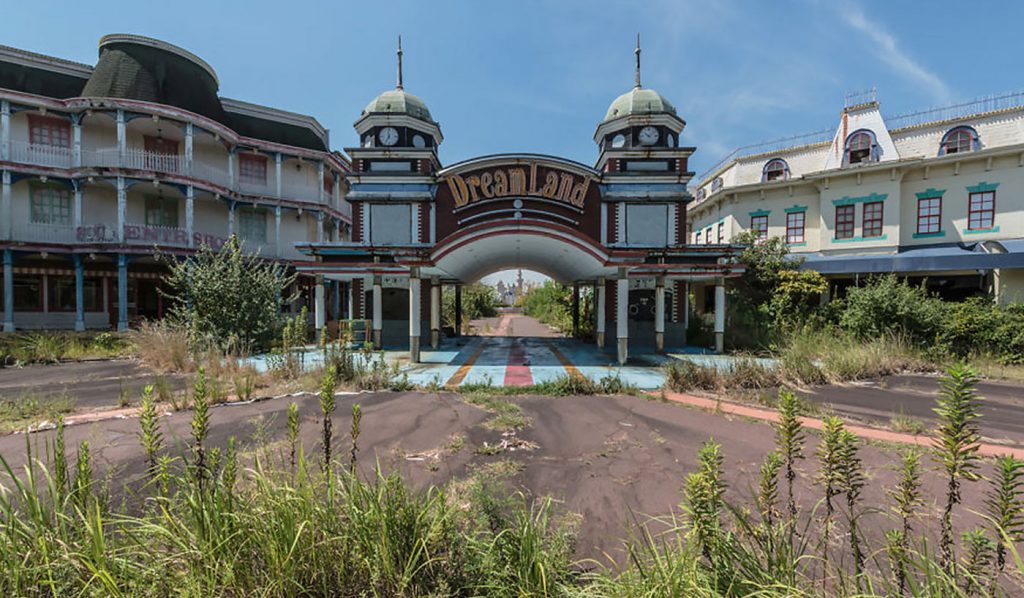
Credits: Anirudh Ramesh
It’s no secret that theme parks are popular worldwide. Nara Dreamland was one such theme park that was built in Japan as a substitute Disneyland for tourists and citizens living in Nara. Those who visited the park remarked how it was a nearly exact replica of the Disney theme parks, which had yet to come to Japan. Twenty-two years later, Tokyo Disneyland opened, and Nara Dreamland was soon forgotten.
Left abandoned for 10 years before its demolition, people from around the world came to see the creepy images of rides overgrown with plants and witness the strange happenings said to take place there. Though demolition officially concluded on December 21, 2017, travelers still visit the area and say that it still ‘feels strange’.
Got curious about Nara Dreamland? You can check more amazing pictures here .
Google Maps: Nara Dreamland
Meguro Parasitological Museum
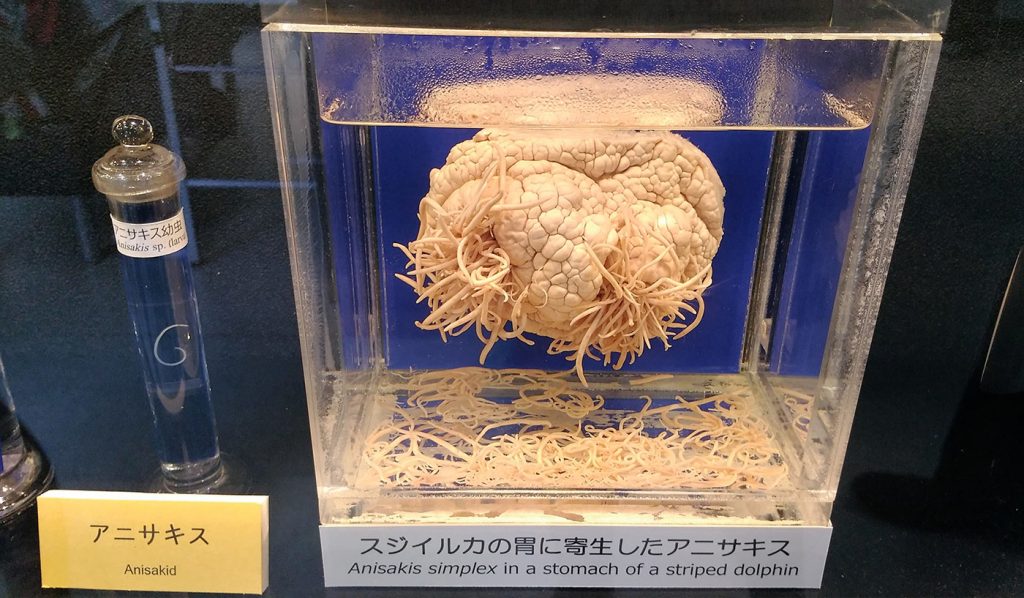
Credits: Amber Peters
Do you start to feel itchy and gross when you think of bugs and insects? Do you have an innate fear that something is living inside your body, feeding off of you while it grows bigger and stronger? Then head over to the Meguro Parasitological Museum and educate yourself on parasites and the like.
If you’re a visual learner, you’ll be pleased to know that they have 300 preserved specimens on display for any and all to look at. If you prefer to learn by reading, the research library boasts at least 60,000 parasite specimens, 5,000 books, and 50,000 papers all about parasites.
Check out more 23 options of things to do in Tokyo . Traveling with a low budget? Tokyo has plenty of free options !
Google Maps: Meguro Parasitological Museum
Okunoin Cemetery
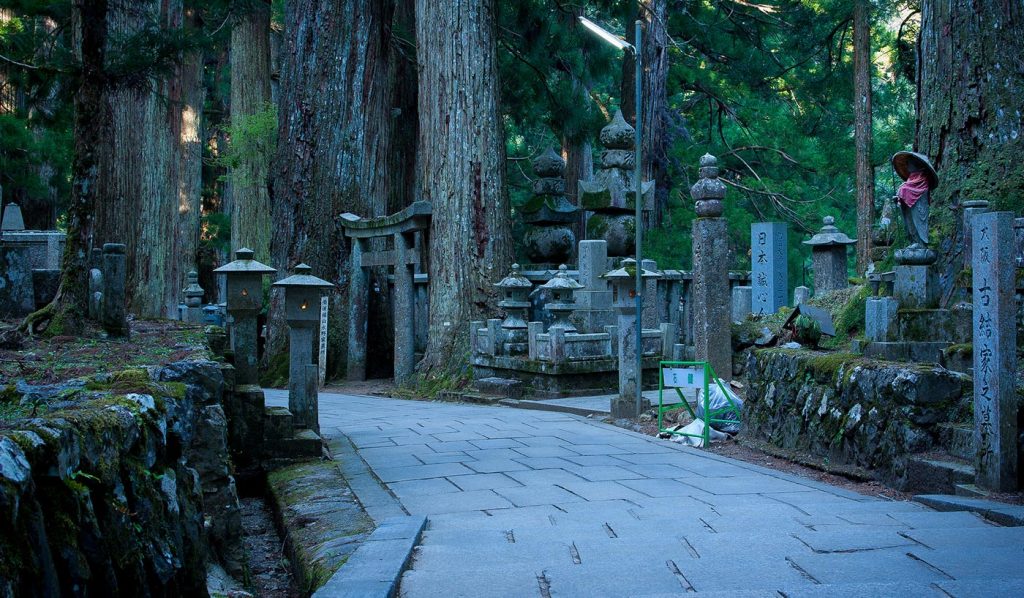
Credits: Xiaojun Deng
If darkness is an old friend, you’ll find yourself to be quite comfortably walking through the Okunoin Cemetary. Deep within a forest over a thousand years old, this mass grave is home to over 200,000 deceased Buddhist monks. Said to be waiting for the resurrection of the Buddha of the Future, each grave has its own special place in the two kilometers of sacred land where the monks can rest forever in meditation.
If you think the cemetery is impressive to see during the day, you’ll likely enjoy seeing it at night when the atmosphere changes. The paths are not always well lit, and visitors have reported strange happenings around the graves.
Learn more about Koyasan , the house of Okunoin Cemetery.
Google Maps: Okunoin Cemetery
Round Schoolhouse, Hokkaido

Credits: 最終京王線
This circular place of learning, which was built in 1906, was used as an elementary school for nearly 30 years before closing down for reasons unknown around 1975. Instead of being demolished or cleaned to be used again, the building has been left exactly as it was when it functioned as a school. Desks and chairs are still set up in dusty rooms, waiting for children to use them once more.
The haunted Round Schoolhouse of Bibai is well-known, both in Japan and around the world, as countless people have entered the building and witnessed the paranormal take place there. Locals will tell tales of strange lights and sounds emanating from either the nearby forest or the schoolhouse itself, adding to the allure of the likely haunted building.
Don’t miss out the chance to visit Sapporo if you are traveling to Hokkaido.
Google Maps: Round Schoolhouse, Hokkaido
Old Chusetsu Tunnel – Fukuoka
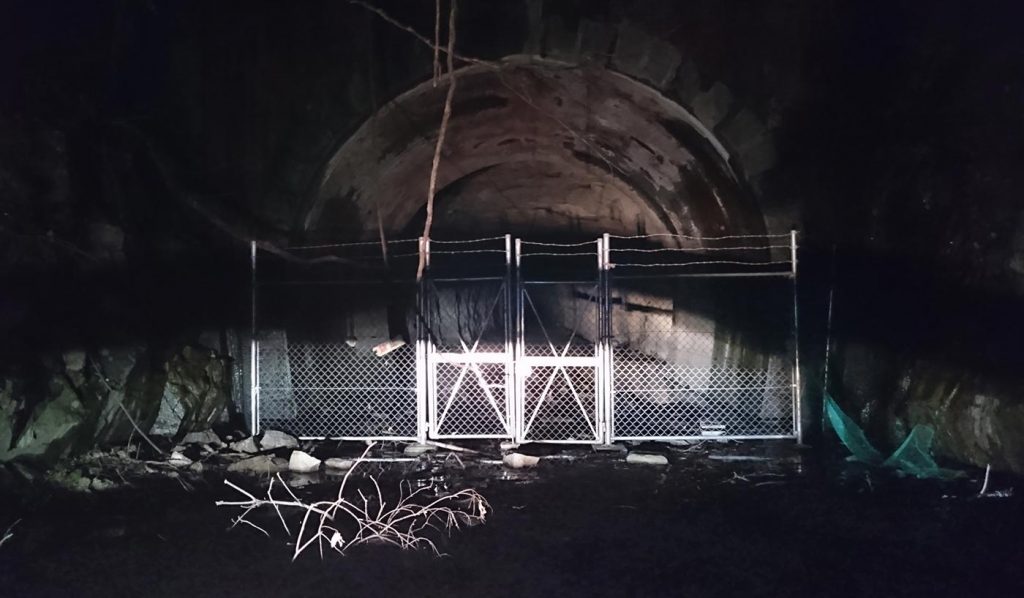
Credits: 栗山大徹
Taking the final spot on our list, the Old Chusetsu Tunnel in Fukuoka is said to be one of the most haunted tunnels in all of Japan. Though it is now closed and out of service, just walking by the entrance of the tunnel is said to be a frightening experience. Even if travelers wish to venture through the tunnel, many have reported that loud, wailing voices coming from inside the tunnel have warned them otherwise.
Those that are brave enough to try and walk the length of the tunnel will find that it’s completely doable, just really creepy and spooky. Japanese TV programs will often do paranormal segments and revisit the Chusetsu Tunnel to keep it fresh in everyone’s minds.
As one of the most populated cities in Japan, Fukuoka has attractions for all tastes .
Google Maps: Old Chusetsu Tunnel – Fukuoka
Conclusion – Dark Tourism in Japan
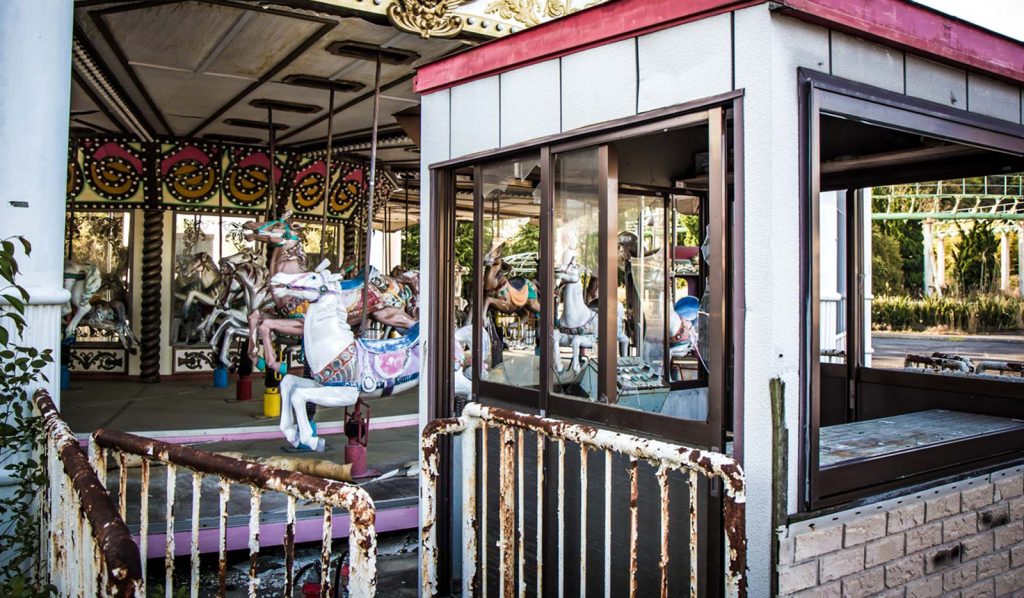
Credits: Michael Turtle
If you’d rather enjoy a peaceful afternoon surrounded by colorful lights and decorations, stick to the major cities of Japan. If you’re looking for a more exciting, adventurous journey that will make you question what is real and what is just your imagination, then dark tourism is perfect for you. Even if you manage to scare yourself silly, you can always travel back to the city for a day or two or rest and relaxation surrounded by the technology and cute characters Japan is known for.
Are you into dark tourism? Share your experiences with us on our Facebook group .
For more great content about Japan, follow us on Facebook , Instagram , Twitter , and Pinterest . See you very soon!
YourJapan Blog

Related Posts

10 Surprising Ways You Didn’t Know You Could Use Your Suica Card
© 2024 Your Japan.
- TRAVEL GUIDES
- BEGINNER’S GUIDE
- ACCOMODATIONS
Made with ♡ in Tokyo

- dark tourism
- Andaman & Nicobar
- Bosnia & Herzegovina
- Channel Islands
- Cyprus (North)
- Czech Republic
- Dominican Republic
- Easter Island
- El Salvador
- Falkland Islands
- French Guiana
- Great Britain
- [Nagorno-Karabakh]
- Netherlands
- New Zealand
- Northern Ireland
- North Korea
- Philippines
- South Africa
- South Georgia
- South Korea
- Switzerland
- Transnistria
- Tristan da Cunha
- Turkmenistan

- disclaimer & privacy policy
© dark-tourism.com, Peter Hohenhaus 2009-2023
- Climate change
- Circular Economy in Japan
- Zenbird Media Facebook Page
- Zenbird Media Twitter
- Zenbird Media Instagram
- Zenbird Media Youtube
- Women’s Wellness
- Sustainability in Japan

- Search Search

Dark Tourism in Japan
What is dark tourism.
Dark tourism refers to a type of tourism that involves visiting places associated with death, tragedy, or suffering. These may include sites of natural disasters, war or genocide, prisons, former concentration camps, and other places with a dark or macabre history. The purpose of dark tourism is often to learn more about the history and significance of these places, to pay respects to those who suffered or died, and to gain a deeper understanding of the human condition.
Merits and demerits of dark tourism
Due to the subject matter, dark tourism is sometimes argued beyond their historical importance. Here are some merits and demerits in dark tourism.
Merits of dark tourism
Educational Value: Dark tourism can provide visitors with a deeper understanding of past events, cultures, and traditions. It can help visitors understand the consequences of war, natural disasters, and other tragedies, and learn about the human experience during difficult times.
Cultural Preservation: Visiting sites of historical or cultural significance can help preserve them for future generations. In some cases, dark tourism can provide a financial incentive to preserve or restore these sites.
Commemoration: Dark tourism can provide a way to honor and commemorate those who have suffered or died, and to pay respects to those who have made sacrifices in the past. It can also help preserve the memory of historical events and ensure that they are not forgotten.
Demerits of dark tourism
Ethical concerns: Many people argue that visiting sites associated with tragedy and death is exploitative and disrespectful to the victims and their families. Dark tourism may be seen as a form of voyeurism or even as profiting from tragedy.
Psychological effects: Visiting dark tourism sites can be emotionally challenging and distressing for some people. It may trigger feelings of anxiety, depression, or trauma.
Disrespectful behavior: Some tourists may behave inappropriately or disrespectfully while visiting dark tourism sites. This could include taking inappropriate photos, littering, or engaging in other disruptive behavior.
Dark tourism in Japan
Here are some recommendations for you if you are interested in dark tourism. Some of these locations can provide a rather surreal experience, covering a number of historical events including war and environmental issues.
Hiroshima Peace Memorial Park and Museum, Hiroshima Prefecture

Perhaps the very first location we think of, considering Japan’s involvement in the Pacific War. Hiroshima Peace Memorial Park and Museum is built on the site of the atomic bombing during World War II, and the park and museum serve as a reminder of the devastation caused by the use of atomic bombs. Do allow ample time to visit the numerous memorials and exhibits, each telling the effects from the atomic bomb from different angles.
Poison Gas island Okunoshima, Hiroshima Prefecture

Okunoshima Island’s involvement in the war is less well-known. Okunoshima Island is a former top-secret chemical weapons manufacturing site during World War II, Okunoshima Island is now a popular tourist destination where visitors can learn about the island’s history and see the remains of the chemical weapons plant. If you are an animal lover, you’d love this place because it’s famous as a “Rabbit Island!”
Nagasaki Atomic Bomb Museum, Nagasaki Prefecture
The Nagasaki Atomic Bomb Museum contains exhibits and artifacts that depict the events leading up to the bombing, the bombing itself, and the aftermath. It also includes information about the effects of radiation on the survivors, known as hibakusha, and their ongoing struggles. Its main goal is to promote peace and to remind people of the devastating consequences of nuclear weapons.
Teshima Island, Kagawa Prefecture

Teshima Incident is surprisingly recent, but only some know the name, and even fewer remember the details of the disaster. However, the incident is very relevant now, because its environment pollution draws parallels to the climate crisis .
The Teshima Incident was an environmental disaster and a national scandal that occurred in Japan in 1997. It involved the illegal dumping of tons of toxic industrial waste on the small island of Teshima, located in the Seto Inland Sea. You may read further on the report of our visit to Teshima Island . Note that Teshima no kokoro Museum requires the booking of a guide, which allows you access to the cleanup area.
Fukushima Exclusion Zone, Fukushima Prefecture

The Fukushima Nuclear Meltdown is a nuclear accident that occurred on March 11, 2011, in the Fukushima Daiichi Nuclear Power Plant in Japan. The accident was caused by a massive earthquake and tsunami that struck the region, leading to the failure of the plant’s cooling systems and the subsequent release of radioactive material into the environment.
Today, it is safe to visit. You can go to sites like the Great East Japan Earthquake and Nuclear Disaster Memorial Museum, the ruins of Ukedo Elementary School, or even approach REAL Fukushima for a truthful, customized guided tour across the disaster affected areas.
Center of the Tokyo Raids and War Damage

The Center of the Tokyo Raids and War Damage is a museum established in 2002 to commemorate the victims of the air raids on Tokyo during World War II and to document the destruction caused by the bombings. The museum has exhibits that detail the history of the air raids, the impact on civilians, and the efforts to rebuild the city after the war. It also provides information about the current state of disaster preparedness in Japan and promotes peace education.
Minamata Disease Municipal Museum, Kumamoto Prefecture

The Minamata Disease Municipal Museum documents the history of the Minamata disease, a neurological disorder caused by industrial mercury poisoning in the mid-20th century. The museum houses a collection of documents, photographs, and personal testimonies related to the disease, as well as exhibits on the environmental and social factors that led to the outbreak and the efforts to prevent future pollution-related health crises. The museum is dedicated to raising awareness of the disease and promoting education and prevention of environmental pollution. It also serves as a memorial to the victims of the Minamata disease and their families.
More about sustainable tourism in Japan
- 2024-04-01: Roadside stations "Michinoeki": must-visit destinations for local charm in Japan
- 2024-03-26: 2 destinations in Japan awarded at Green Destinations Top 100 Story Awards ceremony
- 2024-03-18: The Japan Travel Awards 2024 for destinations promoting DEI, sustainability, and inbound tourism
- 2024-02-21: Recognizing destinations for diversity in Japan Travel Awards 2024
- 2024-01-30: Sustainable lifestyles thriving in Japan's snowy regions
Glossary List
- 3 pillars of sustainability
- Act on Promotion of Resource Circulation for Plastics
- Bean to Bar
- Biodiversity
- Biodiversity hotspot
- Blue Carbon
- Circular Economy
- Circular Edonomy
- Closed-loop system
- Cradle to Cradle
- Dark Tourism
- Decarbonization
- Forest bathing (Shinrin-yoku)
- FutureCity initiative
- Globally Important Agricultural Heritage Systems (GIAHS)
- Greenhouse Gases
- Japanese Nationally Important Agricultural Heritage Systems (J-NIAHS)
- Kankei-jinkou
- kusaki-zome
- Kyoto Protocol
- LGBTQQIAAPPO2S
- Local Vitalization Cooperator
- Red List (Japan)
- Regional Revitalization
- Relationship Population
- Renewable Energy
- Rinne Tensei
- Sanpo Yoshi
- SDGs (Sustainable Development Goals)
- SDG Compass
- SDG Global Indicators
- Sharing Economy
- Shojin Ryori
- Society 5.0
- Sustainable Aviation Fuel
- Triple Bottom Line (TBL)
- Architecture and Design
- Asian and Pacific Studies
- Business and Economics
- Classical and Ancient Near Eastern Studies
- Computer Sciences
- Cultural Studies
- Engineering
- General Interest
- Geosciences
- Industrial Chemistry
- Islamic and Middle Eastern Studies
- Jewish Studies
- Library and Information Science, Book Studies
- Life Sciences
- Linguistics and Semiotics
- Literary Studies
- Materials Sciences
- Mathematics
- Social Sciences
- Sports and Recreation
- Theology and Religion
- Publish your article
- The role of authors
- Promoting your article
- Abstracting & indexing
- Publishing Ethics
- Why publish with De Gruyter
- How to publish with De Gruyter
- Our book series
- Our subject areas
- Your digital product at De Gruyter
- Contribute to our reference works
- Product information
- Tools & resources
- Product Information
- Promotional Materials
- Orders and Inquiries
- FAQ for Library Suppliers and Book Sellers
- Repository Policy
- Free access policy
- Open Access agreements
- Database portals
- For Authors
- Customer service
- People + Culture
- Journal Management
- How to join us
- Working at De Gruyter
- Mission & Vision
- De Gruyter Foundation
- De Gruyter Ebound
- Our Responsibility
- Partner publishers

Your purchase has been completed. Your documents are now available to view.
Perception of Dark Tourism
Automated text analysis of users comments a case study of the chernobyl exclusion zone.
Aleksandra Kleshcheva is a graduate of Salzburg University of Applied Sciences, where she studied innovation and management in tourism. Her research focuses on using automated text analysis techniques to discover customer experience from online reviews. She is interested in the application of data science in tourism to find new ways of exploring image from user-generated content.
In recent years, numerous studies have been conducted on the phenomenon of dark tourism. This study seeks to understand what motivates people to visit dark tourism sites such as the Chernobyl exclusion zone by applying an automated text analytics approach. Tripadvisor was chosen as a source for data collection as tourists are increasingly sharing their experiences and leave feedback online. Several natural language processing methods, such as topic modelling (LDA) and sentiment analysis, were applied to extract the primary motivators behind a visit to Chernobyl. Topic modelling results present five main topics discussed by tourists. Based on the results, the main motivational factors are discussed in detail. Furthermore, the total sentiment score shows a positive perception of the dark tourism destination. This study follows an interdisciplinary research approach applying innovative data analytics methods to investigate dark tourism through social media. By implementing NLP methods, this study reveals tourists’ perceptions from online reviews, which are not easy to discover by traditional approaches. Moreover, the results provide guidelines to tourism managers in monitoring new trends in tourism, understanding tourists’ needs and wishes, and evaluating the quality of products or services.
About the author
Alaei, Alireza & Becken, Susanne & Static, Bela. 2017. Sentiment Analysis in Tourism: Capitalising on Big Data. Journal of Travel Research, 58. DOI: 10.1177/0047287517747753 10.1177/0047287517747753 Search in Google Scholar
Alrawadieh Z., Dincer M., Dinçer F. & Mammadova, P. 2018. Understanding destination image from the perspective of Western travel bloggers: the case of Istanbul. International Journal of Culture, Tourism and Hospitality Research. DOI 10.1108/IJCTHR-12-2017-0124 10.1108/IJCTHR-12-2017-0124 Search in Google Scholar
Atomic Energy, 2017. Ukraine announced the amount of income from tourism in the Chernobyl zone. Retrieved on 24.01.2020 from http://www.atomic-energy.ru/news/2017/11/28/81222 Search in Google Scholar
Bansal S., 2016. Beginners Guide to Topic Modeling in Python. Retrieved 16.10.20 from https://www.analyticsvidhya.com/blog/2016/08/beginners-guide-to-topic-modeling-in-python/ Search in Google Scholar
Bhati A., Agarwal M., Della Nanda Tjayaindera, Roi Aung, Myo Thu & Thai Minh Tam Nguyen (2020): Dark Tourism in South-East Asia: Are Young Asian Travelers up for it? Inter-national Journal of Hospitality & Tourism Administration, DOI: 10.1080/15256480.2019.1708223 10.1080/15256480.2019.1708223 Search in Google Scholar
Blei, D. M., 2012. Probabilistic Topic Models. Communications of the ACM, 55(4), pp. 77–84. https://doi.org/10.1145/2133806.2133826 10.1145/2107736.2107741 Search in Google Scholar
Blom, T., 2000. Morbid Tourism. A Postmodern Market Niche with an Example. From Althorp. Norsk Geografisk Tidsskrift–Norwegian Journal of Geography Vol. 5, 00–00. Oslo. ISSN 0029-1951. 10.1080/002919500423564 Search in Google Scholar
Busby, G. & Devereux, H., 2015. Dark Tourism in Context: The Diary of Anne Frank, European Journal of Tourism, Hospitality and Recreation, 6 (1), pp. 27–38. Search in Google Scholar
Chang, Te-Yi, 2014. DARK TOURISM: The Effects of Motivation and Environmental Attitudes on the Benefits of Experience. Revista Internacional de Sociología. 10.3989/ris.2013.08.06. 10.3989/ris.2013.08.06 Search in Google Scholar
D’Andrea, A., Ferri, F., Grifoni, P., & Guzzo, T. (2015). Approaches, Tools and Applications for Sentiment Analysis Implementation. International Journal of Computer Applications, 125(3), pp. 26–33. https://doi.org/10.5120/ijca2015905866 10.5120/ijca2015905866 Search in Google Scholar
Dann, G., 1994. Tourism: The Nostalgia Industry of the Future. In Global Tourism: The Next Decade, W. Theobald, ed., pp. 55–67. Oxford: Butterworth Heinemann Search in Google Scholar
Dark Tourism, 2020. Retrieved on 14.01.2020 from http://www.dark-tourism.com/ Search in Google Scholar
Fonseca A.P., Seabra C., Silva C., 2016. Dark Tourism: Concepts, Typologies and Sites. J Tourism Res Hospitality S2–002. Search in Google Scholar
Goatcher, J., & Brunsden, V., 2011. Chernobyl and the Sublime Tourist. Tourist Studies, 11(2), pp. 115–137. 10.1177/1468797611424956 Search in Google Scholar
Hu, Minqing & Liu, Bing, 2004. Mining Opinion Features in Customer Reviews. Proceedings of AAAI. Search in Google Scholar
Jain, Aditya & Kulkarni, Gandhar & Shah, Vraj, 2018. Natural Language Processing. International Journal of Computer Sciences and Engineering. 6, pp. 161–167. 10.26438/ijcse/v6i1.161167 10.26438/ijcse/v6i1.161167 Search in Google Scholar
Joshi P., 2018. An NLP Approach to Mining Online Reviews using Topic Modeling (with Python codes). Retrieved 16.10.20 from https://www.analyticsvidhya.com/blog/2018/10/mining-online-reviews-topic-modeling-lda/ Search in Google Scholar
Lennon, J. and Foley, M., 1996. JFK and Dark Tourism: a Fascination with Assassination. International Journal of Heritage Studies, 2 (4), pp. 198–211. 10.1080/13527259608722175 Search in Google Scholar
Lennon, J. J., & Foley, M., 1999. Interpretation of the Unimaginable: The US Holocaust Memorial Museum, Washington, DC and “Dark Tourism”. Journal of Travel Research, 38, 46–50. 10.1177/004728759903800110 Search in Google Scholar
Lennon, J., Foley M., 2000. Dark Tourism: The Attraction of Death and Disaster. London: Continuum. Search in Google Scholar
Li S., 2020. Topic Modeling Quora Questions with LDA and NMF. Retrieved 23.10.20 from https://towardsdatascience.com/topic-modeling-quora-questions-with-lda-nmf-aff8dce5e1dd Search in Google Scholar
Liddy, E.D., 2001. Natural Language Processing. In Encyclopedia of Library and Information Science, 2 nd Ed. NY. Marcel Decker, Inc. Search in Google Scholar
Light, D. (2017). Progress in Dark Tourism and Thanatourism Research: An Uneasy Relationship with Heritage Tourism. Tourism Management, 61, 275–301. DOI: 10.1016/j.tourman.2017.01.011. 10.1016/j.tourman.2017.01.011 Search in Google Scholar
Miles, W.F.S., 2002. Auschwitz: Museum Interpretation and Darker Tourism. Annals of Tourism Research, 29 (4), pp. 1175–1178. 10.1016/S0160-7383(02)00054-3 Search in Google Scholar
Mionel, V., 2019. Dark Tourism and Thanatourism: Distinct Tourism Typologies or Simple Analytical Tools? Tourism. 67, pp. 423–437. Search in Google Scholar
Powell R., Kennell J., Barton C., 2018. Dark Cities: a Dark Tourism Index for Europe’s Tourism Cities, Based on the Analysis of DMO Websites. International Journal of Tourism Cities. 10.1108/IJTC-09-2017-0046. 10.1108/IJTC-09-2017-0046 Search in Google Scholar
Preece T., Price G., 2005. Motivations of Participants in Dark Tourism: A Case Study of Port Arthur, Tasmania, in C. Ryan, et al (eds), Taking Tourism to the Limits: Issues, Concepts and Managerial Perspectives, Oxford: Elsevier, pp. 191–198. 10.1016/B978-0-08-044644-8.50021-7 Search in Google Scholar
Rajasundari T., Subathra P., and Dr. (Col.) Kumar P. N., 2017. Performance Analysis of Topic Modeling Algorithms for News Articles. Journal of Advanced Research in Dynamical and Control Systems, vol. 2017, pp. 175–183. Search in Google Scholar
Rojek, C., 1993. Ways of Escape. Basingstoke: Macmillan 10.1057/9780230373402 Search in Google Scholar
Savara P. & Sameen S., 2013. Opinion Mining and Sentiment Analysis – An Assessment of Peoples’ Belief: A Survey. International Journal of Ad hoc, Sensor & Ubiquitous Computing. 4. 21–33. 10.5121/ijasuc.2013.4102. 10.5121/ijasuc.2013.4102 Search in Google Scholar
Seaton, A. V., 1999. War and Thanatourism: Waterloo 1815–1914. Annals of Tourism Research 26, pp. 130–158. 10.1016/S0160-7383(98)00057-7 Search in Google Scholar
Seaton, A. V., Lennon J., 2004. Moral Panics, Ulterior Motives and Alterior Desires: Thanatourism in the Early 21st Century. In New Horizons in Tourism: Strange Experiences and Stranger Practices, T. V. Singh, ed., pp. 63–82. 10.1079/9780851998633.0063 Search in Google Scholar
Seaton, A.V., 1996. Guided by the Dark: from Thanatopsis to Thanatourism. International Journal of Heritage Studies, 2 (4), pp. 234–244 10.1080/13527259608722178 Search in Google Scholar
Sharpley R., 2005. Travels to the Edge of Darkness: Towards a Typology of “Dark Tourism”, in C. Ryan, et al (eds), Taking Tourism to the Limits: Issues, Concepts and Managerial Perspectives, Oxford: Elsevier, pp. 217–228. 10.1016/B978-0-08-044644-8.50023-0 Search in Google Scholar
Sharpley, R., 2009. Shedding Light on Dark Tourism: An Introduction. In R. Sharpley & P. R. Stone (Eds.), The Darker Side of Travel. The Theory and Practice of Dark Tourism, pp. 3–22. 10.21832/9781845411169-002 Search in Google Scholar
Sievert C., Shirley K.E., 2014. LDAvis: A Method for visualizing and interpreting topics, pp. 63–70. 10.3115/v1/W14-3110 Search in Google Scholar
Stone P., Sharpley R., 2008. Consuming Dark Tourism: A Thanatological Perspective. Annals of Tourism Research, Vol. 35, No. 2, pp. 574–595. 10.1016/j.annals.2008.02.003 Search in Google Scholar
Stone P.R., 2005. Consuming Dark Tourism: A Call for Research. eReview of Tourism Research 3(5), pp. 109–117. Search in Google Scholar
Stone, P. & Sharpley, R., 2008. Consuming dark tourism: a thanatological perspective. Annals of Tourism Research, 35 (2), pp. 574–595. 10.1016/j.annals.2008.02.003 Search in Google Scholar
Stone, P., 2006. A Dark Tourism Spectrum: Towards a Typology of Death and Macabre Related Tourist Sites, Attractions and Exhibitions. Tourism: An International Interdisciplinary Journal, 54(2), pp. 445–160. Search in Google Scholar
Stone, P., 2012. Dark tourism and Significant Other Death: Towards a Model of Mortality Mediation, Annals of Tourism Research, 39, (3), pp. 1565–1587. 10.1016/j.annals.2012.04.007 Search in Google Scholar
Tarlow, P., 2005. Dark Tourism: The Appealing ‘Dark’ Side of Tourism and More. In, M. Novelli, ed. Niche Tourism: Contemporary Issues, Trends and Cases, pp.47–57. Oxford: Elsevier. 10.1016/B978-0-7506-6133-1.50012-3 Search in Google Scholar
Tripadvisor, 2020. Media Center. Retrieved 12.10.20 from https://tripadvisor.mediaroom.com/us-about-us Search in Google Scholar
Uatom, 2020. Between Popularity and Safety. What Does Chornobyl Tourism Lack? Retrieved 23.09.20 from https://www.uatom.org/en/2020/05/26/between-popularity-and-safety-what-does-chornobyl-tourism-lack.htmlth Search in Google Scholar
World Nuclear Association, 2020. Chernobyl Accident 1986. Retrieved 16.08.20 from https://www.world-nuclear.org/information-library/safety-and-security/safety-of-plants/chernobyl-accident.aspx Search in Google Scholar
Yankovska, G., & Hannam, K., 2014. Dark and Toxic Tourism in the Chernobyl Exclusion Zone. Current Issues in Tourism, 17(10), pp. 929–939. 10.1080/13683500.2013.820260 Search in Google Scholar
© 2021 Walter de Gruyter GmbH, Berlin/Boston
- X / Twitter
Supplementary Materials
Please login or register with De Gruyter to order this product.
Journal and Issue
Articles in the same issue.

IMAGES
VIDEO
COMMENTS
Das Besichtigen solcher Orte wird als „Dark Tourism" bezeichnet - dunkler Tourismus. TRAVELBOOK hat zwei Reisende, die insgesamt mehr als 1000 „Dark Tourism"-Orte in mehr als 100 Länder weltweit besucht haben, nach ihren persönlichen Top-Ten-Listen düsterer Ziele gefragt: Sebastián Cuevas und Dr. Peter Hohenhaus.
Following the example of Hiroshima, dark tourism is flourishing in the Tohoku region. In 2022, a record 1.15 million visitors have visited the earthquake and tsunami memorial museums and other facilities in Iwate, Miyagi and Fukushima prefectures affected by the 2011 disaster. The number of visitors, which had been declining due to the spread of COVID-19, has recovered significantly, driven by ...
170. The Aokigahara forest in Japan, known as the suicide forest, is a dark tourism destination. Ko Sasaki for The New York Times. By Maria Cramer. Oct. 28, 2022. North Korea. East Timor. Nagorno ...
10 Dark Tourism Ziele weltweit. Jedes Land hat seine dunkle Geschichte, weshalb es auch auf der ganzen Welt verteilt düstere Orte gibt, die Schauplätze des Krieges und des Schreckens wurden. Wir zeigen euch ein paar Beispiele - die zehn krassesten Dark Tourism Orte. 1. Killing Fields in Kambodscha
1. Chernobyl Exclusion Zone - Kyiv, Ukraine. The abandoned amusement park in Pripyat is one of dark tourism's crowning images. The haunting stills of the fairground that never heard the laughs of children hang in modern consciousness, a symbol of tragic loss and a warning of the mistakes men can make.
While visiting places of death or disaster might sound like a gruesome addition to your travel itinerary, so-called dark tourism can have important benefits for you and the communities nearby. Visiting sites of inhumanity can be a deeply moving and emotional experience, but while discovering what took place might make us uneasy, remembering ...
Historical roots. The term 'dark tourism' is far newer than the practice, which long predates Pompeii's emergence as a morbid attraction. Stone considers the Roman Colosseum to be one of the first ...
Five of the world's dark tourism sites. 1. North Korea. Opened to visitors in the late 1980s, North Korea now attracts thousands of tourists each year for a peek behind the headlines. 2. Auschwitz-Birkenau. The former Nazi death camp became a memorial in 1947 and a museum in 1955.
Dark tourism refers to visiting places where some of the darkest events of human history have unfolded. That can include genocide, assassination, incarceration, ethnic cleansing, war or disaster ...
Dark tourism (also thanatourism, black tourism, morbid tourism, or grief tourism) has been defined as tourism involving travel to places historically associated with death and tragedy. [1] More recently, it was suggested that the concept should also include reasons tourists visit that site, since the site's attributes alone may not make a ...
While it's important to devote time to Hiroshima's dark tourism sites, it's equally worthwhile to learn about the city beyond the bombing. Understand hundreds of years of history at Hiroshima-jō, the faithful rebuild of a 16th-century castle. Take a ferry to Miyajima Island to admire temples and spot miniature deer.
9. Okunoshima Rabbit Island. Okunoshima may be more popular for its cute tourism as most of 100,000 visitors to this island every year, come to feed and interact with the rabbits. But the dark secret behind Okunoshima and its huge number of feral rabbits also makes it stand out in the dark tourism in Japan.
Published: June 15, 2016 8:52am EDT. Dark tourism has become a much more well-covered pasttime in recent years, in which a macabre fascination lead tourists to travel to various places not served ...
The term dark tourism was coined in 1996 by Glasgow Caledonian University researchers John Lennon and Malcolm Foley, though the phenomenon itself is said to date back to Gallo-Roman times. It refers to places associated with death, suffering and misfortune. This kind of tourism can be controversial, however, with critics arguing that it exploits human misery.
This article examines how dark tourism has been adopted and developed in Japan and suggests how it can be linked to educational tourism, through the case of a 'Hope Tourism Guided Tour' held in Fukushima in 2018. In Japan, dark tourism has developed into a new form, nested within educational tourism (or an educational tourism that contains ...
2.1. Dark Tourists and Their Motivation to Dark Tourism Consumption. Stone's (2006) idea of dark tourism goes far beyond related attractions. From this standpoint, diverse well-visited tourist sites may become places of dark tourism due to their history linked with death—e.g., suicides in the Eiffel Tower, tombs in the pyramids of Egypt, the Valley of the Kings, and the Taj Mahal, funeral ...
Introduction. Dark tourism is defined as the act of tourists traveling to sites of death, tragedy, and suffering (Foley and Lennon, 1996).This past decade marks a significant growth of dark tourism with increasing number of dark tourists (Lennon and Foley, 2000; Martini and Buda, 2018).More than 2.1 million tourists visited Auschwitz Memorial in 2018 (visitor numbers, 2019), and 3.2 million ...
Dark tourism can be defined as "visiting sites, attractions or events. . . linked in one way or another with death, suffering, violence or disaster" (Sharpley and Stone 2009, 4).Dark tourism is conceived as a spectrum of experiences moving from the darkest pole centering on a set of profound experiences that are tied to death and mortality to the lighter shade of the spectrum dealing with ...
Gravensteen Castle in Ghent is a classic example of dark tourism sites in Europe. The castle was built back in 1180 and housed the Count of Flanders for many centuries until it became a court, a prison, and even a cotton factory. It's the dark horror stories of torture that really attract visitors to Gravensteen castle.
Aokigahara. Fukushima Forbidden Zone - Tomioka. Atomic Bomb Dome - Hiroshima. Nara Dreamland. Meguro Parasitological Museum. Okunoin Cemetery. Round Schoolhouse, Hokkaido. Old Chusetsu Tunnel - Fukuoka. Conclusion - Dark Tourism in Japan.
Most dark sites to visit outside the capital Tokyo in the centre of the country, are in the southern half of the country, beginning with Hiroshima in the south-west of Japan's largest island Honshu, and extending to the very bottom of the south island Kyushu and beyond to the outlying Okinawa island halfway to Taiwan, which is already tropical. Another island, Hashima, is of a completely ...
Dark tourism may be seen as a form of voyeurism or even as profiting from tragedy. Psychological effects: Visiting dark tourism sites can be emotionally challenging and distressing for some people. It may trigger feelings of anxiety, depression, or trauma. Disrespectful behavior: Some tourists may behave inappropriately or disrespectfully while ...
In recent years, numerous studies have been conducted on the phenomenon of dark tourism. This study seeks to understand what motivates people to visit dark tourism sites such as the Chernobyl exclusion zone by applying an automated text analytics approach. Tripadvisor was chosen as a source for data collection as tourists are increasingly sharing their experiences and leave feedback online.